Relic Dictionary ©
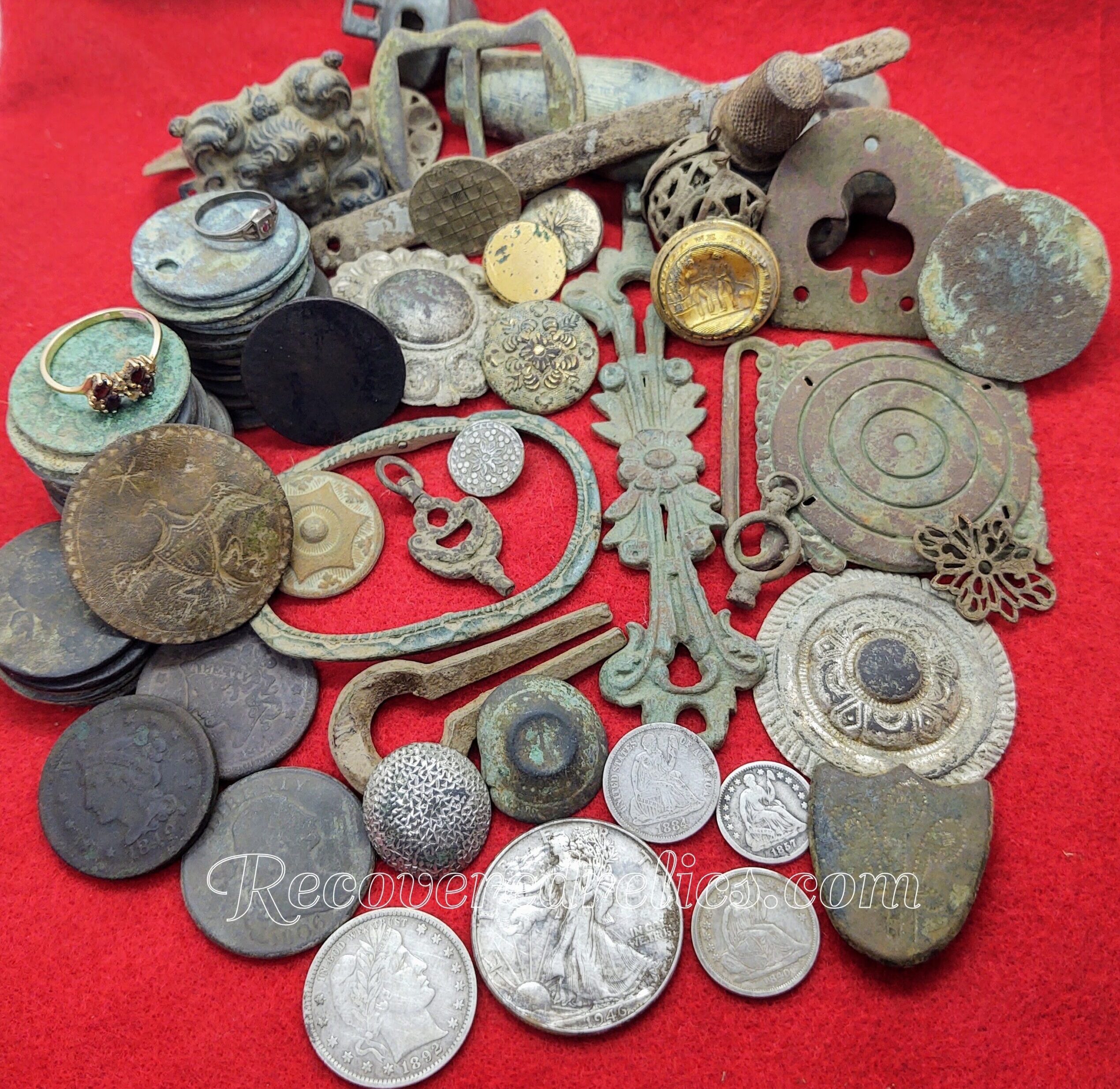
This Relic Dictionary is designed to be a resource for both new and experienced detectorists. Many of the items we find with our metal detectors are not always easily identified right off the bat. Relics recovered from the ground can sometimes be challenging to identify due to corrosion, tarnish, and other environmental damage that has occurred. Sometimes it takes a little research and closer examination to learn and identify what an item is exactly, what its purpose was, and the age and origin of the item. I know that whenever I find an item with my detector I always want to be able to identify it and call it by it’s proper name. I like to know as much as possible about the history behind the items I find. Sometimes we find an item and we don’t know what it is. This can happen to even the most experienced of detectorists. I created this Relic Dictionary so that folks, especially those that are new to the hobby, will have an online resource they can use to help them correctly identify their metal detecting finds. All of the items pictured in the dictionary are dug finds, unless otherwise noted. At the moment, this Relic Dictionary is still a work in progress. I will be adding more items, info., and photos over the upcoming weeks so please check back regularly. It is my hope to create a thorough and detailed catalog of the most common and the not so common finds we discover with our metal detectors. – Lisa Stanco
This Relic Dictionary wouldn’t be possible without the support of several wonderful detectorists who contributed photos of their finds. I would like to thank Sharon Long Harrison, Laura Kucharczyk, Jeff Pelletier, Michael Souza, Jay Verburg, Dave Wise, and Todd (CT Todd) Yerks for their support with this project.
Buttons
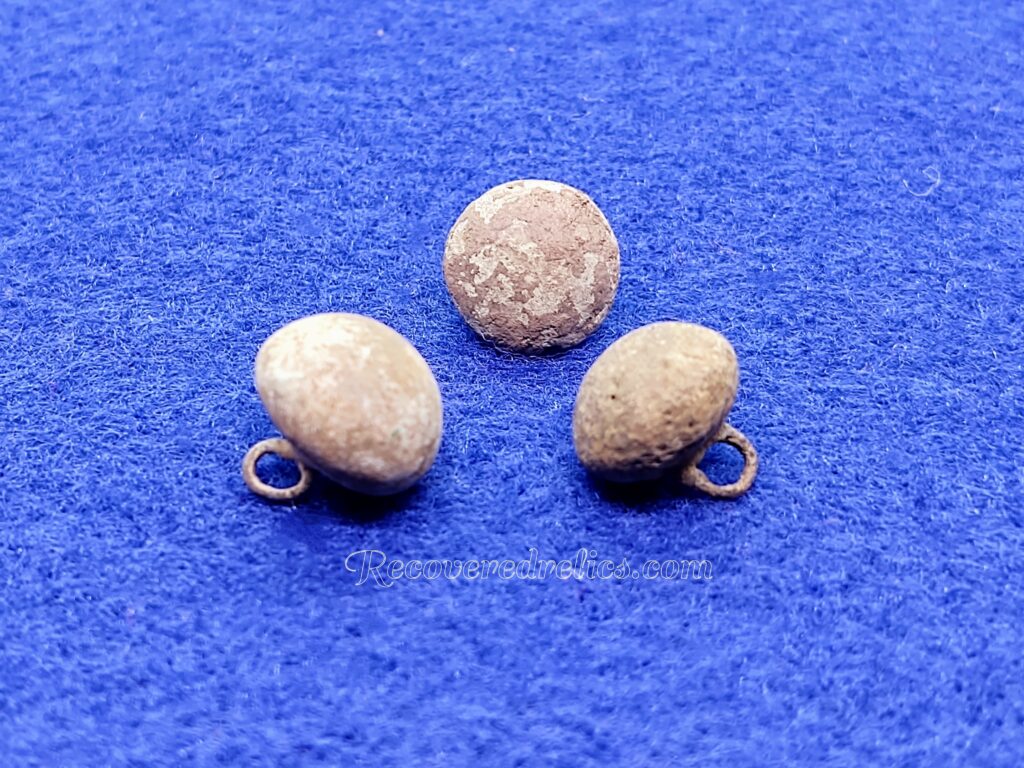
Ball Buttons– Late 17th century and 18th century buttons. Hollow ball shaped buttons with no air escape holes. They resemble small doublet buttons of the 1575-1660 period.
Basket Weave Buttons– A basket weave motif is reminiscent of a woven basket. The design creates a checkered board effect. Basket weave designs first emerged on cloth embroidered buttons or Dorset buttons. Traditionally speaking a basket weave is a plain weave with 2 or more yarns woven together, side by side, in a checkered pattern. Stamped or cast metal buttons with basket weave designs mimic popular thread buttons.
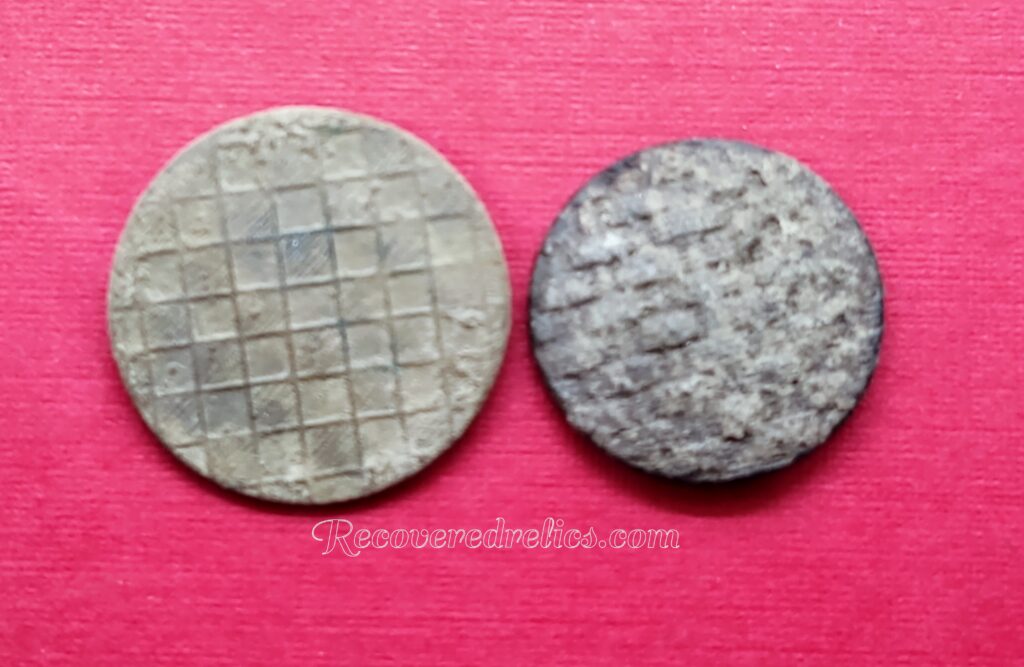
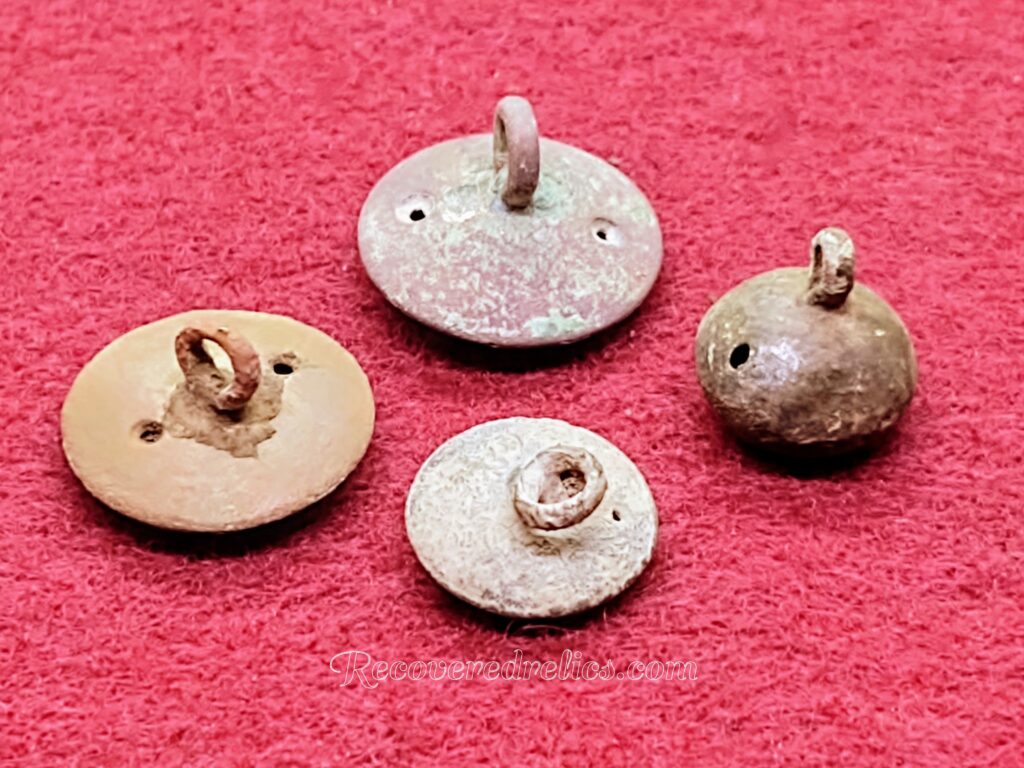
Blow Hole or Vent Hole Buttons– 18th century buttons. Comprised of two pieces. The two button halves were soldered together. The holes in the back of the button served to vent air during the soldering process.
Bullet Buttons– This style button is a two piece nearly spherical button. These buttons were referred to as “Bullet Buttons” during the period of the War of 1812. This style button was also worn by civilians after the war ended. Bullet buttons date from around 1812 to 1830.

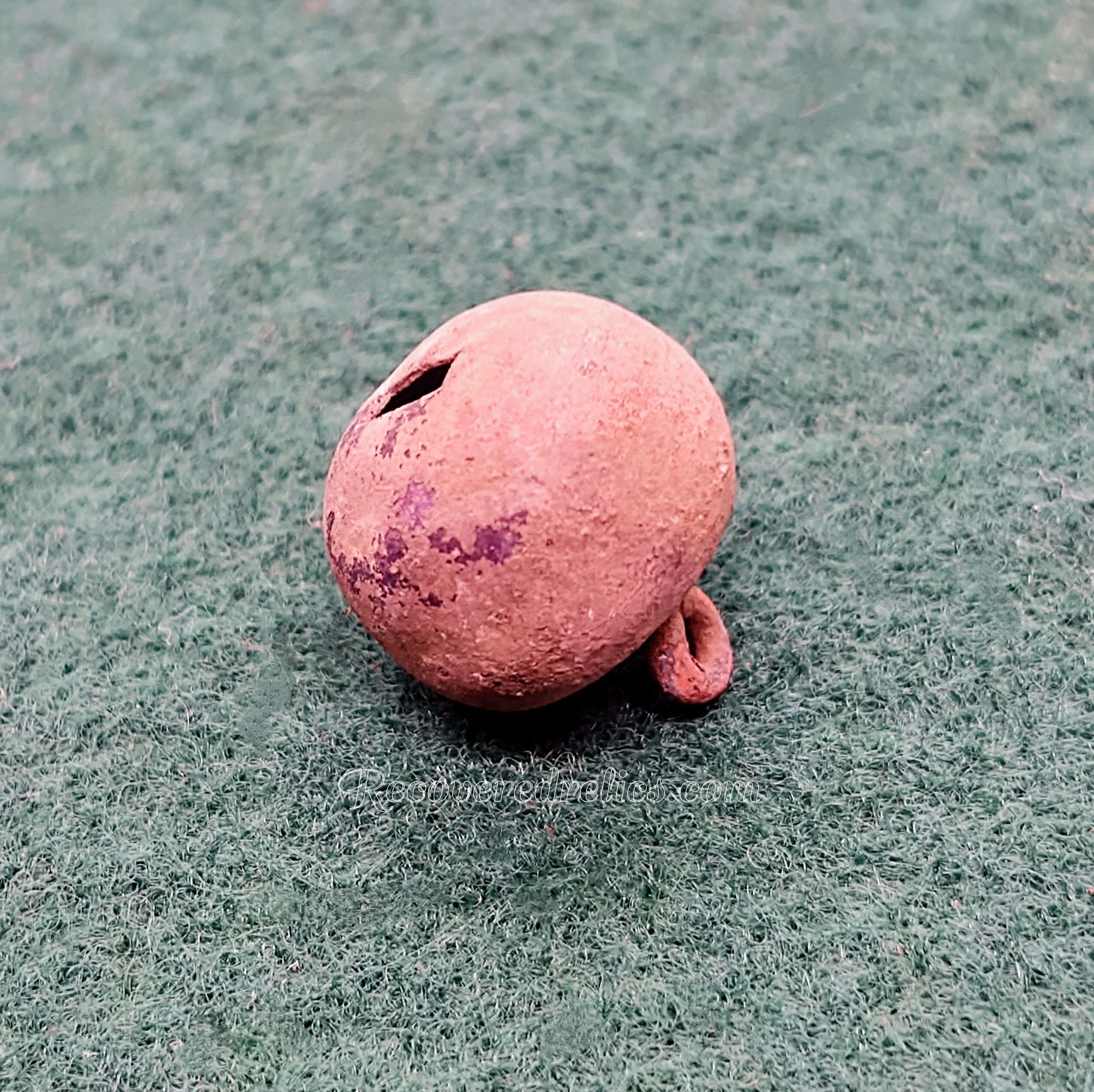
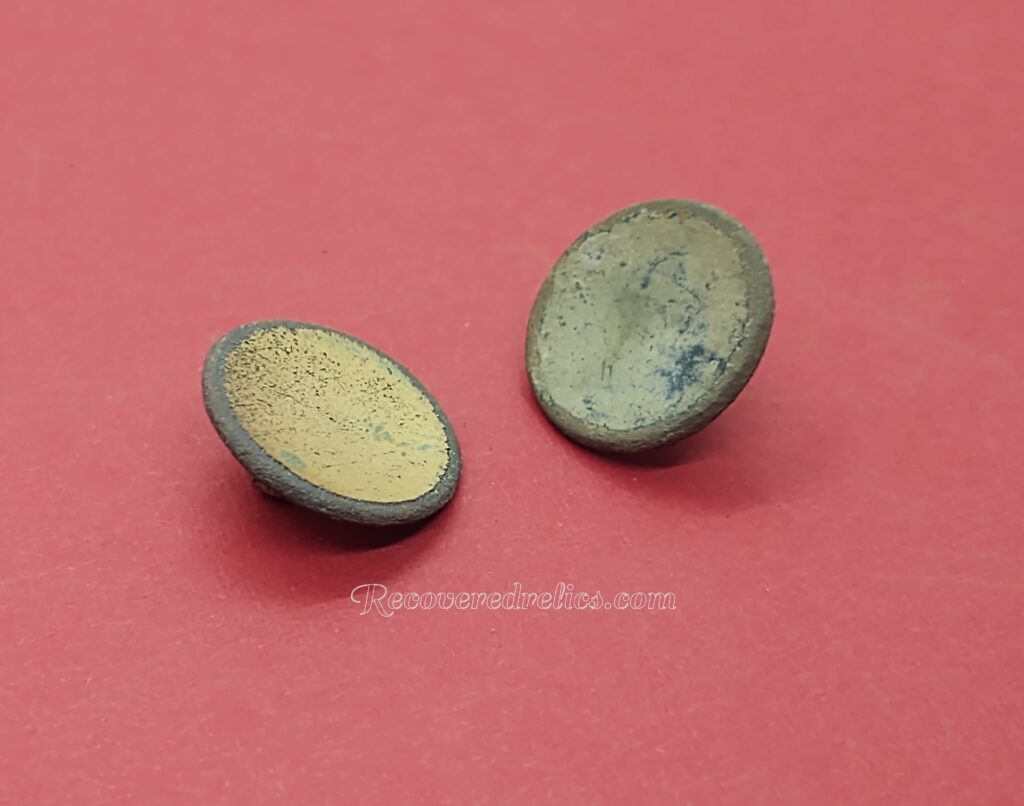
Concave One Piece Buttons– The discs on these one piece shank style buttons have a slight inward curve. These concave or dish shaped buttons are classically simple.
Conical Buttons – This late 18th century/ early 19th century style button is shaped like a cone. It’s alpha wire shank is flux joined to the back of the button.
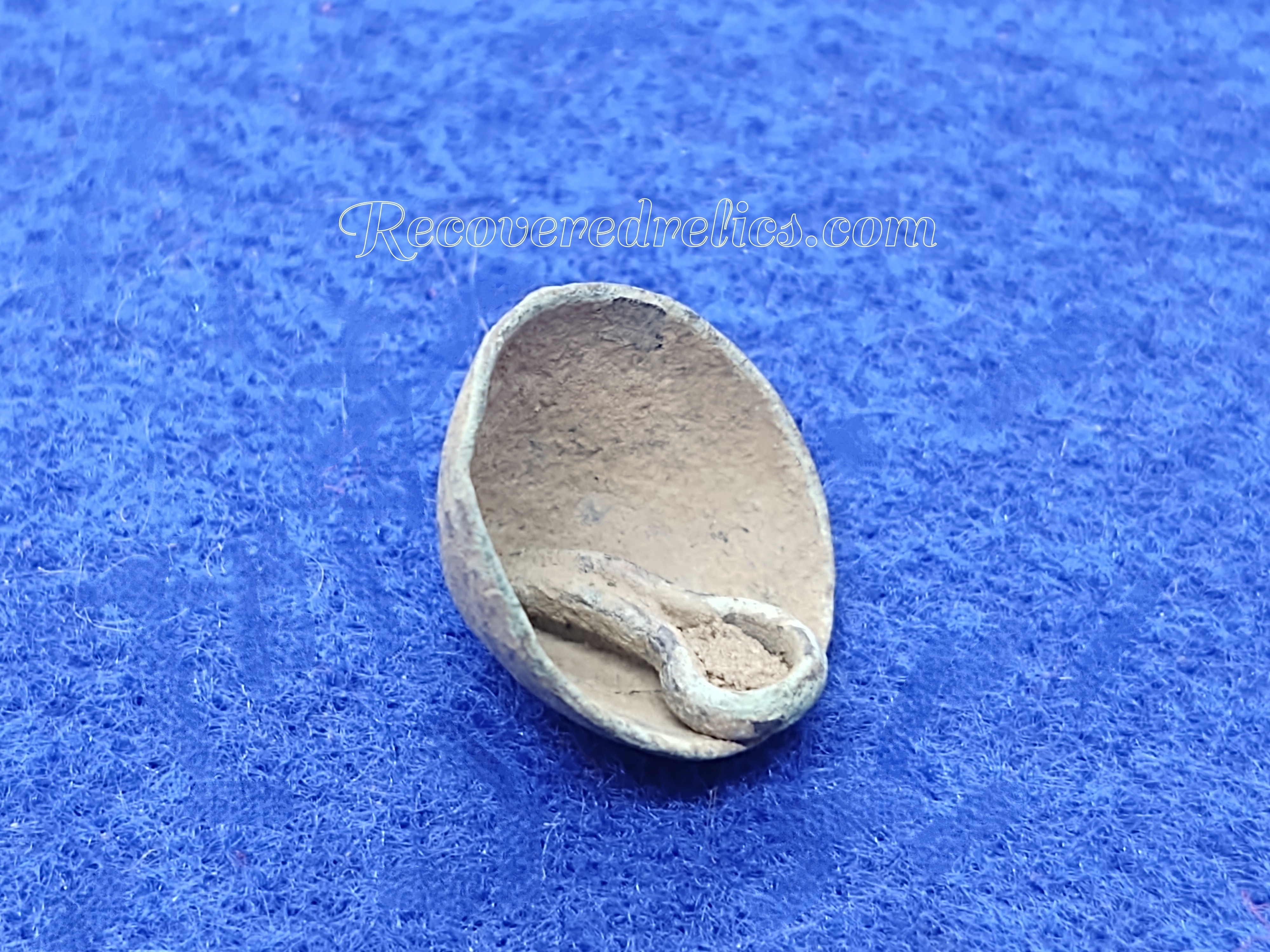
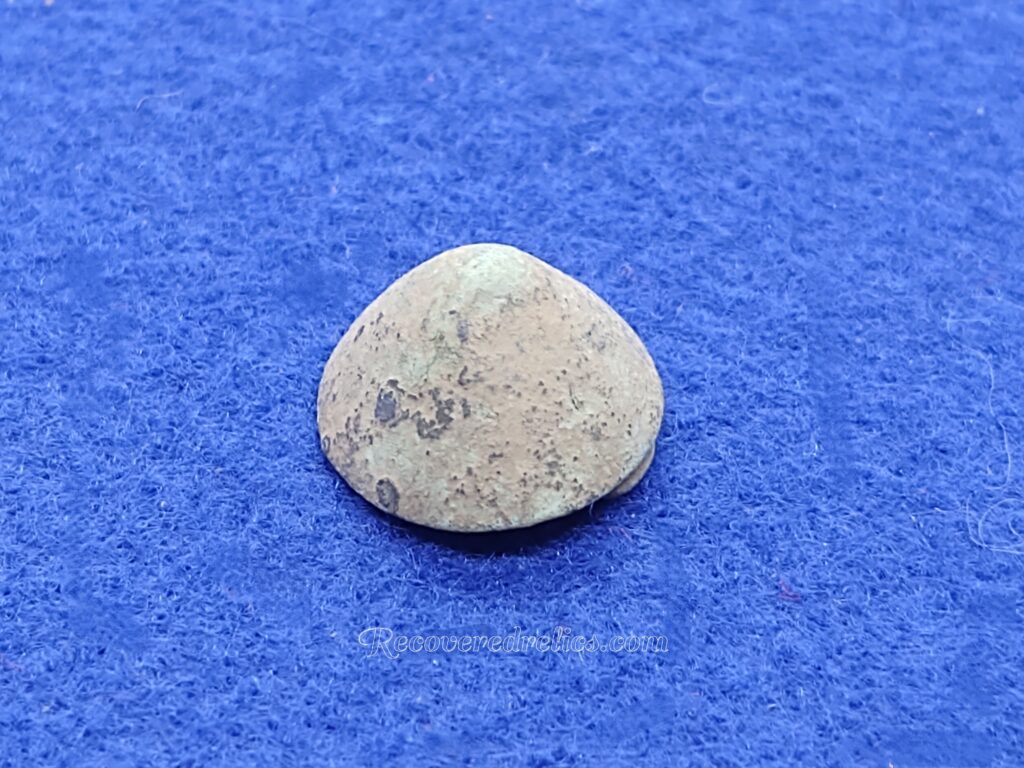
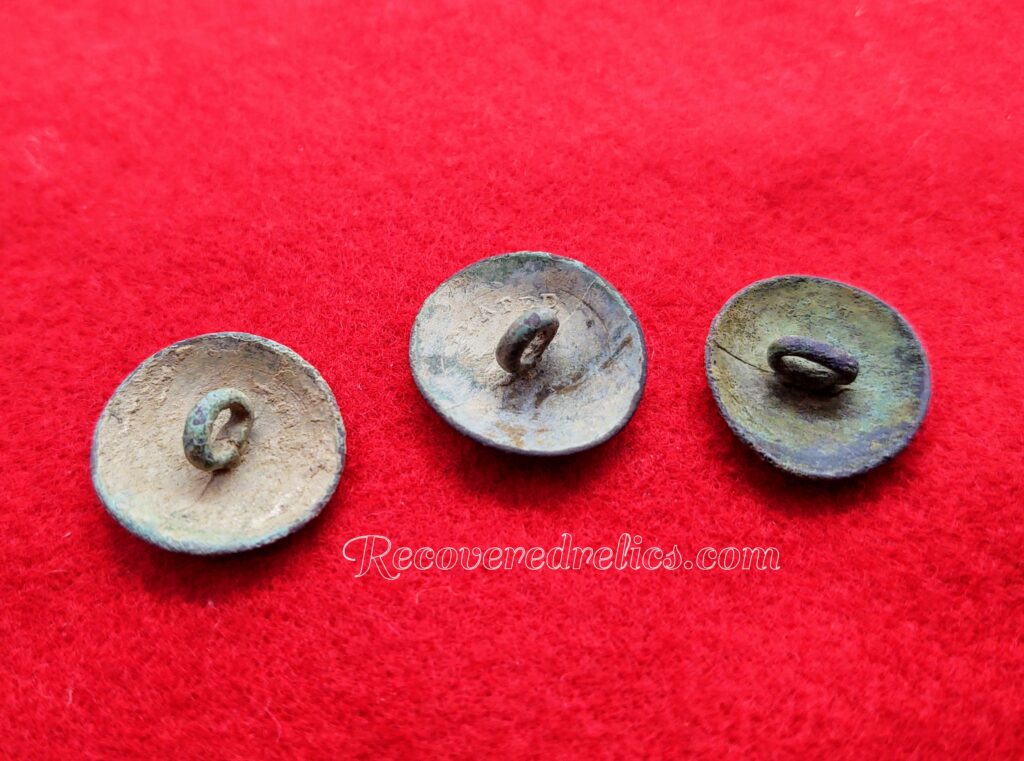
Convex One Piece Buttons– Convex one piece buttons are first cut from a flat circular shaped piece of metal often referred to as blanks. The convexity is given to them during the production process. After being annealed the blanks are made convex by a blow from a stamp.
Dandy Buttons (One Piece)– “Dandy Button” is a slang term used by detectorists to describe large (30mm in diameter or larger), often decorative, generally brass flat buttons that were popular during the late 18th century. This type of button was used by civilians and would have been sewn onto the colonists’ dressier more elegant attire rather than their work clothes.
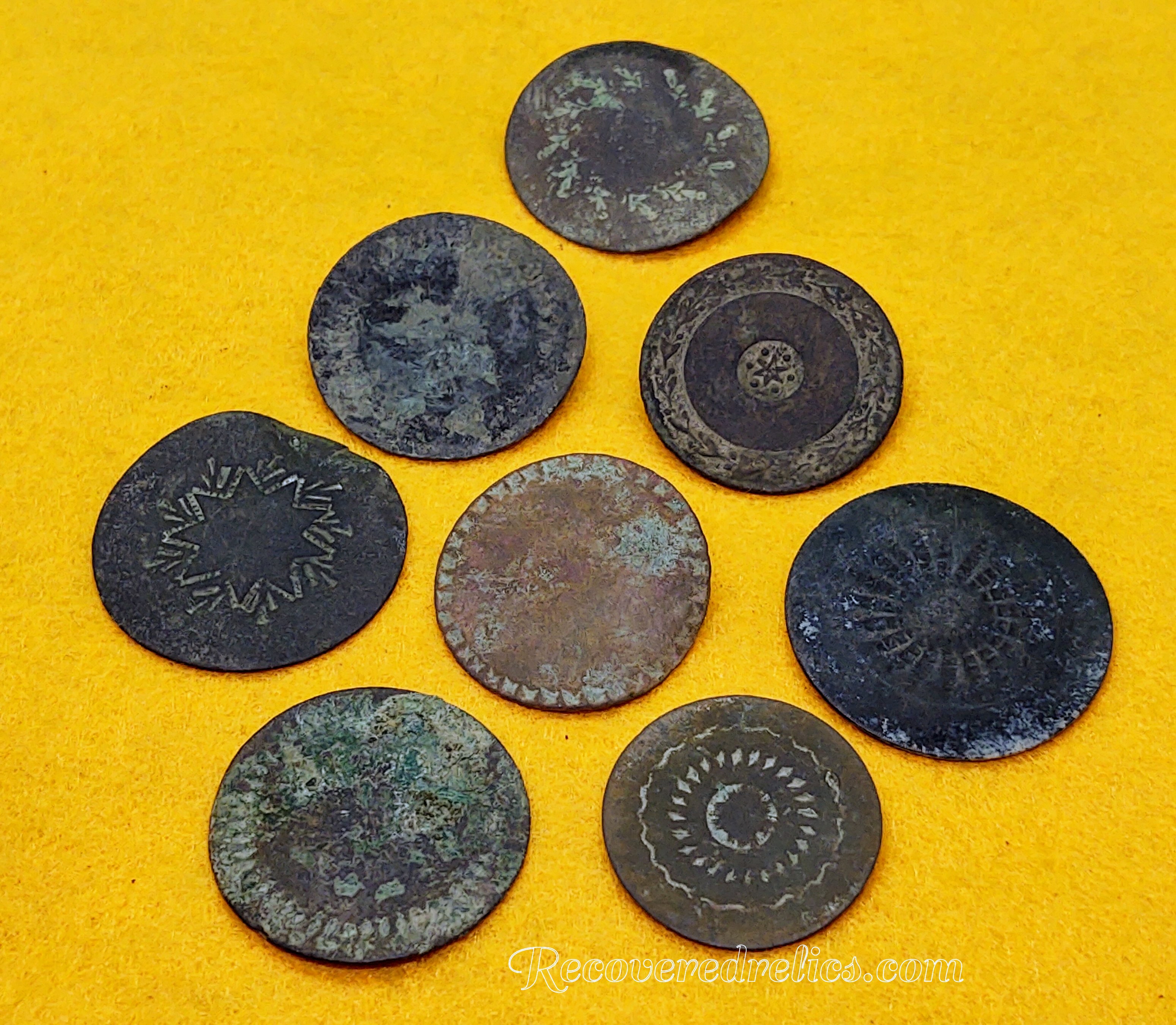
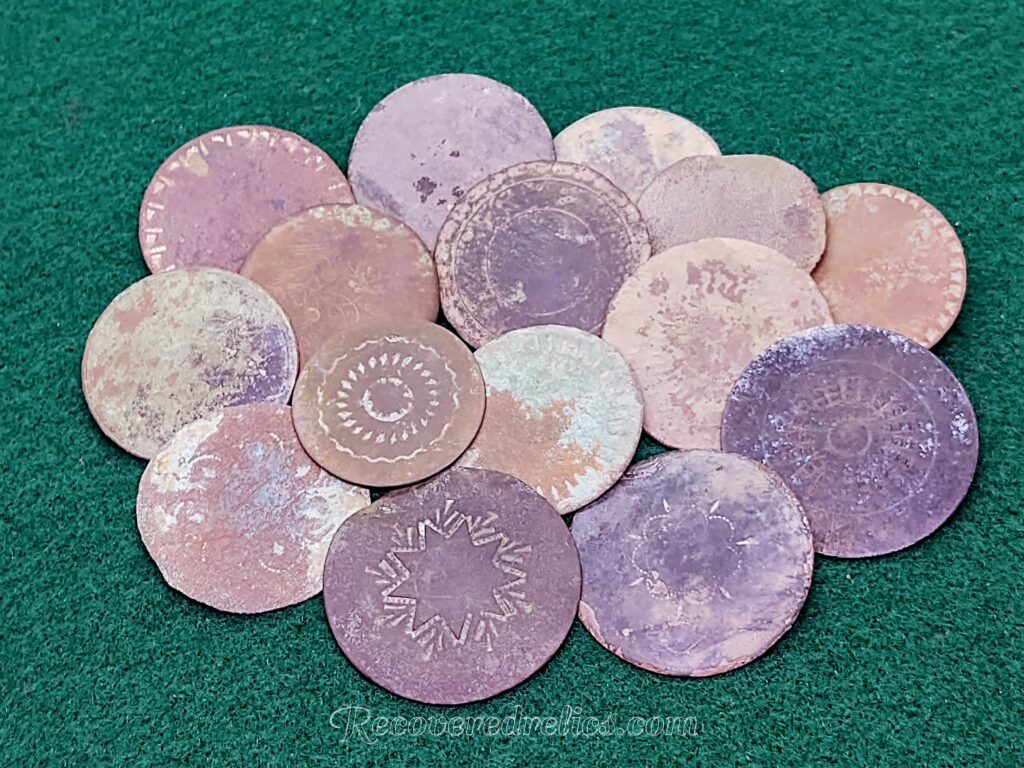

Decorative Civilian One Piece Flat Buttons– Designs or decoration on buttons were popular and added character. Brass and copper buttons could be stamped, engraved, chased, or die struck without losing strength or breaking. The majority of 18th century designs on buttons were either cast or hand cut by an engraver. This changed with the introduction of machine stamping around the year 1770. This new machine stamping technology produced button faster and was less expensive.
Flat Button (One Piece Button) (Flat Disc Buttons)– These brass buttons are flat discs with shanks. The shanks were either cast as part of the button or soldered onto the back. The cast or molded variety are made by pouring melted metal into a mold. The shank is formed as an integral part of the button. Sometimes the hole in the shank was drilled. The struck variety has a wire eye or loop shank that was usually fastened by brazing. Buttons such as these were particularly popular in the second half of the eighteenth century through the early nineteenth century.


Floral Designs– Designs were generally engraved, chased, or die stamped on one piece brass buttons. Delicate and elaborate floral patterns appear more frequently on one piece buttons manufactured after 1830.
Four Hole Metal Sewn-through Buttons– Sewn-through buttons typically have 2, 4, or 5 holes. Four hole metal sewn through buttons were popular in the 19th century. Sewn through style buttons were commonly used on underwear. There are several advertisements dating from the end of the 19th century and beginning of the 20th century which show four hole metal buttons being advertised as trouser buttons. They were sewn on trousers and used with suspenders. A four hole button would provide a much stronger hold than a shank button for ones suspender tabs. Four hole buttons are also sometimes referred to as brace buttons since they were used with suspenders.
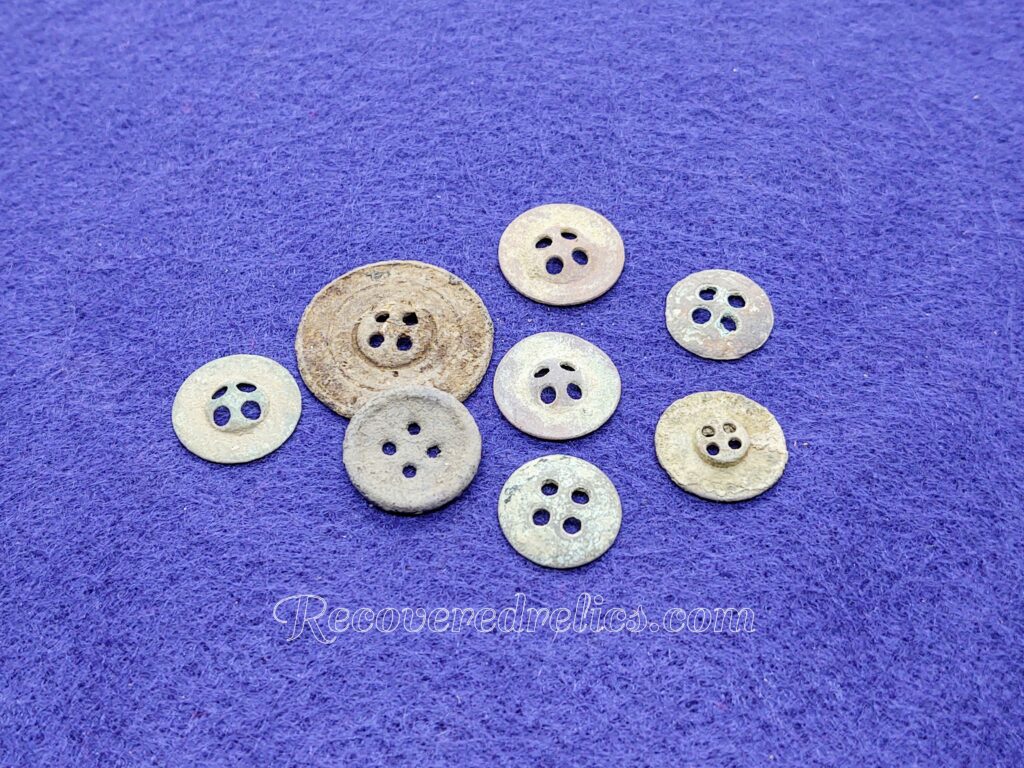
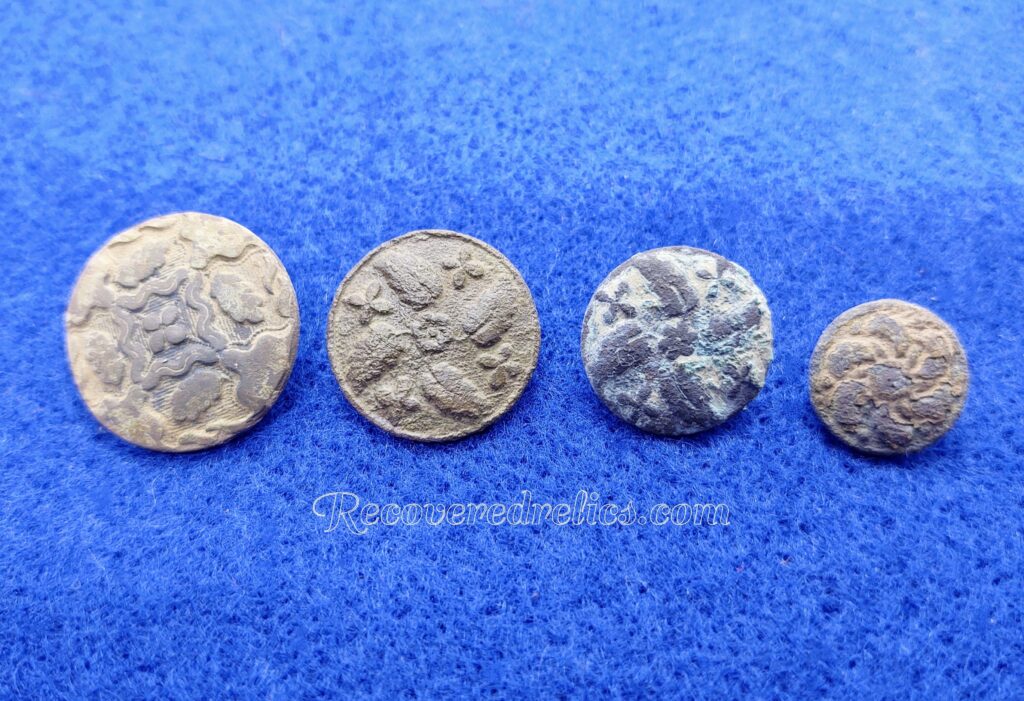
Geometric Designs– Geometric patterns are motifs or designs depicting abstract, non-representational shapes such as lines, circles, ellipses, triangles, rectangles, and polygons. They provide a sense of visual harmony and order. The symmetrical and repetitive nature of these patterns is aesthetically pleasing. Geometric patterns or motifs on one piece buttons were popular during the 19th century.
Gold Gilt One Piece Buttons– This style buttons began to emerge during the first half of the 18th century. Gold gilt was often applied to one piece buttons. Buttons could be plated or gilded without losing strength or breaking. Gilding was one of the most common surface treatments used on button during the end of the 18th century and the beginning of 19th century. A gilt button has a very thin layer of precious metal covering it. A great many of the once gilded buttons we find no longer have any gilt left on them.
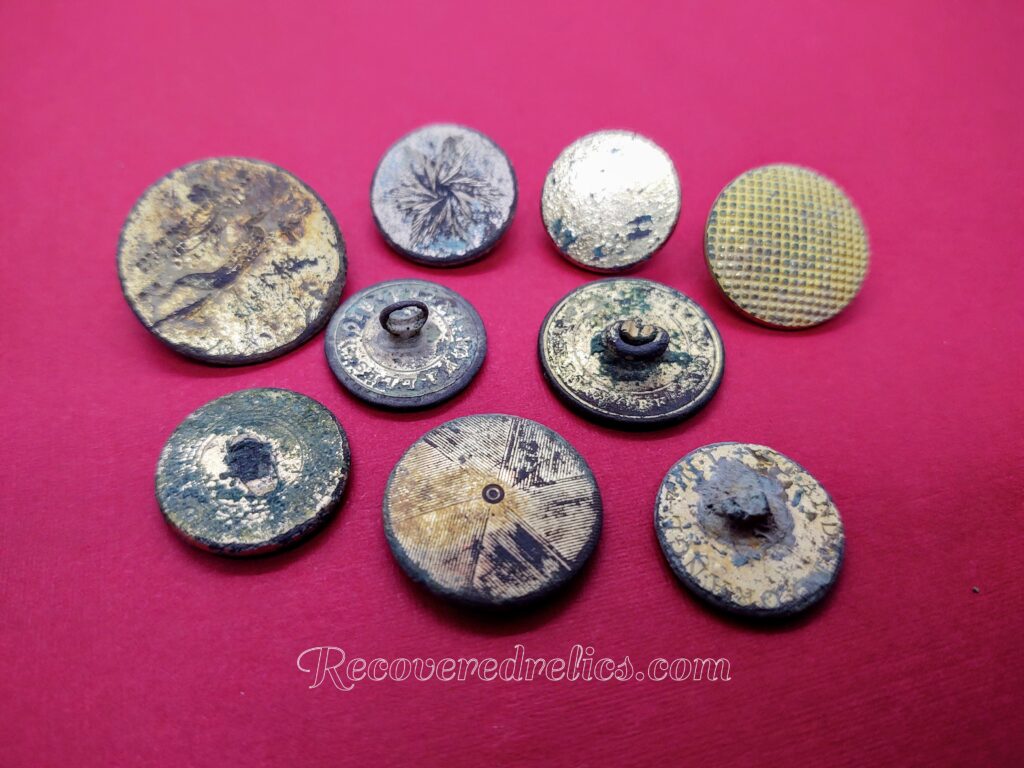
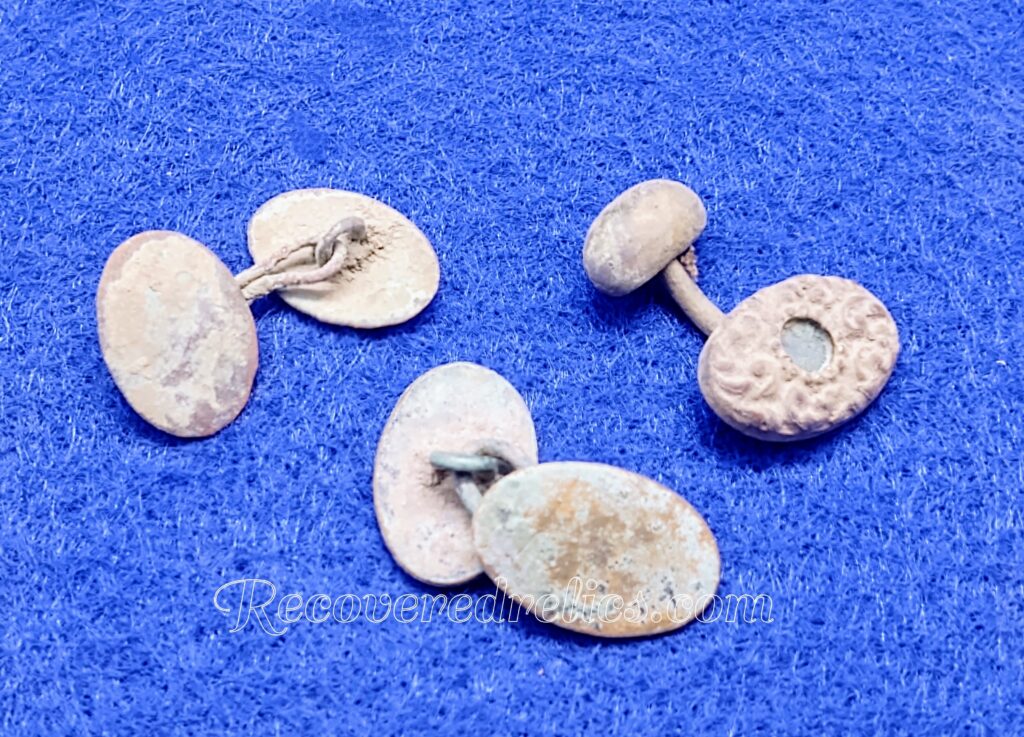
Linked Buttons or Cufflinks– A pair of buttons attached by a thin metal chain link or toggle. Cufflinks are used to secure the cuffs of ones shirt together. During the 18th century, linked buttons were not just worn around ones cuffs though. Historic paintings from the time period illustrate that linked buttons were also worn by men at the neckline and waistline.
Livery Buttons: The term livery can be identified as a design often a uniform, ornament, symbol, or insignia that designates ownership or affiliation. These 19th century buttons have intriguing designs rooted in the histories of noble and respected families. Identifying livery buttons can be extremely difficult since often the same crests were shared by many families.


Nipple Buttons– Mid 17th Century buttons. These buttons are typically fashioned from tombac. Many pewter examples have also been found. They get their name from the small protrusion or raised point in the center of each button.
Open-work Buttons– Open-work is a term for any technique that produces decoration by creating holes, piercings, or gaps that go right through a solid material. The button pictured is an example of an 18th century open work shank style button.
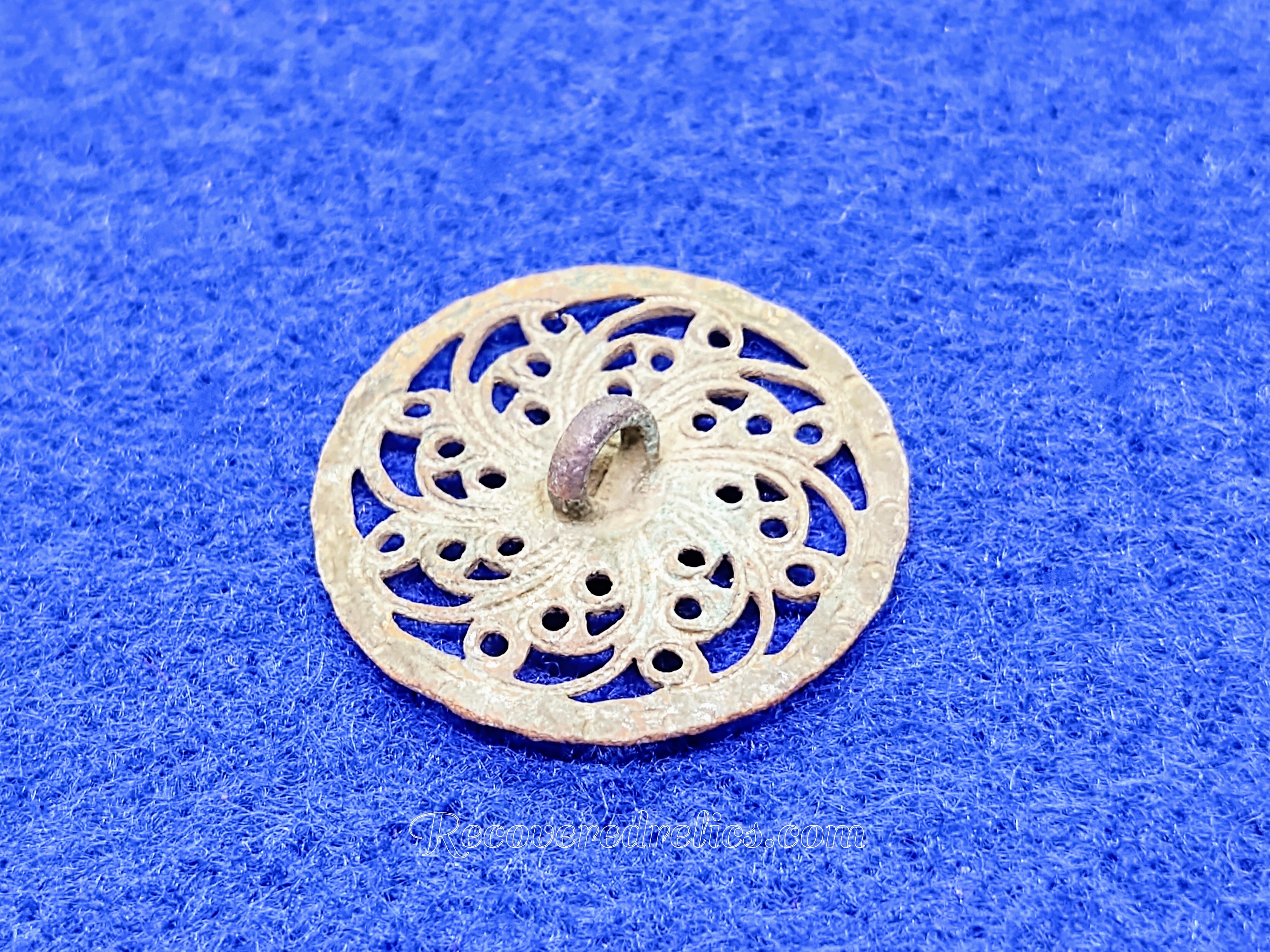
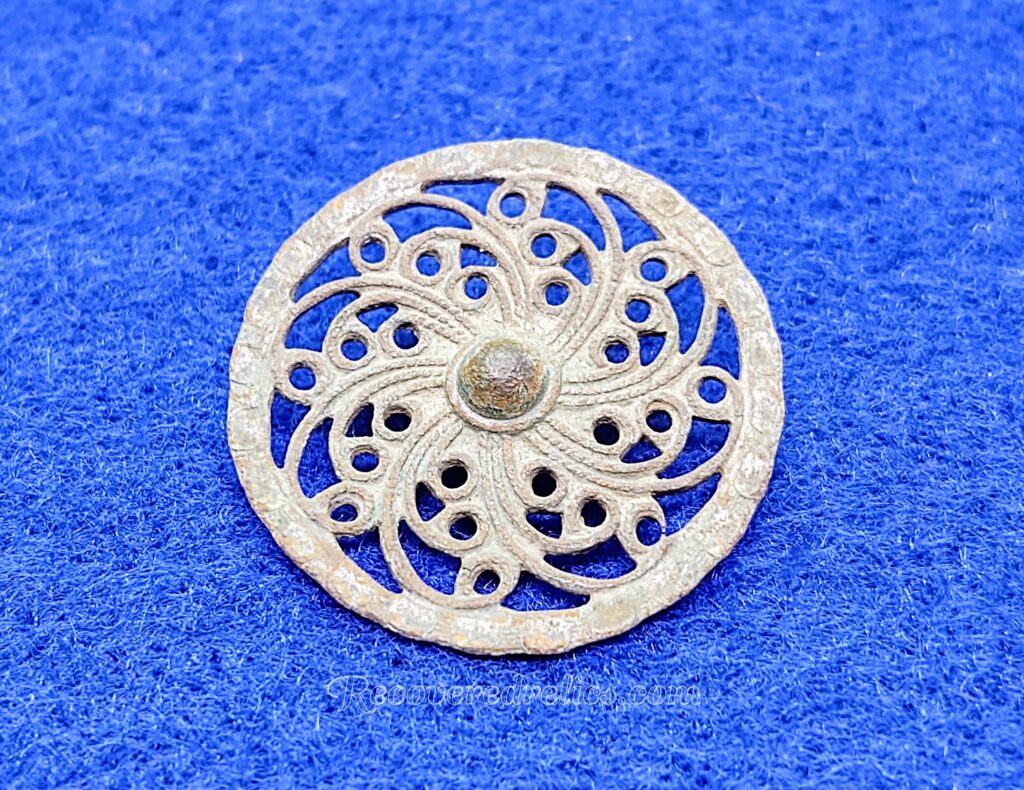
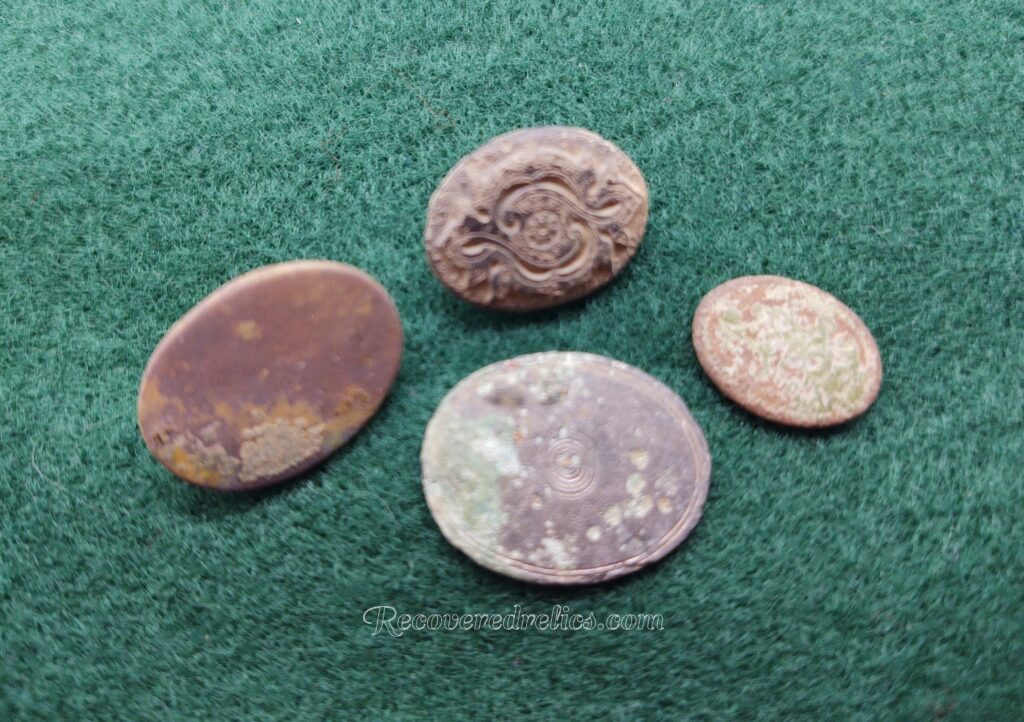
Oval Shaped Shank Style Buttons– One piece buttons from the 18th and 19th centuries aren’t always round in shape. Round shaped one piece shank style buttons are certainly the most common. Some other shaped one piece shank style buttons include oval, square, rectangular, and octagonal.
Pewter Buttons– Pewter metal is comprised mainly of tin which is mixed with varying proportions of lead, zinc, antimony, bismuth, or copper. The best quality pewter contains a very tiny amount of lead. Pewter was a durable and practicable metal for making buttons. The pewter buttons we find metal detecting are fragile and should be handled with great care. Pewter buttons were popular during the 18th and 19th centuries.

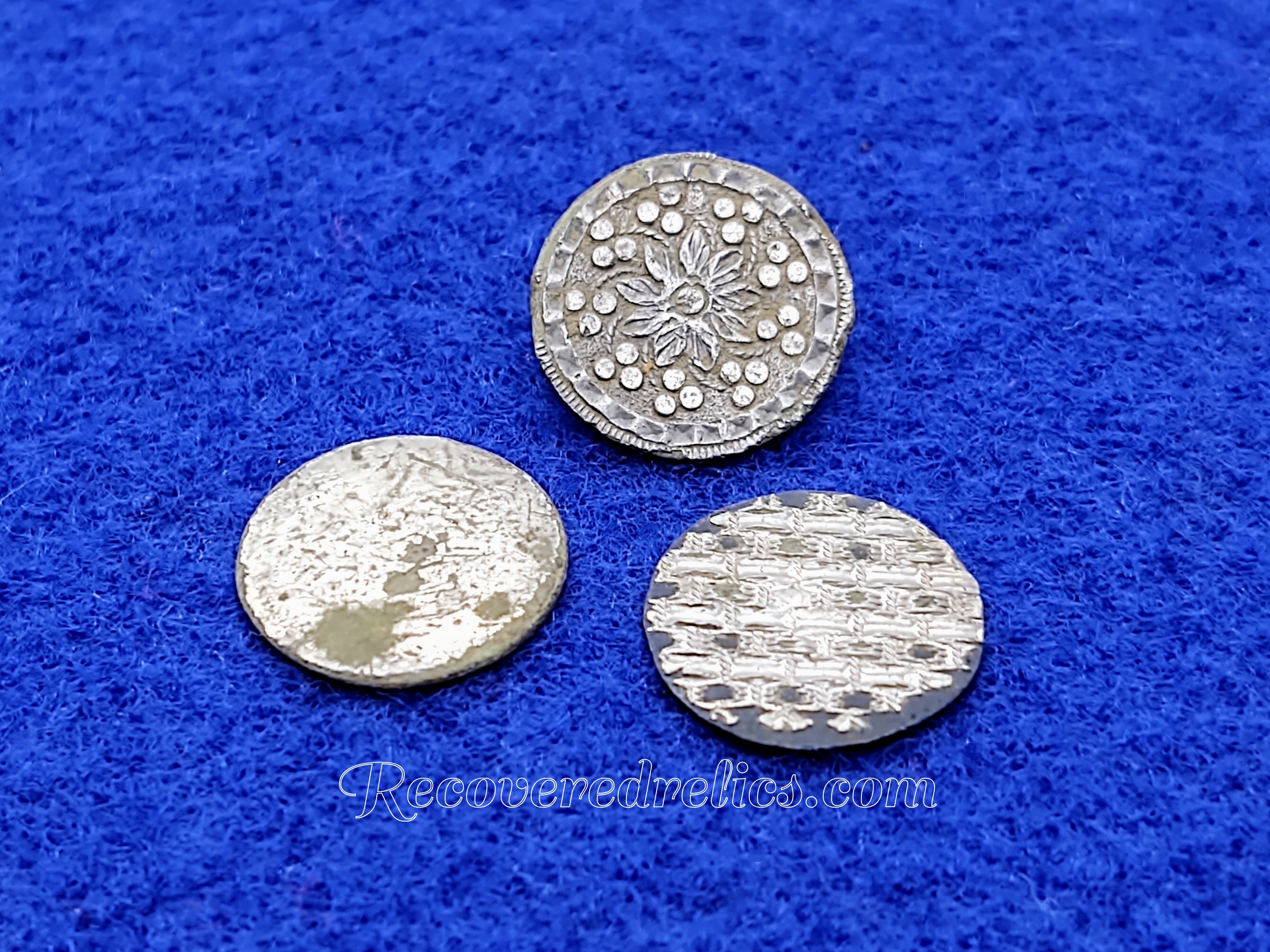
Silver-wash or Silver Gilt One Piece Buttons– Silver was also a popular color. This style button began to emerge during the first half of the 18th century. Gilding or plating gives a button a silver appearance at the fraction of the cost. These buttons resembled the brilliance of silver while at the same time were much lighter and easier to wear. Gilt buttons although pricier than brass buttons were not exactly expensive. I imagine that people liked them because they were both elegant and affordable.
Star Design – Star designs were extremely popular. The symbol has been used for thousands of years. It holds cultural and religious significance across various historical contexts. Today when we picture a star, a 5 point pentagram is probably what most likely what comes to mind. Six, seven, or eight point stars were nearly as common as five pointed stars in the 18th and 19th centuries.
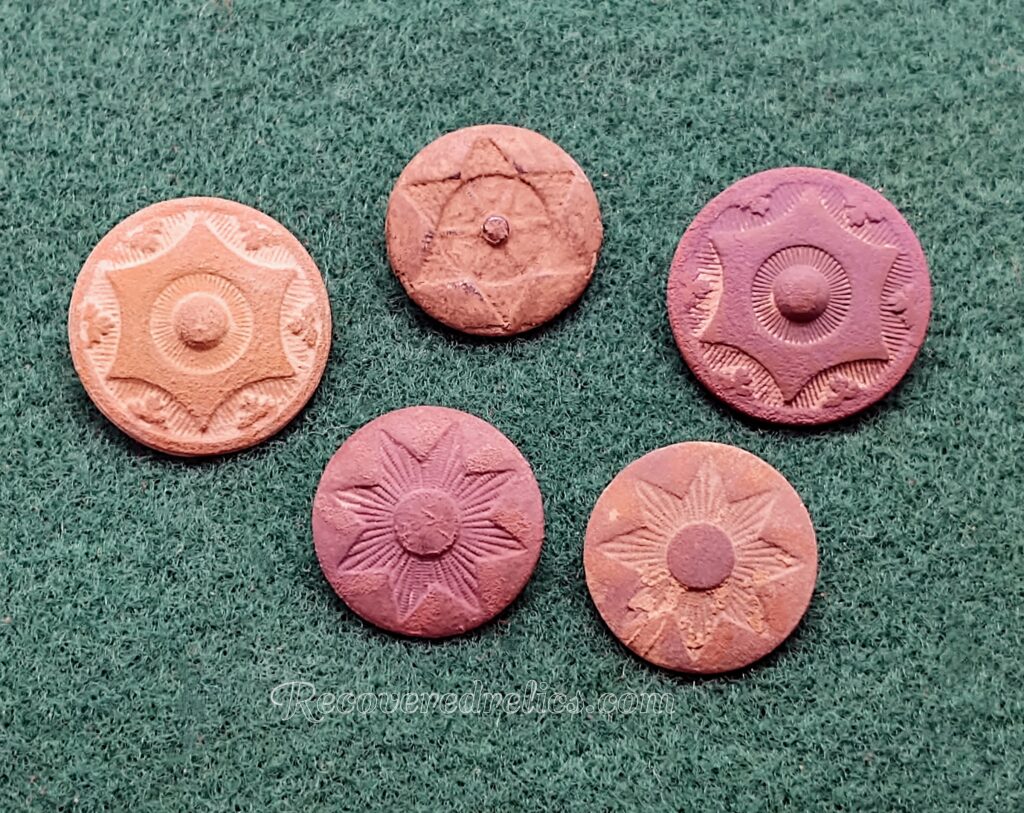
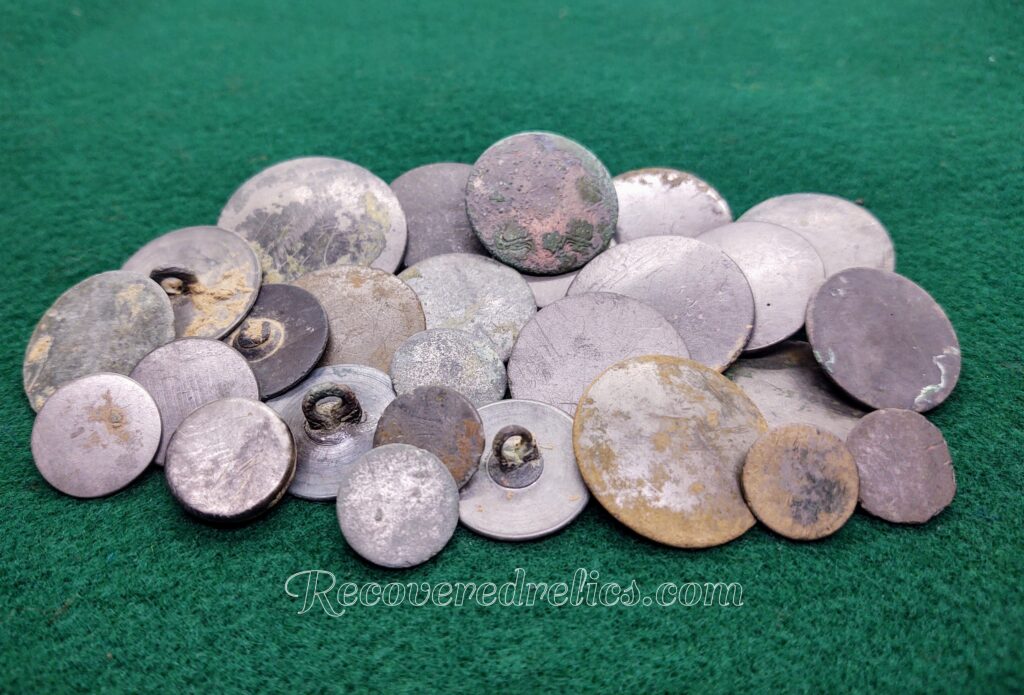
Tombac Buttons– Around 1760 a form of brass called tombac was developed. Tombac buttons were very popular during the end of the 18th century. They have a distinct silvery look. The high zinc content makes tombac button rather brittle. Decorations were normally engraved rather than stamped.
Two Piece Button– This type of button is made from two pieces, a front shell and a back plate to which the loop shank or wire eye is attached, usually by brazing. The two parts are then fastened or folded together at their rims. The edge of the front shell is turned over the back piece. Two piece brass buttons appeared in England around the year 1813 and were well established by the 1820’s. Production of these two piece brass buttons peaked in the United States between 1830 – 1850.
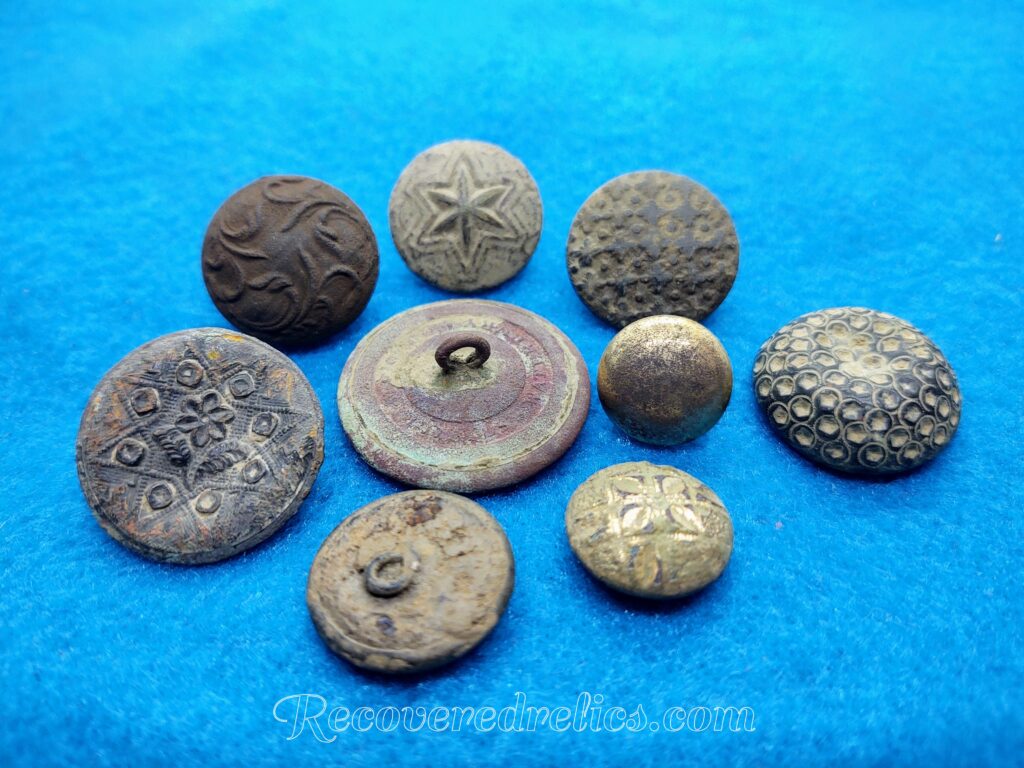
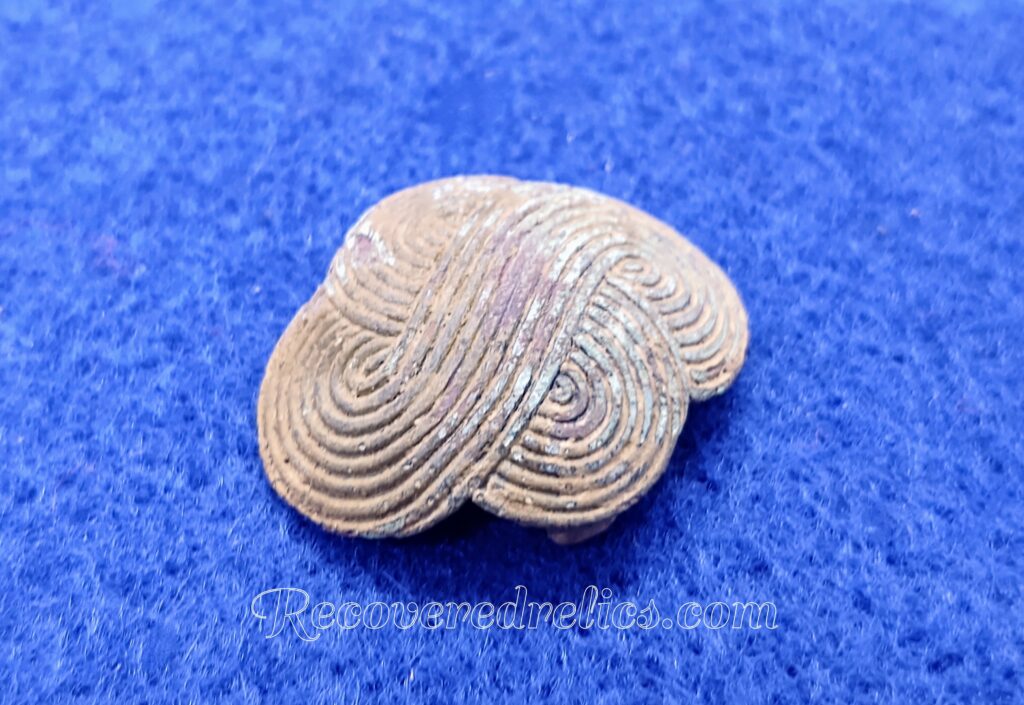
Shoe Button Covers– Button covers were extremely popular during the 1920’s. During that time, it became a growing trend for women to cover up the plain buttons on their shoes with decorative button covers. Shoe button covers can be easily identified by their attachment feature which is located on the backside of the button cover.

Buckles
Baldric Buckles– Buckles used on baldrics were typically double framed style buckles with center bars. A baldric is a broad belt or strap used to carry a sword or another piece of equipment such as bugle. Baldrics were traditionally worn over ones right shoulder and reached down to the opposite hip. The amount of buckles that were used on any given baldric varies. Some had more buckles than others depending on the design. There were typically at least one heavy, large sized buckle attached to the main strap and several smaller sized buckles used hold the sword or piece of equipment securely in place. Baldric buckles fall within the clothing category.
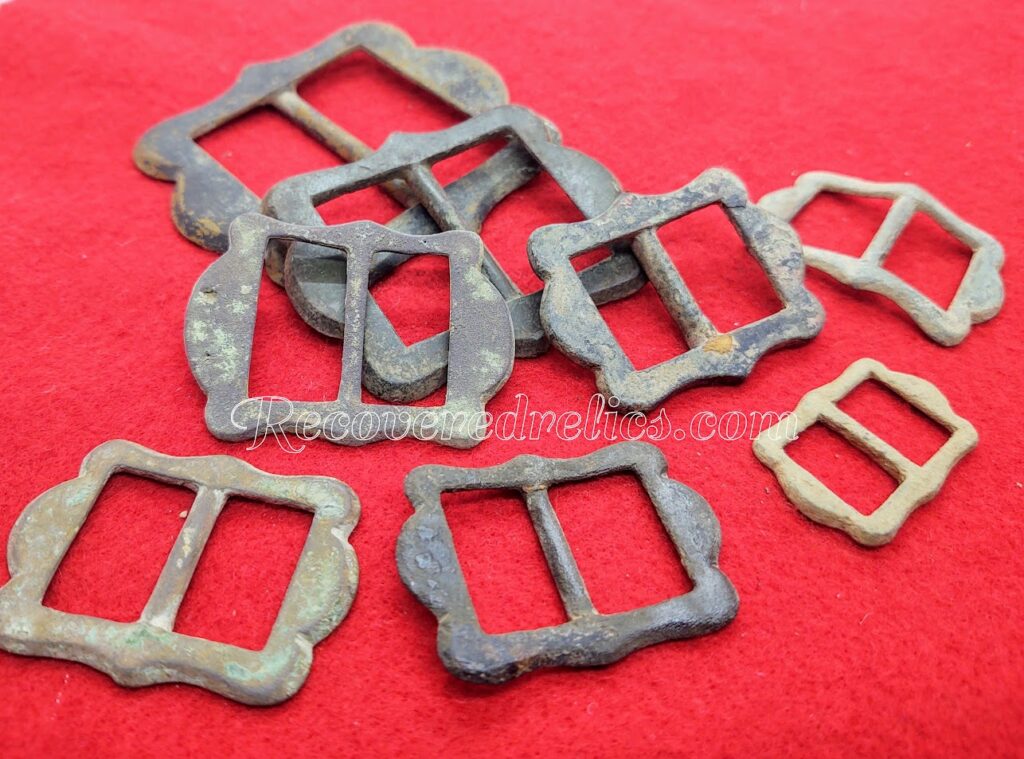
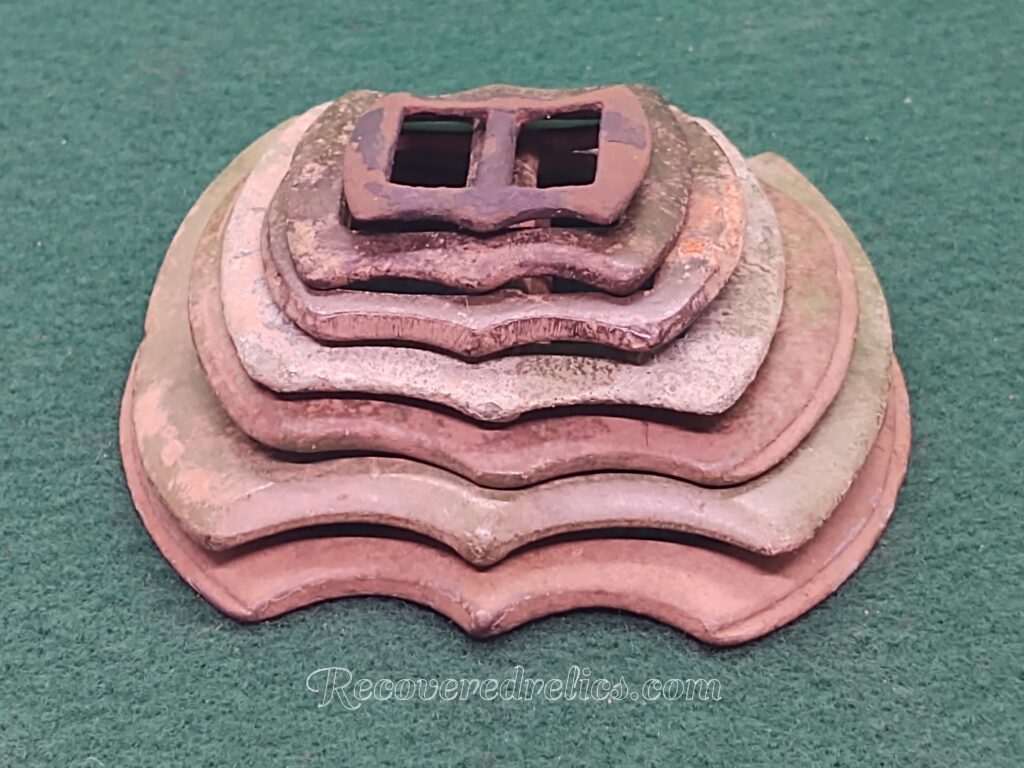
Batwing Buckles– This style buckle is double framed with a center crossbar. The two vertical sides of the frame that are parallel with the center bar are convex. They curve outward. The other two sides of the frame each have two concave curves which in turn form three points on each side. Picture a bats wings and how it curves inward multiple times and forms points. The frame of the batwing buckle is similar in design to the shape of a bats wings. These buckles are a bit of a mystery. We don’t have any concrete information regarding how these buckles were used or their age or origin. The great majority of these recovered buckles have been found in North East states primarily New York, Connecticut, and Massachusetts.
I am collecting data regarding these buckles so if you have dug one or have an undug example I would greatly appreciate it if you could complete the online survey at https://my.forms.app/form/60c6b22c064c3505fa5440d6
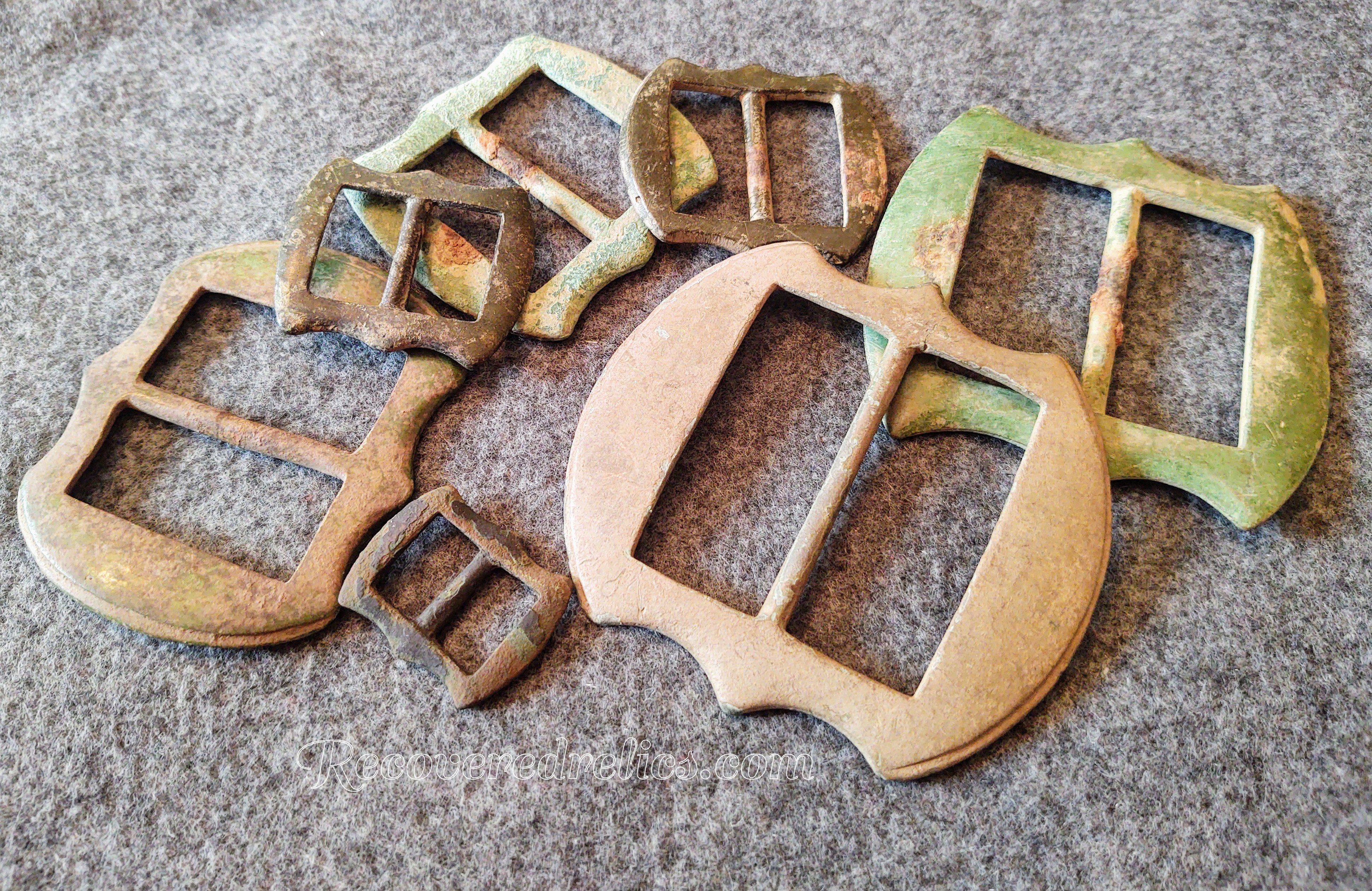
Center Bar Buckles (Horse Related)– This type of buckle features a centrally located connector bar. Center bar buckles are typically rectangular or square shaped. A pin is attached to the center bar and helps to secure the buckle in place.
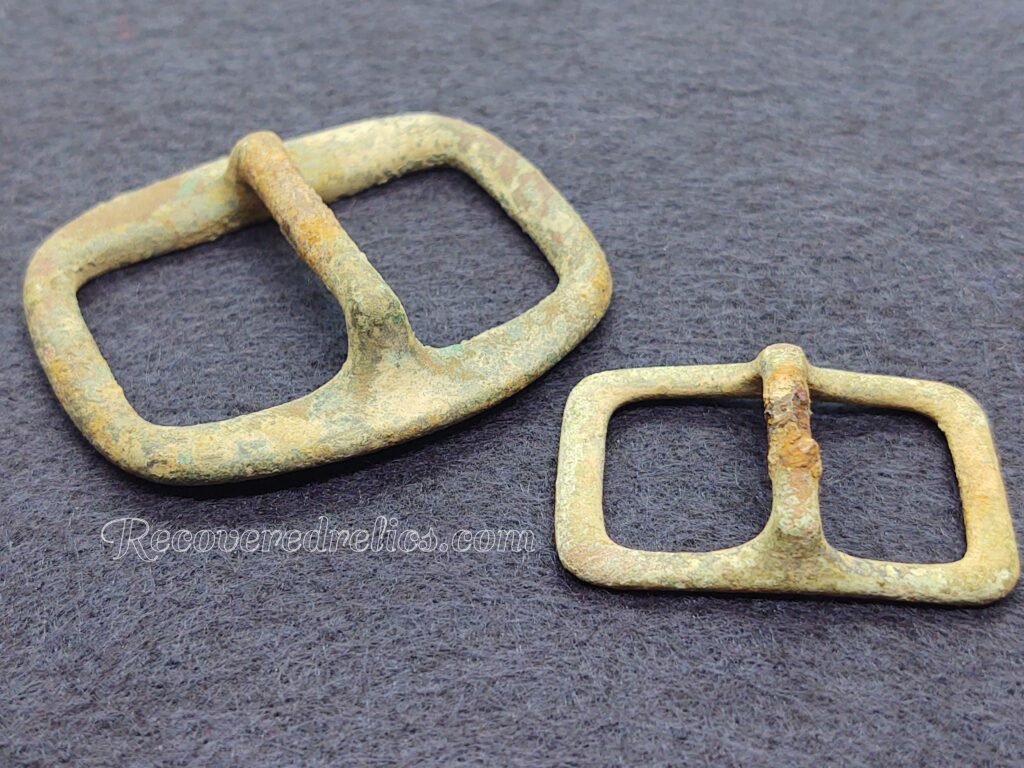
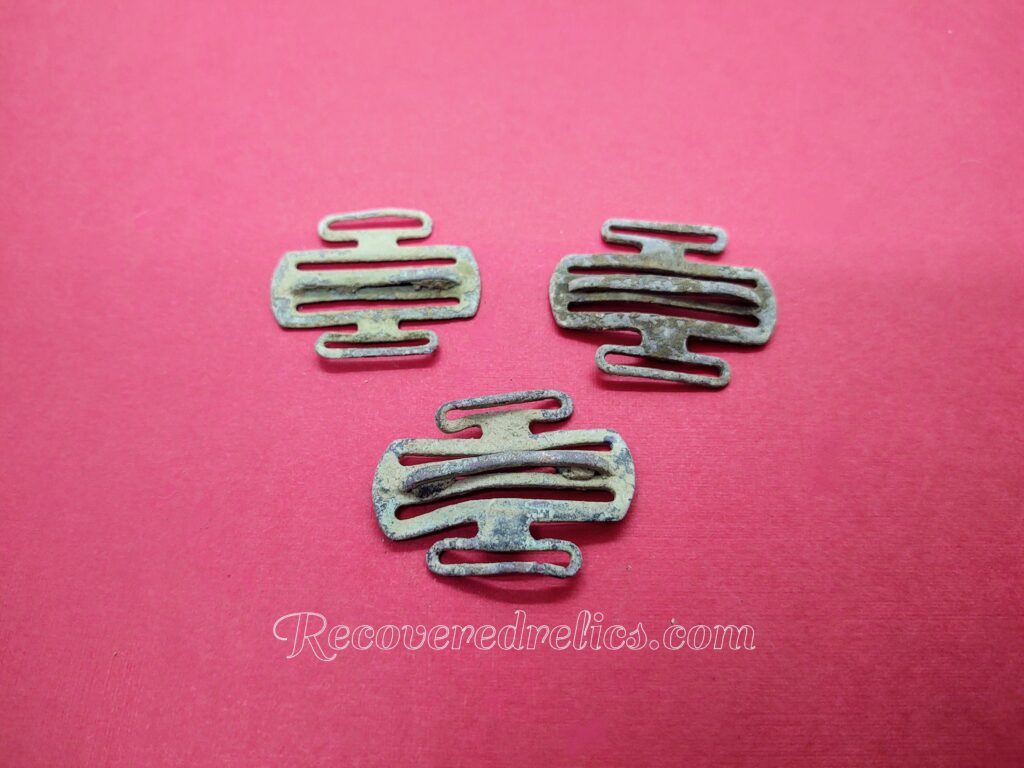
CH Guyoyt Suspender Adjuster Buckles– Charles Guyot from Paris, France invented this particular form of suspenders strap adjuster. He patented several versions. Historians believe that these adjuster suspender clasps were manufactured in the early 1900’s.

D-Shaped Single Framed Buckles (Horse Related)– D Shaped buckles are common metal detecting finds. These utilitarian buckles are simple in design and are quite versatile and practical. The D Shaped style buckle frame has been around for centuries. This style buckle was often used on horse harnesses or other horse related equipment.
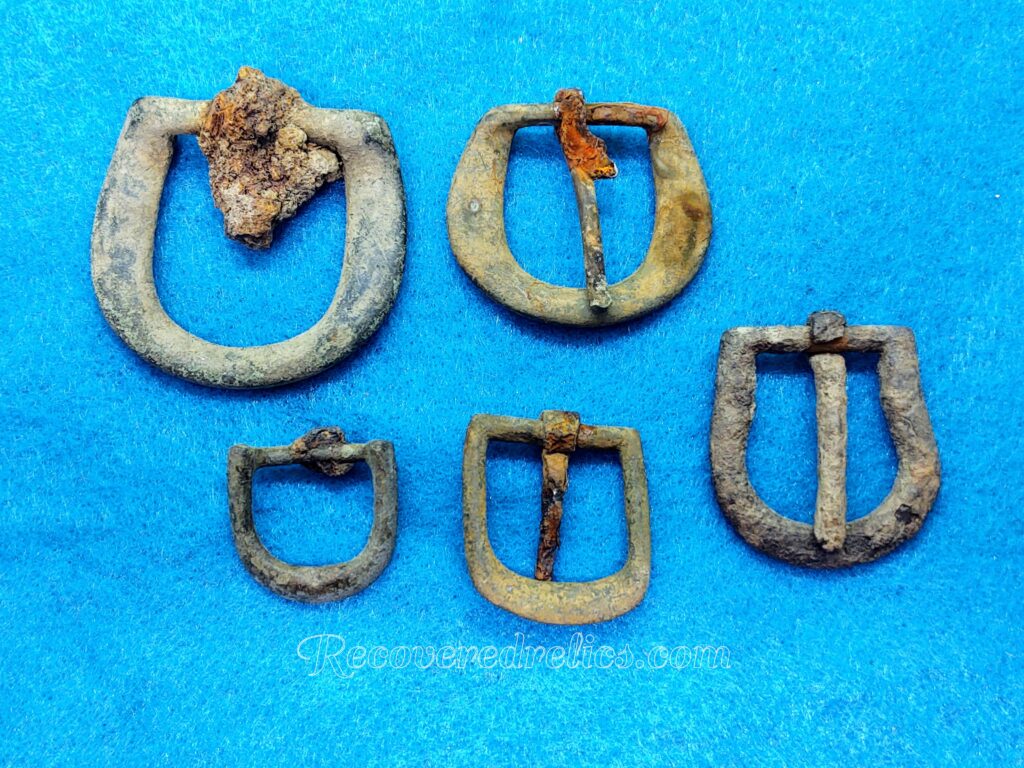
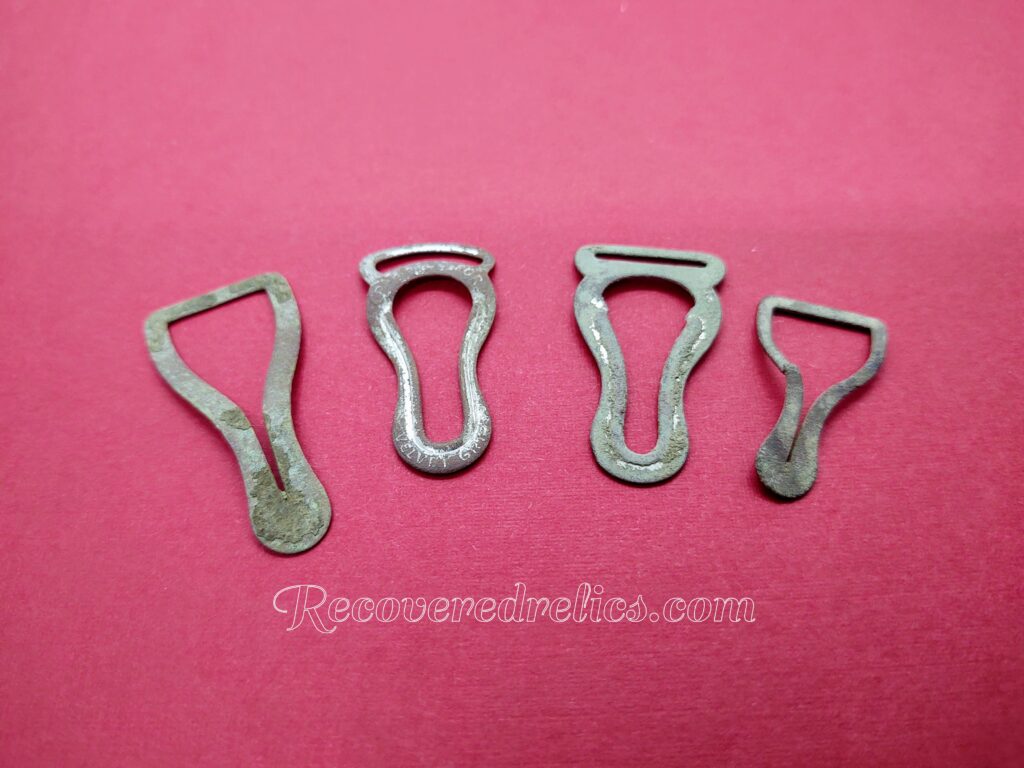
Hose, Stocking, or Sock Support /Garter Buckles– This style buckle or clasp is typically used as support for hose, stockings, or socks and is attached to a cloth strap or fabric piece that is worn around or on ones leg. Men, women, and children made use this style buckle or clasp during the 19th and 20th century in order to hold up and support their stockings or socks.
Knee Buckles– Knee buckles were used to hold ones breeches in place below or above the knee and to hold up ones stockings. On knee buckles, the pin is generally positioned between the short sides of the frame so that the buckle can be oriented vertically. Knee buckles were worn exclusively by men. Men began using knee buckles along with buttons after the year 1735. By the year 1750 knee buckles were a common everyday item used to fasten men’s breeches.
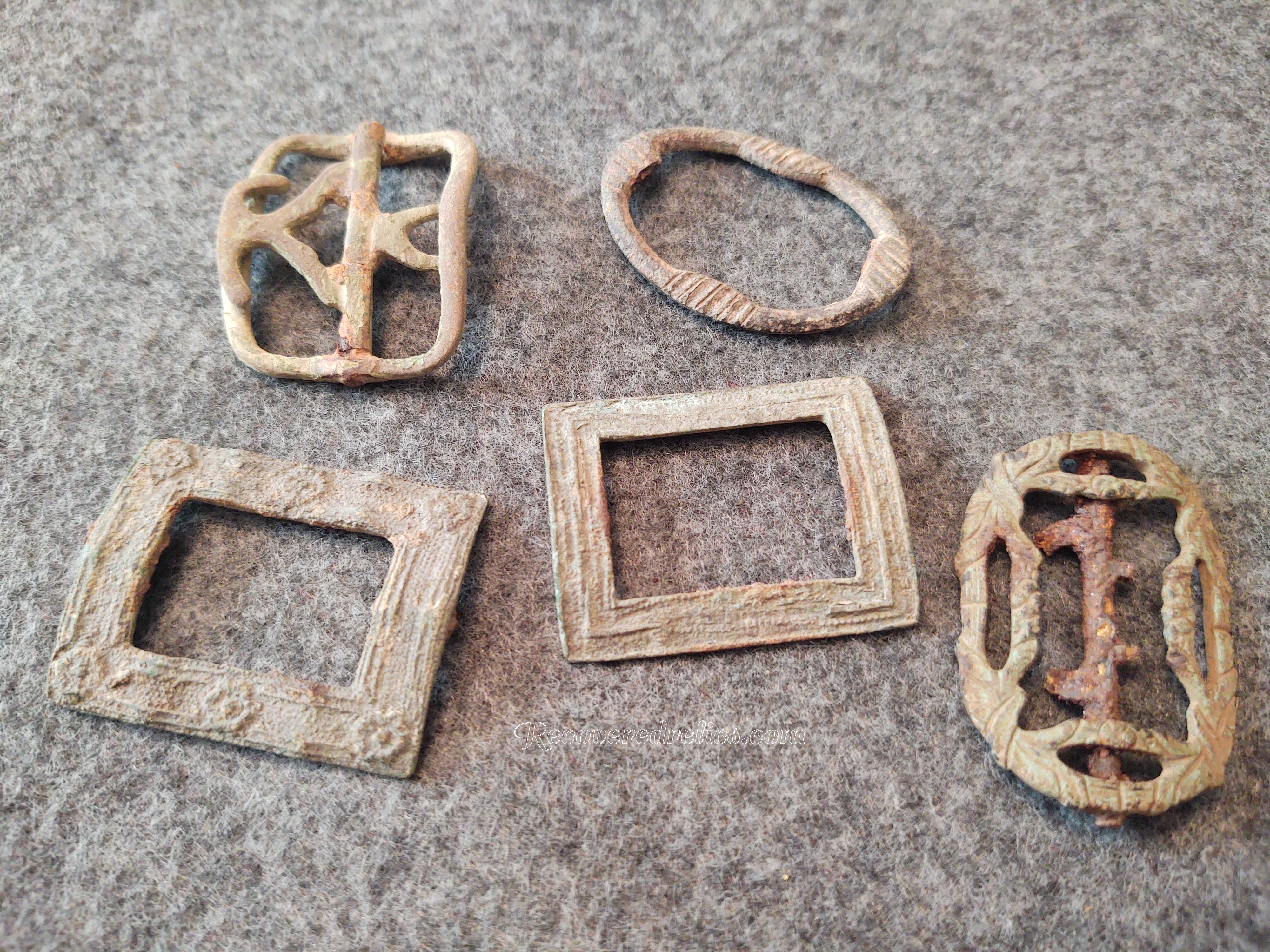
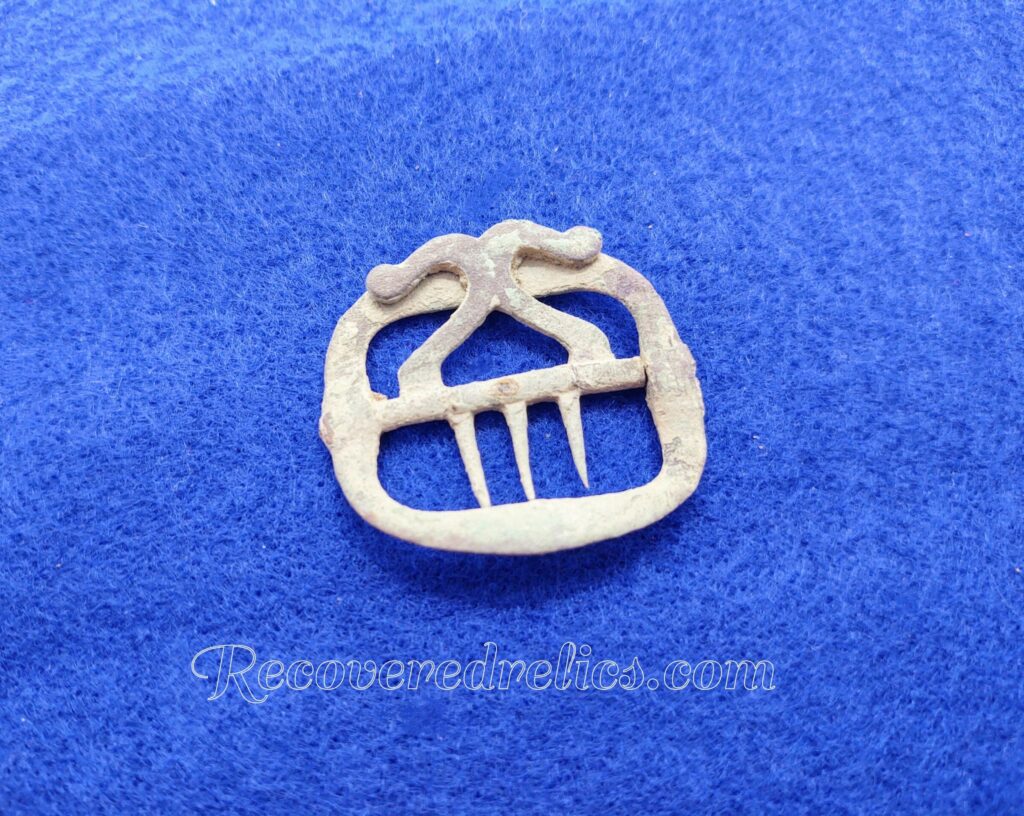
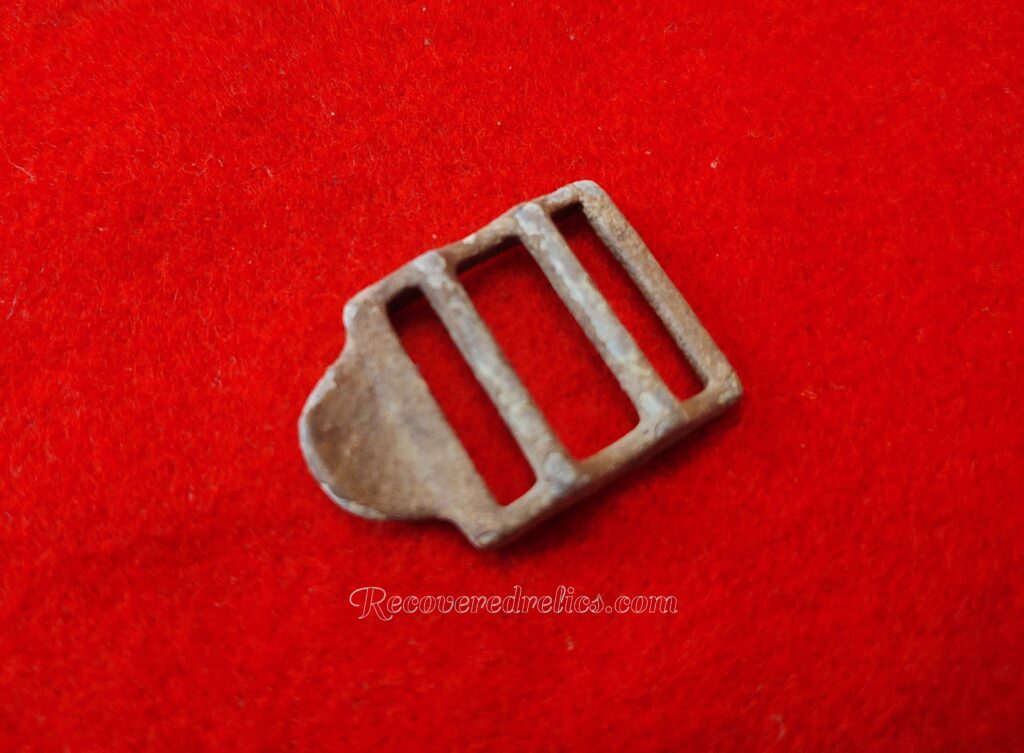
Ladder Buckles– This style buckle was commonly used on saddle bags. They make great bag fasteners because they are designed to hold under tension and easily release by lifting the front tab. This style buckle also allows for one to easily adjust the length of their straps. This style buckle is still manufactured today.
Neck Stock Buckle– A neck stock buckle is a buckle that fastens a stock. A stock is a piece of cloth designed to wrap around one’s neck. Stock buckles are worn at the back of ones neck, to hold in place stock or scarf. They were worn by men beginning around the year 1720 and remained in style until the end of the 18th century. Stock buckles can be plain or more elaborate in design. Many included designs with gems or pastes. Their frame is typically rectangular or oblong. There are one piece neck stock buckles and also two piece neck stock buckles. They can be easily distinguished from other kinds of buckles by the studs on the end of the chape. These studs were designed to fit into holes on one end of the stock. Stock buckles were typically worn with formal attire.
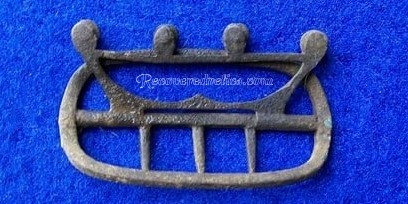
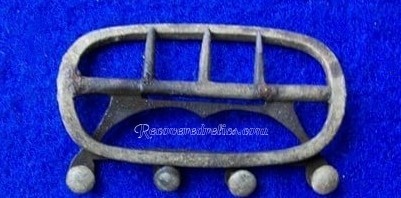
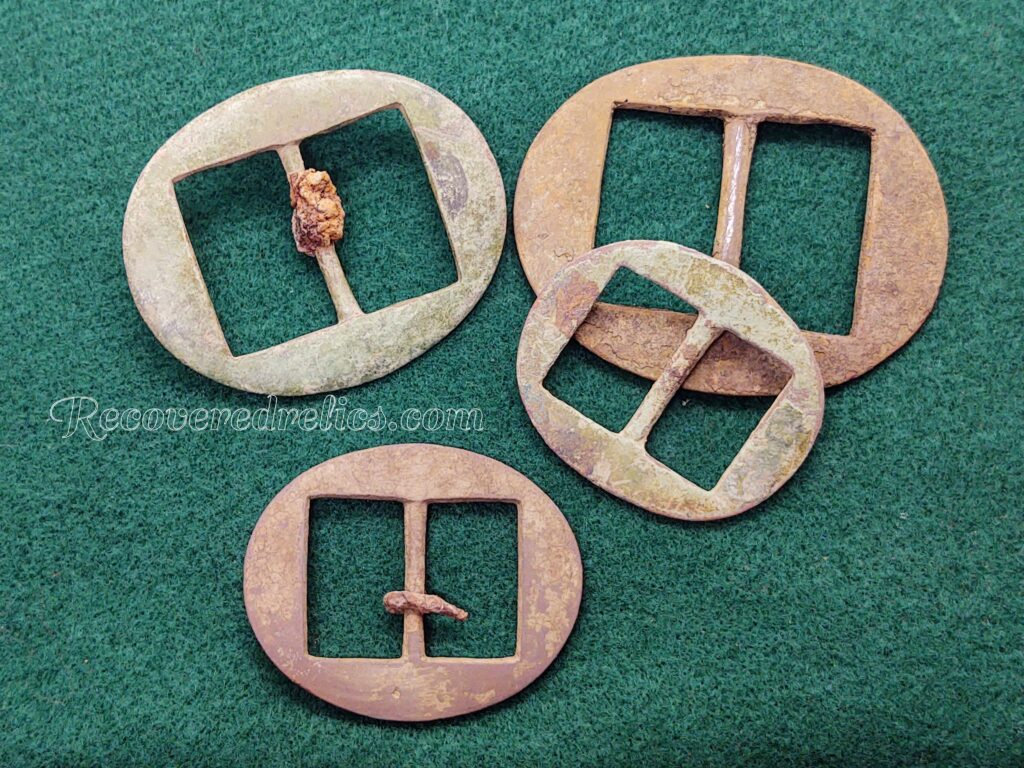
Oval Shaped Buckles (Horse Related) – Flat, oval shaped style buckles were commonly used on horse harnesses or other horse related equipment during the 1800’s. This style buckle has a centrally located bar. A pin would have been attached to the bar and was used to help secure the buckle in place.
Paris Solide Waistcoat Buckle– Historians believe these commonly recovered buckles date to the late 19th century and early 20th century. This type of buckle was used to provide tension adjustment on the rear straps of men’s waistcoats or vests in order to provide a smooth closed front behind the jacket opening. An intact example was found on the back of a suit waistcoat made by James Neal, of Cambridge, England which dated to 1906. The example pictured is of just the frame.


Pin Terminal Single Frame Buckles– The buckle’s pin is attached to one side of the frame. This style buckle is usually square or rectangular in shape. This style buckle is still used today.
Roller Buckles– This type of buckle has a cylinder shaped roller attached to one end of the buckle. The roller allows heavy duty straps and belts to slide through the buckle easily and also helps to protect the strap from wearing. Traditionally, roller buckles were more often used on horse tack and equipment straps than on waist belts. Today you can find roller buckles on belts, handbags, purses, and briefcases.
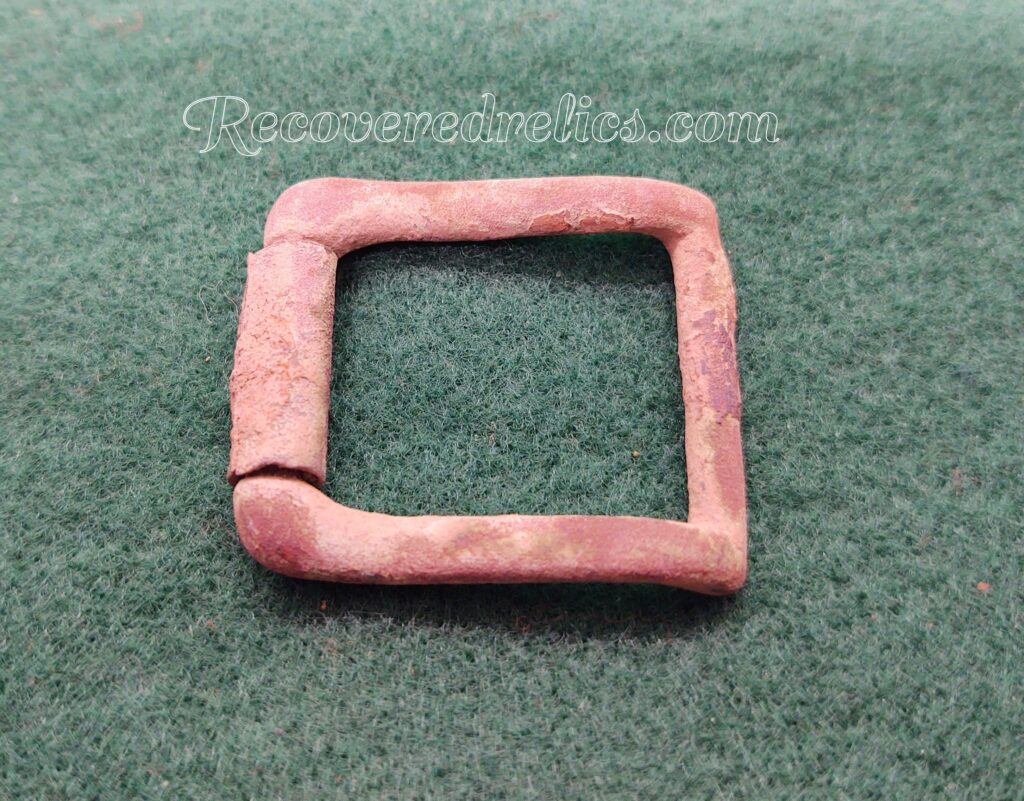

Sash Buckles or Pins– This type of buckle or pin was used to secure a sash at a lady’s hip. During the end of the 19th century it became popular for women to wear a sash over the shoulder and across their bosom or around the waist.
Shoe Buckles– Colonial shoe buckles first came into fashion around the middle of the 17th century. Their function was to fasten together ones shoe. The design of shoes worn by the colonists was such that ties or buckles were necessary in order to secure a shoe in place on ones foot. Shoe buckles helped to ensure that a person’s shoes remained firmly on their feet as they moved.
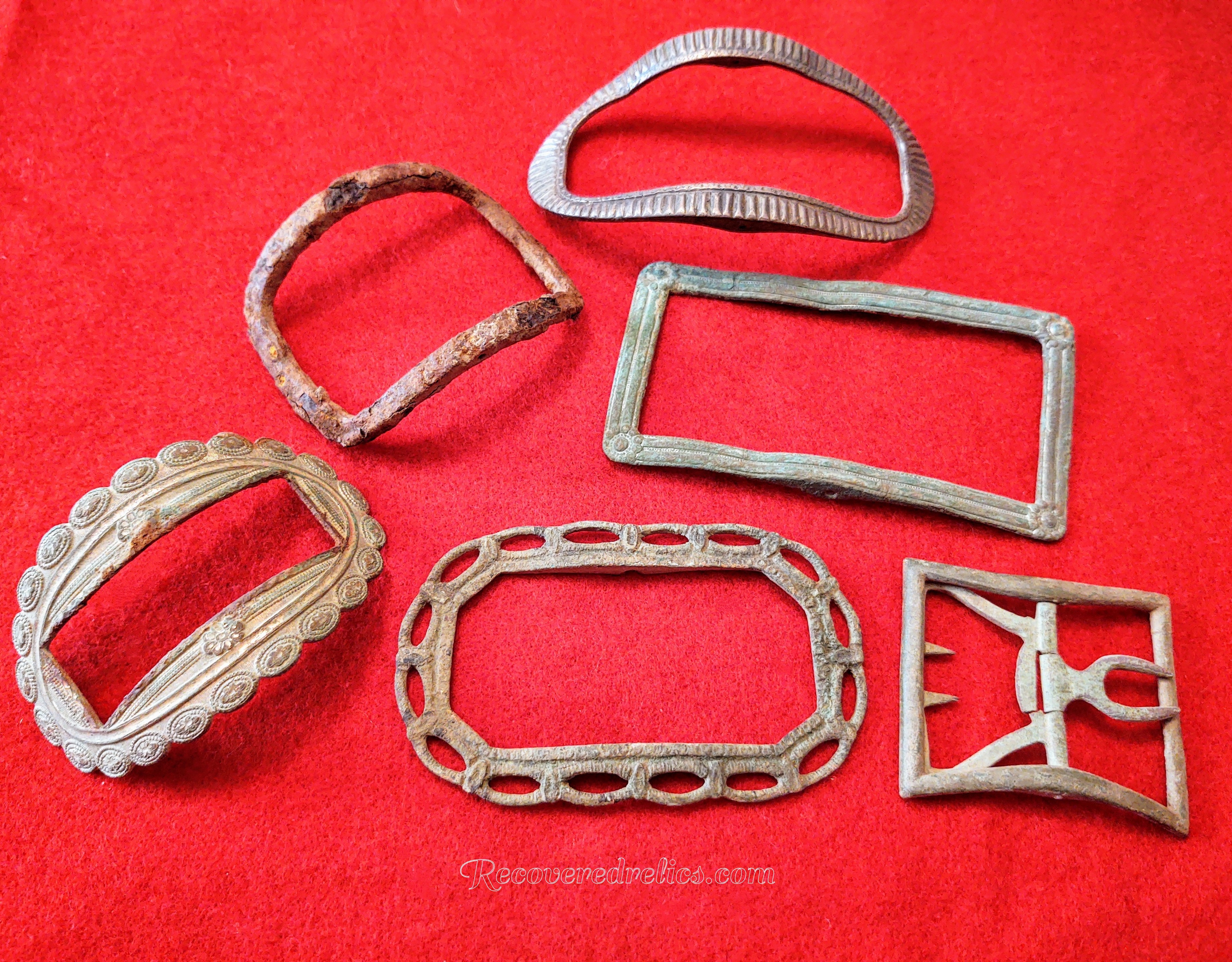
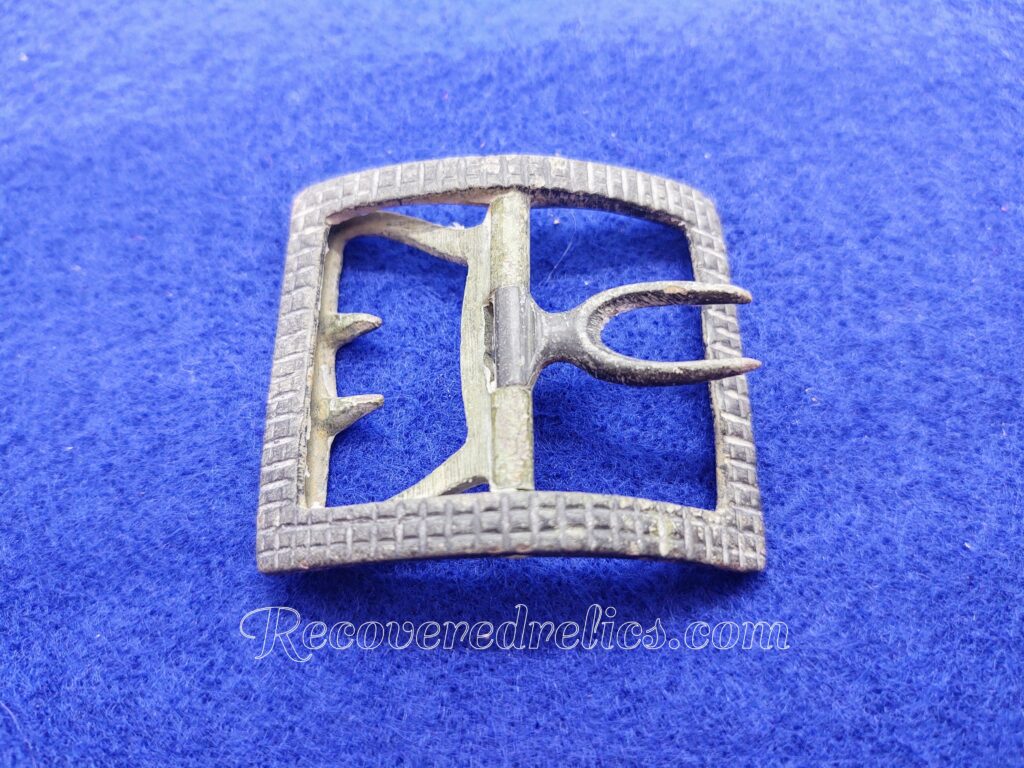
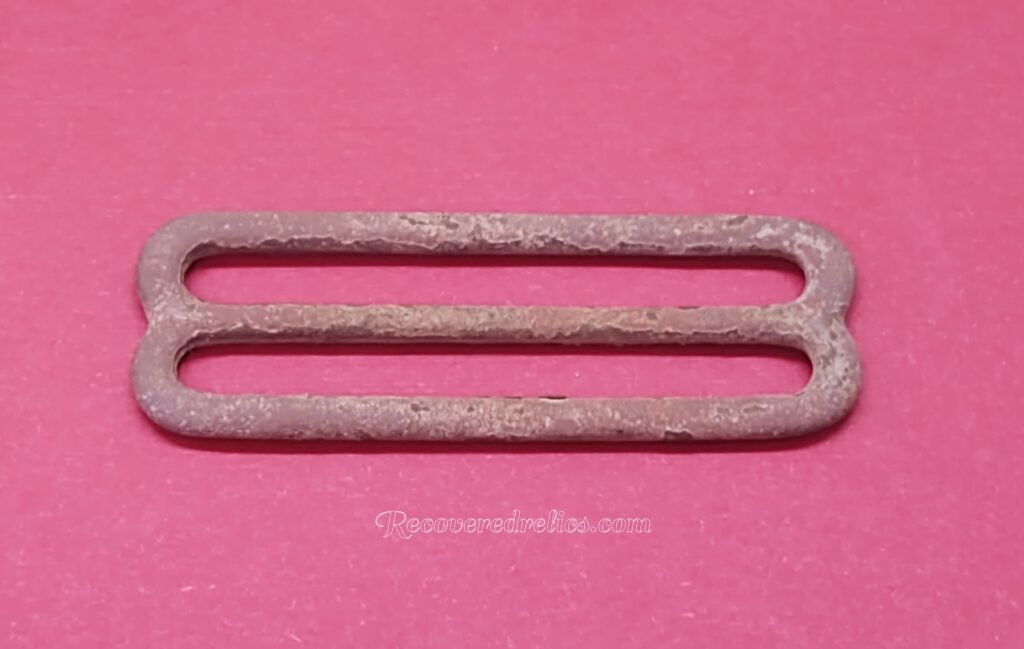
Slider or Sliding Buckles- Slider buckles allow the length of the straps to be adjusted by feeding the strap through the slots. Slider buckles can have a moveable or fixed center pin and come in a variety of different sizes. Small sized slider buckles were often used on undergarments. Larger sized sliders were often used on suspenders or overalls.
Spectacle Buckles– Spectacle buckles are a type of double looped buckles with oval loops. They are known as “spectacle” buckles due to their double loop, oval frame which resembles a pair of spectacles or eyeglasses. This buckle style first emerged in the middle of the 14th century. The height of their popularity was between the years 1450 to 1650. They were made from a range of materials, from plain copper alloy and iron to more expensive options like silver, pewter, or those decorated with paste jewels. These buckles served a functional purpose for securing straps but were also ornamental in design. Many examples feature decorative elements such as stylized floral designs, trefoils, and engraved patterns.
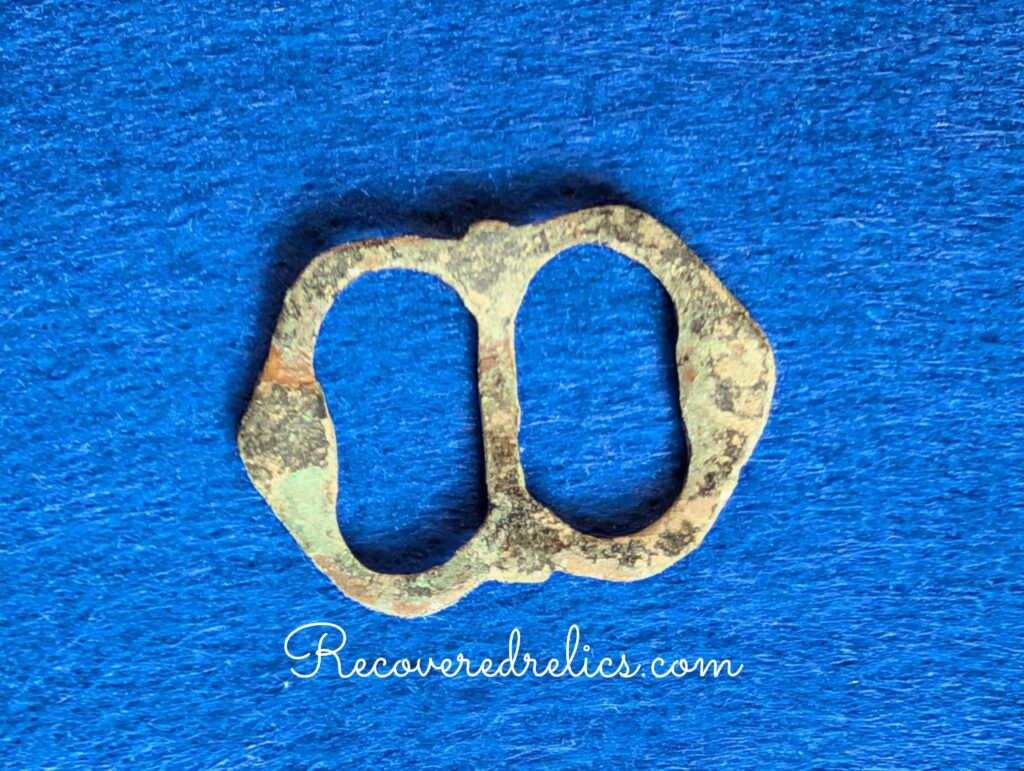
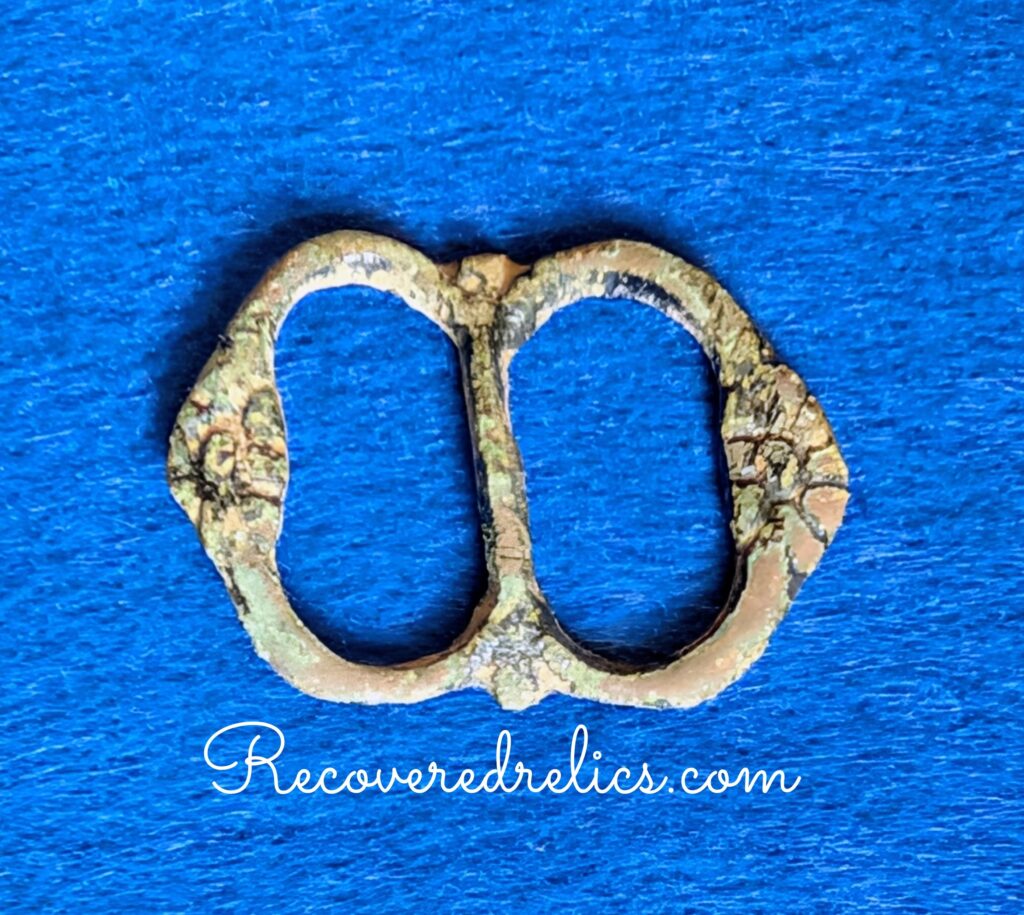
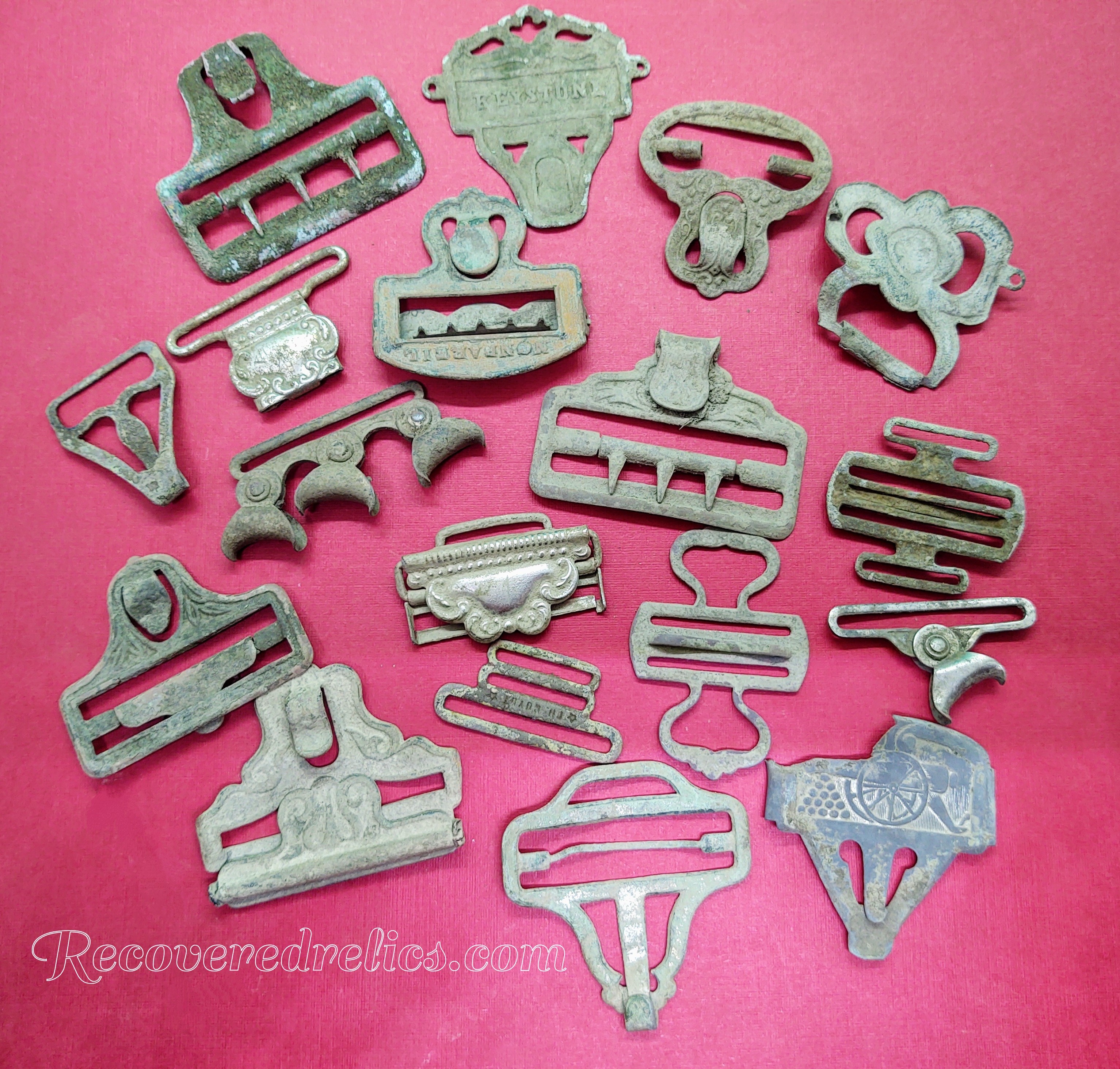
Suspender Buckles/ Clips– Suspenders or braces are narrow straps that are worn over the shoulders and attached to the front and back of pants to keep them from falling down. These body supporting garments were born out of practicality. High cut trousers were fashionable in the mid 19th century and early 20th century. This style pants made wearing a belt impractical. Buckles were used to secure the suspenders in place. There is a wide variety of different types of suspender attachments. The design of suspenders and their buckles underwent many changes over the 19th and 20th centuries. Modifications to improve the buckles designs were constantly being made. Suspender buckles are a commonly found item by detectorist due to their great popularity over a vast period of time.
Buckle Fragments– We often find broken bits and pieces of buckles. Between the 17th and 18th centuries buckles had diverse roles and were used on shoes, breeches, harnesses, stocks, girdles, garters, hats, boots, swords, and spurs. Something as mundane as buckle fragment is still a piece of history and can often tell us something about the particular area where it was found.
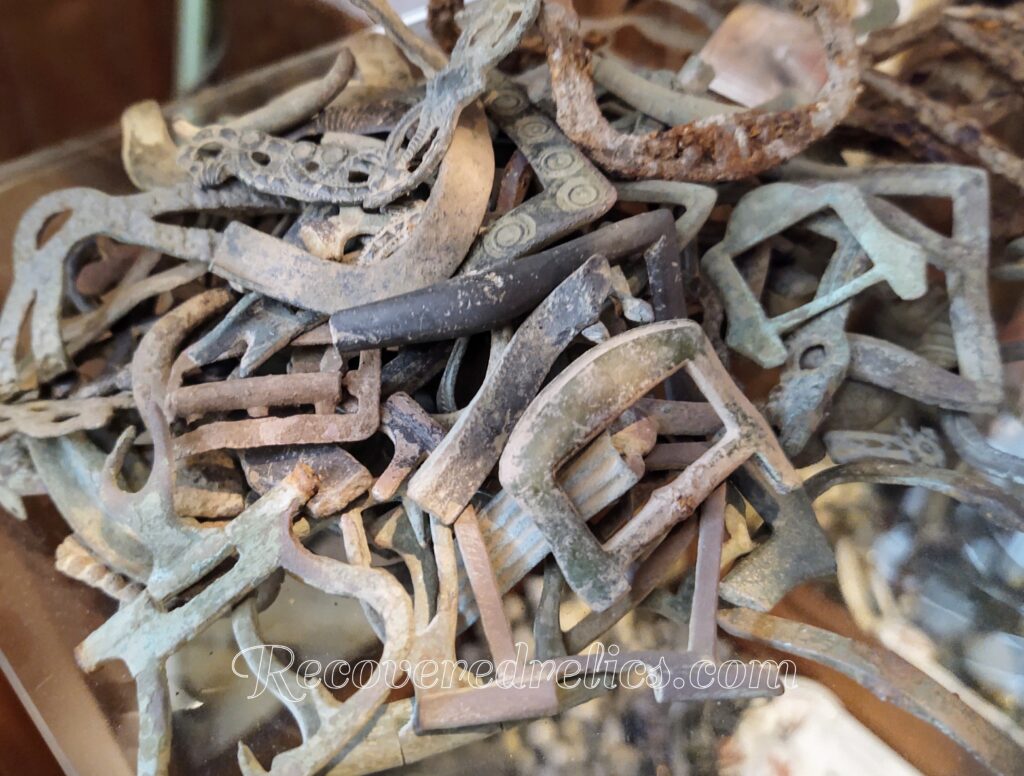
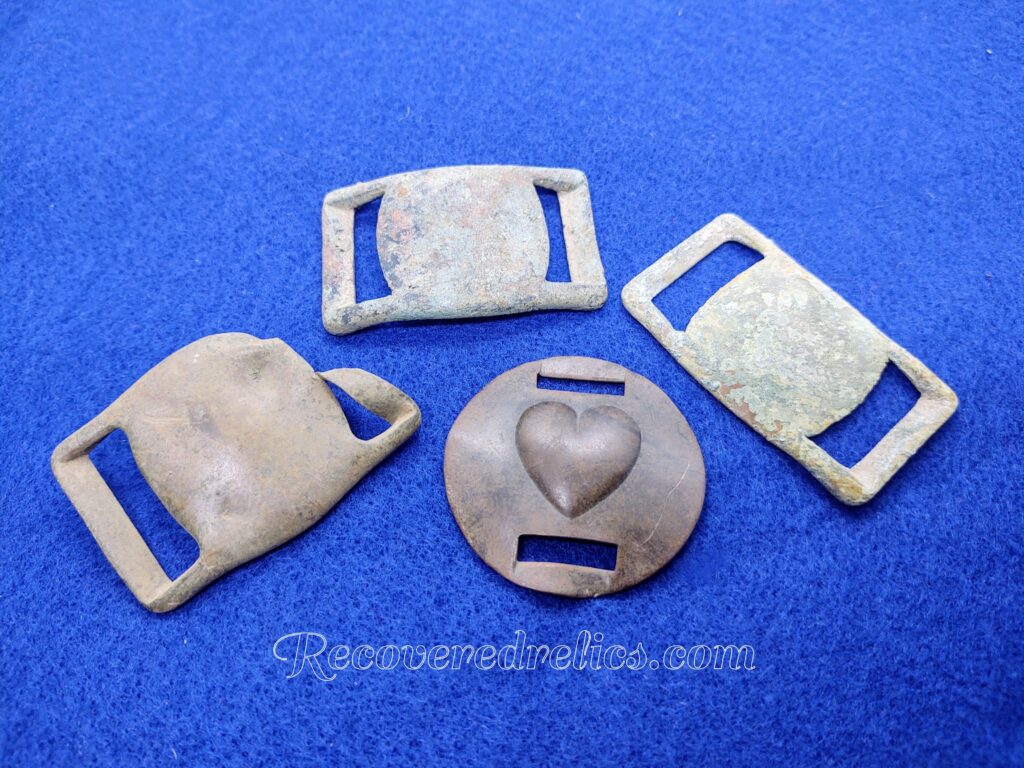
Buckle Cover or Shield– Buckle shields were used to cover the buckles that attach the breeching to the hip strap of a horse harness. The shields were used in order to prevent the hair of the tail of the horse from being caught on the tongue of the buckle and pulling it out of place. They were quite useful.
Bells
Crotal or Rumbler Bell– Spherical, hollow, enclosed bells with one or more slits. They have a loose pellet or rumbler inside them which produces the sound when the bell is moved or shaken. By the traditional definition crotal bells technically aren’t bells at all but rather rattles. Crotal bells vary in age. The earliest crotal bells found in England date to the beginning of the 13th century. Here in the United States the great majority of crotal bells we find date to the late 18th to mid 19th century. Crotal bells may be either plain or decorated. Decorations may be applied to both the upper and lower hemispheres, or to just the lower hemisphere. Bells that are decorated only on their lower hemisphere tend to date from the late 18th century to the mid 19th century. Those with no decoration also usually date to this period too. There are of course exceptions. Maker’s marks can help you to better determine the age of your crotal bell.
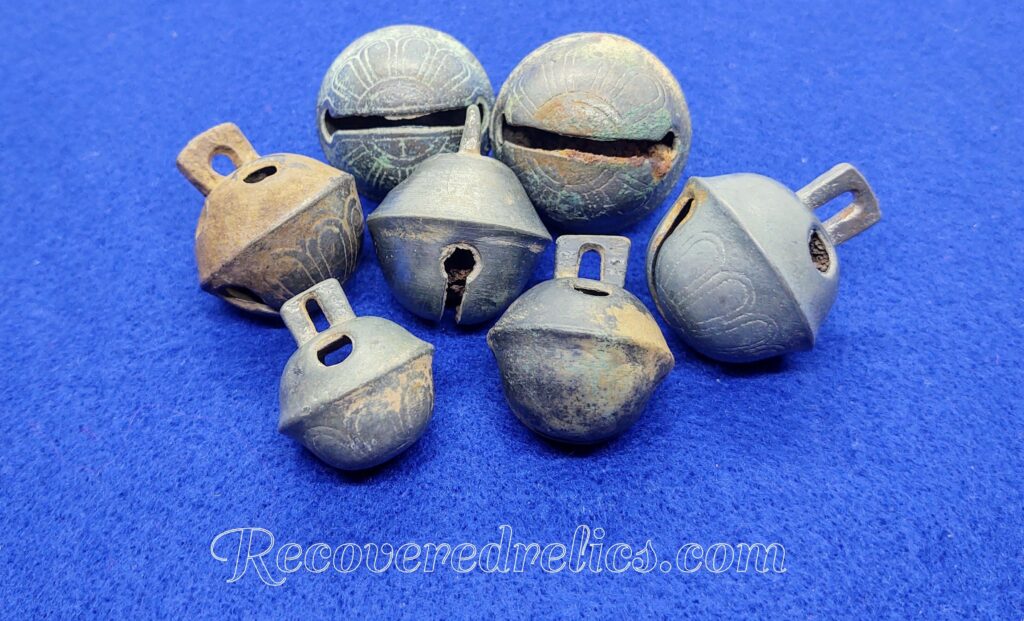
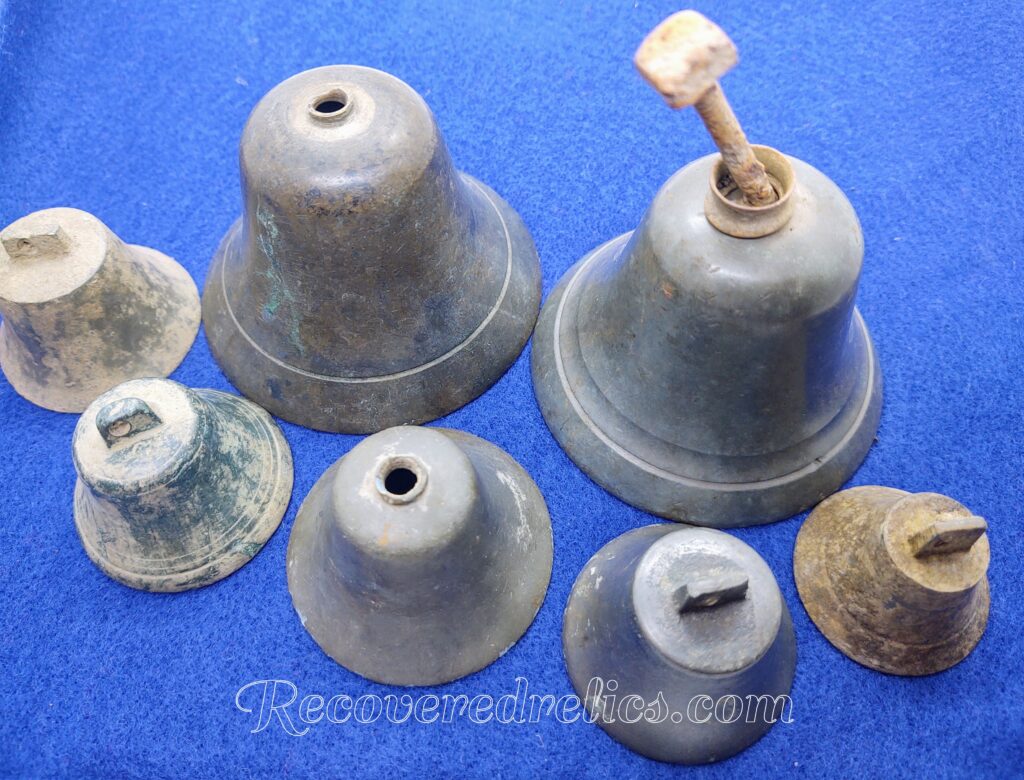
Open Mouth Bells– An open bell is sounded when one or more clappers hanging inside or outside the bell strike the surface of the bell. Open mouth bells that are used on horses typically have a circular cross section and look like the classic “liberty” bell. Bells that are square or rectangular in cross section can certainly be used on horses, but are more often worn by cattle, sheep or goats.
Hand Bells- Open mouth bells with circular cross sections that have handles or a hole located at the top where a handle would have been. This type of bell is designed to be rung by hand. Hand bells were popular during the mid 19th century and early 20th century.
Conestoga Style- Loose open-mouth bells are often mistakenly referred to as Conestoga bells. The key part of what makes a Conestoga bell a Conestoga bell is that the bell itself is attached to a metal bracket that arches above the collar of the horse. Open mouth bells with circular cross sections and bases between the size of one and a half to three inches in diameter were often selected to be Conestoga bells. This style bell was also used on neck and body straps, saddles, and on the shafts and poles of wagons. Conestoga bells were used from the late 18th century to the early 19th century.
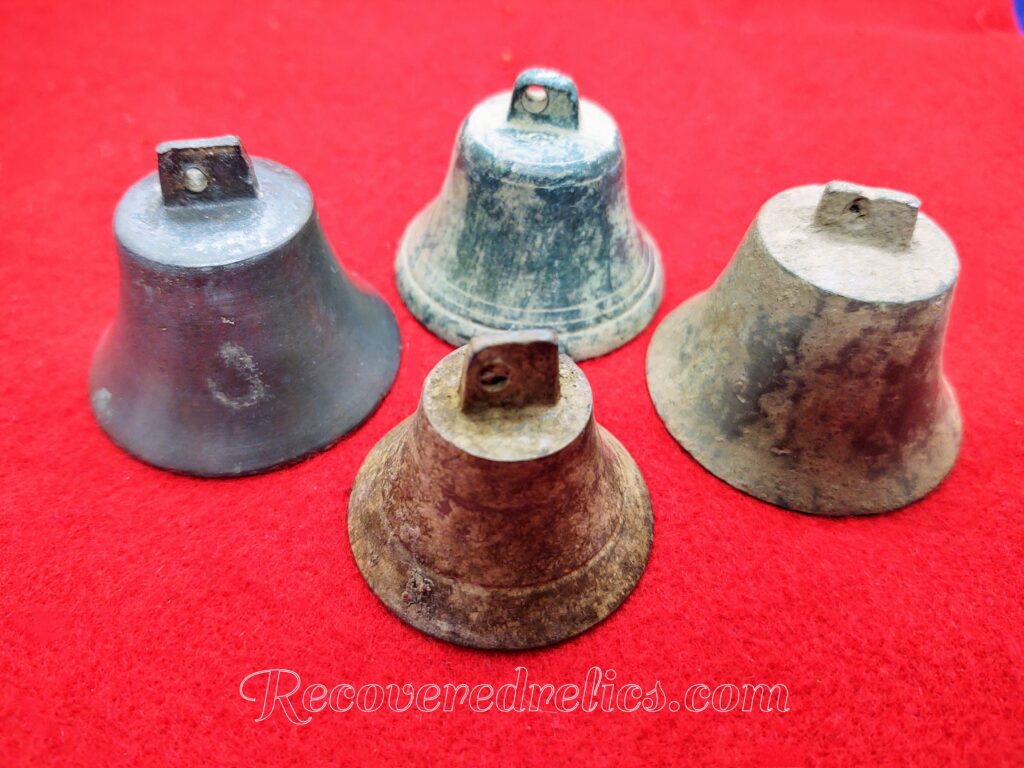
Sleigh Bells– Around the middle of the 1850’s manufactures designed sleigh bells that could be attached using rivets or screws. These look similar to your traditional crotal style bell. They are hollow, spherical shaped enclosed bells with pellets inside them. The major difference is the attachment piece at the top of the bell.
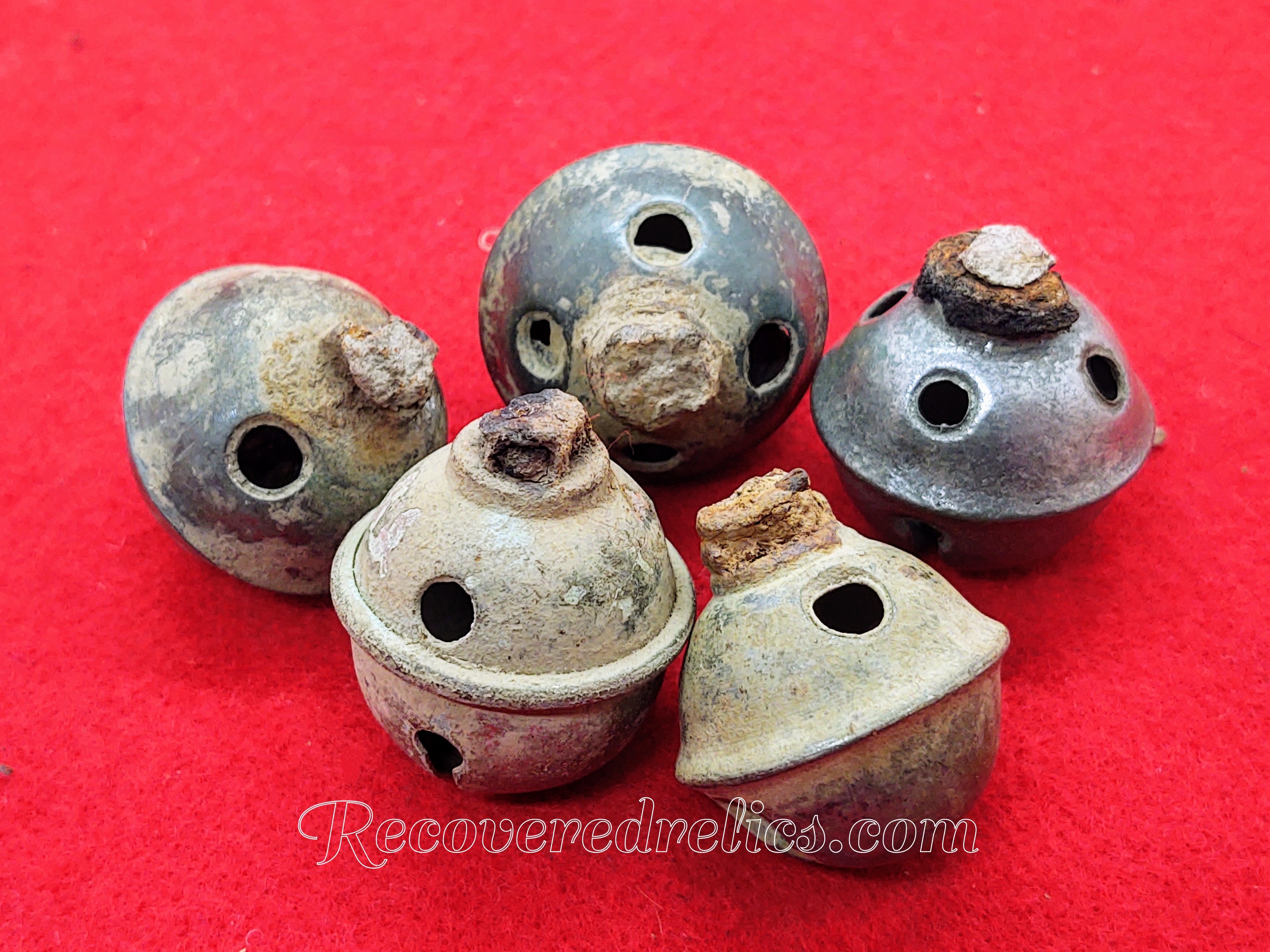
Coins
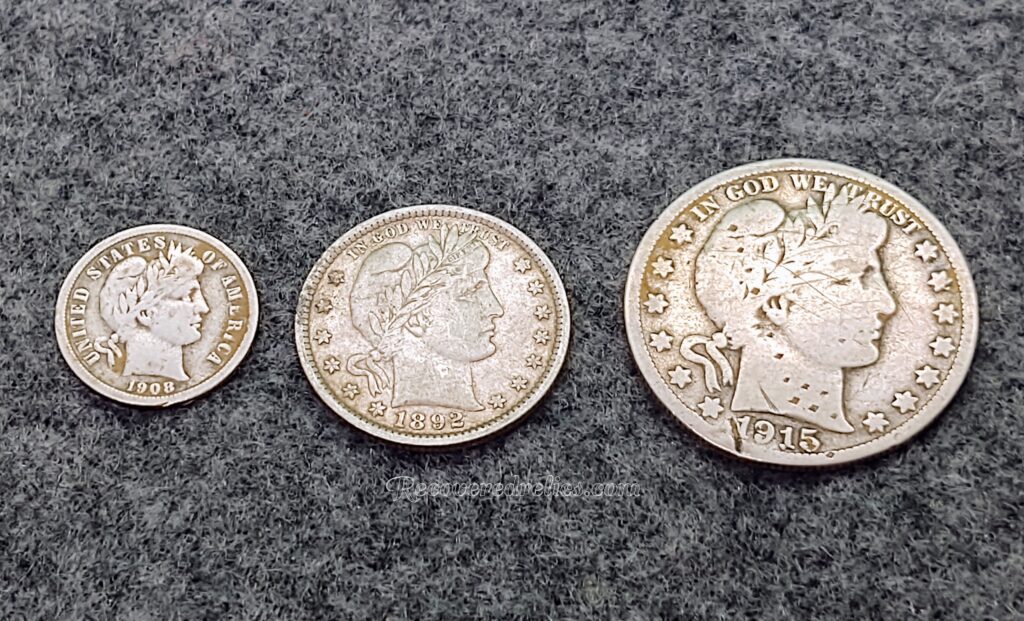
Barber (US Mint) Coin Series– The Barber coinage series, designed by Charles E. Barber, consists of a dime, quarter, and half dollar. These coins were minted between the years 1892 through 1916. No half dollars were struck in the final year of the series though.
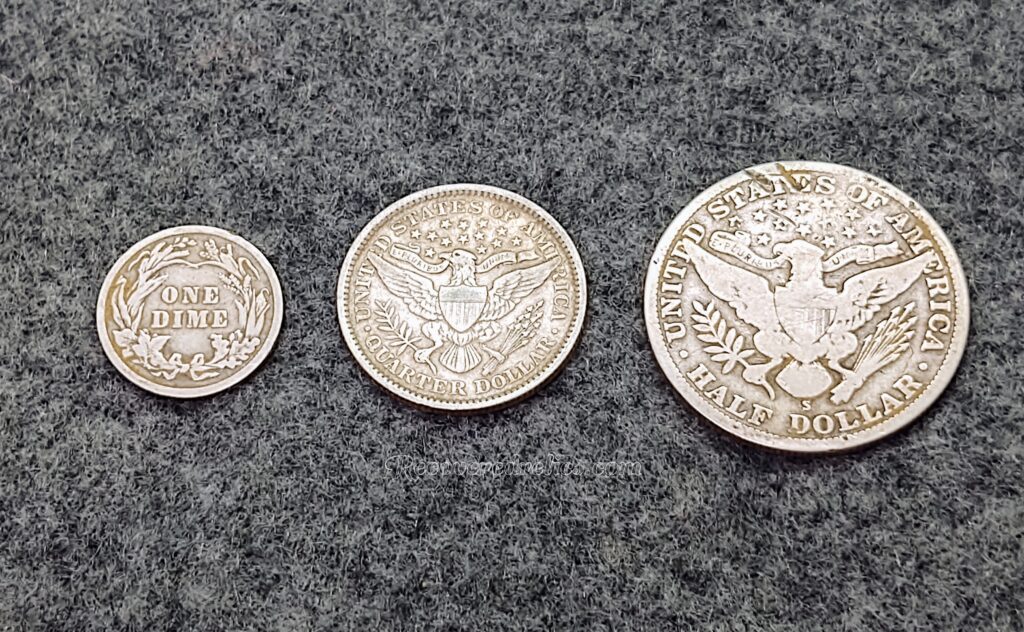
Buffalo Nickel (US Mint)– The Buffalo nickel is a five cent piece that was struck by the United States Mint from 1913 to 1938. It was designed by James Earle Fraser. The obverse features a portrait of a Native American Indian and the reverse has an image of a buffalo or bison.
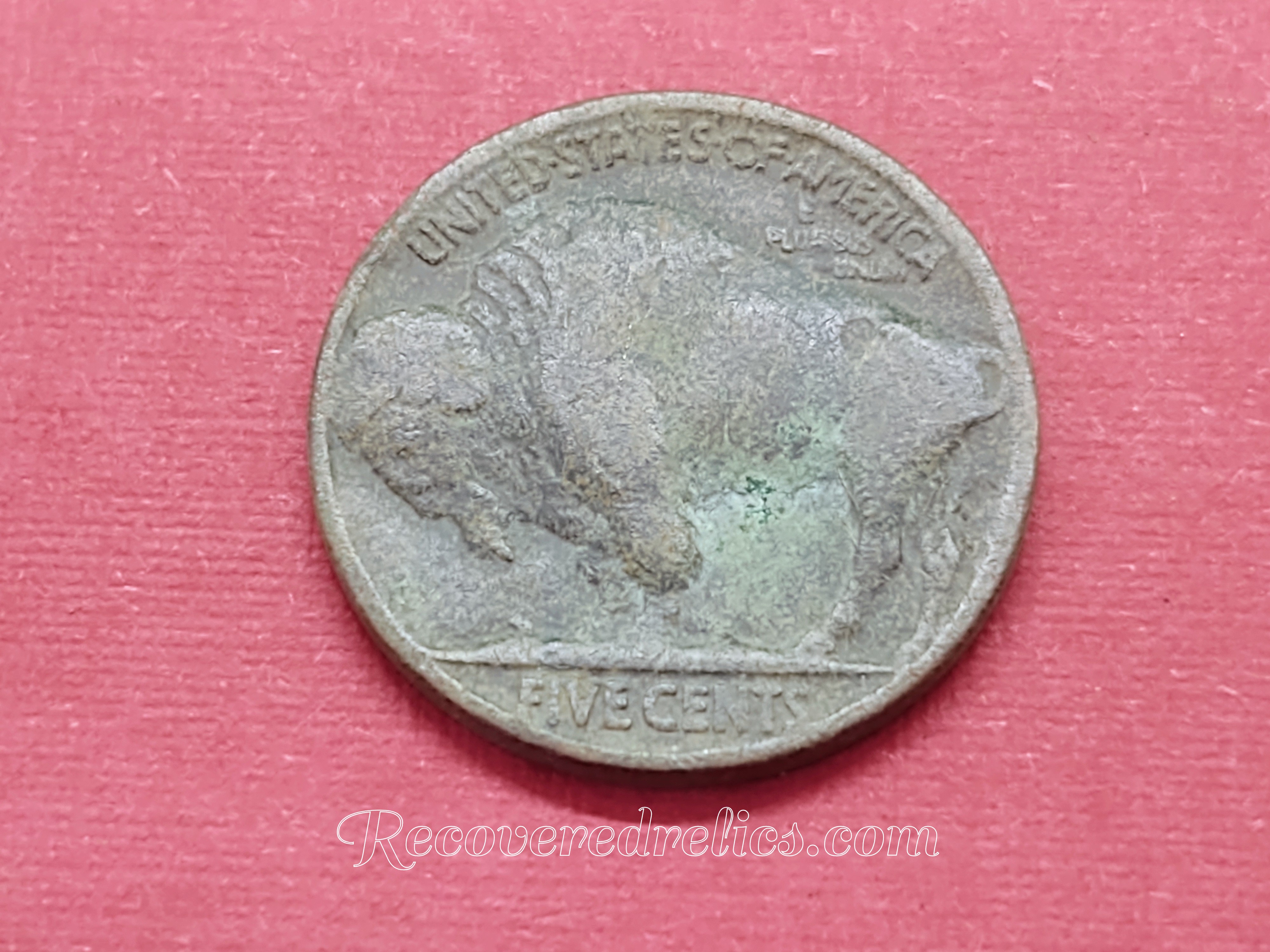

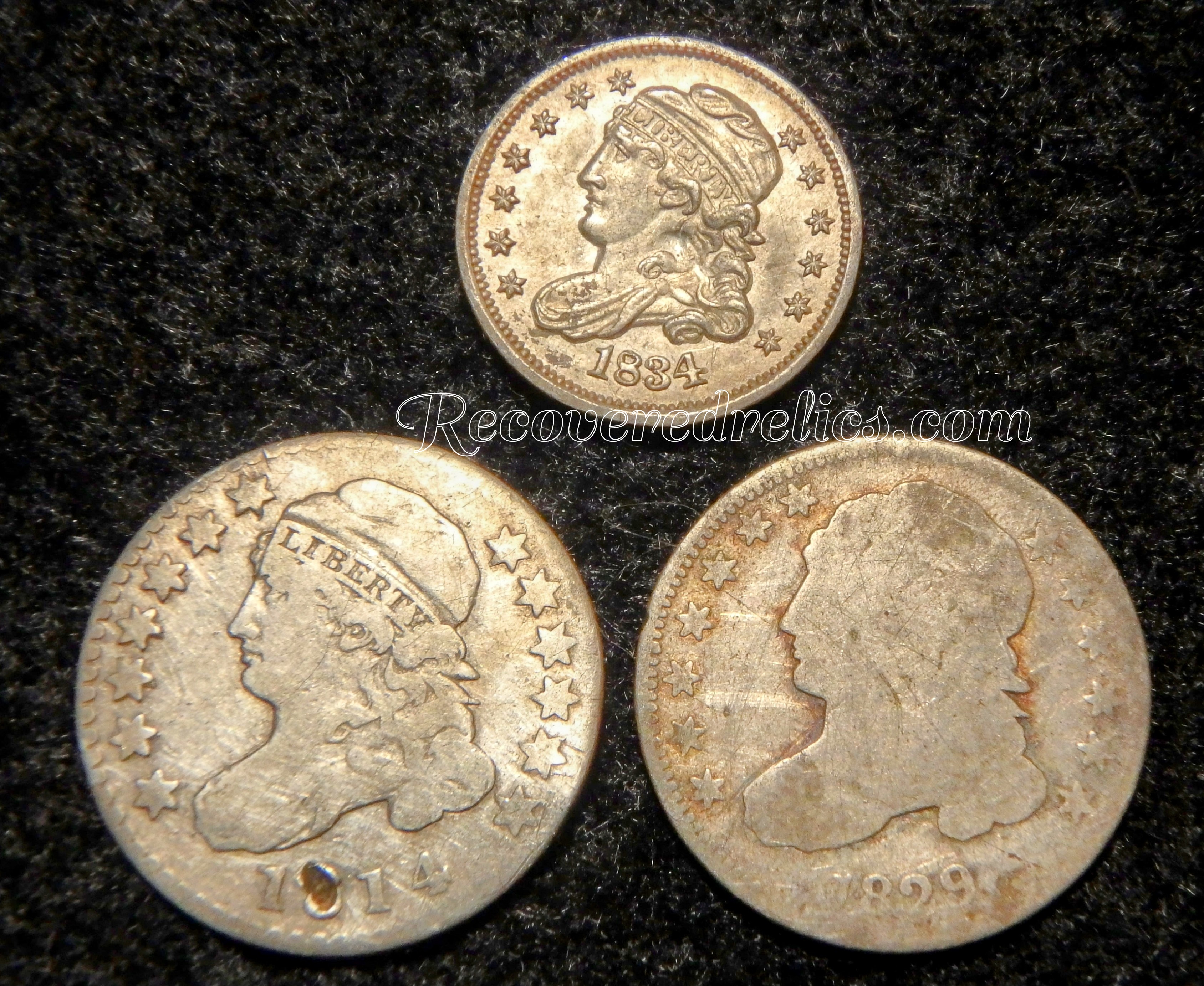
Capped Bust Silver Coinage (US Mint)- The capped bust series consists of a half dime, dime, quarter, and half dollar. The half dollar was minted by the US from 1807 to 1839. The quarter was minted from 1815 to 1838. The dime was minted from 1809 to 1837 and the half dime was minted from 1829 to 1837.
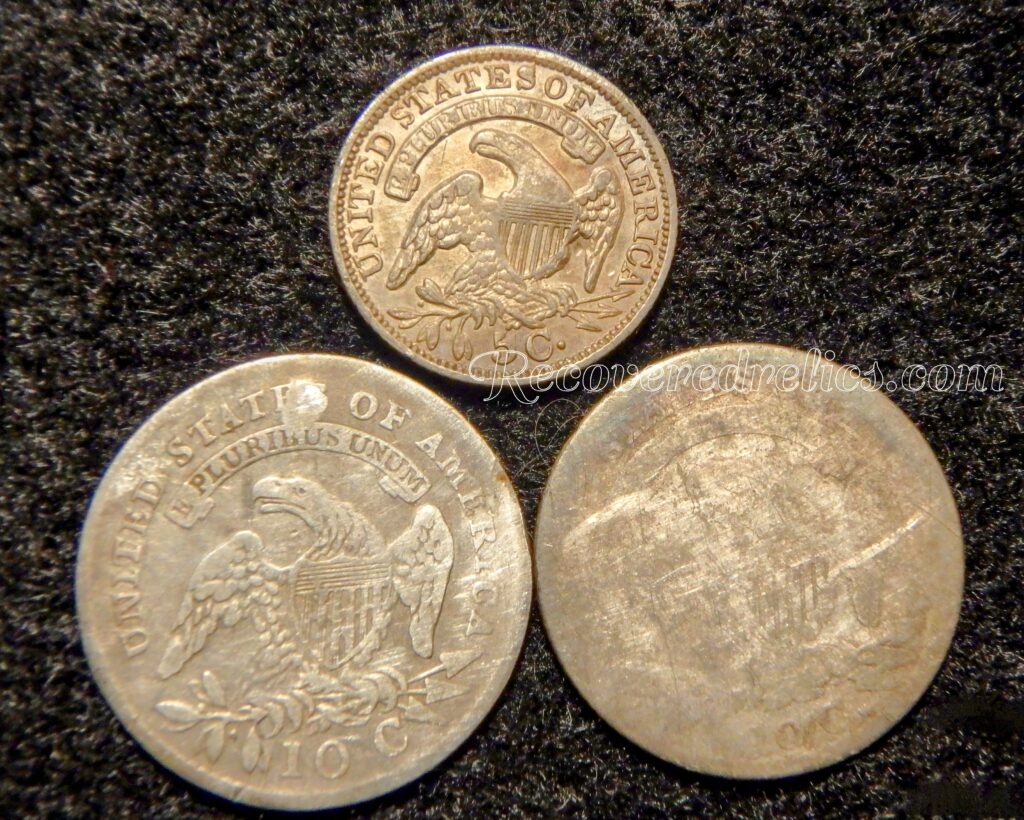
Colonial State Coppers– Connecticut, New Jersey, Massachusetts, and Vermont issued government approved copper coinage between the years 1785 and 1788. New York also issued copper coinage during this time period however the coins were not authorized by the government.
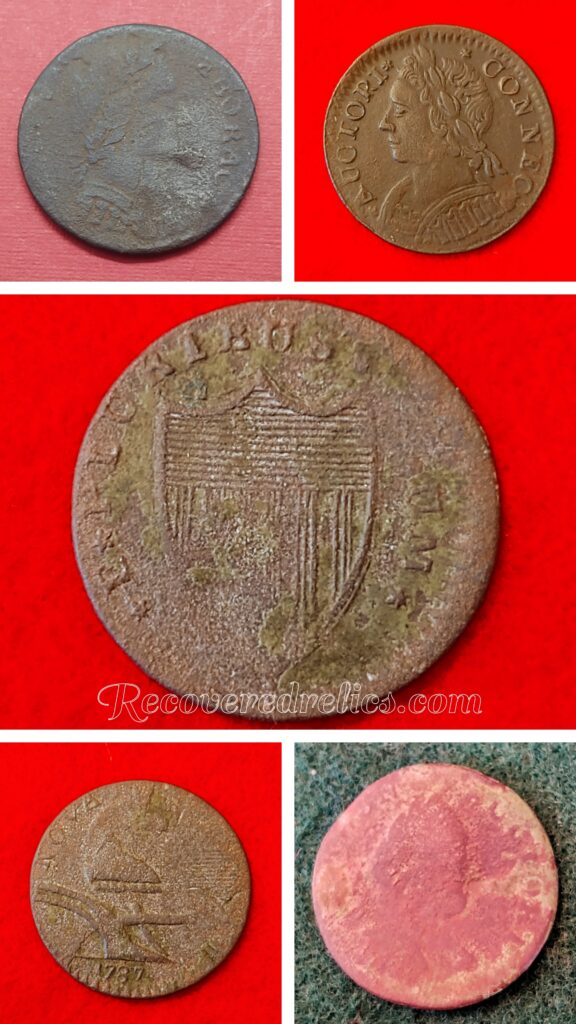
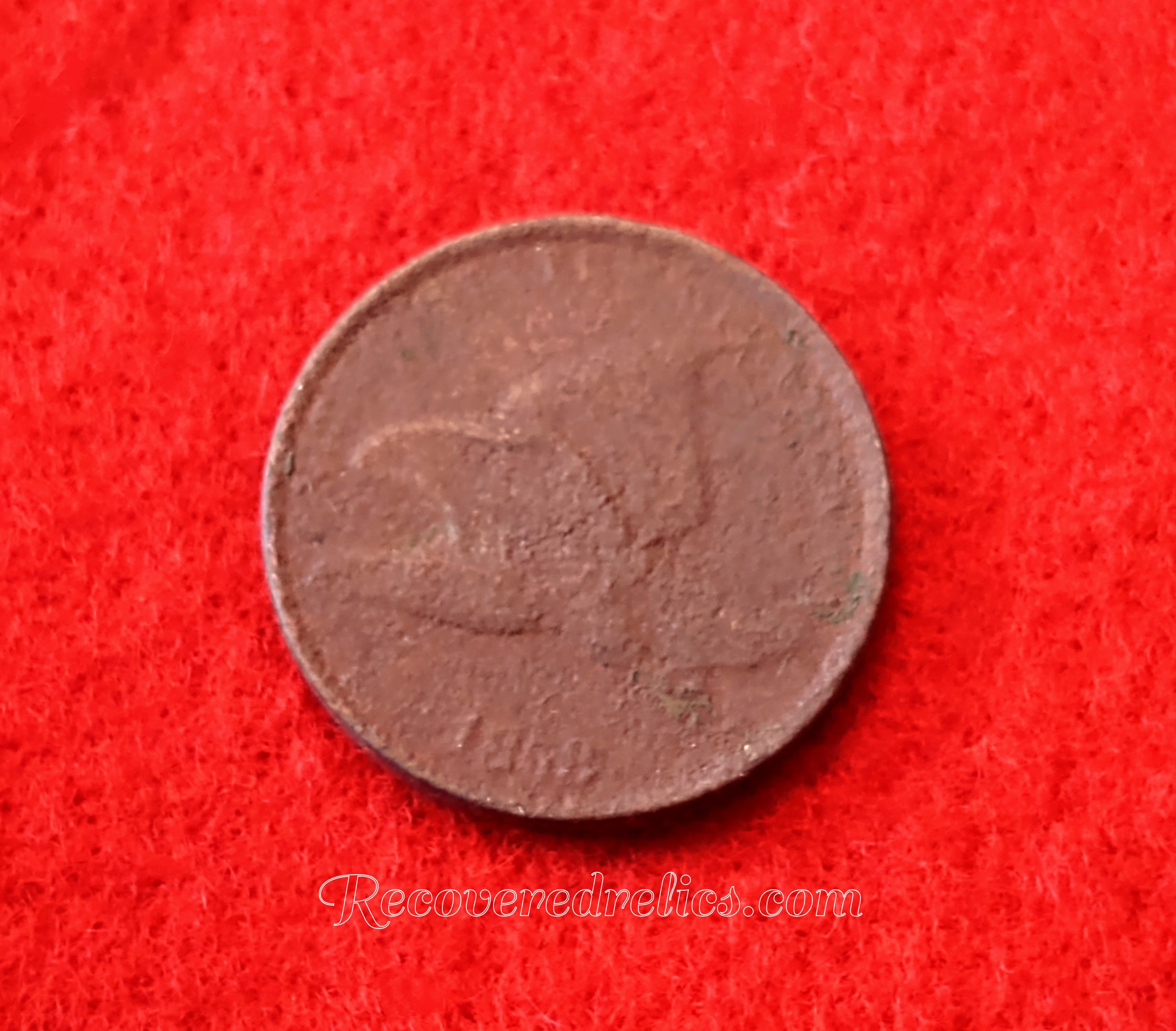
Flying Eagle Cent (US Mint)– The Flying Eagle cent is a one cent piece struck by the US Mint as a pattern coin in 1856 and for circulation in 1857 and 1858. The coin was designed by James B. Longacre. It was the first small-sized cent coin produced by the United States Mint.
Franklin Half Dollar– This coin was struck by the US Mint from 1948 – 1963. The coin pictures one of our founding fathers Benjamin Franklin on it’s obverse and the Liberty Bell on it’s reverse. The example pictured is a non-dug coin.


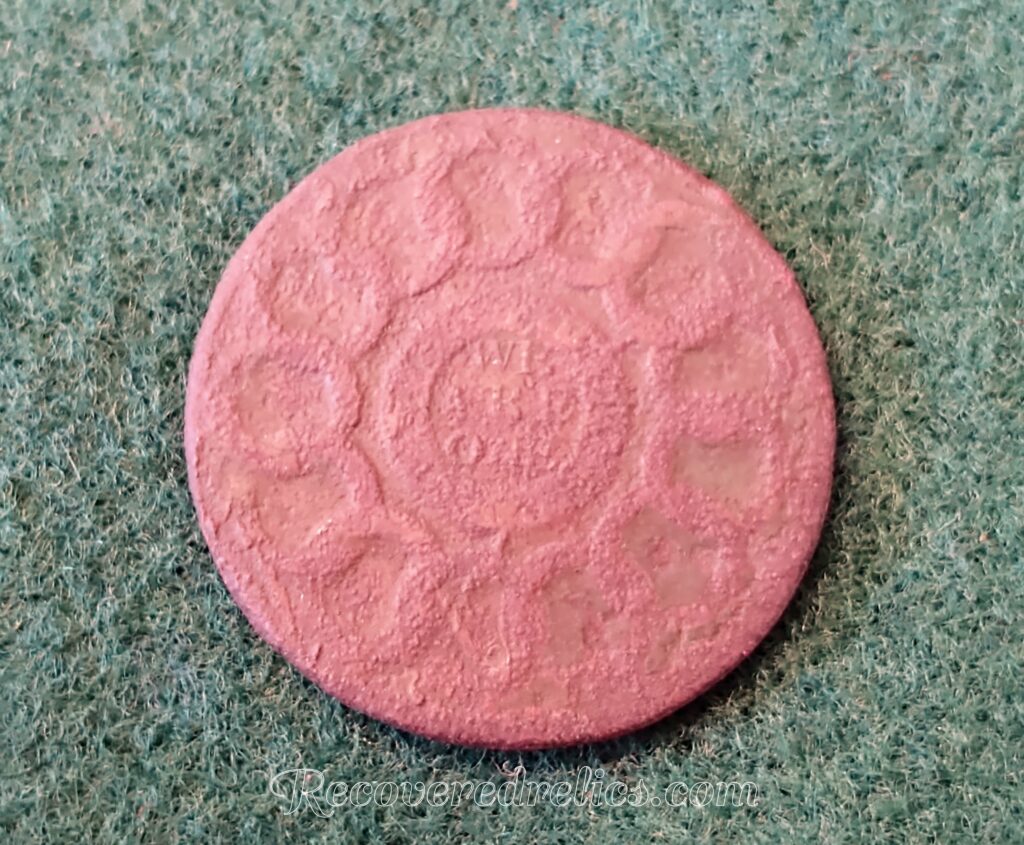
Fugio Cent of 1787– The Fugio cent of 1787 was the first coin issued by the authority of the United States and authorized by the US Congress. At the time a national mint run by the government did not exist within America. The coin was contracted out to a private mint for production. The sun and sundial on the coin is to symbolize time, and together with the Latin word fugio (“I fly”), they express the idea “time flies.” Below the sundial is the phrase “Mind Your Business.” Both mottos have been attributed to Benjamin Franklin. On the other side of the coin, their are 13 links forged into an unbroken chain with the motto “We Are One” which is to represent the uniting of the 13 colonies into one strong nation.
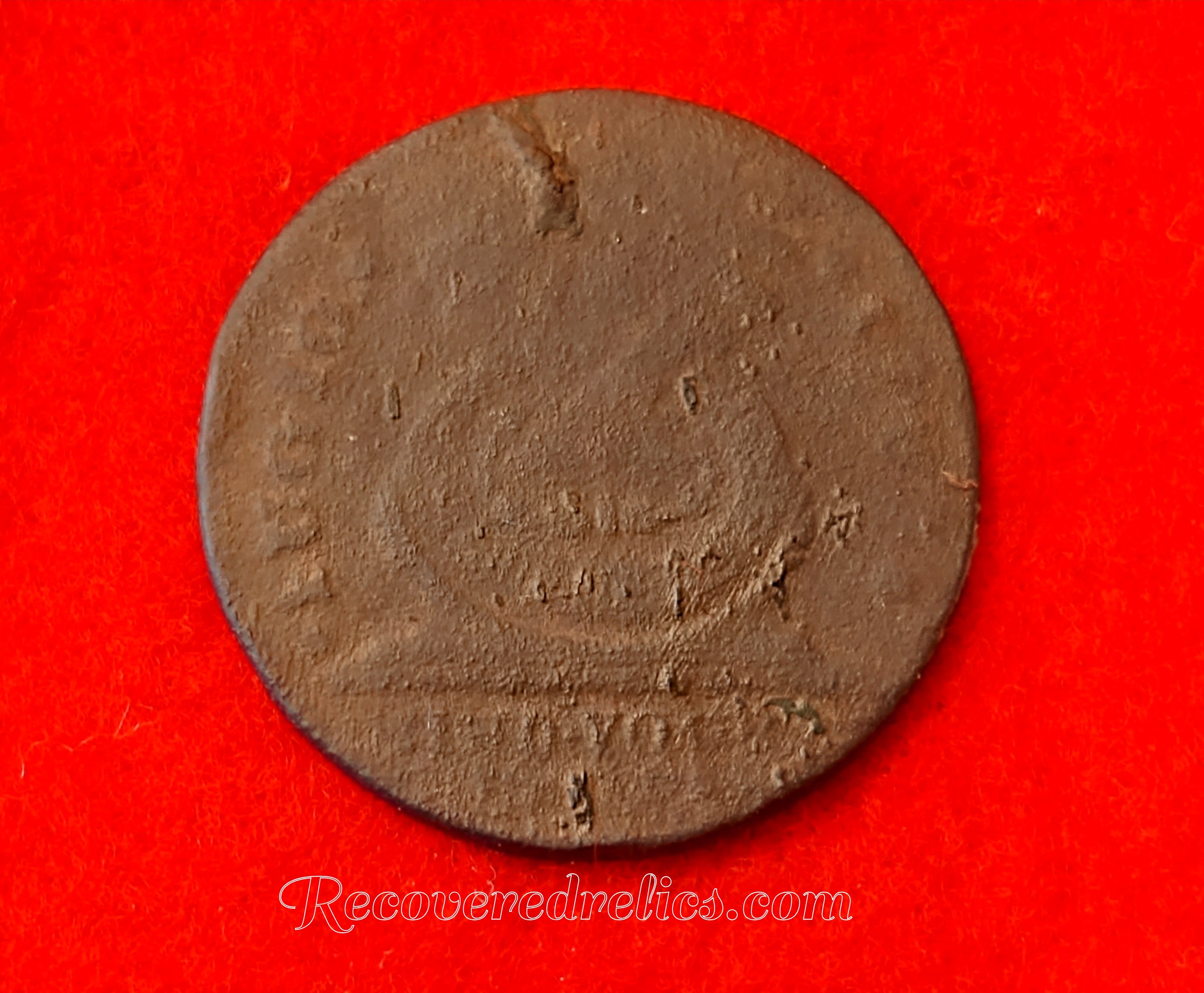
Half Cents (US Mint)– The half cent was the smallest denomination of United States coin ever minted. It was first minted in the year 1793 and last minted in 1857. It was minted with five different designs; Liberty Cap Facing Left (1793), Liberty Cap Facing Right (1794 -1797), Draped Bust (1800-1808), Classic Head (1809-1836), and Braided Hair (1840 -1857).

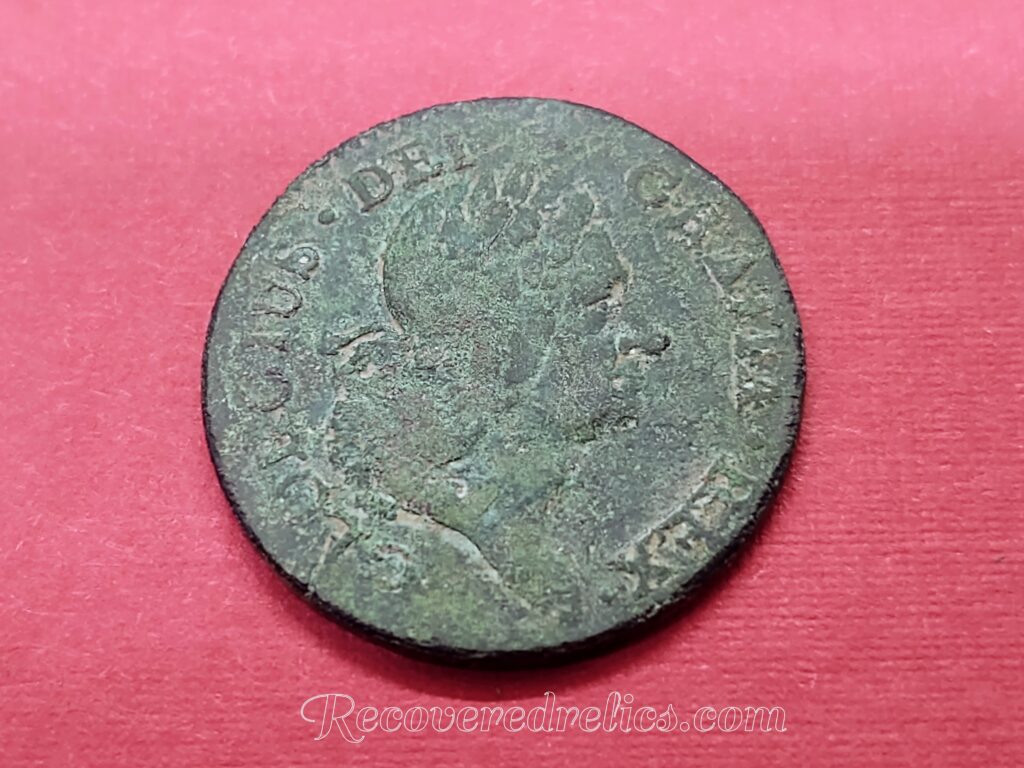
Hibernia Copper– William Wood was a copper and tin mine owner in Ireland. He purchased the Royal Patent in 1722 which allowed him to produce copper halfpence and farthings for use in Ireland. This coinage has two major types. The first type struck in 1722 has a reverse design with a harp left of Hibernia. The second type struck from 1722 until 1724 has a harp to the right of Hibernia. The obverses of both types have portrait of King George I, facing right. There are a number of varieties of these coins. These Hibernia coins were heavier and thus intrinsically more valuable than the coppers then circulating in Ireland. These pieces display no denomination, but come in two sizes: the farthing, which averages 22 mm in diameter; and the halfpence of 26 mm. There is no evidence of any substantial colonial circulation of these coppers in America however many have been recovered by detectorists.
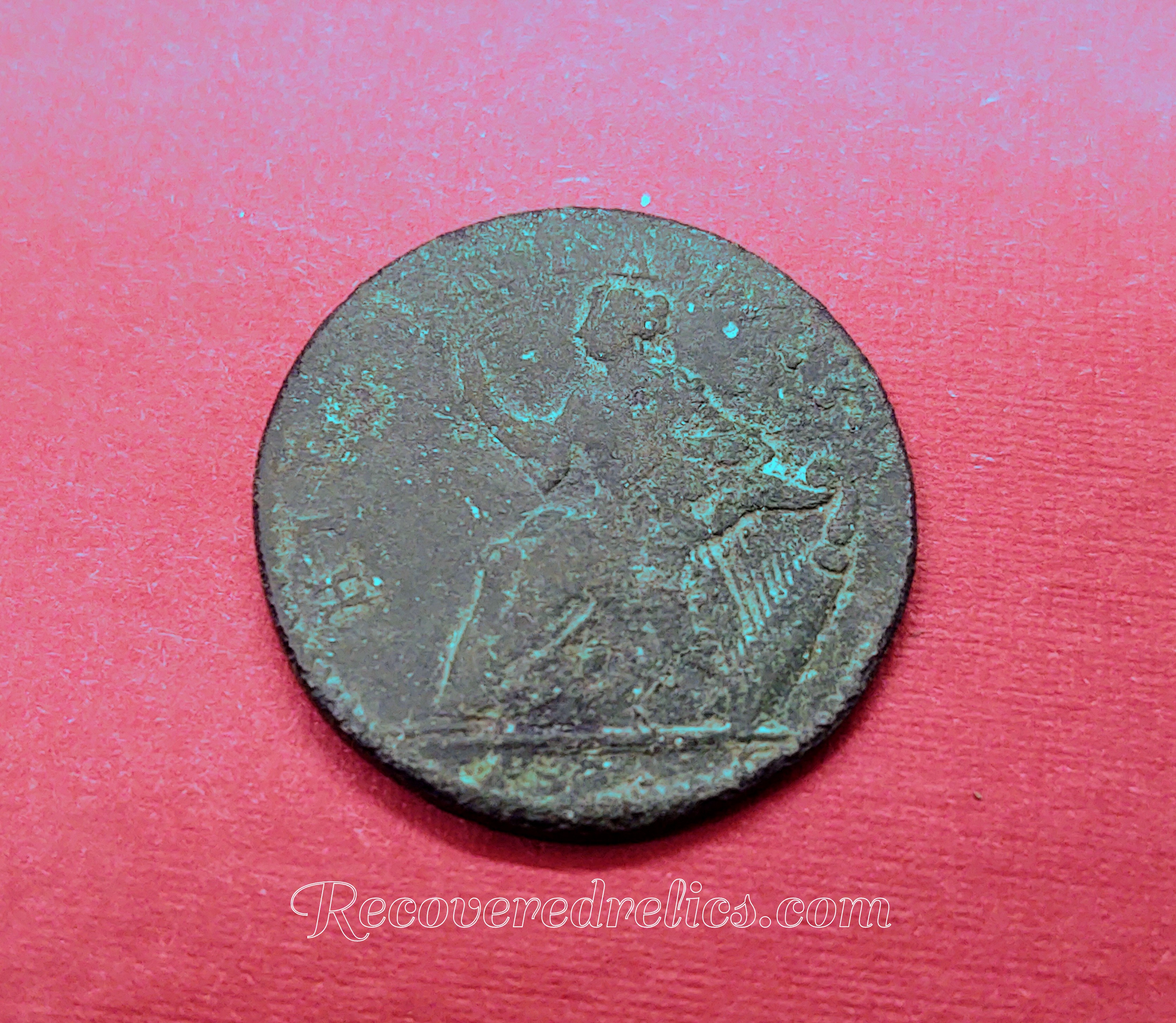
Indian Head Cents (US Mint)– The Indian Head cent is a one-cent coin that was produced by the United States Mint from 1859 to 1909. It was designed by James Barton Longacre. The obverse features Liberty wearing a feathered headdress, while the reverse depicts a wreath encircling the words “one cent.” The composition of these coins evolved from 88% copper and 12% nickel (1859-1864) to 95% copper and 5% tin and zinc (1864-1909).
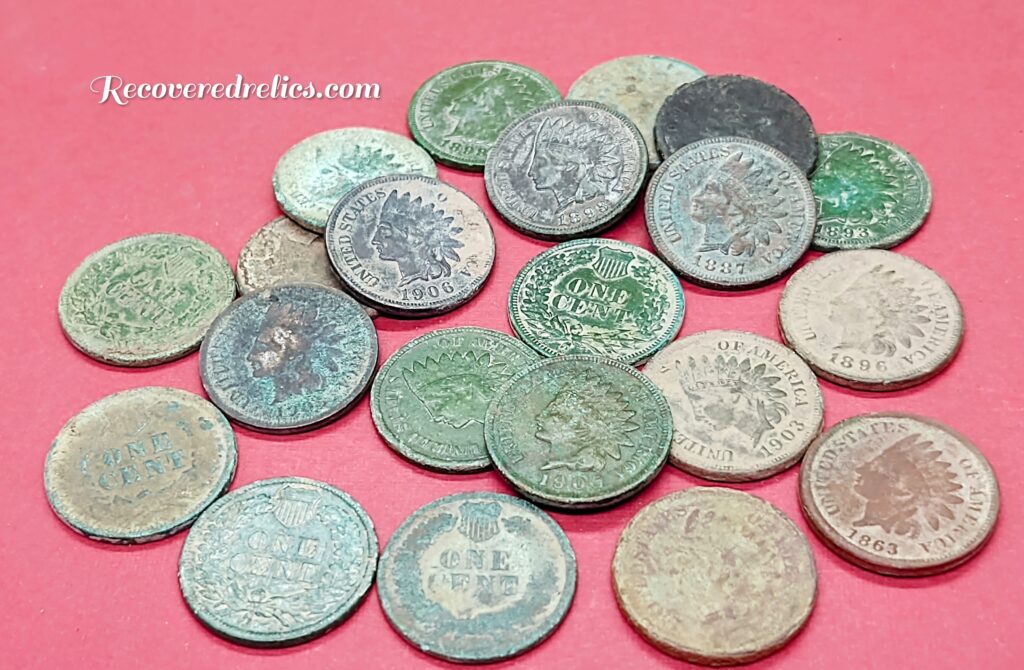
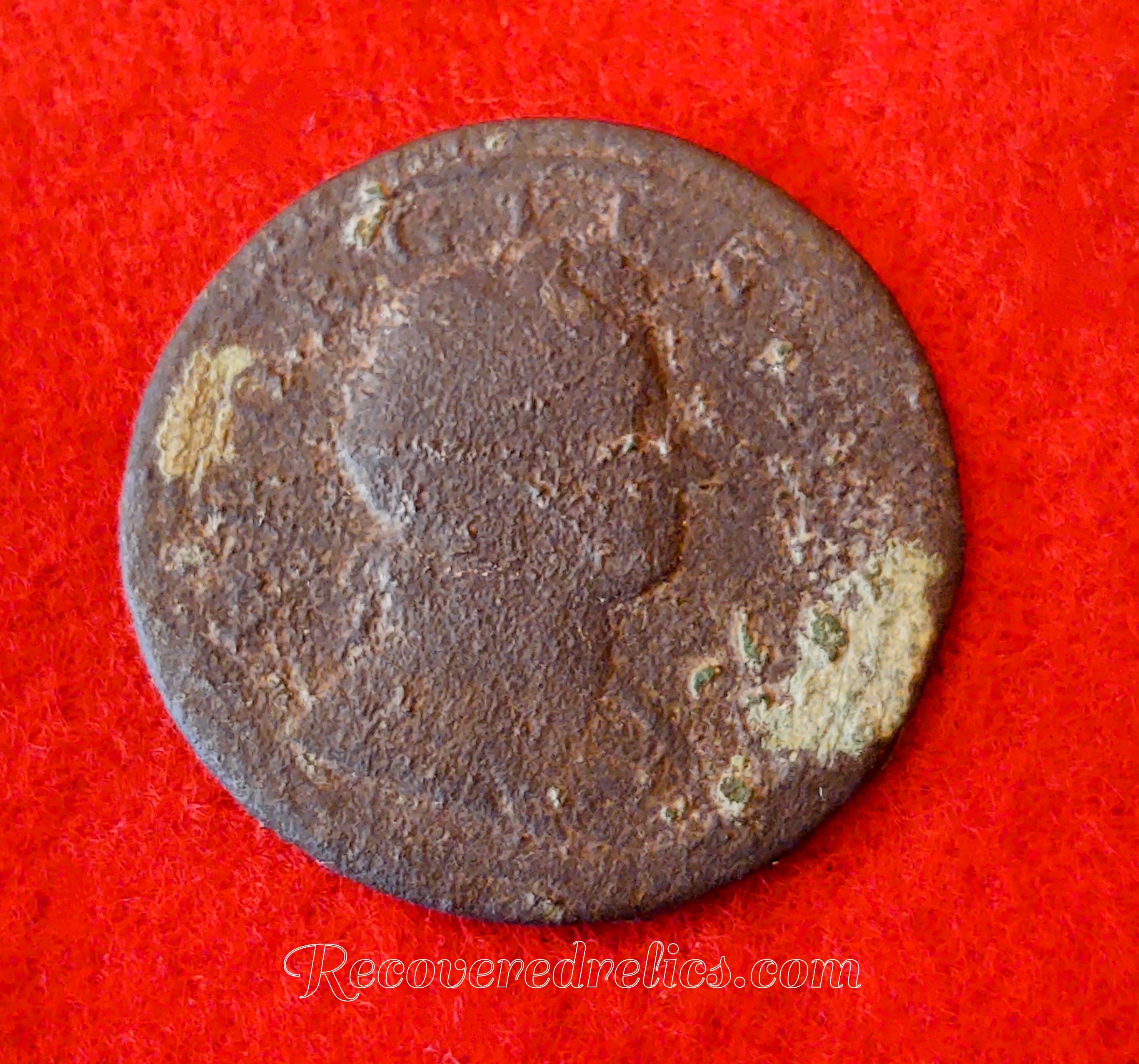
KG1 /King George I Copper– Soon after King George I (1714–1727) took rein, the surplus of copper coins was used up. In the year 1717 a new contract was signed and a Royal Warrant was issued for the production of a new halfpenny. The halfpennies struck in 1717 and 1718 looked slightly odd as they were smaller, thicker and somewhat lighter than the previous issues, weighing 9.4–10.3 grams with a diameter of 25–27 millimeters. The size of the coin was increased to 26–29 millimeters for those issued from 1719- 1724. The weight however remained the same (.9.4–10.3 grams ). The obverse features the right-facing head of King George I and the inscription “GEORGIVS REX”. The reverse features Britannia with the inscription “BRITANNIA” and has the date of issue beneath Britannia.
KG2/ King George II Copper– King George II’s rein was from 1727-1760. There are two different busts of the King used on his coinage, the Young Head which was used from 1729-17 39 and the Old Head which was used from 1740-1754. The design of the early and late issues differs only in this respect. A left facing head of George II is shown in the laureate bust style, either as a young king or in his maturity. The legend, which means King George II remains the same. It reads: “GEORGIVS II REX’”. Britannia is seated at center on the reverse side of the coin. She holds a spear and an olive branch, with a shield to the right. The word BRITANNIA meaning “Britain”, is also on the reverse side along with the date the coin was issued.
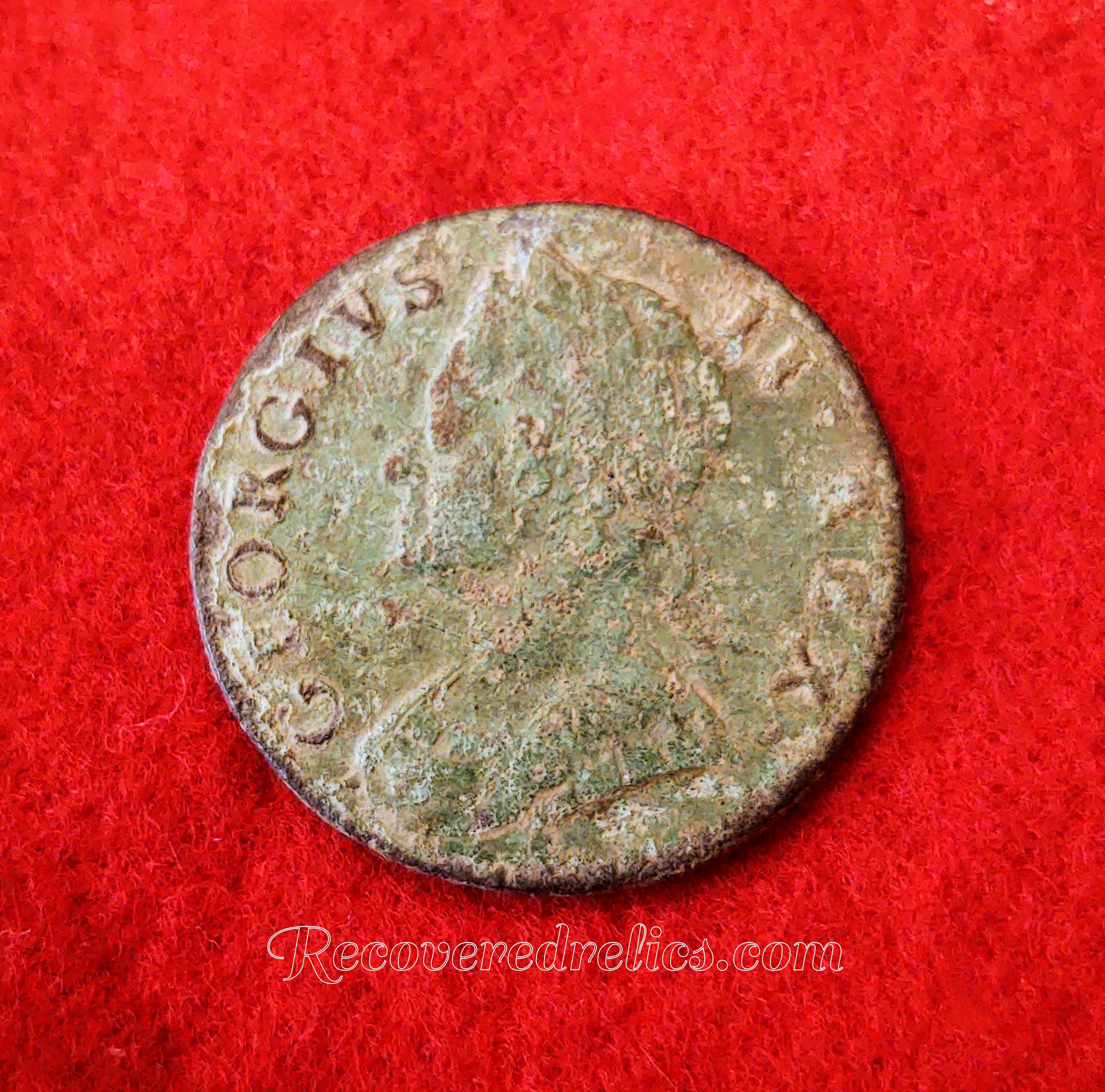
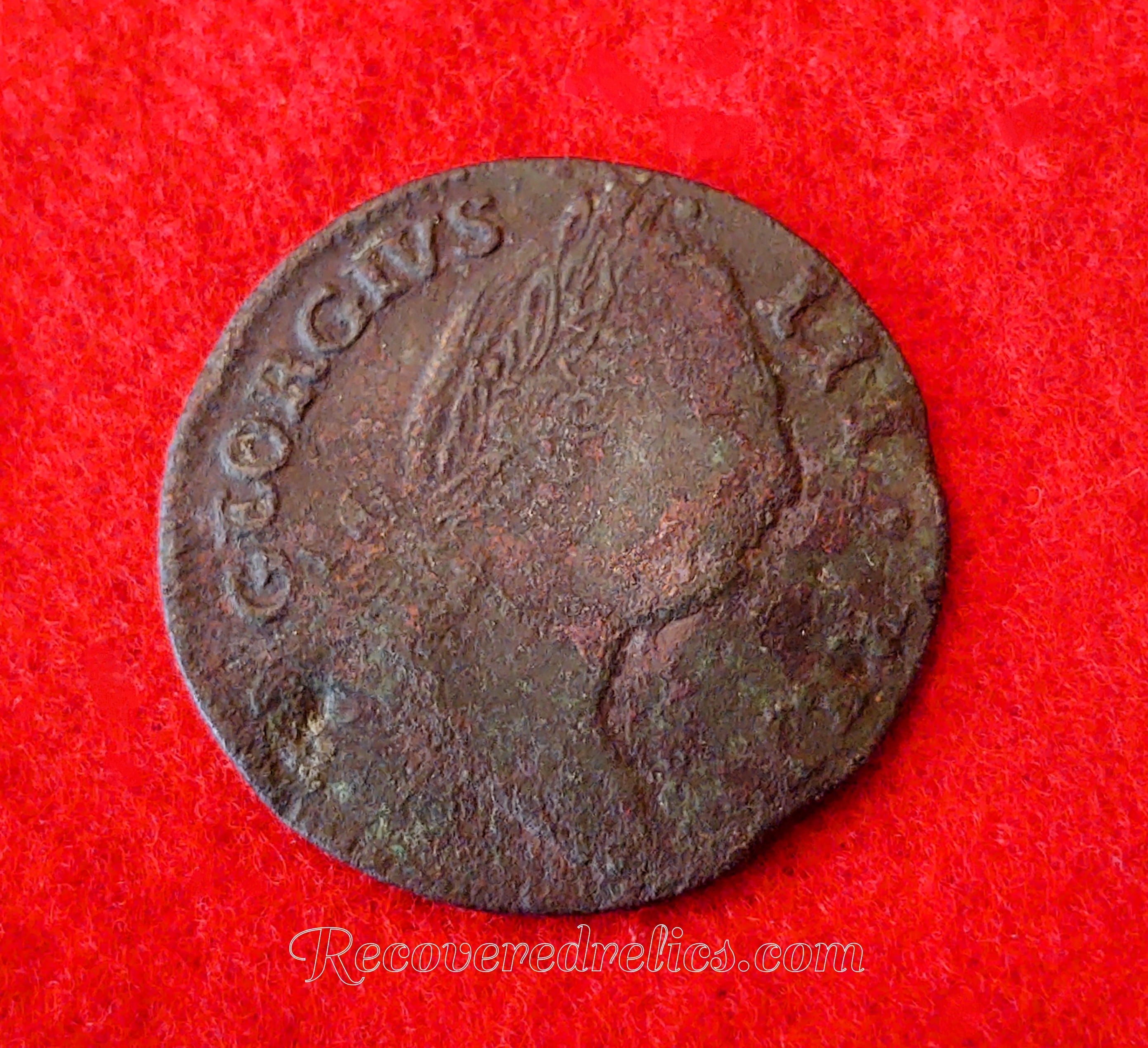
KG3/King George III Copper– George III became king in 1760. The first George III British halfpenny was minted in 1770 and the last in 1807. Halfpennies were minted infrequently during George III’s reign. They can be categorized into 3 distinct groups.
The 1770–1775 coinage weighted 9.2–10.8 grams and had a diameter of 29–30 millimeters in size. The obverse side shows a right-facing bust of the king, with the inscription “GEORGIVS III REX”. The reverse side shows a left-facing seated Britannia holding a spray and spear, with the inscription “BRITANNIA” and the date of issue. The king’s bust has a fuller face in 1774 and 1775.
The 1799 issue weighted 12.0–13.1 grams, and had a diameter of 30–31 millimeters. The obverse shows a right-facing bust of the king, with the inscription “BEORGIVS III DEI GRATIA REX”. The reverse shows a redesigned left-facing seated Britannia holding a spray and spear, with the inscription “BRITANNIA 1799”.
The 1806–1807 coins weighted 9.2–9.8 grams and had a diameter of 29 millimeters. Their obverse shows a right-facing bust of the king, with the inscription “GEORGIVS IIID G REX” and date of issue. Their reverse shows a slightly different left-facing seated Britannia holding a spray and spear, with the inscription ” BRITANNIA”.
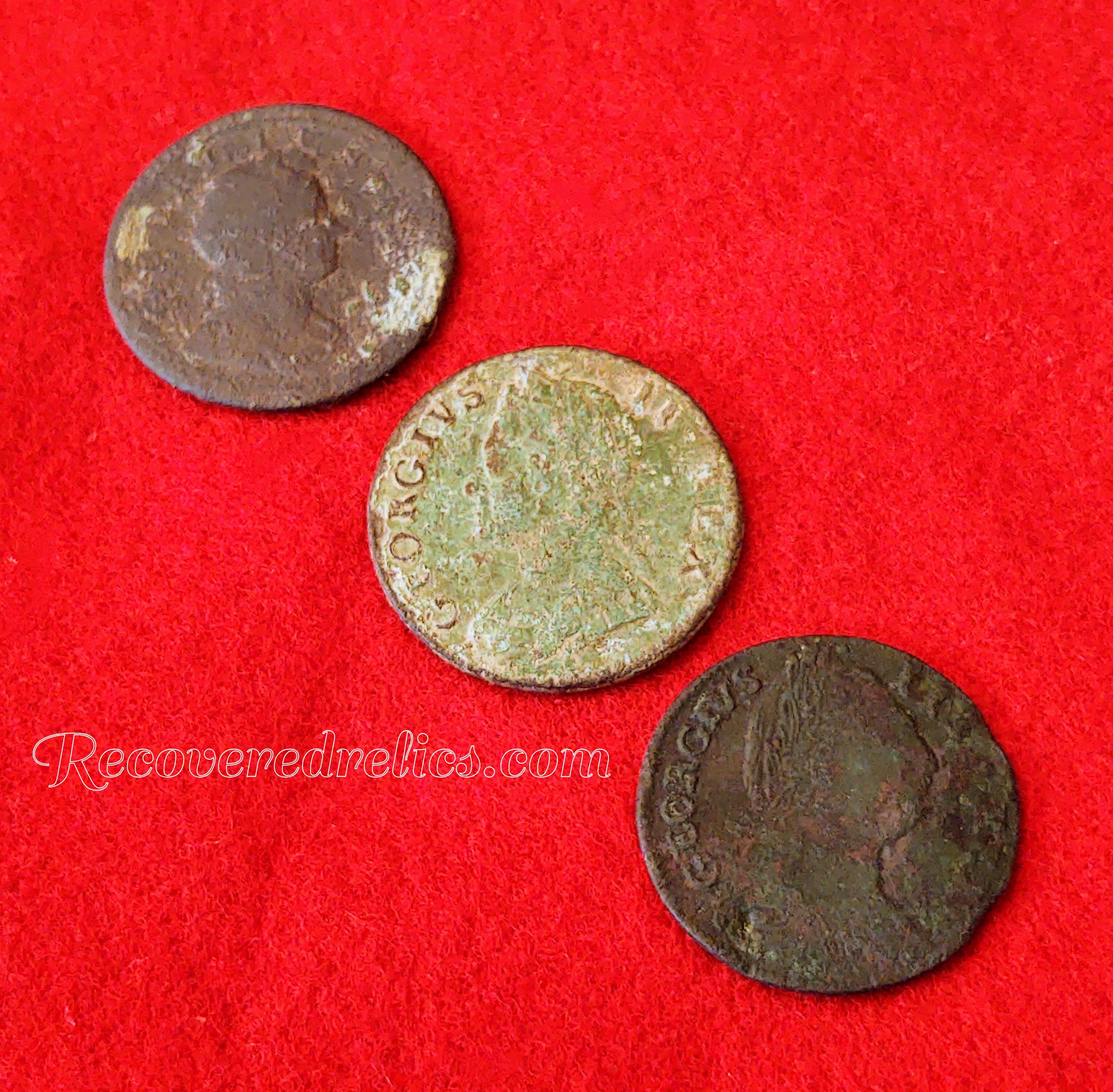
Large Cents (US Mint)– Large cents are one cent piece coins that were minted in the US between the years 1793 -1857. The large cent was minted every year from 1793 to 1857 except for the year 1815. They can be categorized into 7 distinct groups.
Flowing Hair cents, chain reverse (1793)
Flowing Hair cents, wreath reverse (1793)
Liberty Cap cents (1793–1796)
Draped Bust cents (1796–1807)
Classic Head cents (1808–1814)
Matron Head Coronet cents (1815–1839)
Braided Hair Coronet cents (1839–1857)

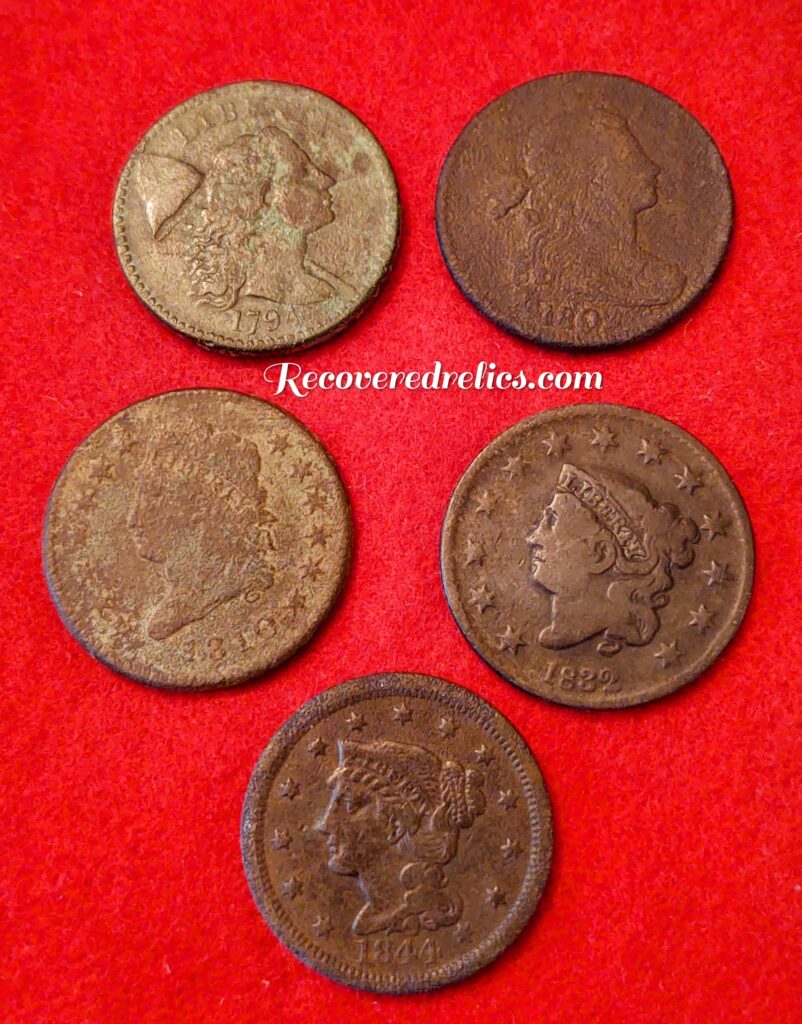
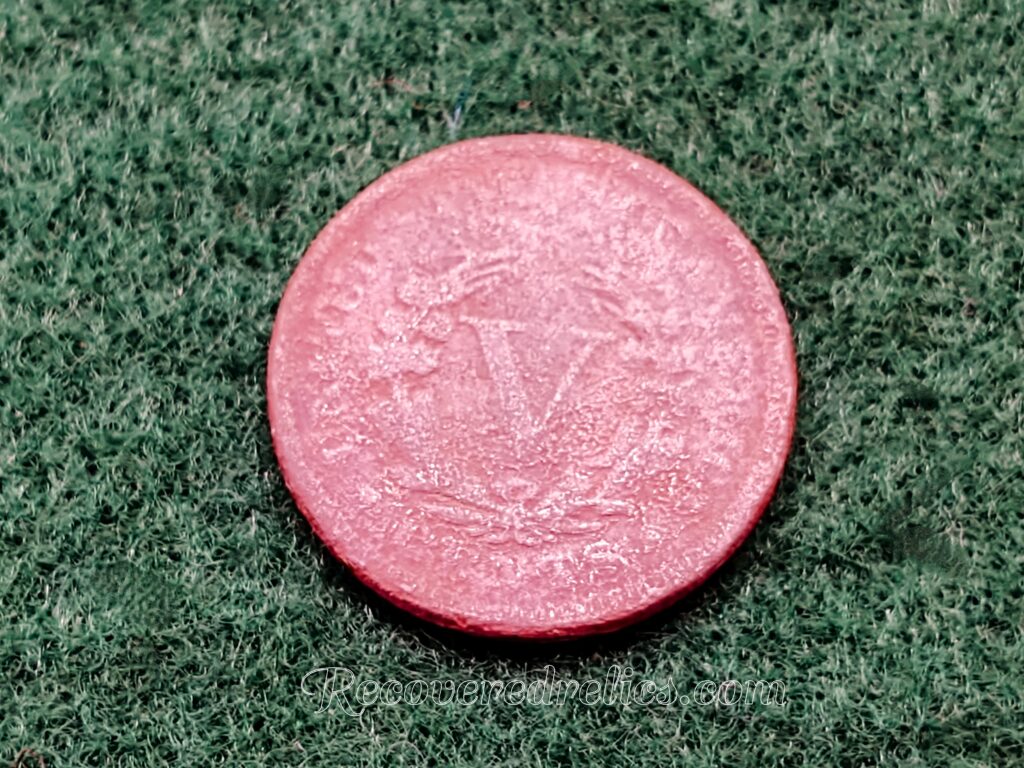
Liberty Head/ V Nickel (US Mint)– The Liberty Head/ V Nickel is a five cent piece that was minted for circulation by the U.S. Mint from 1883 to 1913. It gets it’s V Nickel name from the coins reverse design.
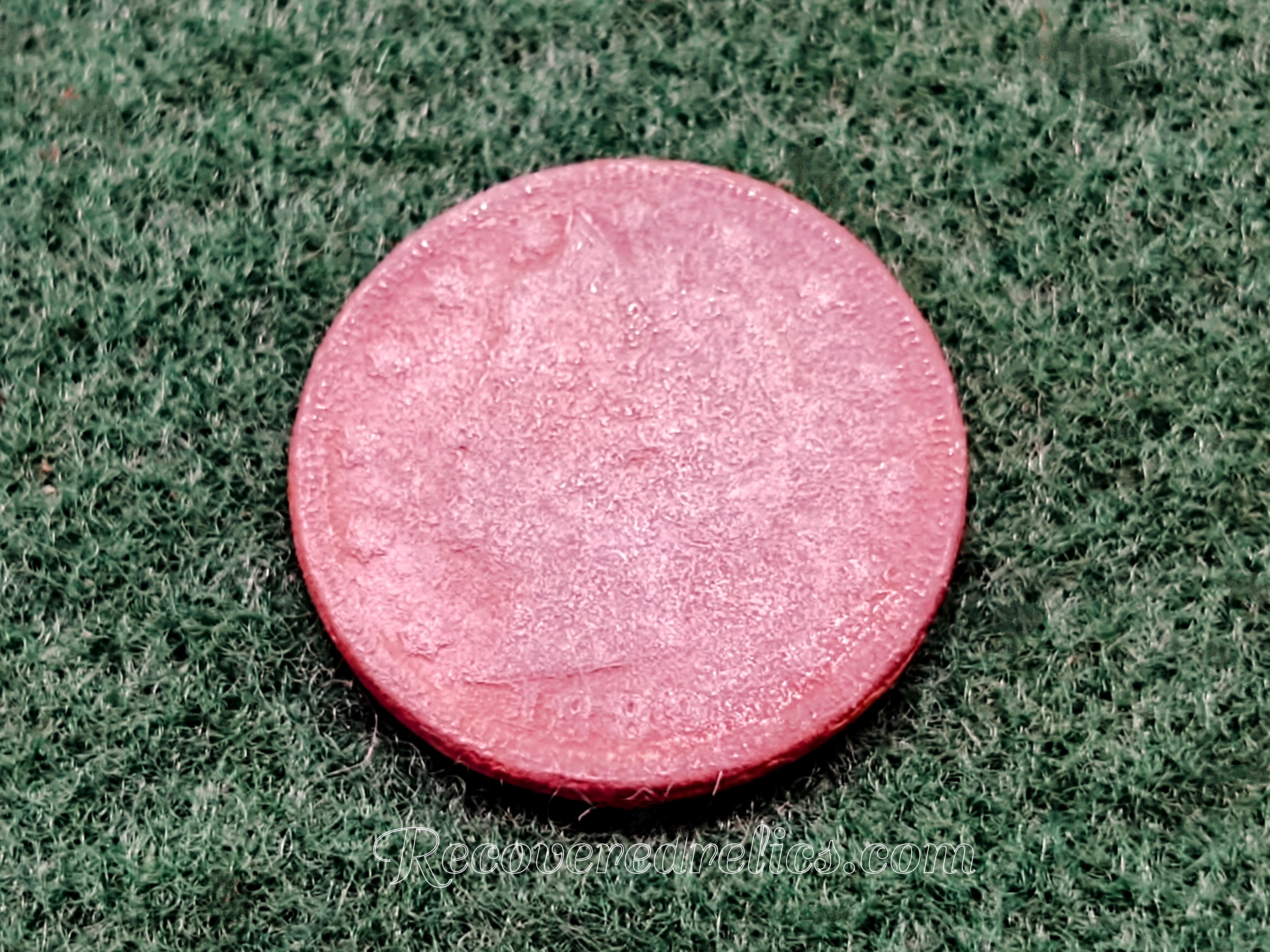
Morgan Silver Dollar (US Mint)– The Morgan dollar is a United States dollar coin minted between the years 1878 to 1904. The coin was designed by George Thomas Morgan. The coin pictured is a non-dug example.
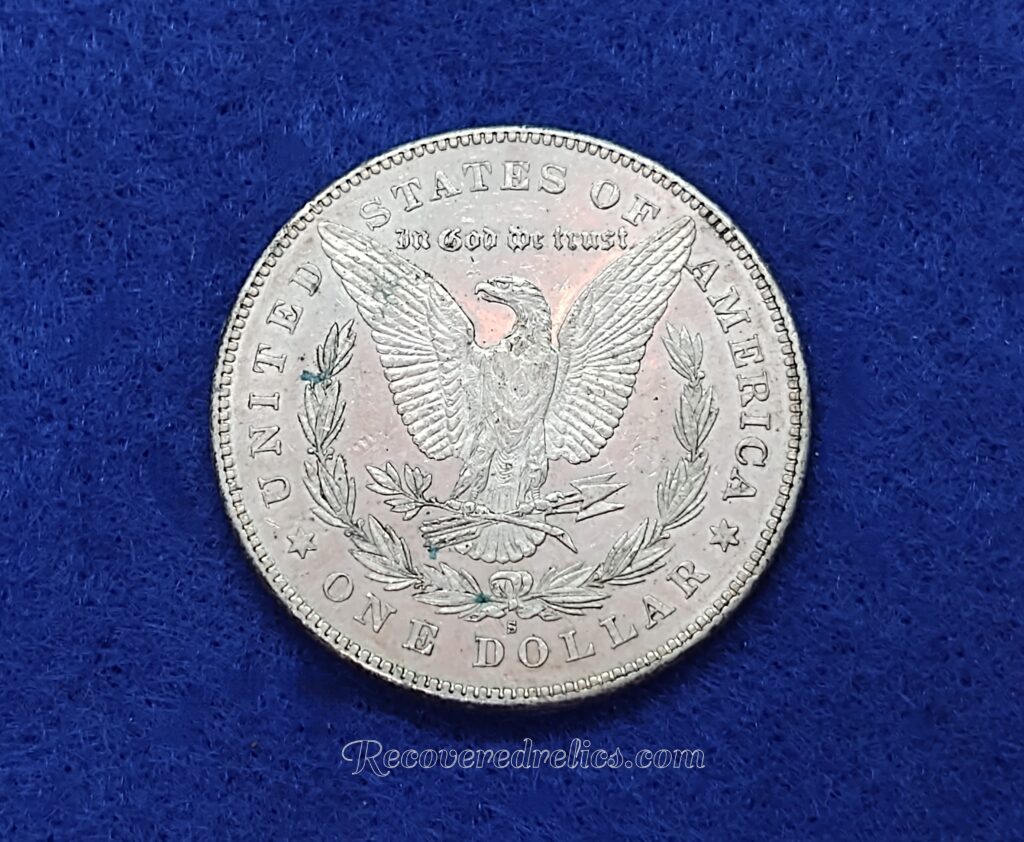
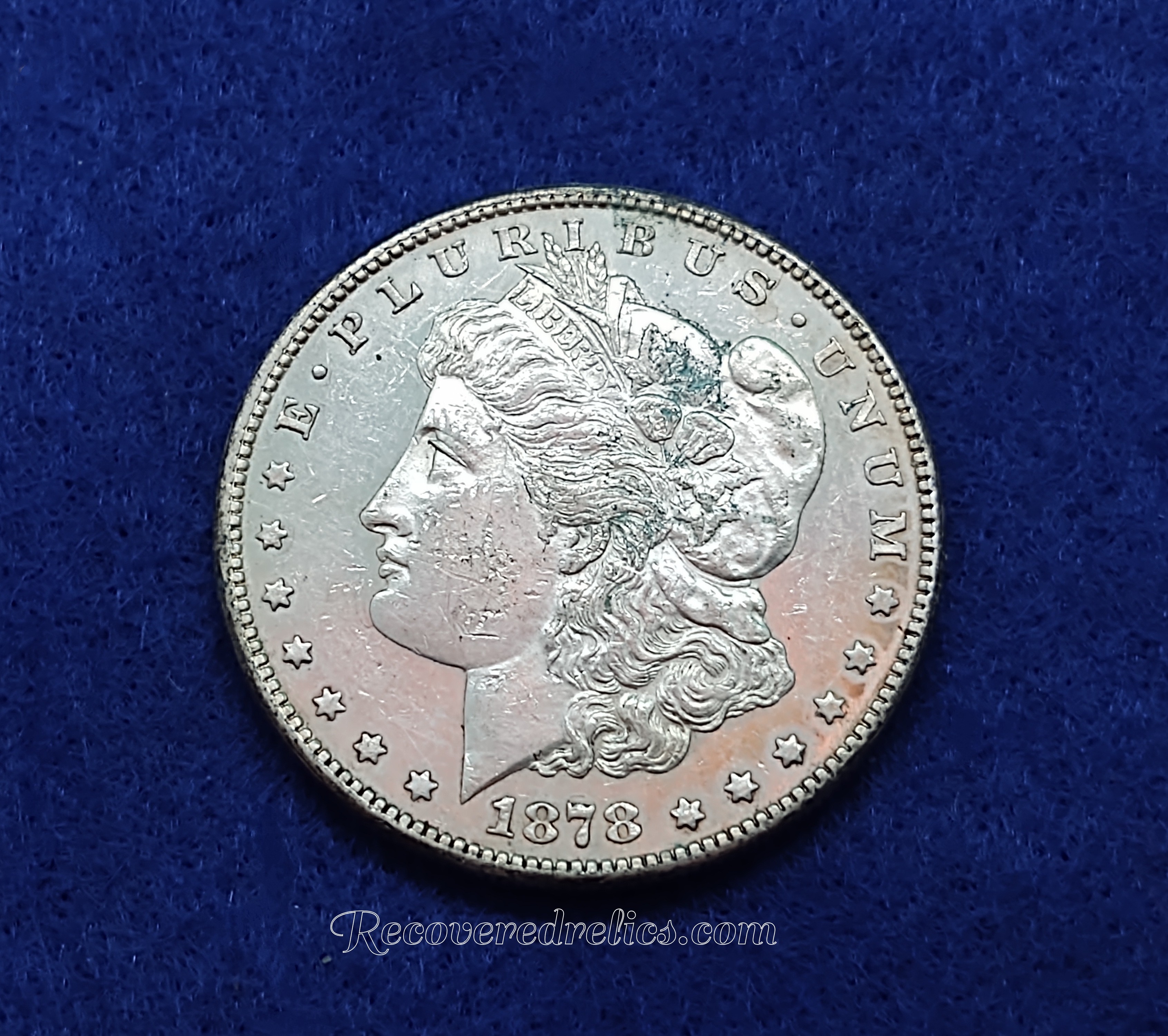
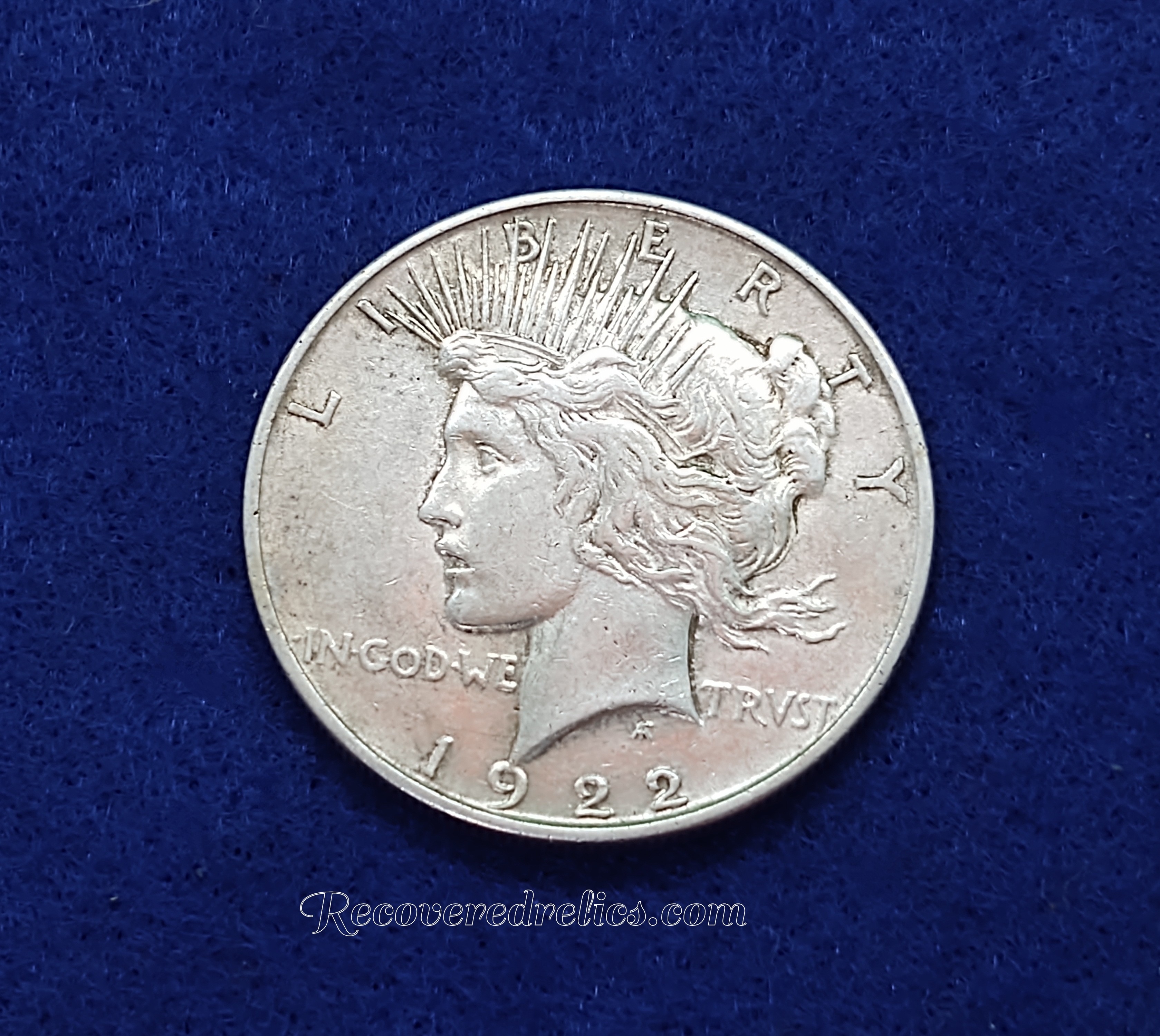
Peace Dollar (US Mint)– Peace dollars were minted for circulation from 1921 to 1928 and 1934 to 1935. The coin was designed by Anthony de Francisci. The Peace Dollar was the last United States dollar coin to be struck for circulation in silver. The coin pictured is a non-dug example.
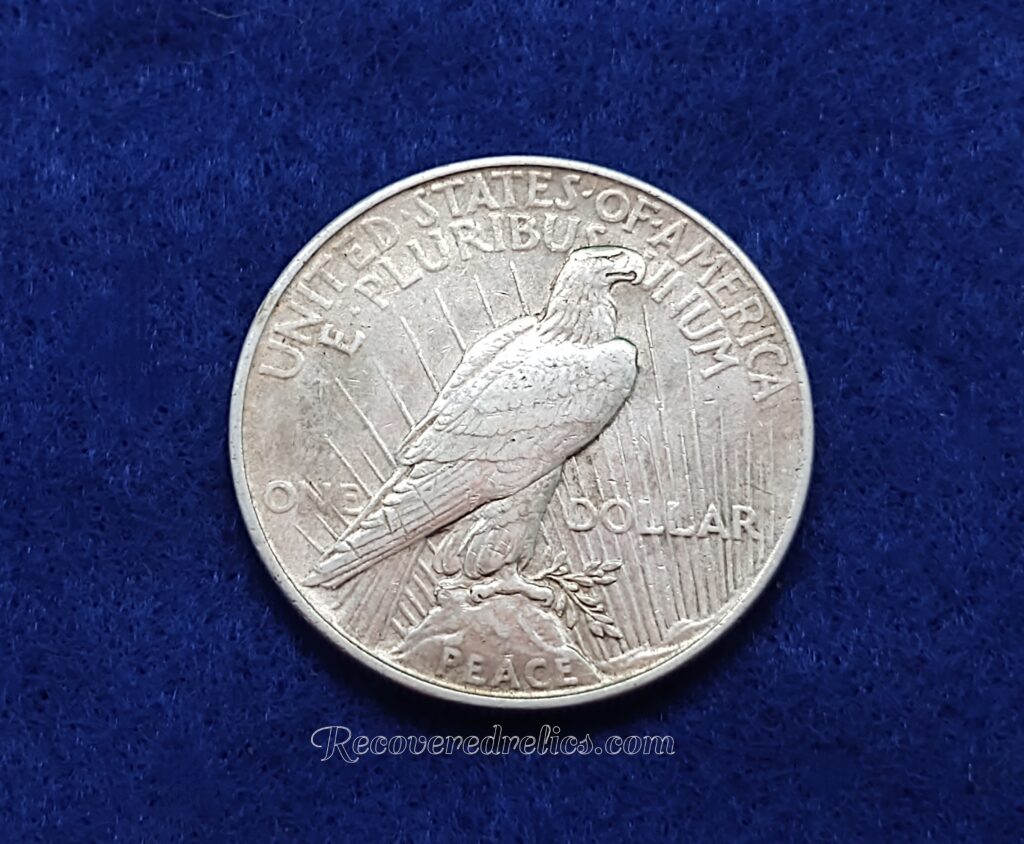
Pine Tree Shilling– These were colonial issued coins that were in circulation in the Thirteen Colonies during the 17th century. The obverse features a pine tree in the center enclosed within a beaded circle. The obverse has the inscription “MASATHVSETS IN”. The reverse shows the year “1652”, the denomination “XII” (for 12 pence), and the lettering “NEW ENGLAND AN DOM”. Records indicate that Pine Tree Shillings were minted between the years 1667 – 1682. However, practically every Pine Tree Shilling produced bore the date 1652.
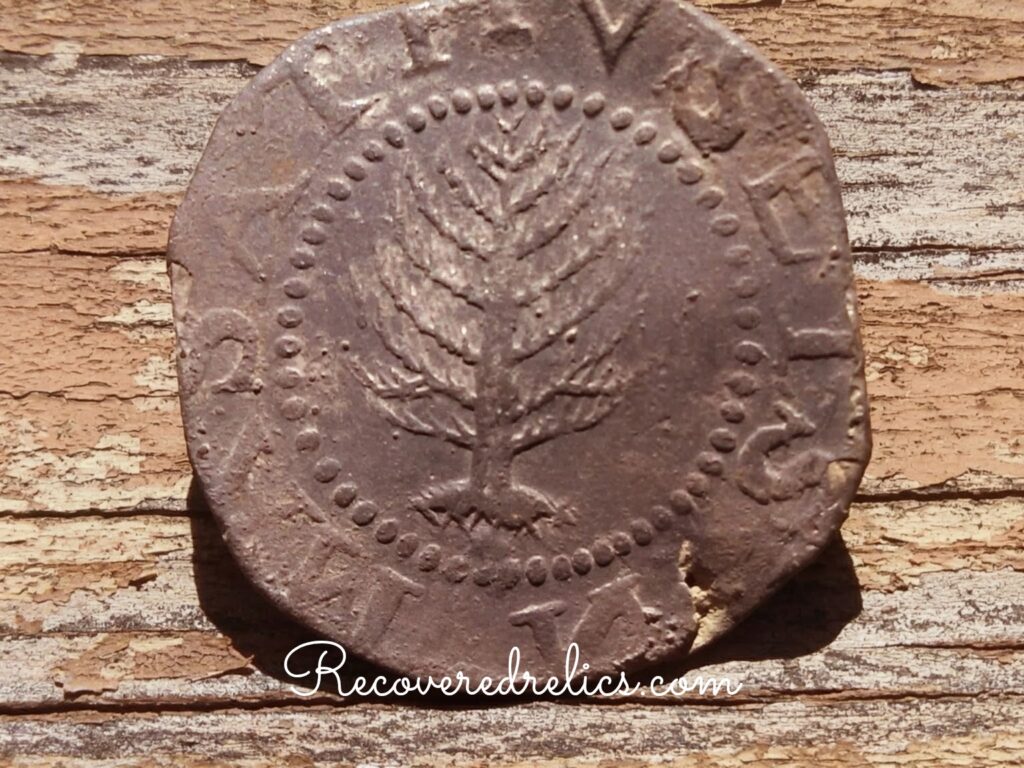

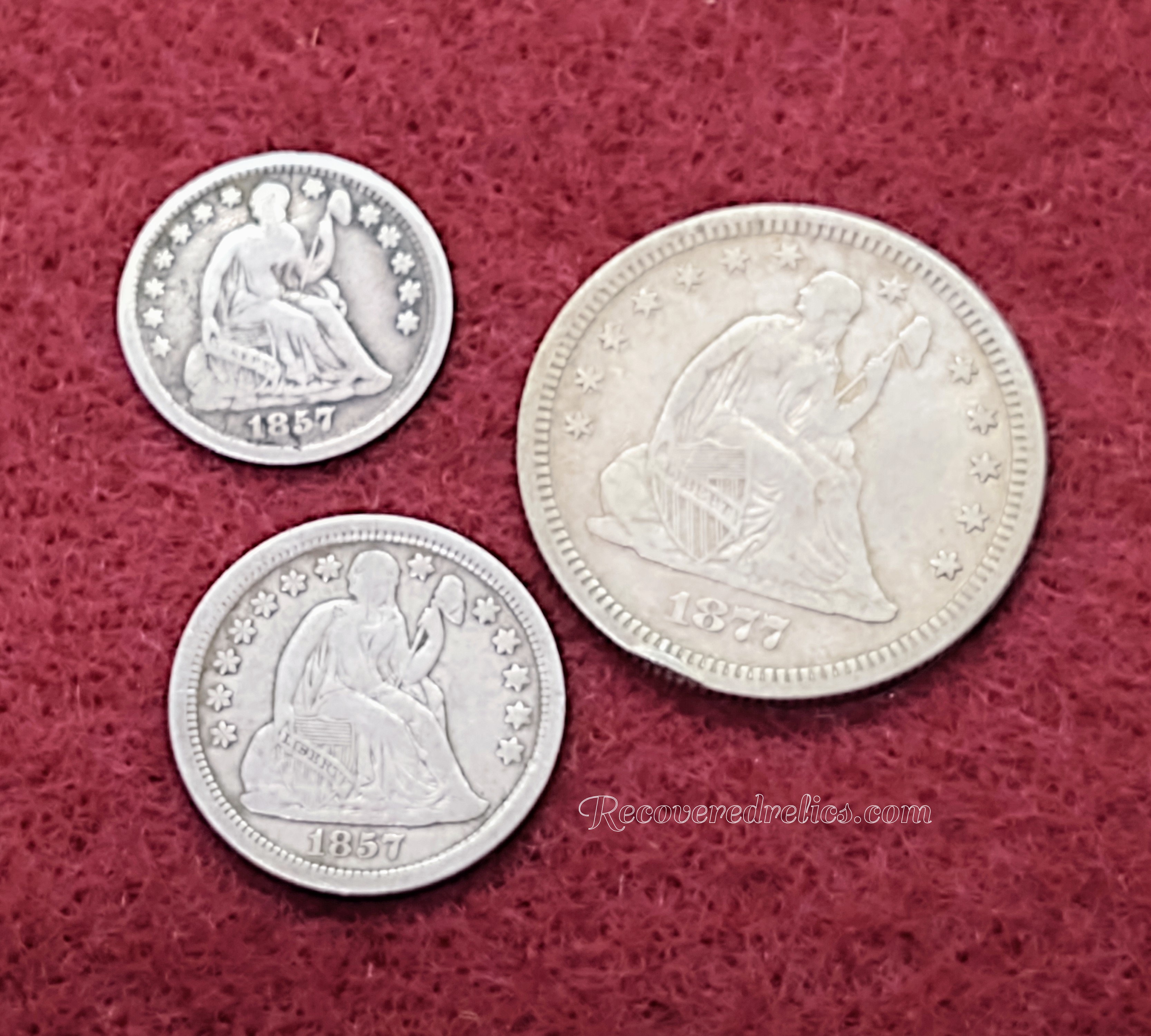
Seated Liberty (US Mint) Coin Series– (1836 – 1891) There are six denominations in the series including the half dime, dime, twenty cent piece (1875-1878) quarter, half dollar, and dollar (1836-1873). The obverse consists of the figure of Lady Liberty in a flowing dress and seated upon a rock. The date of the coin appears on the bottom below Liberty. The reverse design of Seated Liberty coins depended on the denomination. The reverse on the half dime and dime consistently featured a wreath around the words “half dime” or “one dime”. On quarter, half dollar, and silver dollar coins the reverse featured an eagle about to take flight, with a striped shield upon its breast. The reverse on the the twenty cent piece features an eagle grasping three arrows and an olive branch.
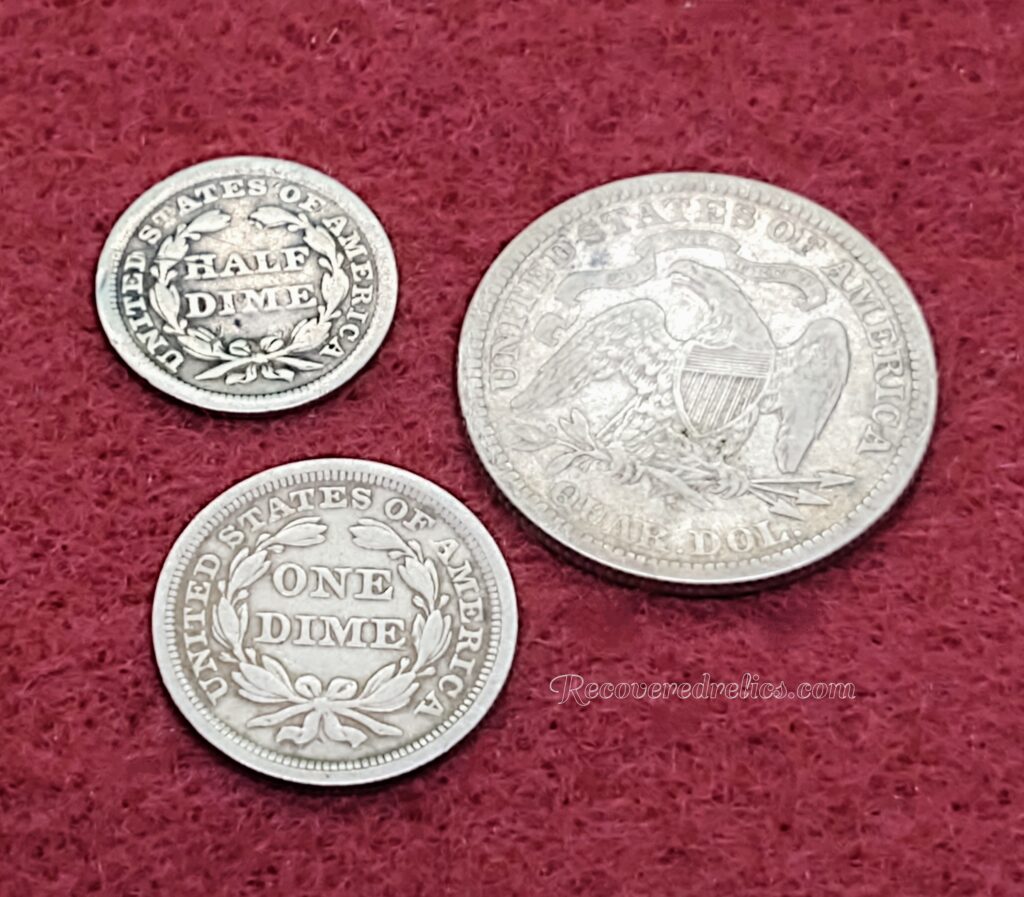
Shield Nickel (US Mint)– (1866-1883) The Shield nickel was the first United States five cent piece to be made out of copper-nickel. The coin was designed by James B. Longacre.

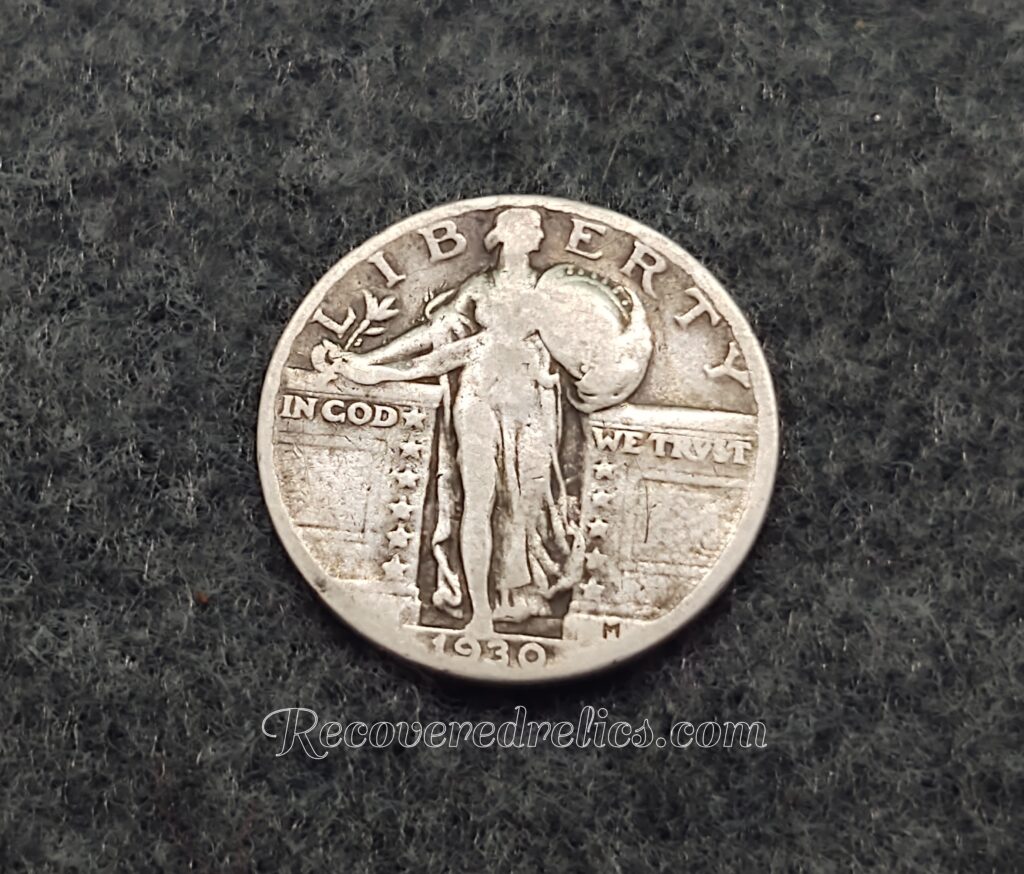
Standing Liberty Quarter (US Mint)– The Standing Liberty quarter is a 25 cent coin which was struck by the US Mint from 1916 through 1930. It succeeded the Barber quarter. Many of the Standing Liberty quarters we find detecting don’t have a visibly clear date. While in circulation, the coin’s date wore away rather quickly. The Mint engravers modified the design of the coin in 1925 in order to address the issue. The Standing Liberty quarter was discontinued in 1931, a year in which no quarters were struck by the US Mint.
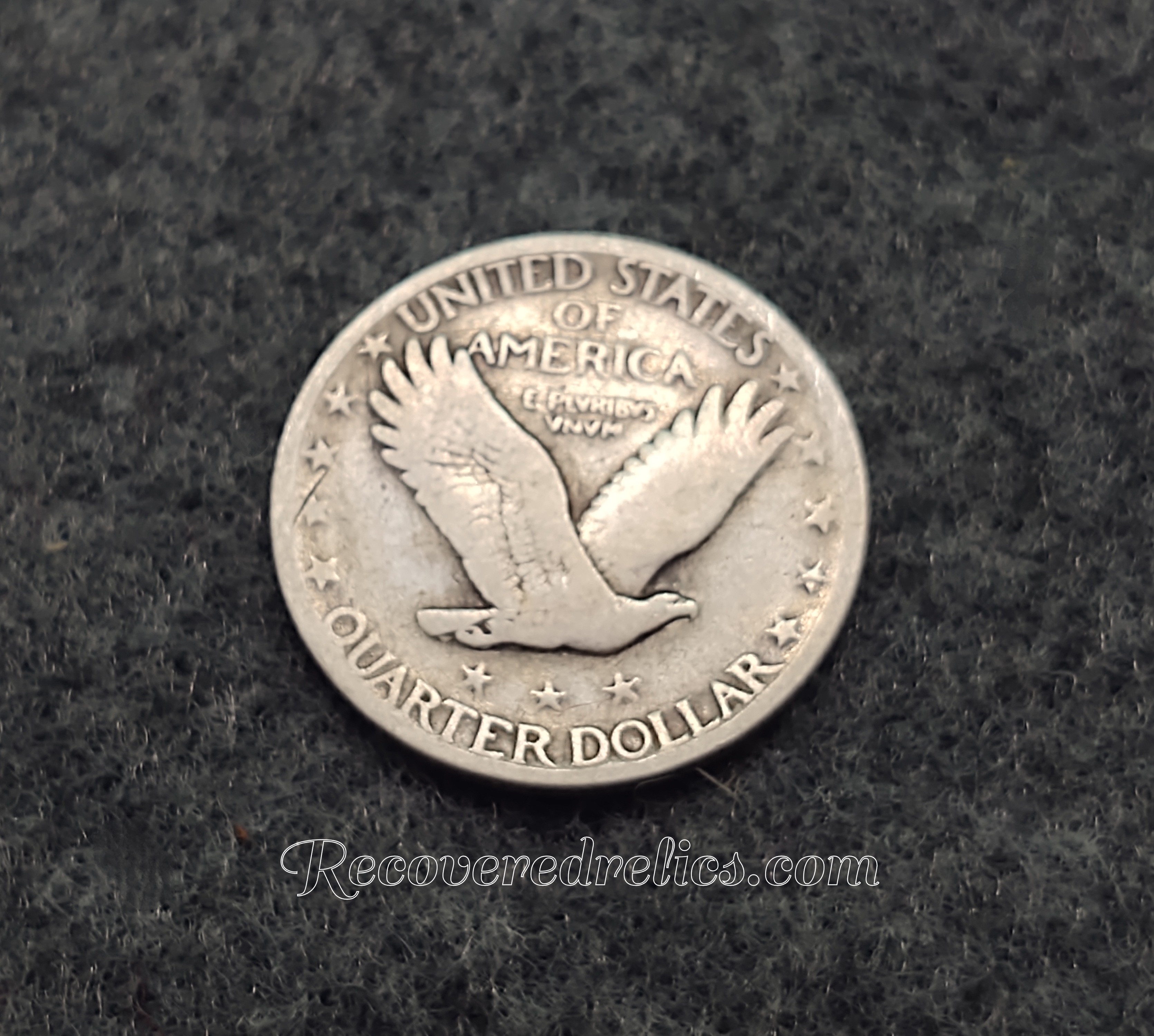
Spanish Silver Reales– The real was a unit of currency in Spain and the Spanish colonies in America for several centuries. Spanish Reales were widely circulated during the colonial era in America. Spanish Reales were first minted during the 14th century under the direction of the King of Castile and Leon, known as Pedro the Cruel. The design of the Spanish Real have greatly changed over time. Changes were made to the coins appearance and design every time a new king took over the crown.
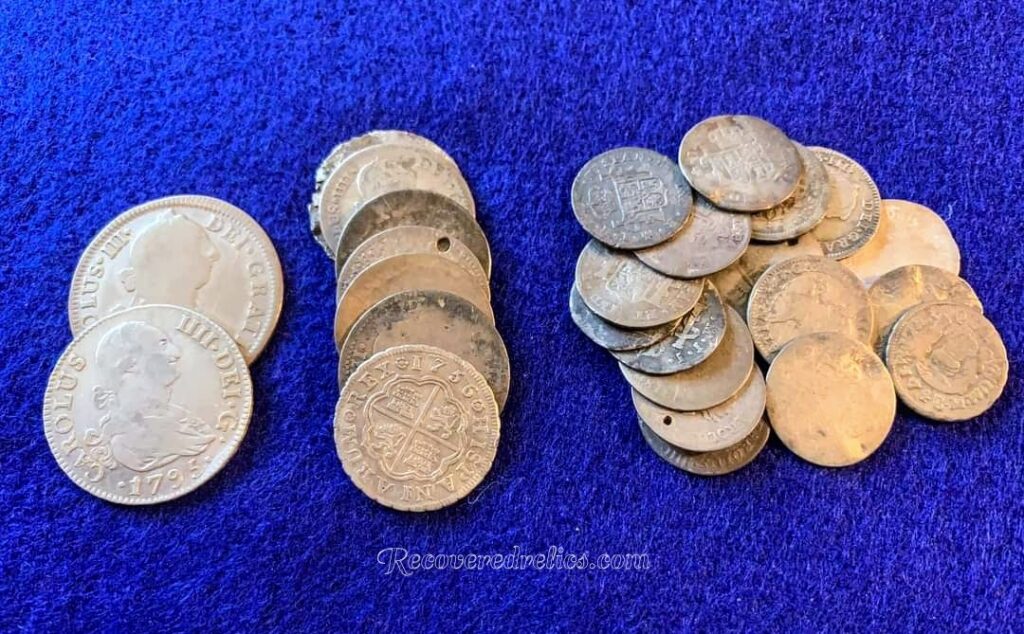
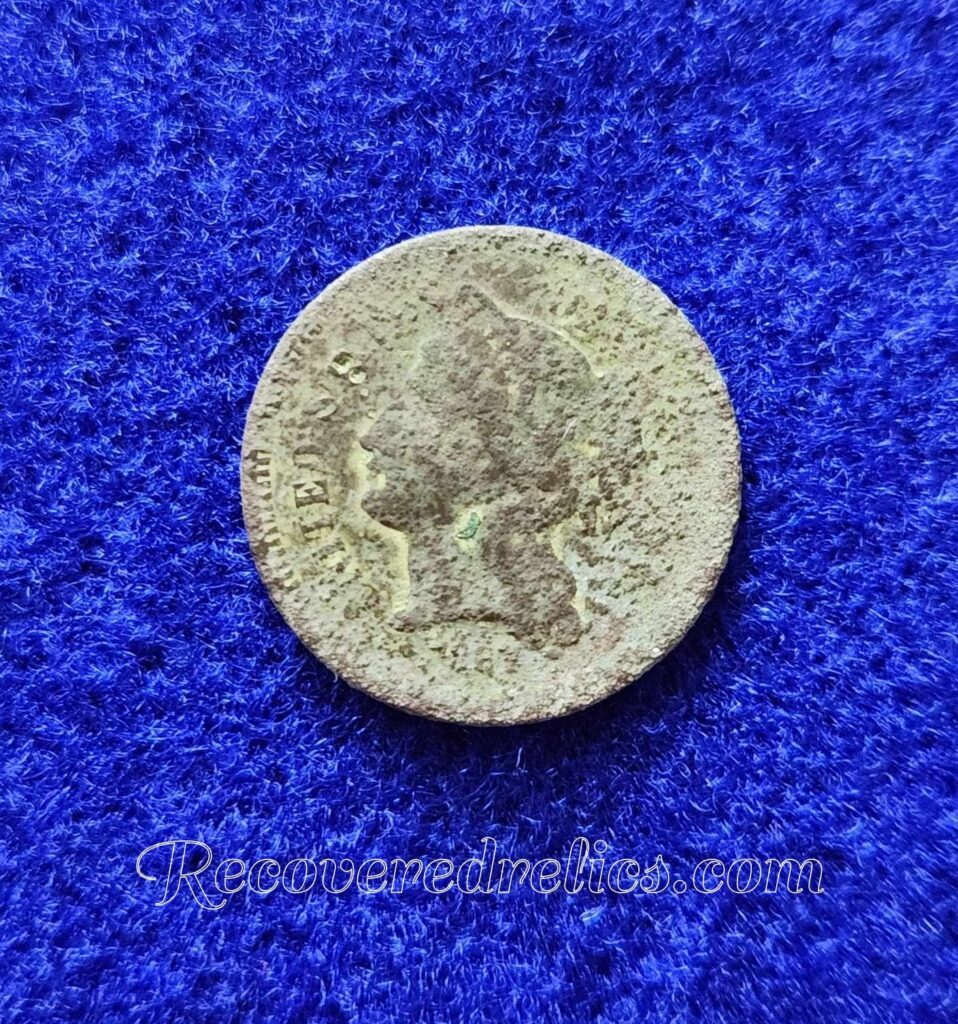
Three Cent Nickel (US Mint)– The Copper/ Nickle Three Cent Piece was minted from 1865- 1889. It was designed James Barton Longacre. Initially it circulated well but it became less popular when the five cent nickel was introduced in 1866.
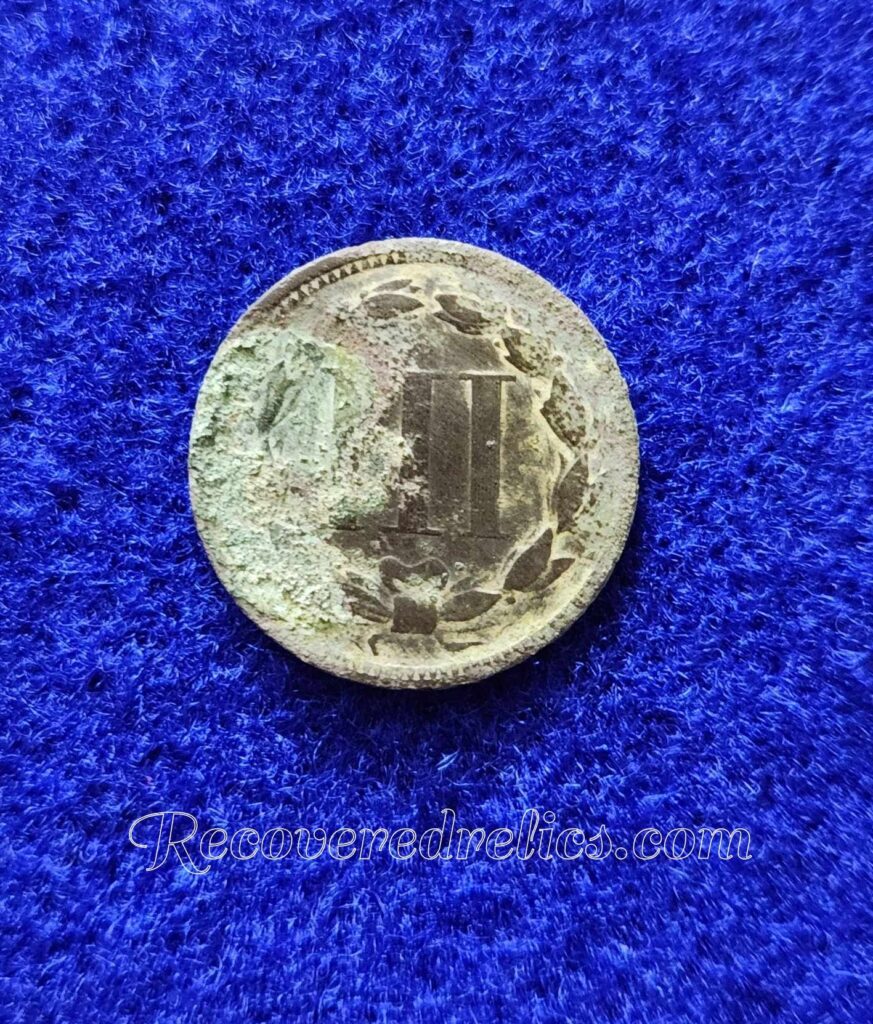
Three Cent Silver/ Trime (US Mint)– The Three Cent Silver coin was struck by the US Mint for circulation from 1851 to 1872 and as a proof coin in 1873. It was designed by James Barton Longacre.
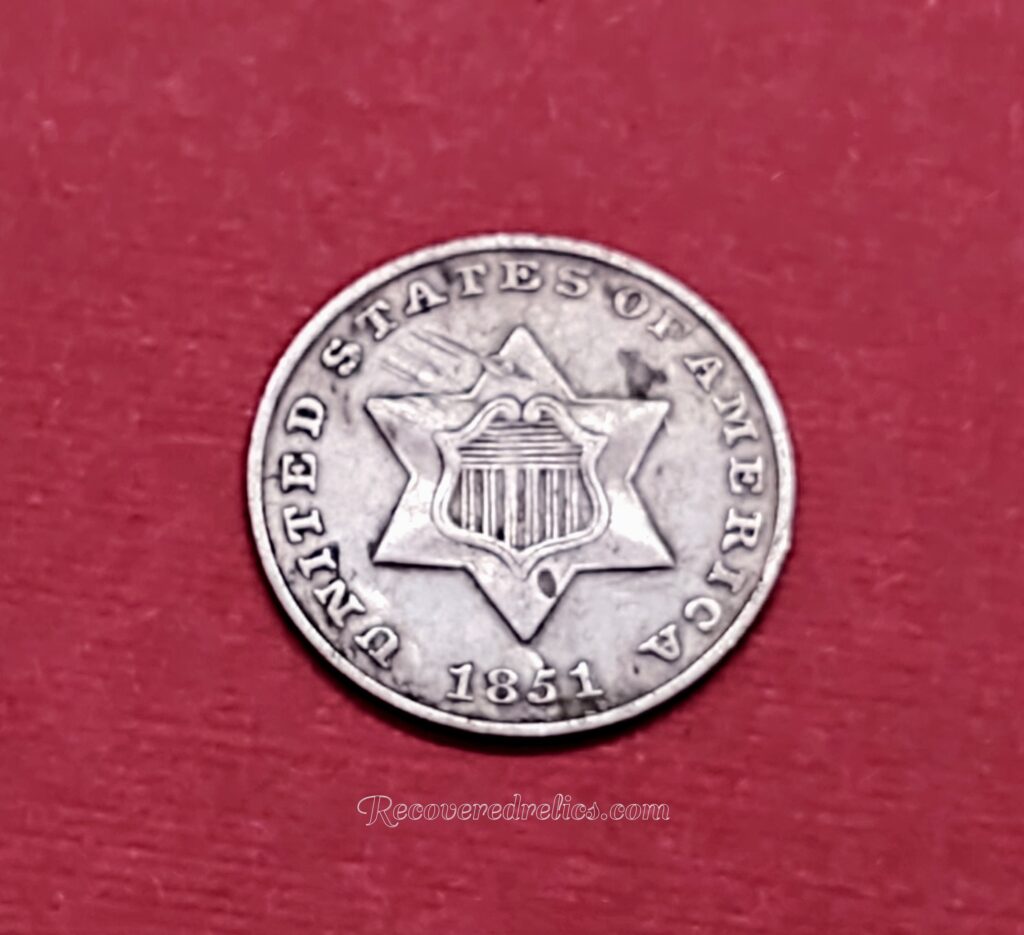
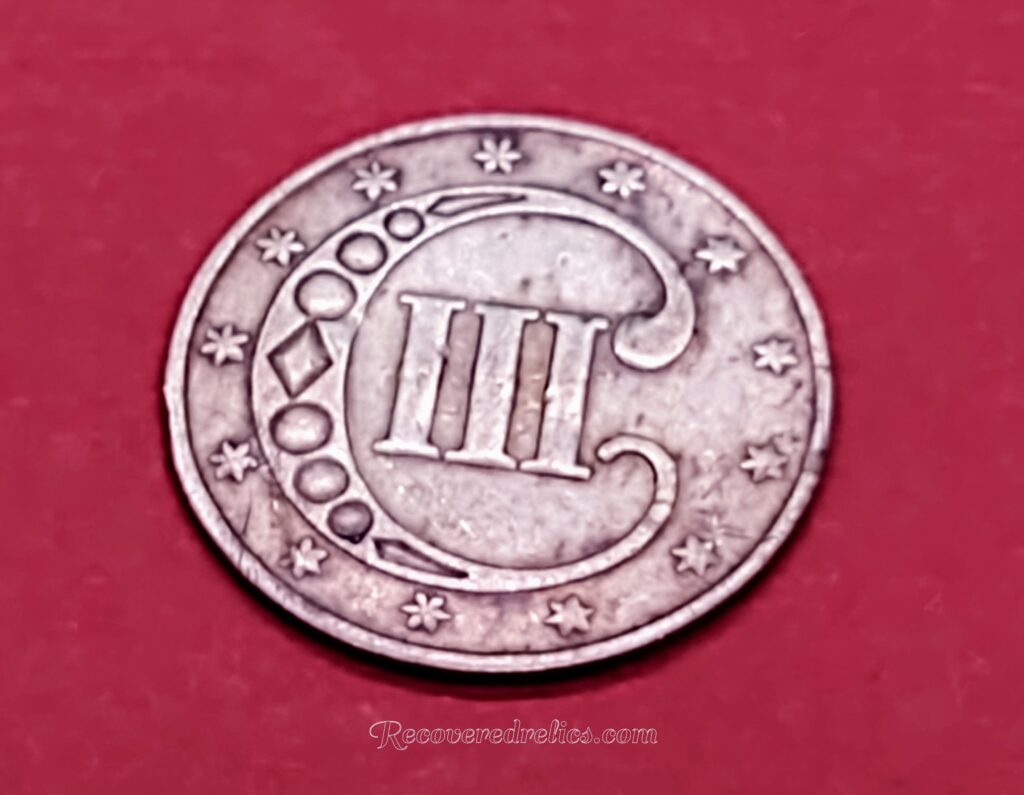
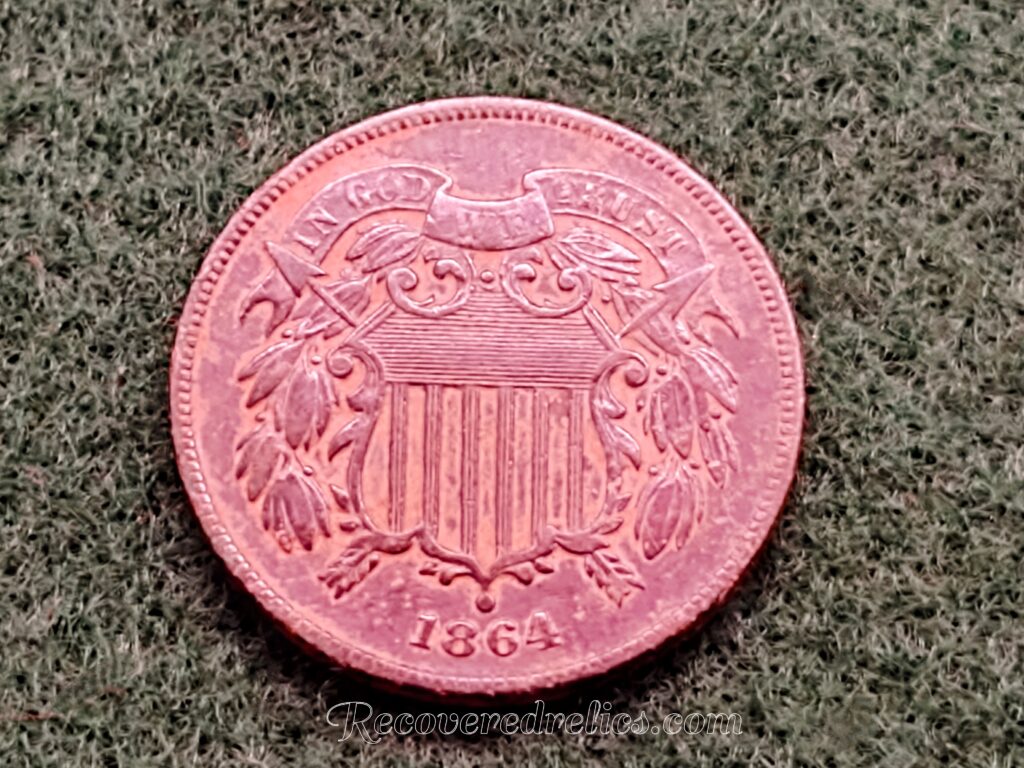
Two Cent Piece (US Mint)– The Two Cent Piece was produced by the US mint for circulation from 1864 through 1872. The coin was designed by James B. Longacre. There were decreasing mintages each year of production since other coins such as the nickel proved to be more popular. The two Cent Piece was abolished by the Mint Act of 1873.
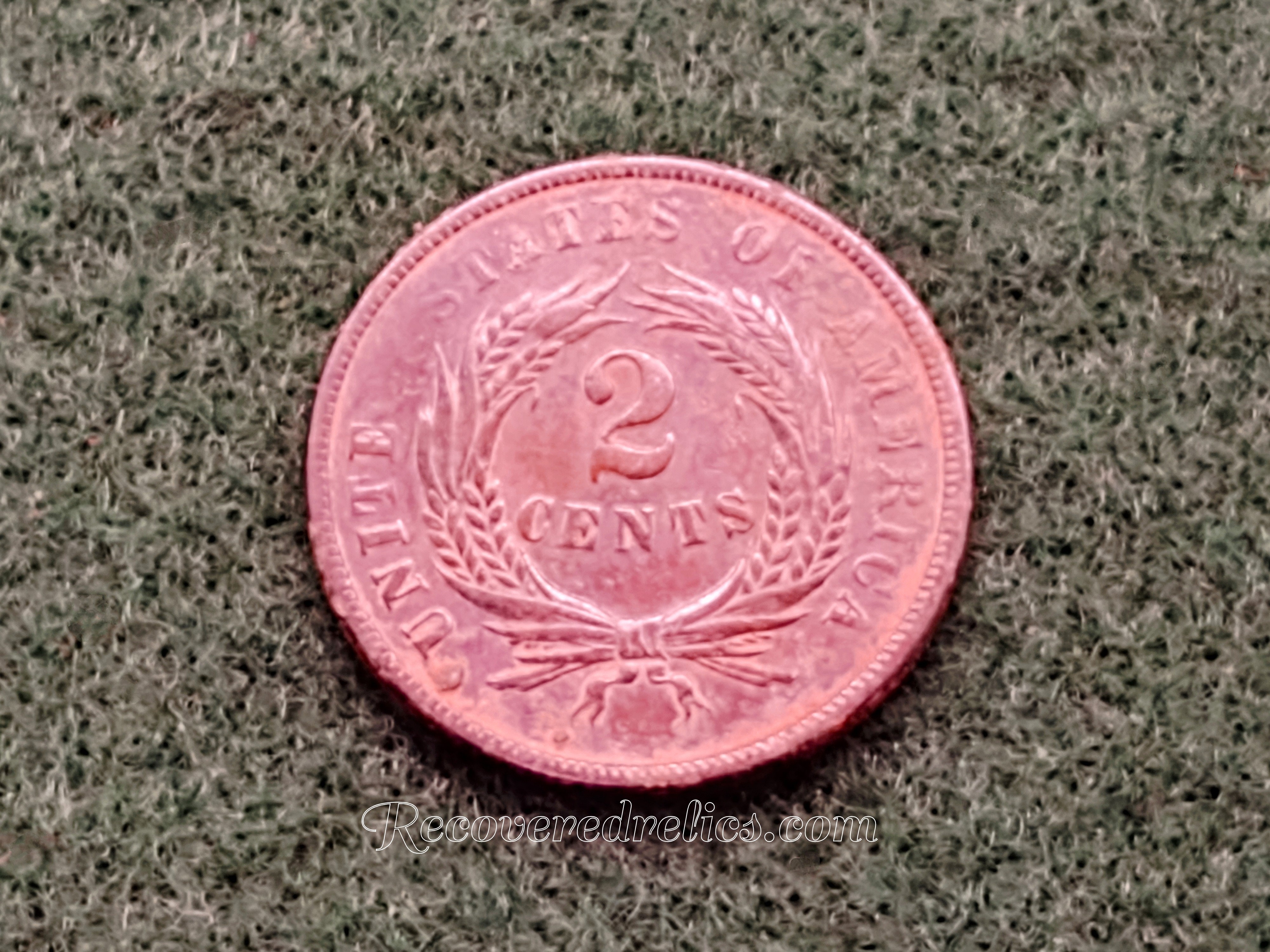
Virginia Half Penny – In the year 1609 the Royal Charter decreed granted the Colony of Virginia the authority to mint coinage for use in Virginia. In 1773, the Virginia Assembly recognized the need for actual coinage and authorized the striking of a Halfpenny from the Mint on the Tower of London. The obverse design has a bust of King George III, facing right. The reserves has a large crowned shield and the word “VIRGINIA”. The lettering and date is separated by the crowned shield. The coins arrived to New York in 1774 and were distributed to Virginians in 1775.
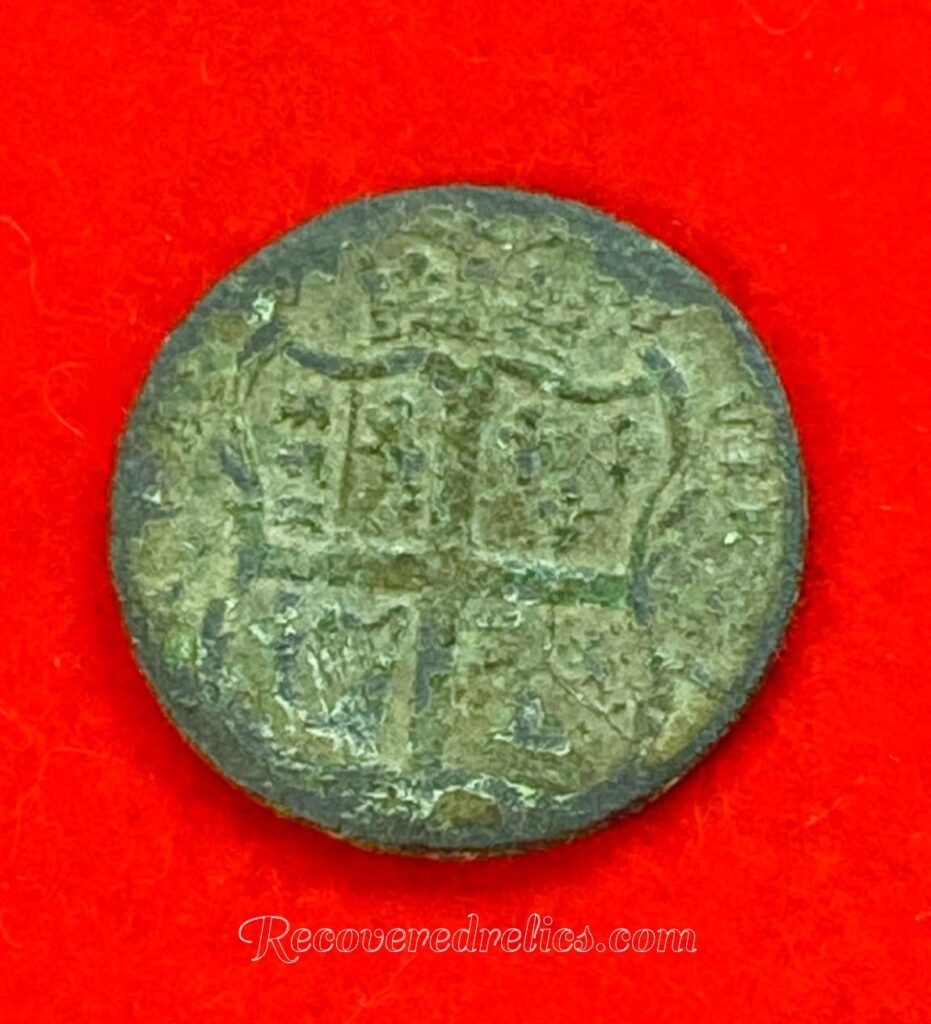
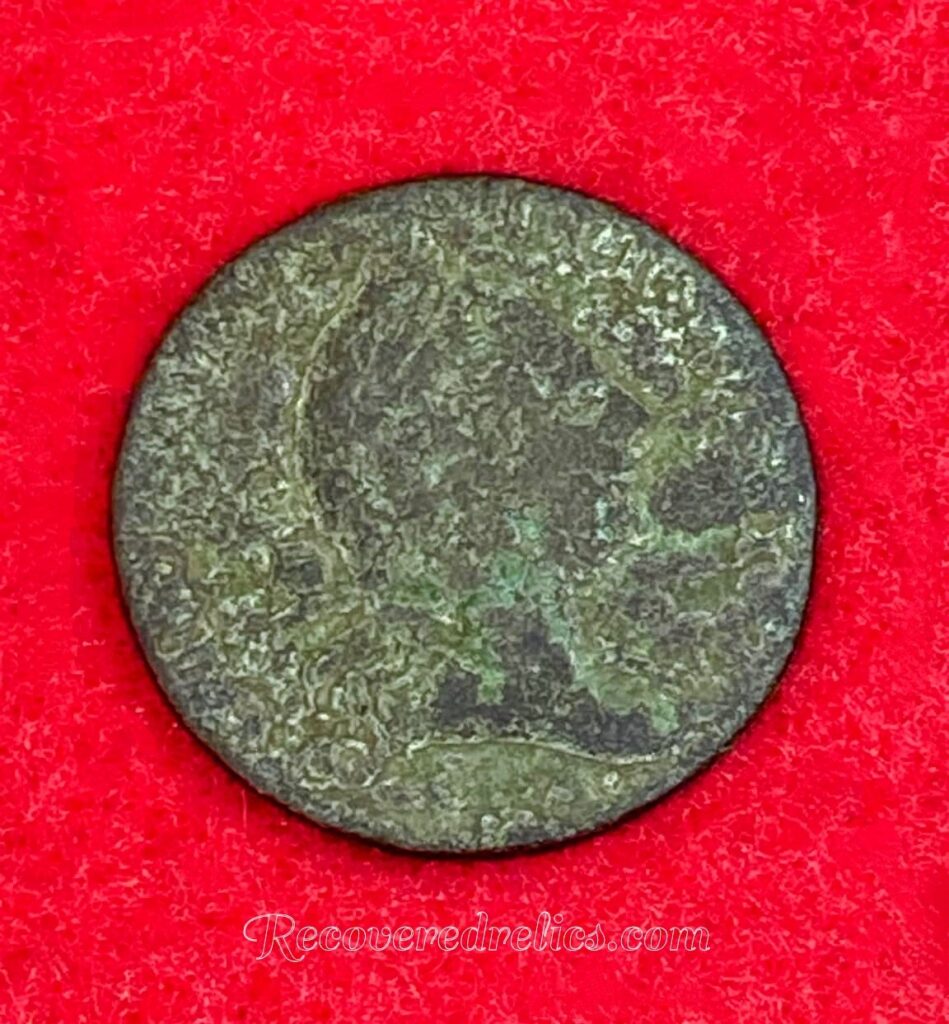
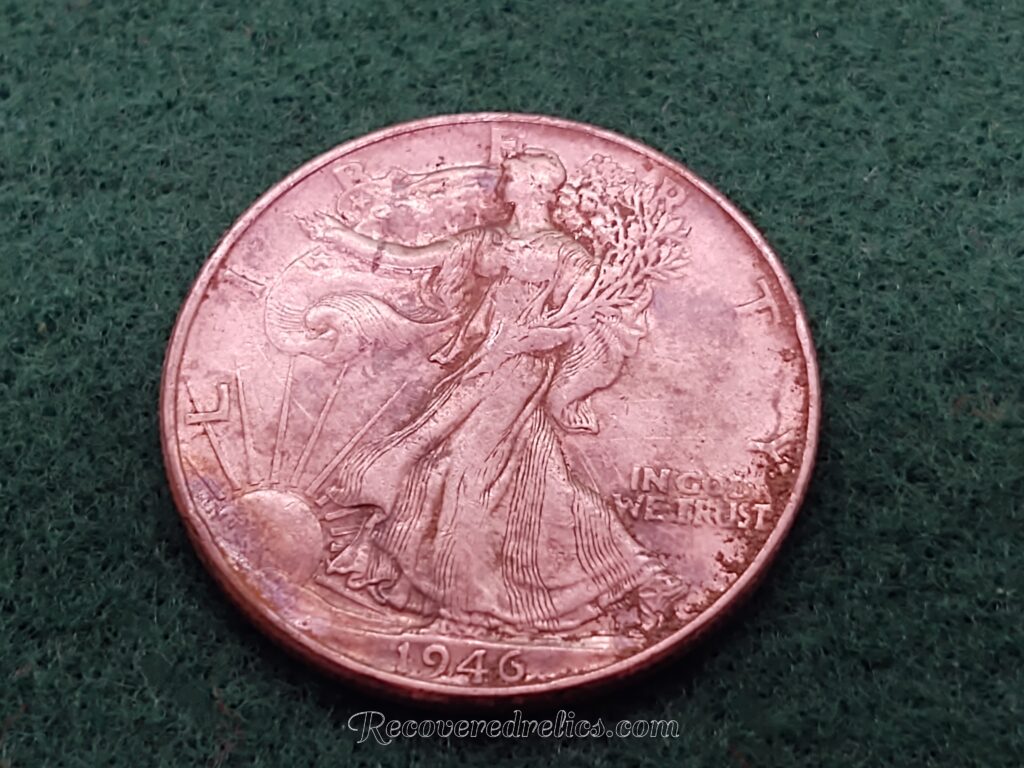
Walking Liberty Half Dollar(US Mint)– The Walking Liberty Half dollar is a fifty cent piece coin that was produced by the US Mint from 1916 to 1947. The coin was designed by Adolph A. Weinman.
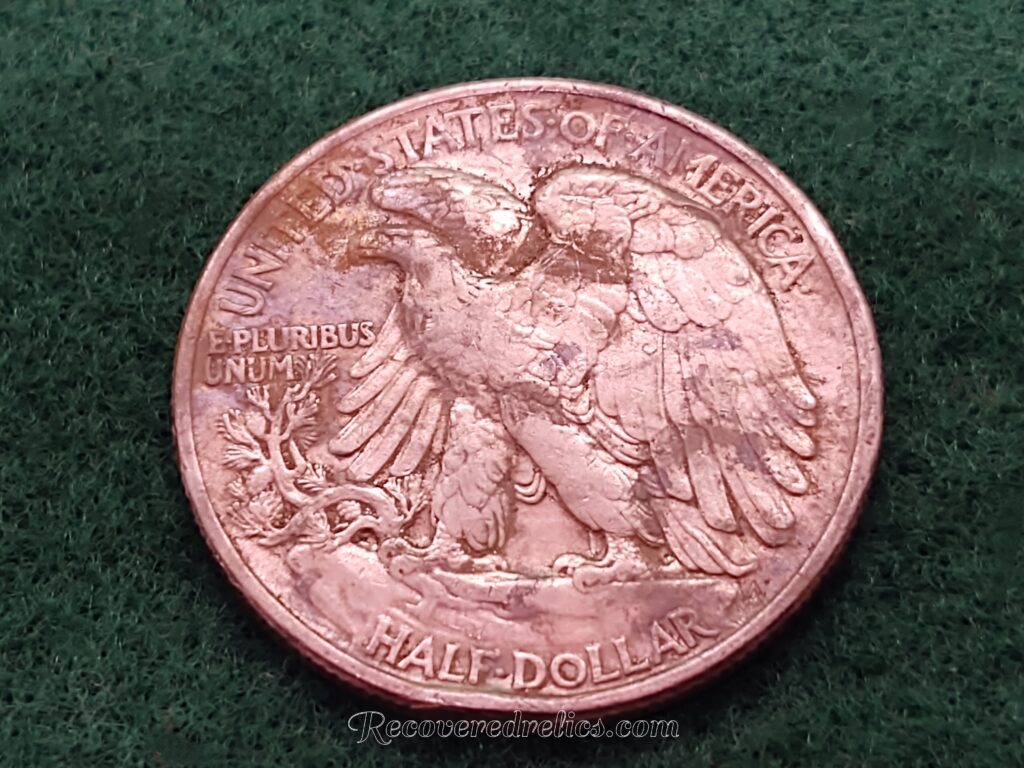
Hardware and Utilitarian Items
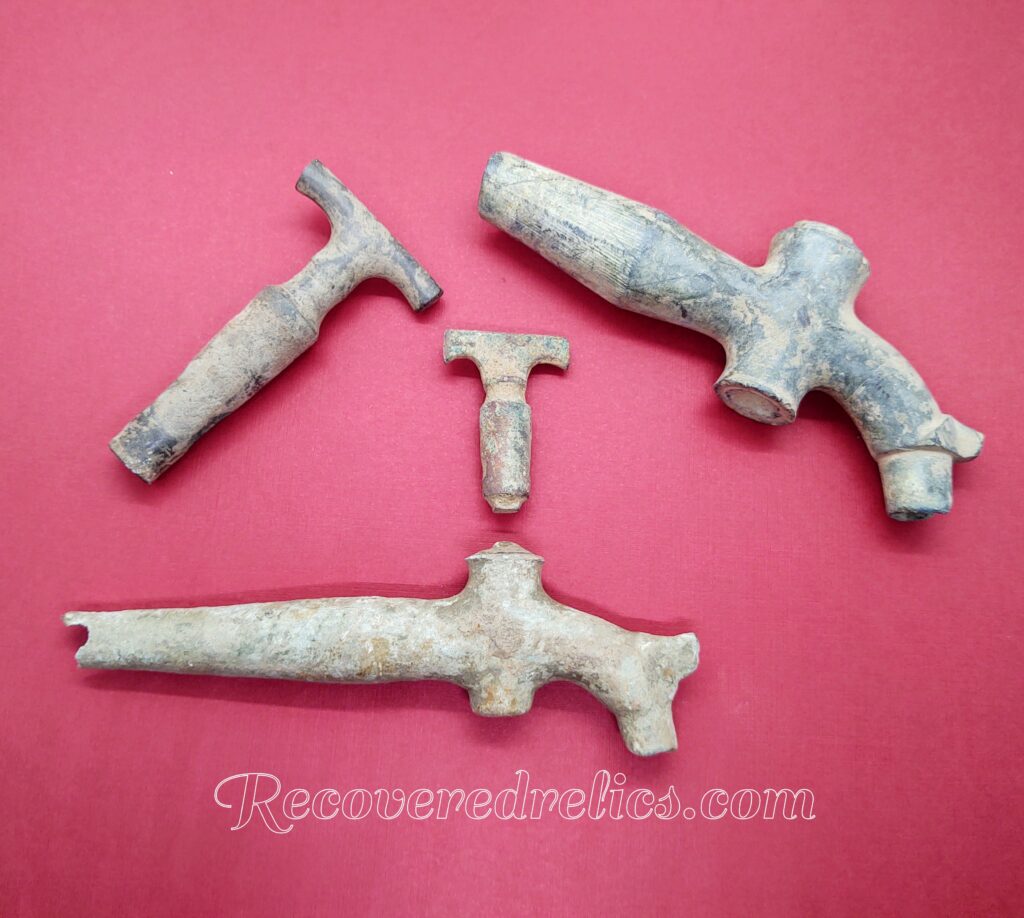
Barrell Tap and Key– A tap is a valve that controls the flow of liquid from a container. Taps have hollow pipes, stems, and a cross piece or socket. The pipe is the part that brings the liquid towards the tap. The spout is the part that the liquid comes out of. The cross piece or socket is the piece that the stem fits into. The key is comprised of a handle and stem. The handle is the piece which is held to turn the tab on and off. The part below the handle is the stem. Stems usually have a hole through which the liquid flows when the tap is turned.
Blanket Pin-Safety pins are divided into numbered size categories. Size 4 or larger are referred to as blanket pins. These large sized safety pins were traditionally used to secure horse blankets .

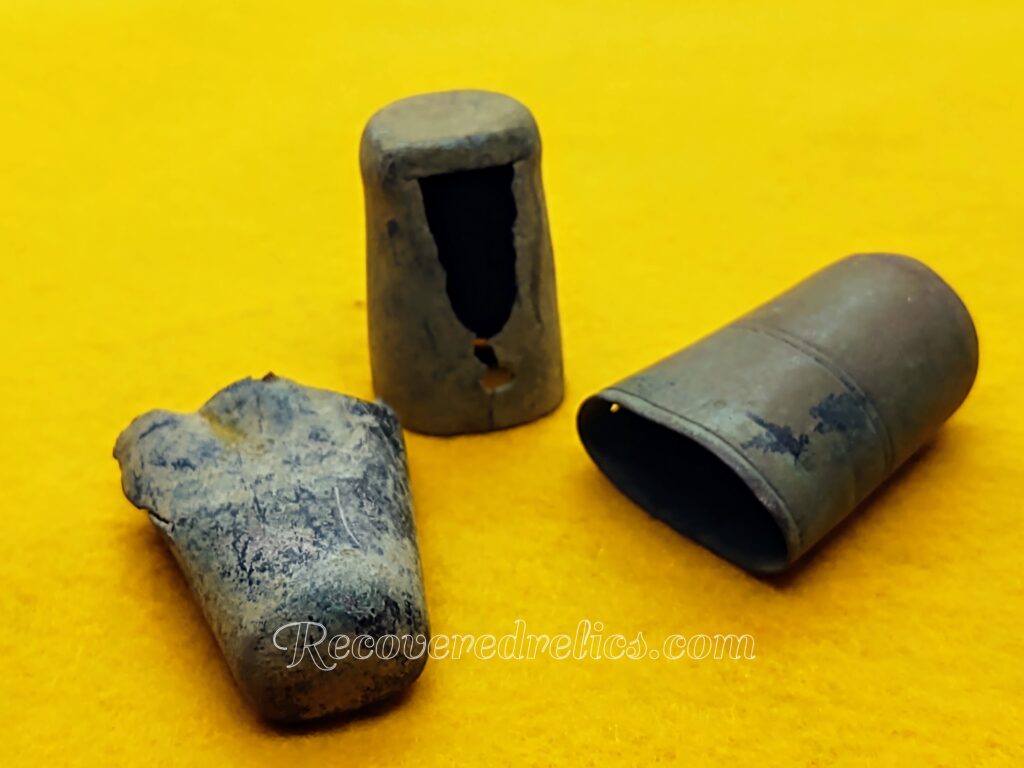
Carriage/ Horse Buggy Shaft Tip– Metal shaft tips are used to protect the ends of the wooden shaft. The shaft of a horse carriage is the component that connects the carriage to the horse.
Chest Lifting Handle Plate– A plate would be positioned on each side of a handle. Lifting handles were commonly used on chests and trunks. The design of the handle keeps ones fingers from getting pinched when lifting a chest or trunk. This handle style was popular in the 19th century and is still manufactured today.
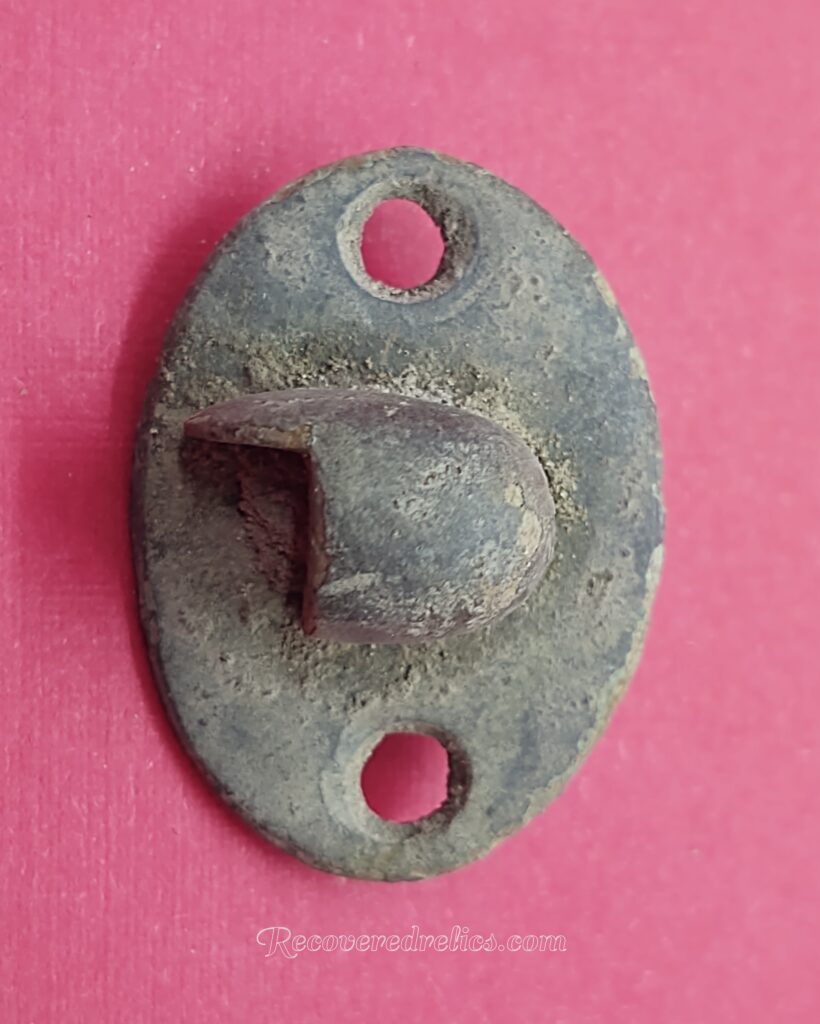
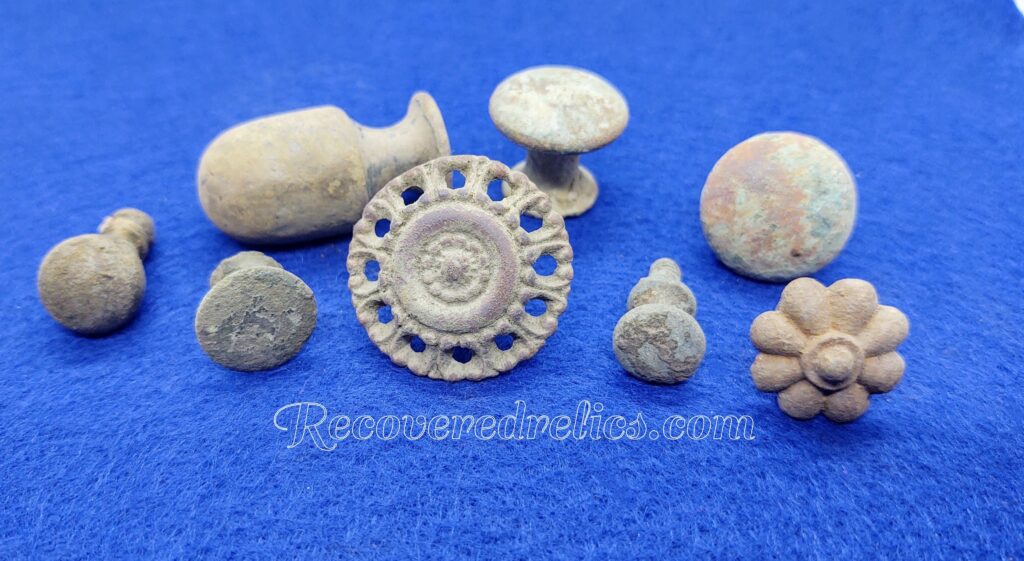
Drawer Pulls– A handle for pulling open a drawer. They come in a vast number of different sizes, styles, and designs.
Escutcheon Plate– A decorative metal plate or shield that surrounds a keyhole, doorhandle, light switch etc. They are both ornamental and protective. Escutcheon plates are useful protective covers that conceal gaps or holes in walls, ceilings, or keyholes while at the same time enhancing the aesthetics of ones home.

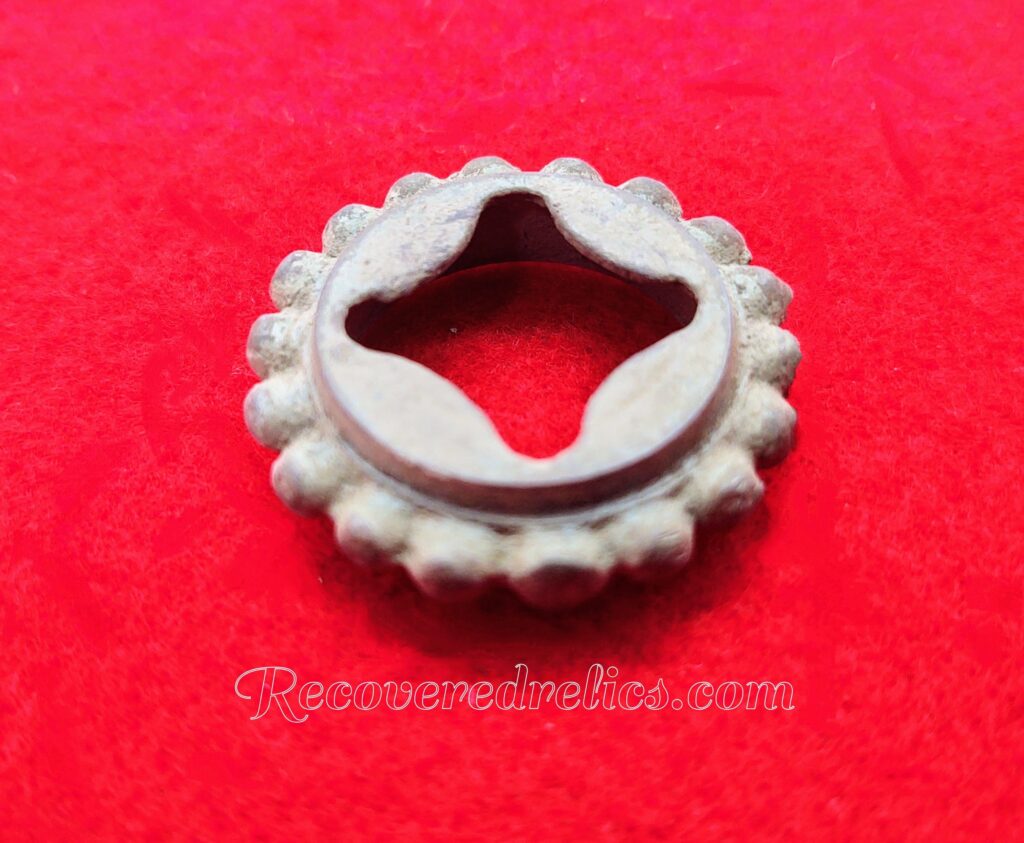
Furniture Caster Ferrules– A Ferrule is a metal ring or cap that is placed around the end of a furniture leg. Ferrules add strength to the legs. Furniture casters are wheels that attach to the leg of a piece of furniture, allowing it to roll. The furniture caster cap pictured was used with a stem style caster. Numerous sets have been found on furniture pieces dating from the 1800’s. These caster caps are often misidentified for ink well cap lids.
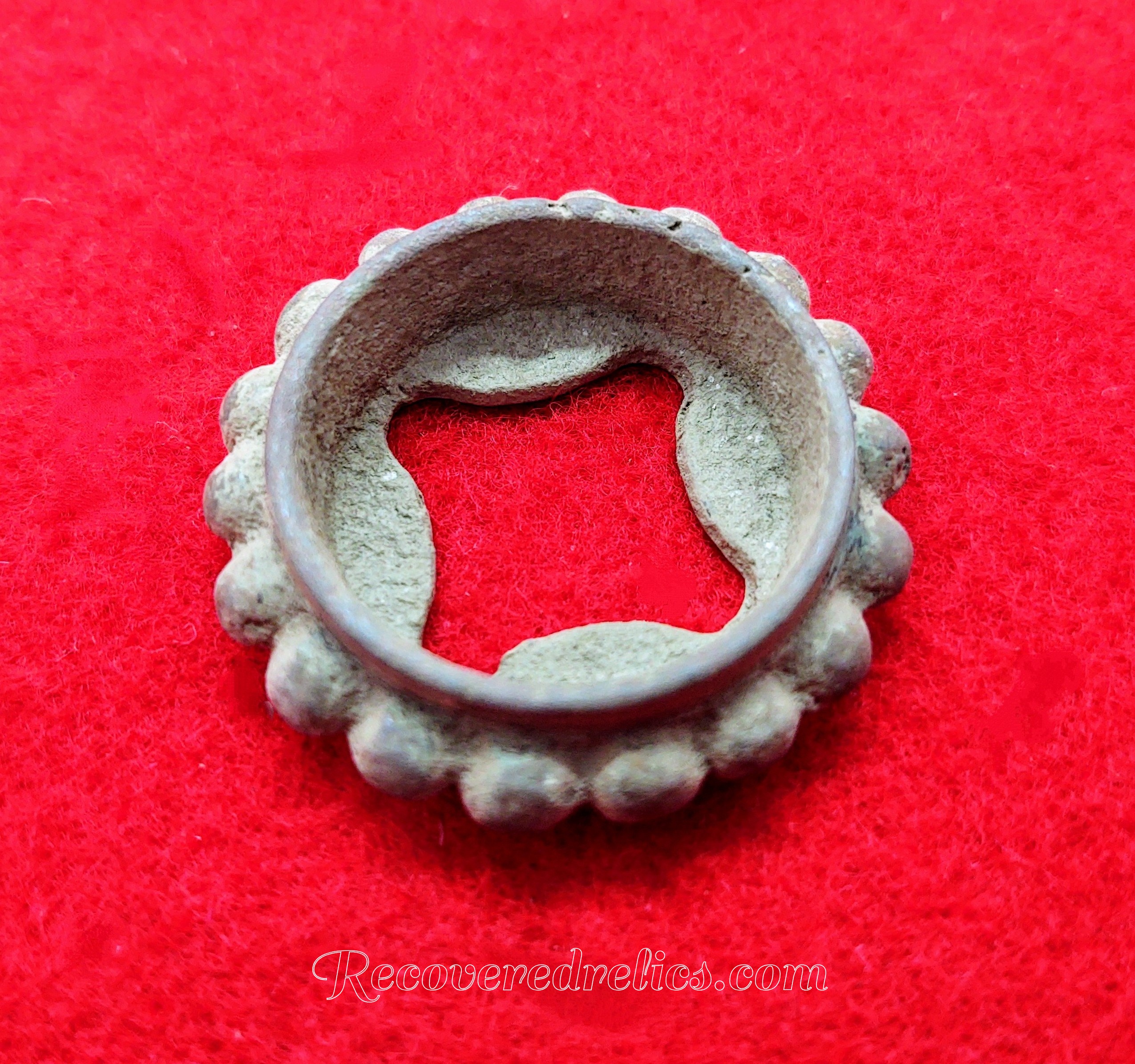
Hames Tops – On both sides of a horse’s collar are wooden or metal bars called hames. Hames are used to help better distribute the load around the horse’s neck and shoulders when they are pulling a wagon or plough. Detectorists sometimes find hames tips or tops.
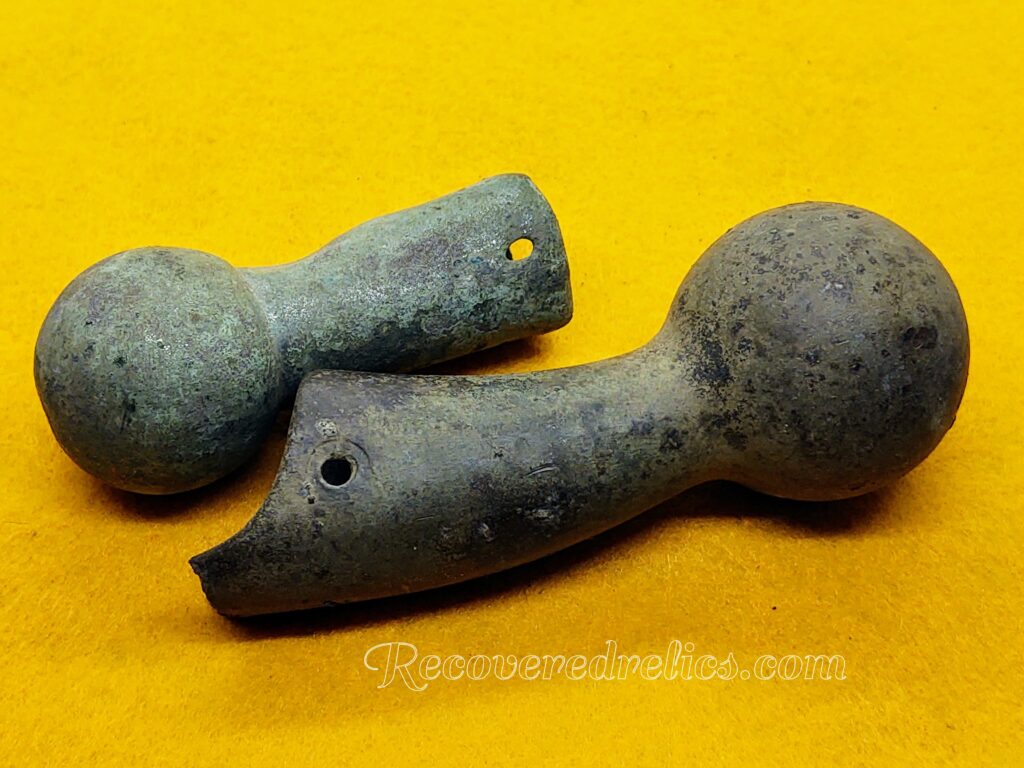
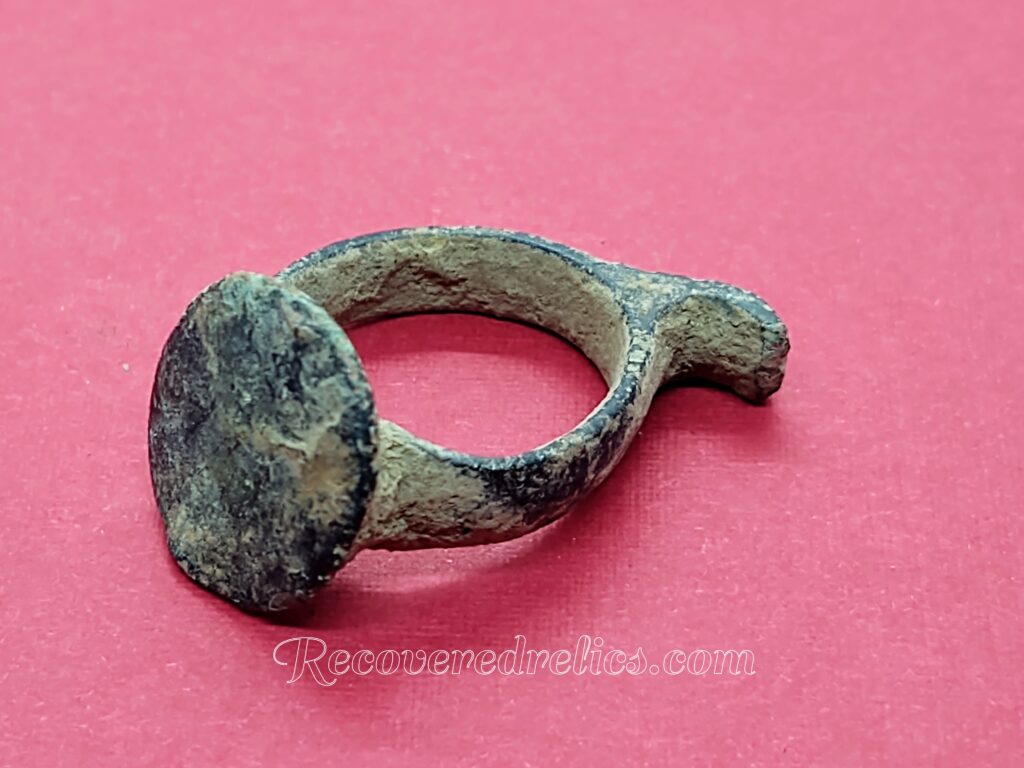
Handle off of a Candle Holder– The piece pictured is the handle off of an old candle holder. We often find broken bits and pieces that aren’t always easy to identify when out metal detecting. The handle most likely was once attached to a chamberstick style candle holder. Chamberstick candle holders are typically short, stubby holders that usually have a dish or tray at the base of the holder and a handle. Chamberstick candle holders were used in the bed chamber at night and were used to keep the room light enough while one got ready for bed. The individual could then carry the candle holder to their bedside and safely blow it out or leave the candle to burn out since only short candles were used with this type of holder.
Heel Plate– A small metal plate that attaches to the heel of a shoe. Its purpose is to help protect the shoe’s heel against excessive wear.
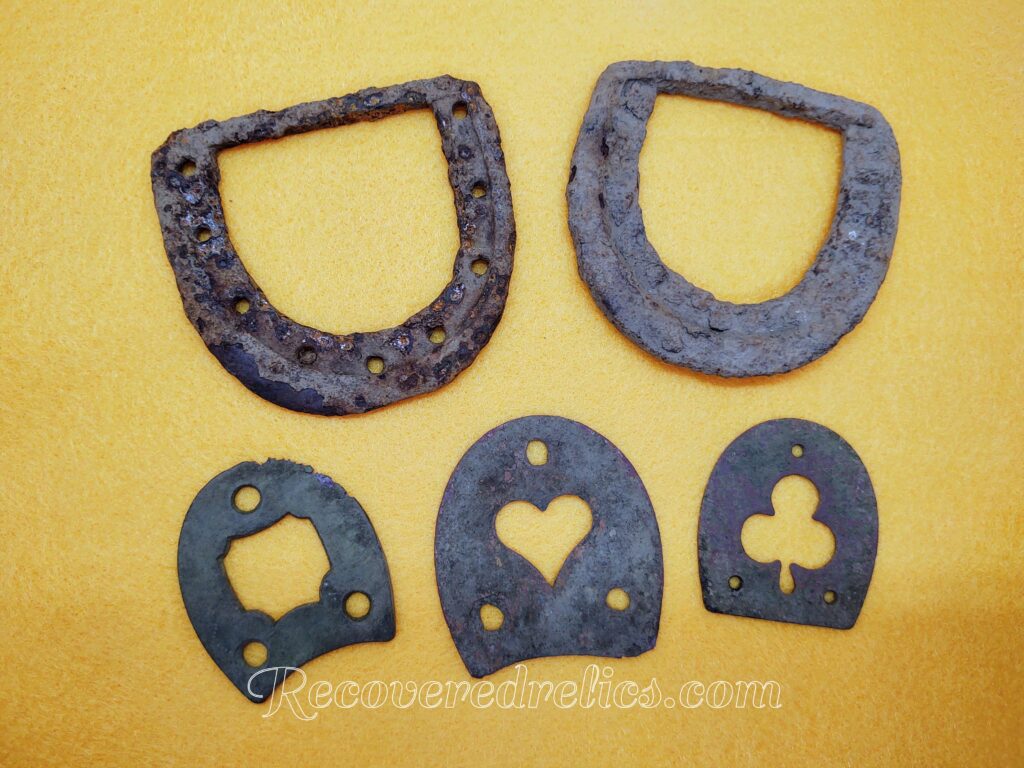
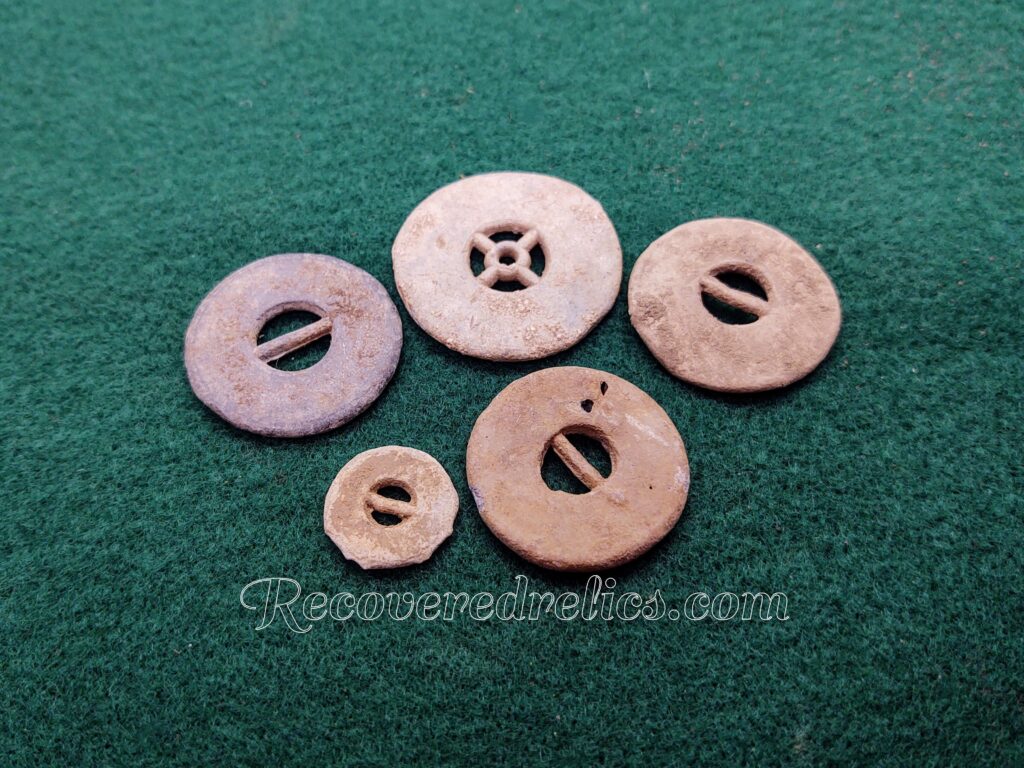
Hem Weight– Metal fabric weights that were sewn into dresses, skirts, pants, shorts, coats, jackets, bathing dresses or swimming gowns, and curtains. They get their name “hem weights” because these weights were generally enclosed or concealed inside the hem where they would go unnoticed. A hem lies at the end of a piece of cloth and can be defined as a fold in the fabric that is sewn into place to prevent the material from fraying or losing it’s shape. Hem weights come in various sizes and shapes.
Hinge– A moveable joint or flexible mechanism that holds two parts together so that one part can swing and move relative to the other.
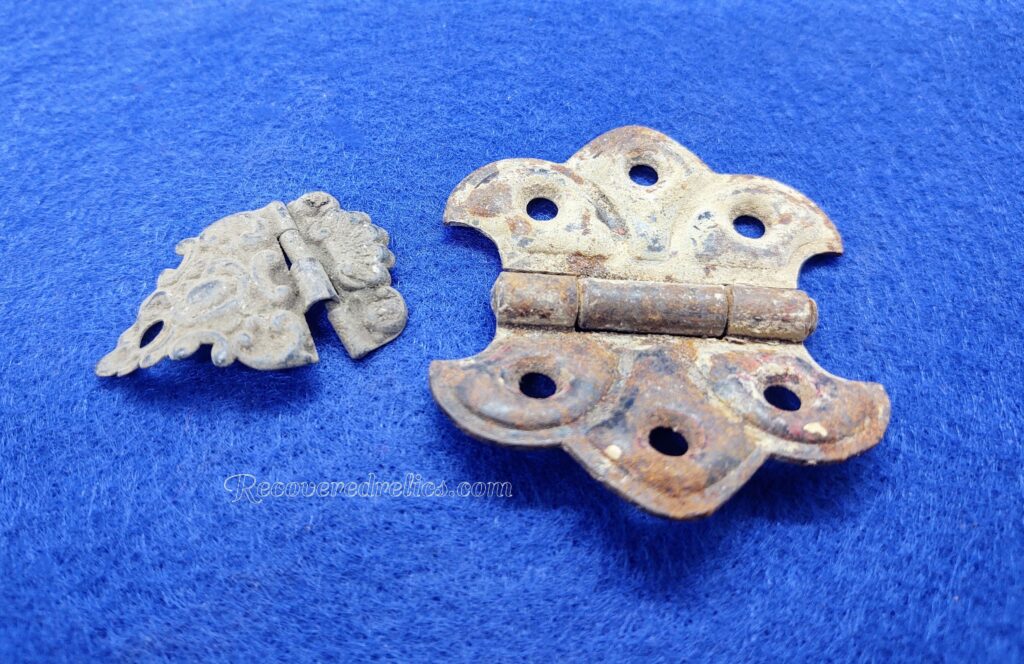
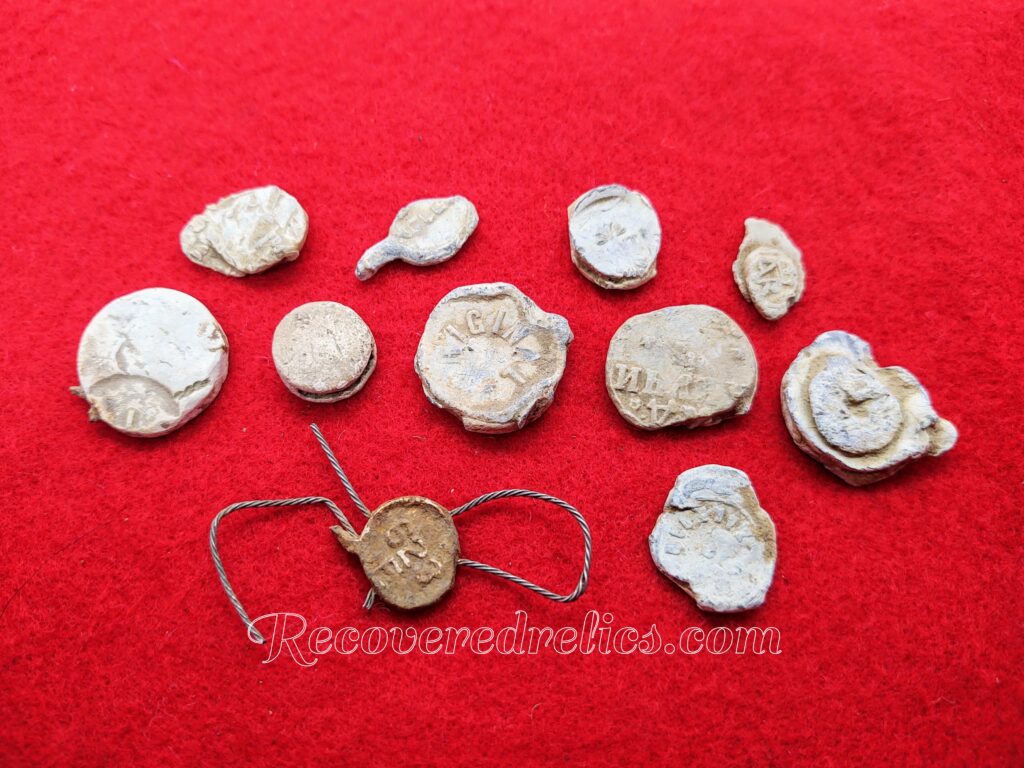
Lead Seals-Lead seals are small leaden discs that were crimped onto bags or bales of goods. They were commonly attached to textiles. Lead seals are alternately called bag seals, bale seals, or cloth seals depending on the item they marked. Lead seals were widely used in Europe between the 13th and 19th centuries. The lead seals we find in the United States typically date from the 18th to 19th centuries. Some may be more modern and others older in age.
Oil Lamp Burners– An oil lamp is a lamp used to produce light continuously for a period of time using an oil-based fuel source. Oil lamp burners are situated at the top of the reservoir where the oil is stored and hold the wick in place. They control the flow of oil to the wick and help to regulate the flame’s size and intensity.
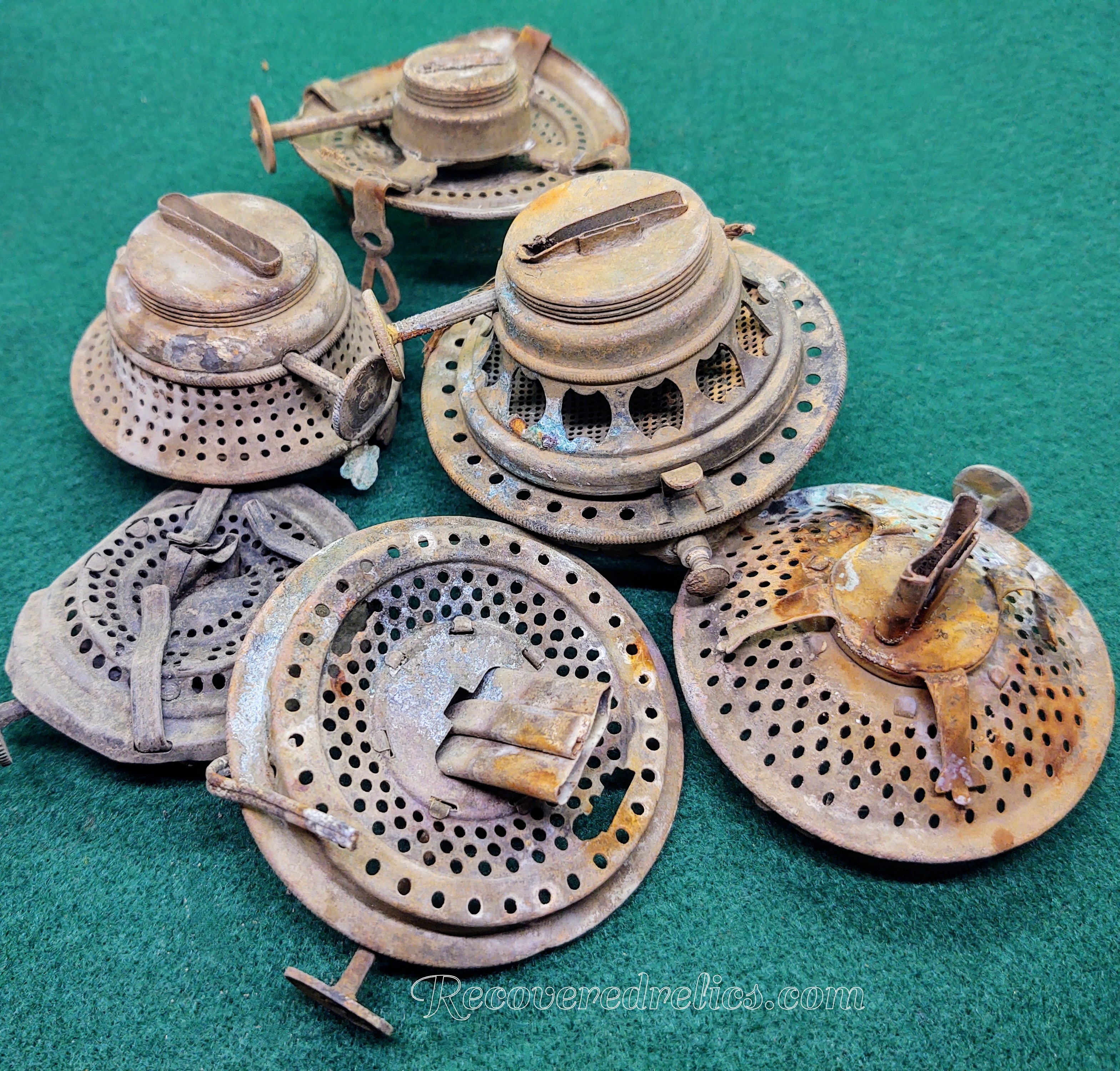
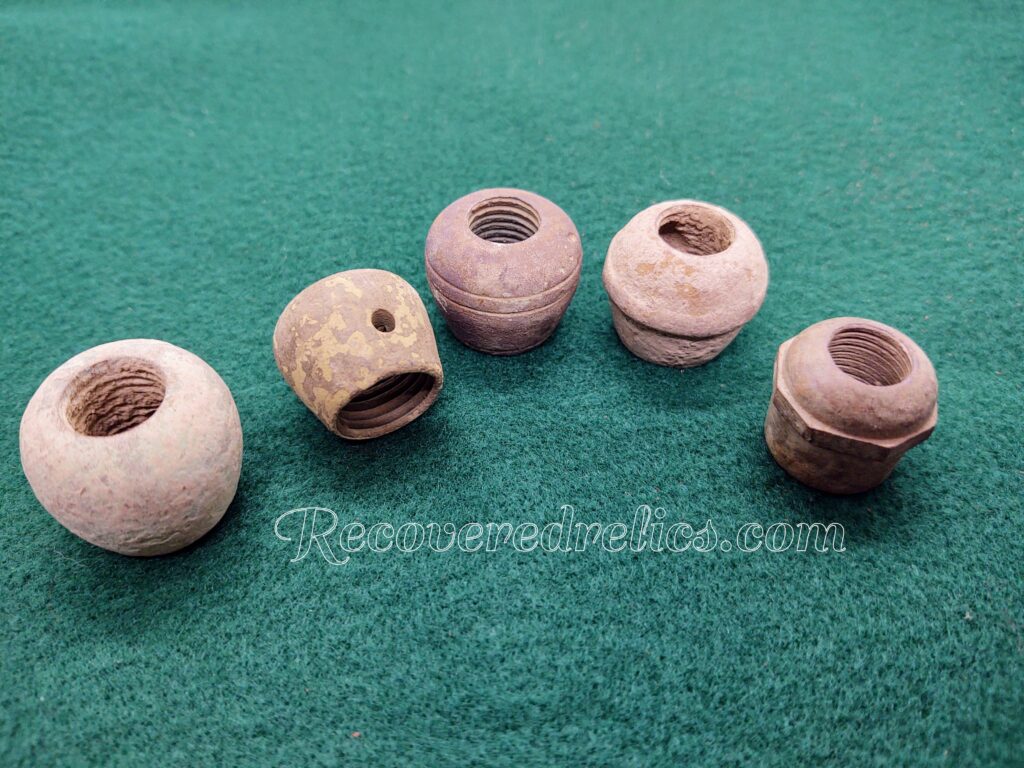
Ox Knobs-Ox knobs are fitted to the tips of a ox’s horns. They are a decorative and useful device used to keep the oxen from instinctively, sharpening their horns. In some parts of the country they are referred to as horn buttons or horn balls.
Ox Shoe– a shoe for an ox often consisting of two pieces one for each side of the hoof.
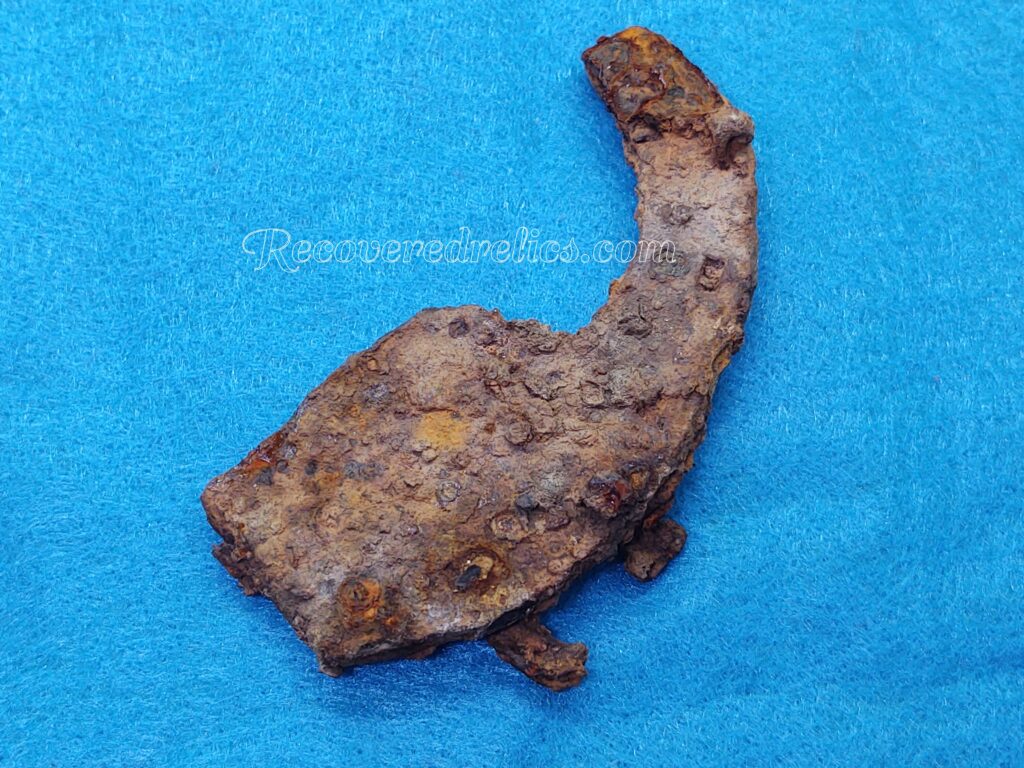

Purse Frames– Metal purse frames are used on a distinctive type of purses. Frames provide the external structure for the bag and allow it to support the weight of its contents. They come in various shapes and sizes.
Rat Tail Spoon– This type of spoon was developed in the late 17th century. It has a thin pointed tongue on the bottom of the spoon bowl (back side) which helps to reinforce the joint of bowl and handle.
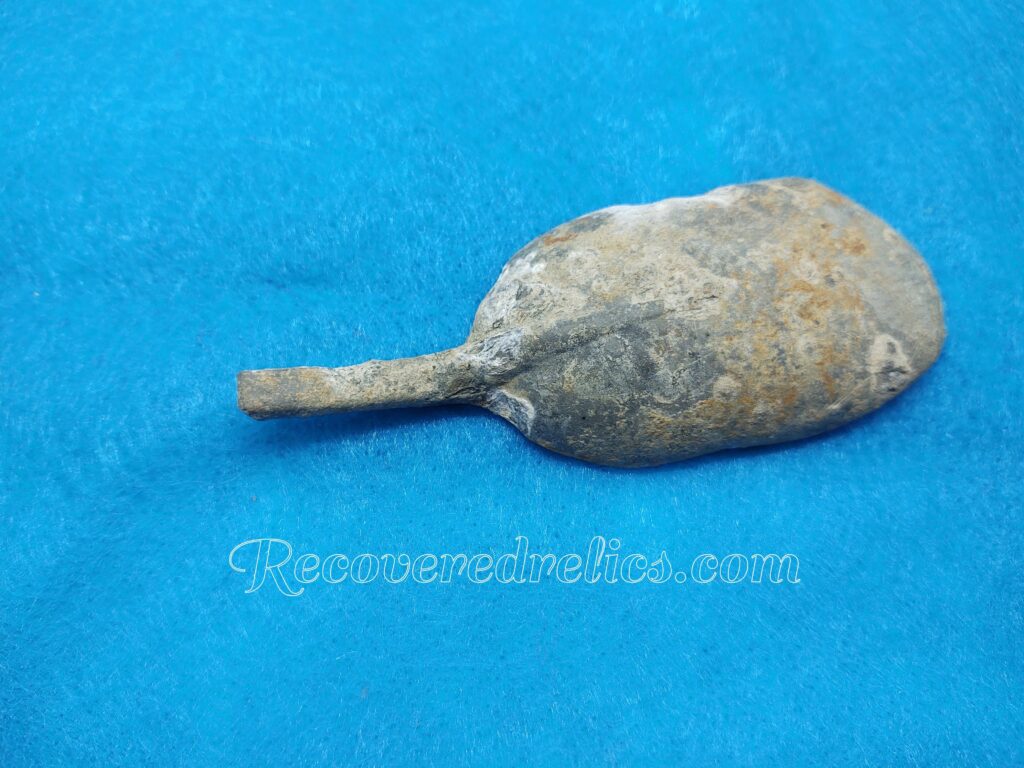
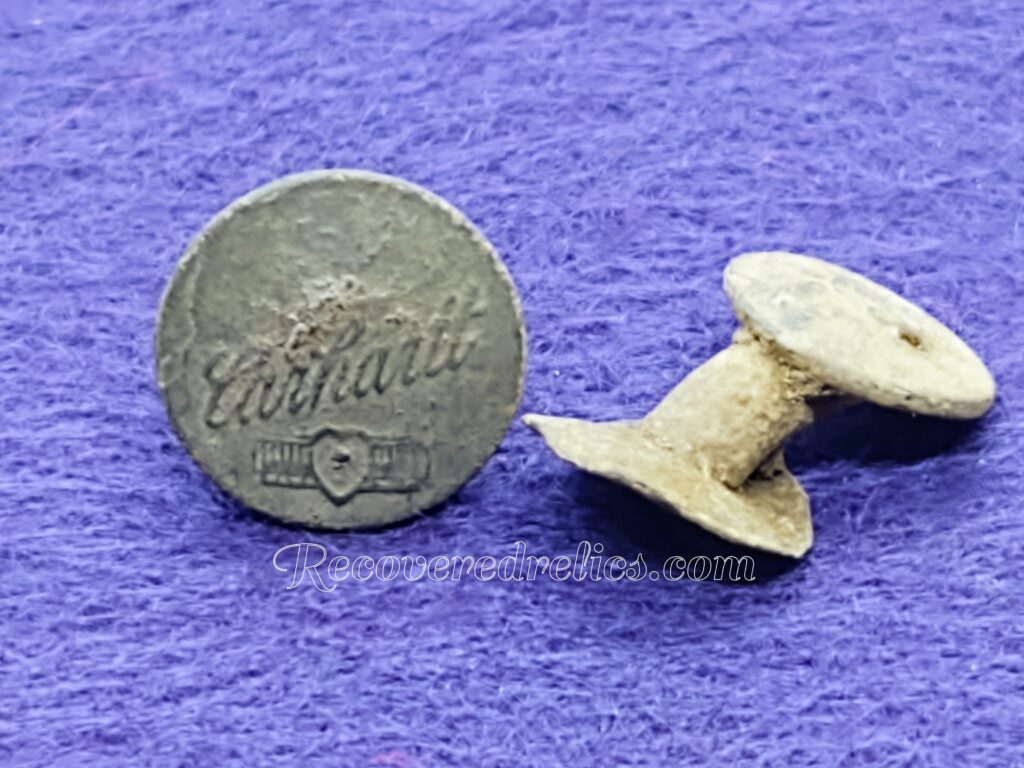
Rivet– A metal fastener consisting of a smooth cylindrical shaft with heads on either end. Rivet are used to join two or more materials together permanently. There are many different types of rivets. Metal rivets are used to fasten together a variety of different types of materials such as wood, metal, plastic, and cloth. The rivets pictured were used to fasten cloth and or leather.
Salt and Pepper Shaker Caps
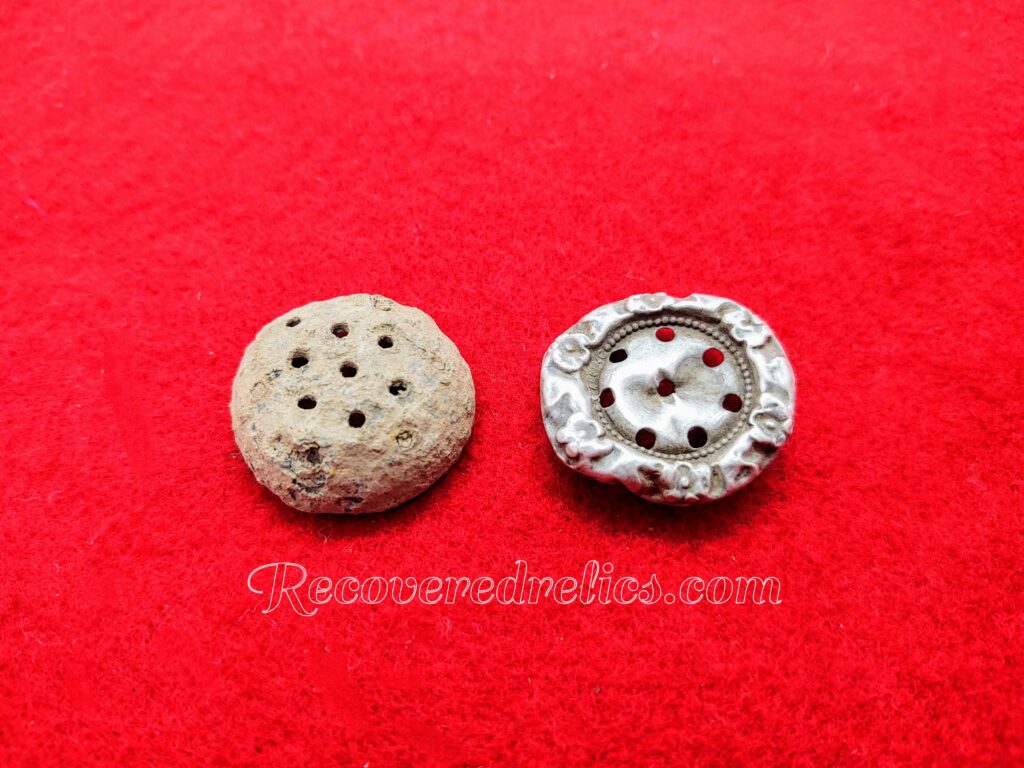

Scythe Nib Block – A scythe is a powerful and versatile tool used for mowing and removal of unwanted grass or weeds. The handle on the scythe is referred to as a snath. The side handles of the snath are called nibs. Nib blocks are metal plates through which the nib bands are drawn when tightened.
Skeleton Keys– Skeleton keys have been around for centuries and have been used for a variety of different purposes. Skeleton keys typically have a cylindrical shaft and a single, minimal flat, rectangular tooth or bit. The series of notches and grooves on the key match the internal workings of a particular lock, allowing the key to open that lock. Skeleton keys are designed to work with warded locks, a type of lock that uses a set of obstructions, or wards, to prevent the lock from opening unless the correct key is inserted. Warded locks and keys provide minimal security.
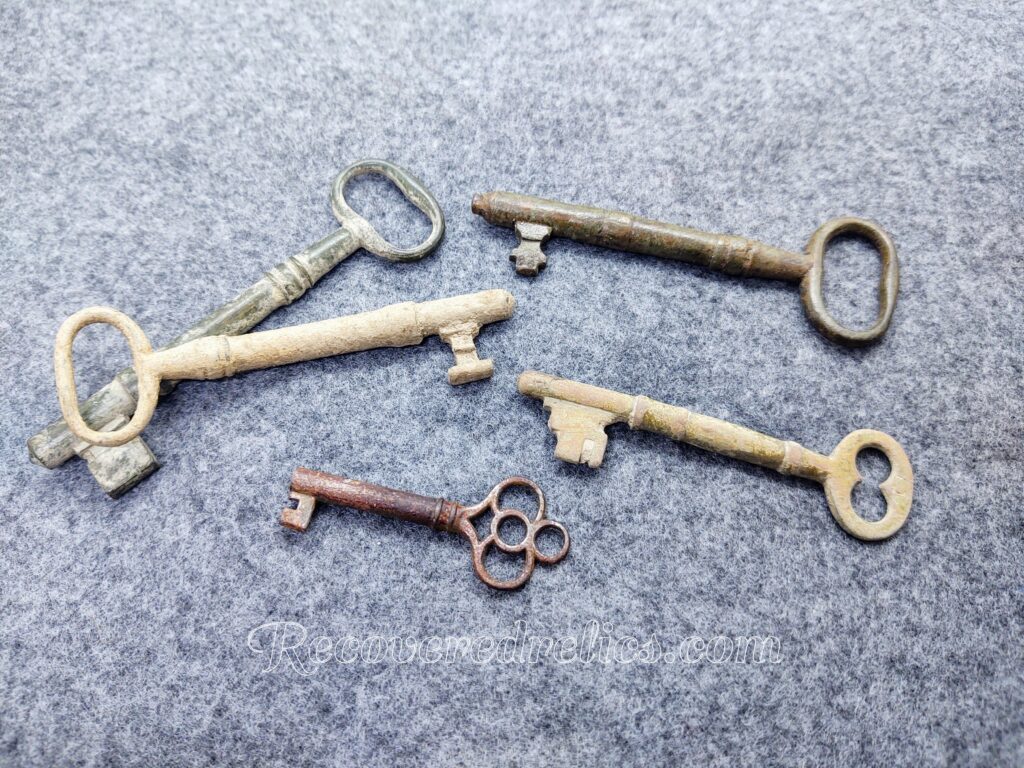
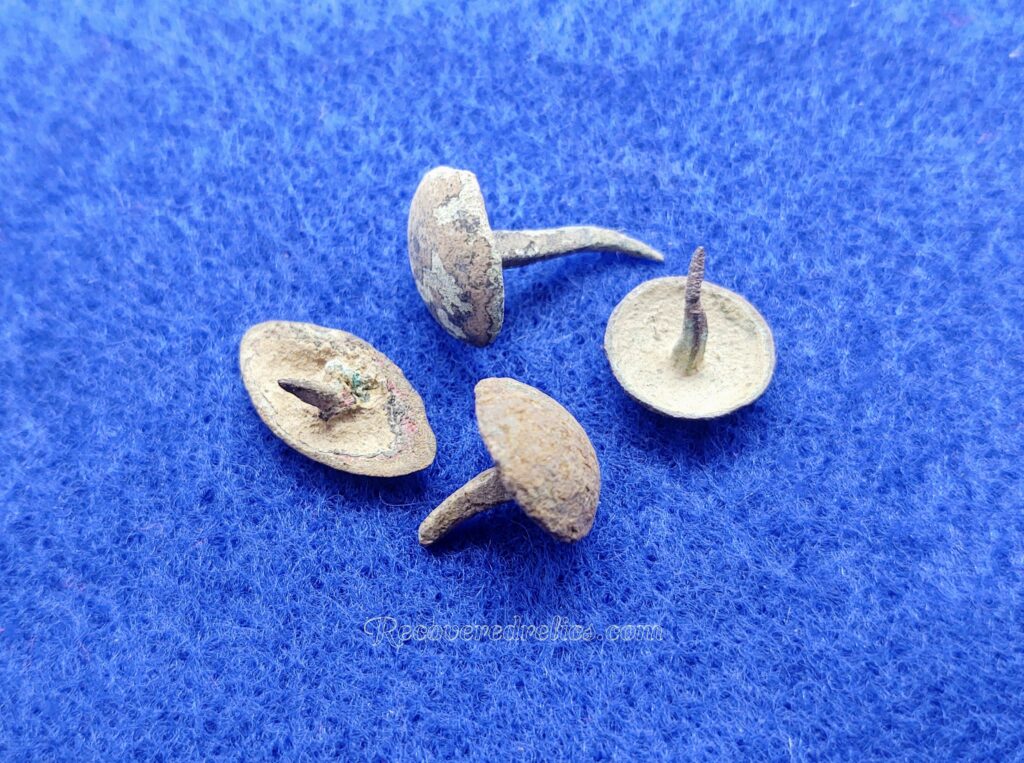
Tacks– Metal tacks are small, decorative nails used to fasten upholstery. Tacks were used to decorate furniture, leather work, and coffin lids.
Toe Tap– A toe tap is a metal plate which is added to the bottom or soles of shoes. This sole modification is used to help prevent wear and tear of the toe portions on the soles of shoes.
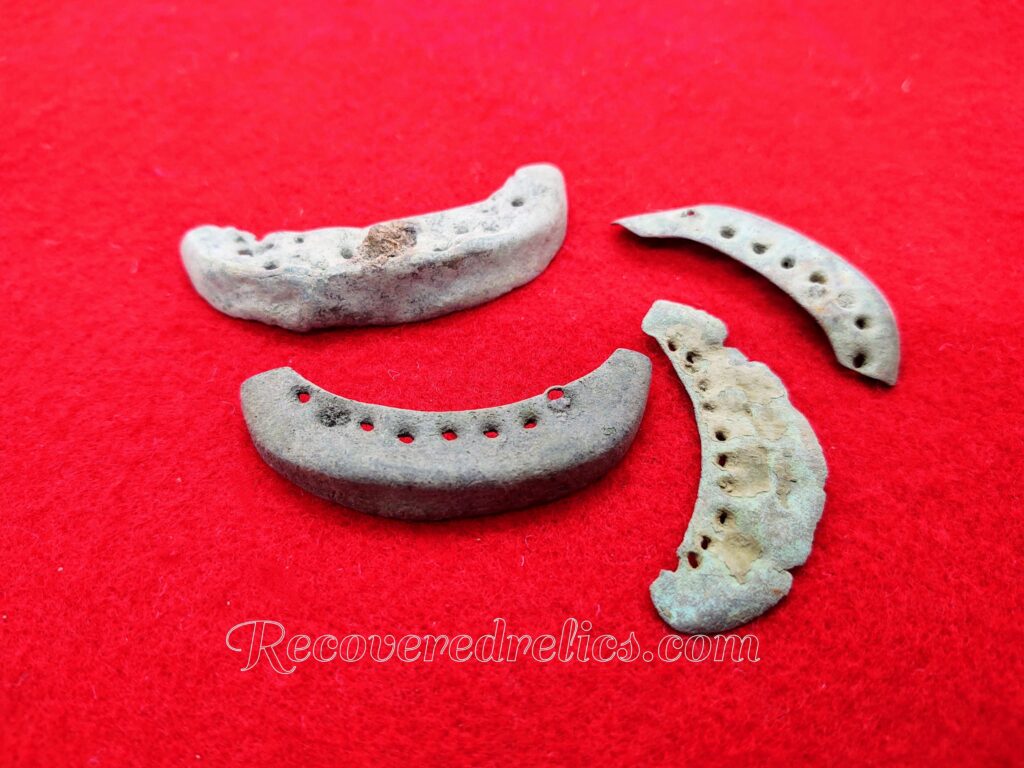
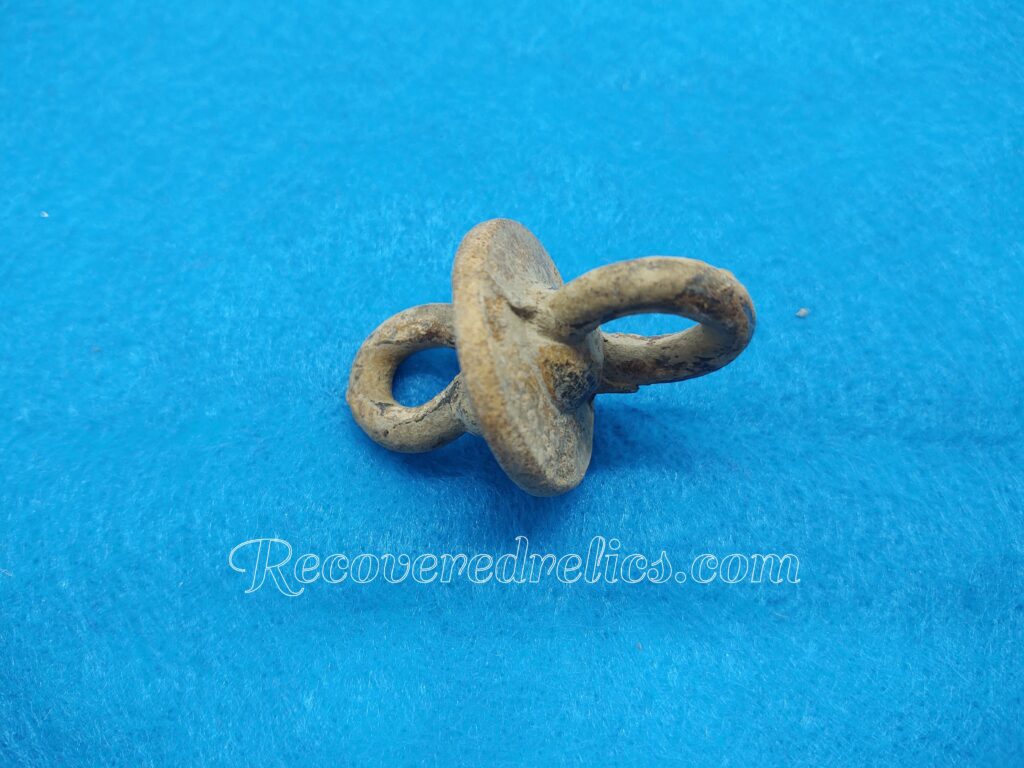
Well Pump Chain Link– The link was a part of a continuous chain. The chain would have run through a tube, slightly bigger than the diameter of the discs on the links. As the chain is drawn up the tube, water becomes trapped between the discs and is lifted up to and discharged at the top of the pump.
Horse Tack and Adornment
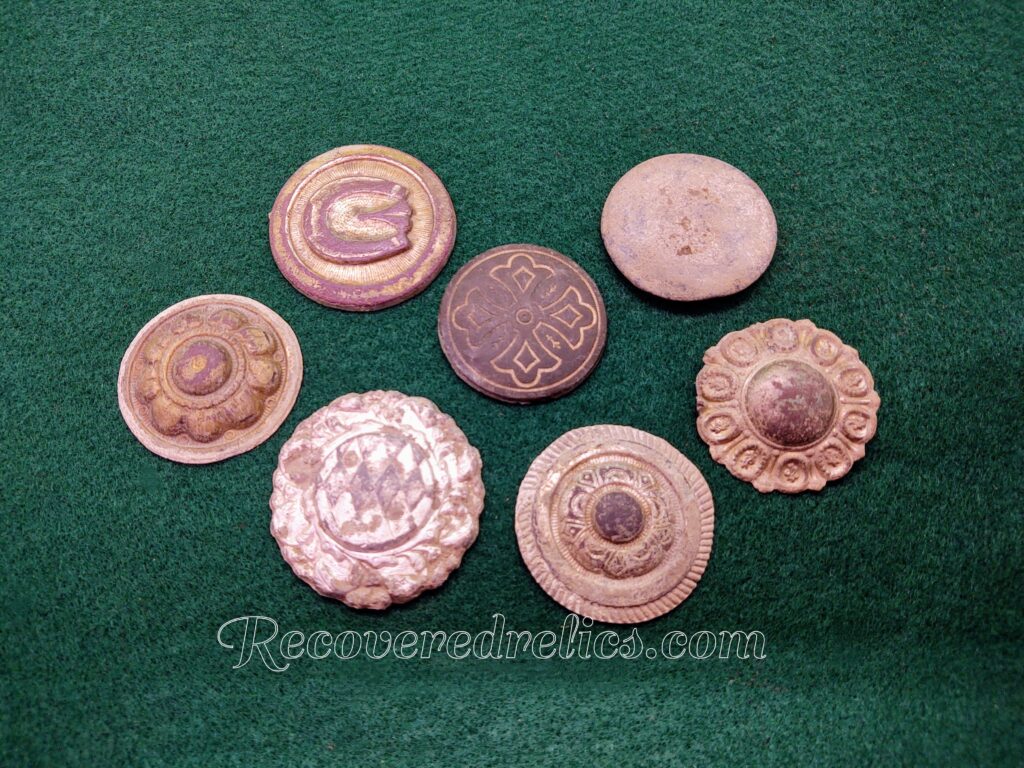
Bridle Rosette– These pieces have two primary functions. They were used as decoration and helped to stabilize the headstall portion of the bridle. The metal loop on the back slips over the end of the browband and divides the space between cheek piece and throat latch. Bridle rosettes add beauty and color to the bridle. They often have ornate designs and patterns.
Gag Loop Swivels (horse tack)
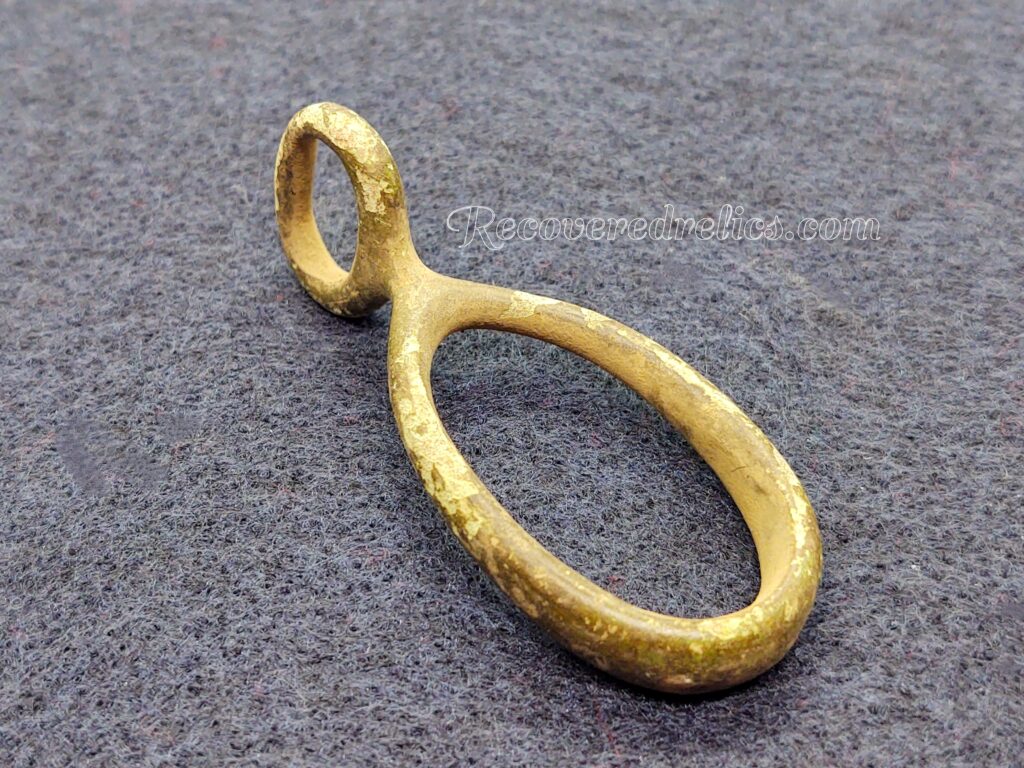
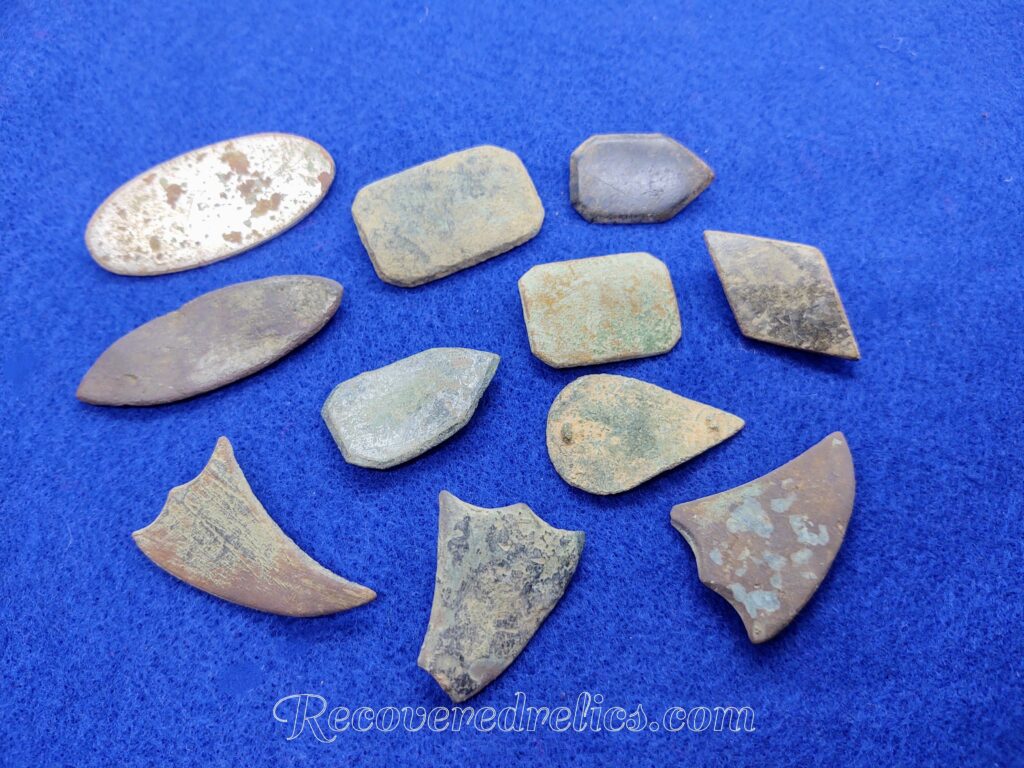
Leather Ornaments– A term used to describe a broad range of metal attachments which sole purpose was for decoration. It is generally accepted that these decorative adornments were for horses, however some may have been used for personal items. They commonly appeared on leather straps, saddles, and other personal items such as pouches, belts, and sword hangers. The back of each piece has two or more tines that were designed to pierce and fold around the leather.
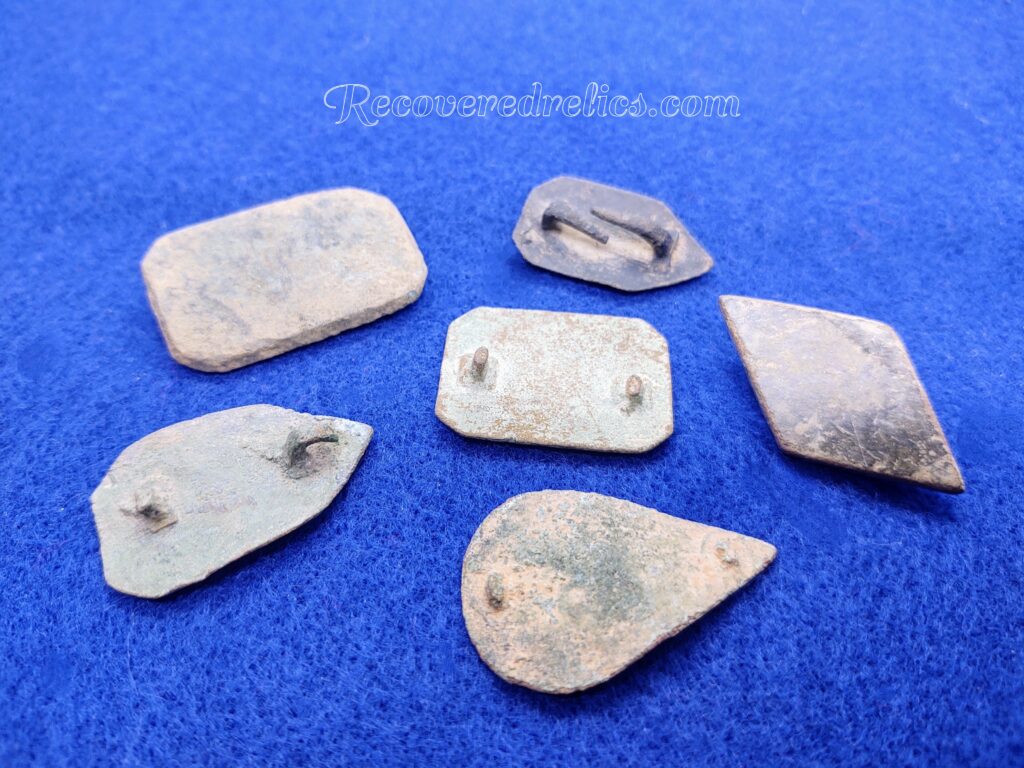
Strap Guides – Strap guides are generally circular in shape with two linear protrusions on their back side. The protrusions on the back which would have had iron fasteners were attached to an oval shaped backplate. The gap between the front piece and backplate allowed for the strap to pass through freely. There were also a narrow rectangular or oblong like version. Strap guides are generally decorated with designs. Plain ones were also common.
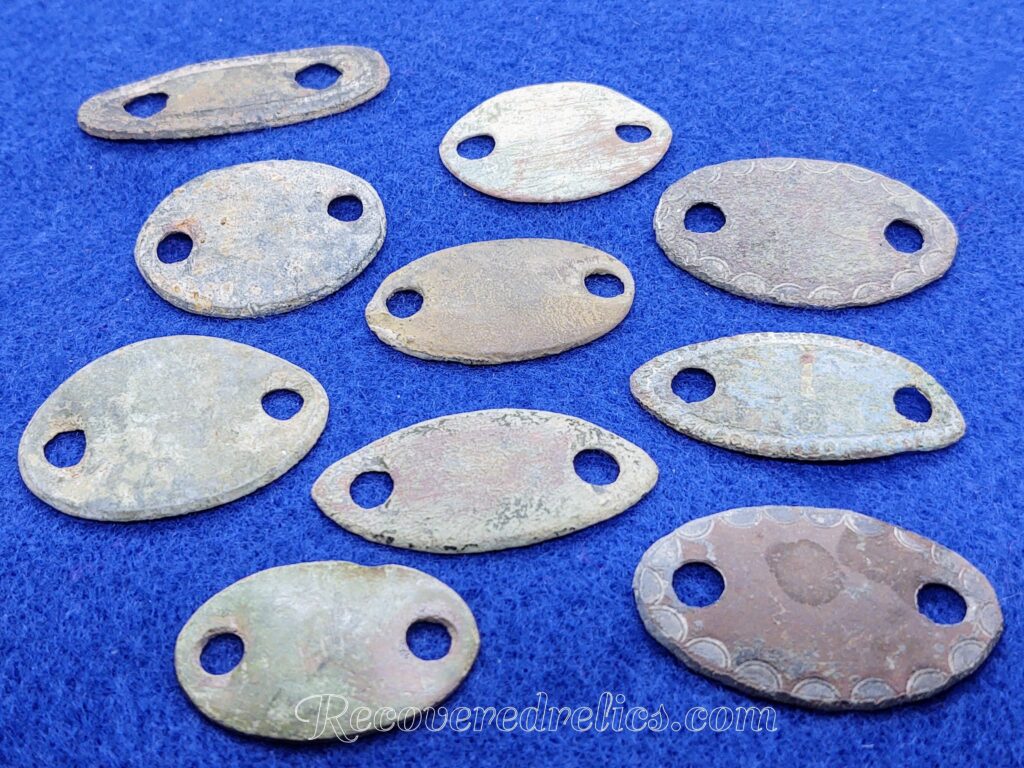
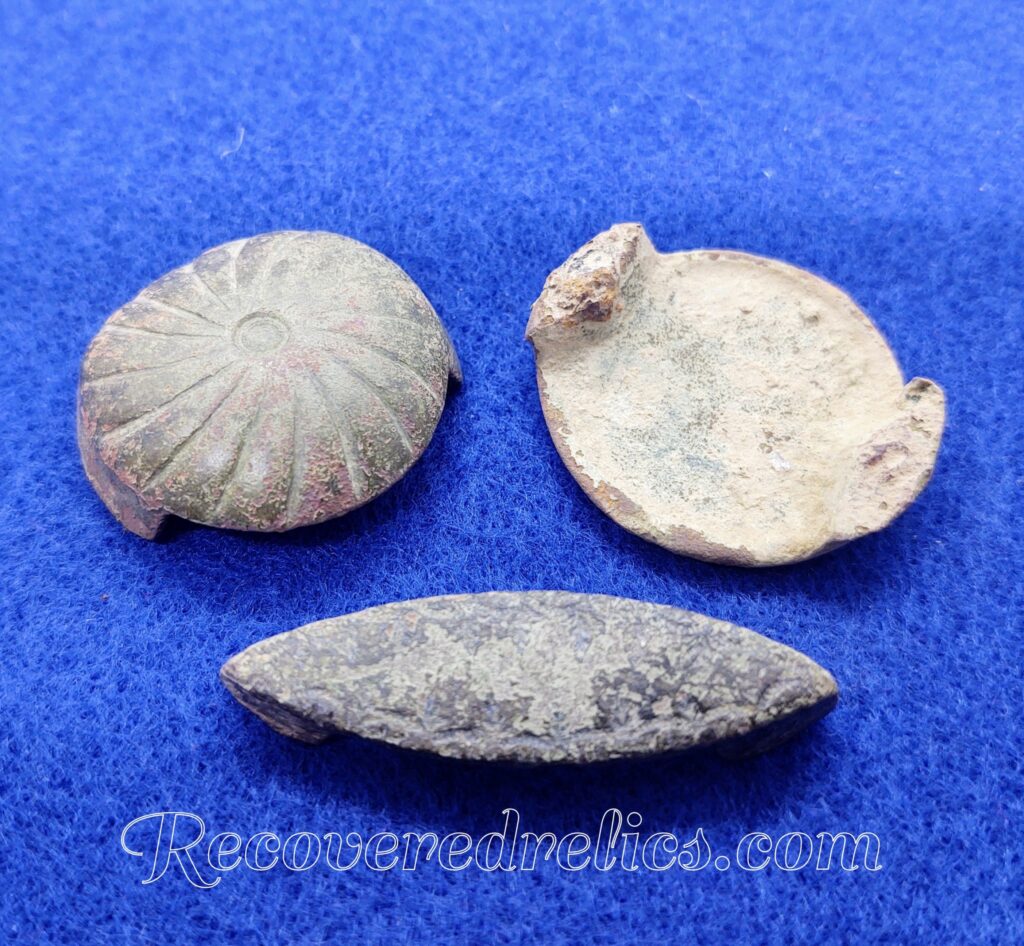
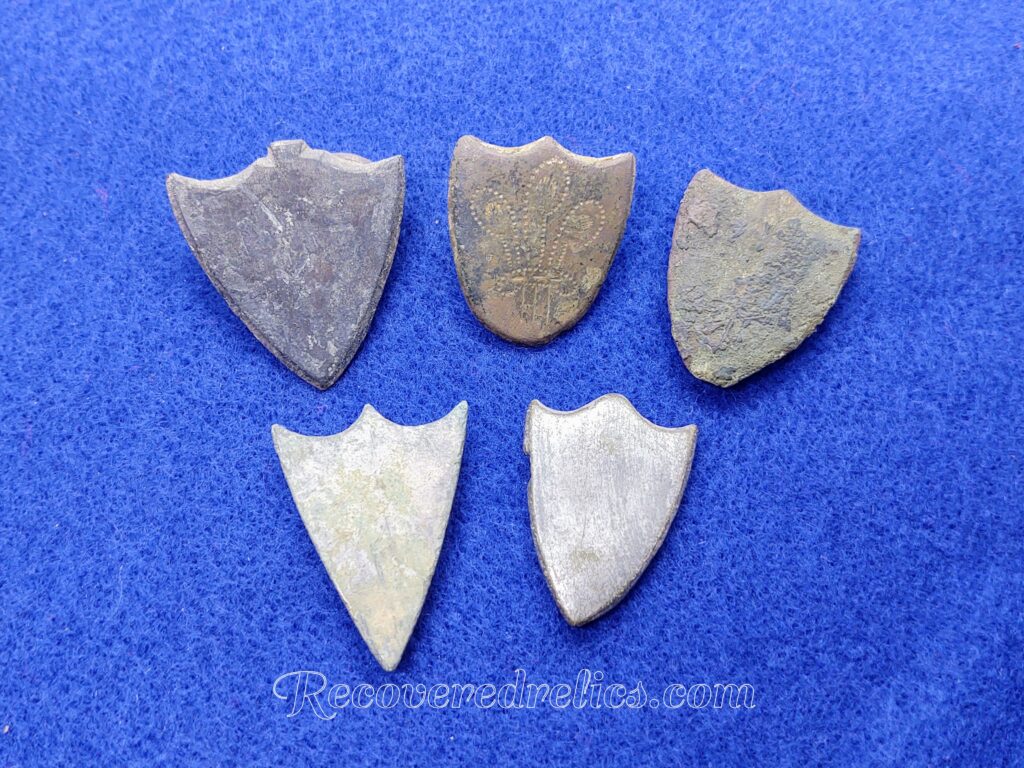
Shield Shaped Equestrian Ornaments– These shield shaped mounts were probably for use on horse harnesses, most likely on the blinkers, bridle, or saddle. They are commonly referred to as saddle shields by detectorists. Decorations or ornaments used on horses were popular in the 1700’s and 1800’s and were utilized to show wealth, status, and personality.
Saddle Horn– The saddle horn is a key part of a Western saddle. It extends from the saddle’s pommel. Originally made for cattle roping, the saddle horn lets a cowboy wrap or tie a rope around it when dallying cattle.
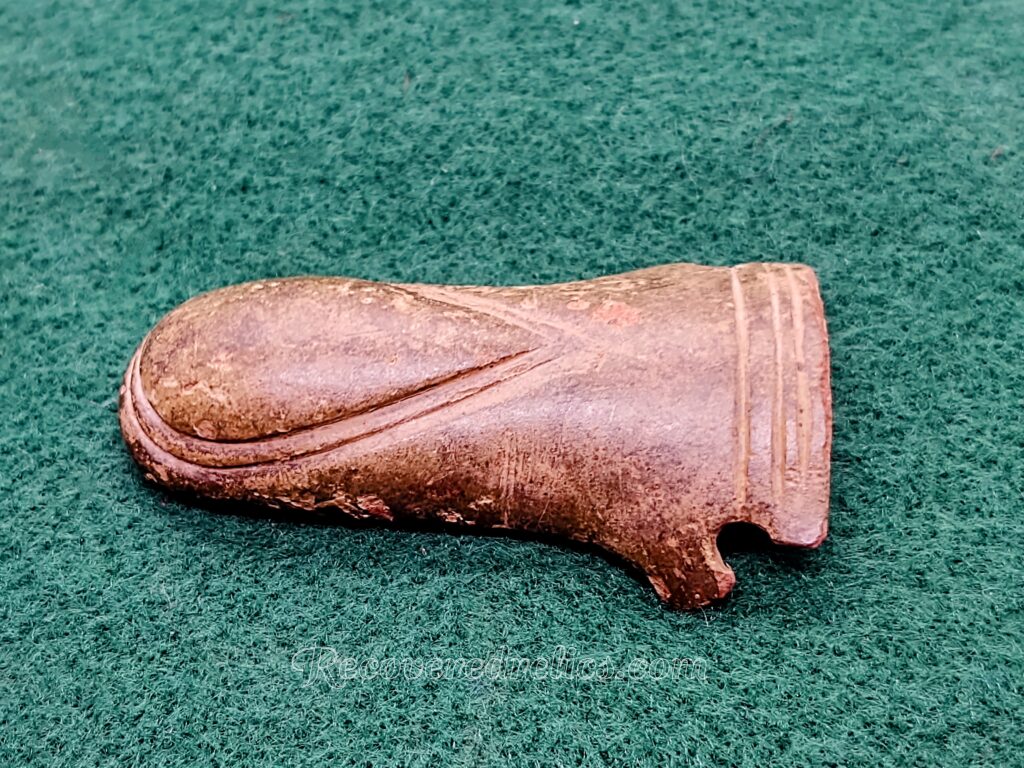
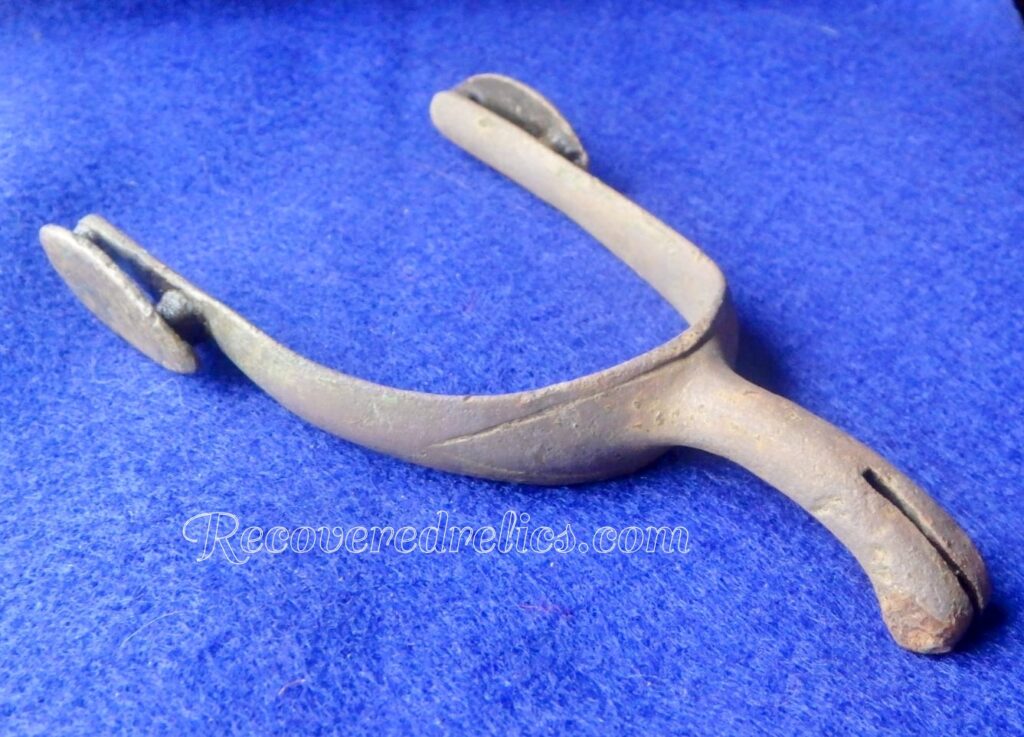
Spur– A device with a small spike or spiked wheel that is worn on a rider’s heel of their boots for the purpose of directing a horse to move forward while riding.
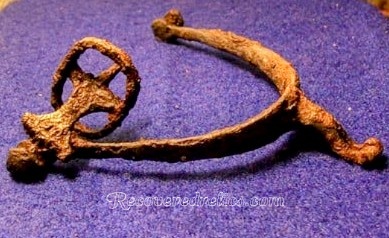
Stirrups -Stirrups are attached with a strap to each side of the horses saddle. They are a frame that both holds and supports the riders foot. They are also used to aid in mounting.
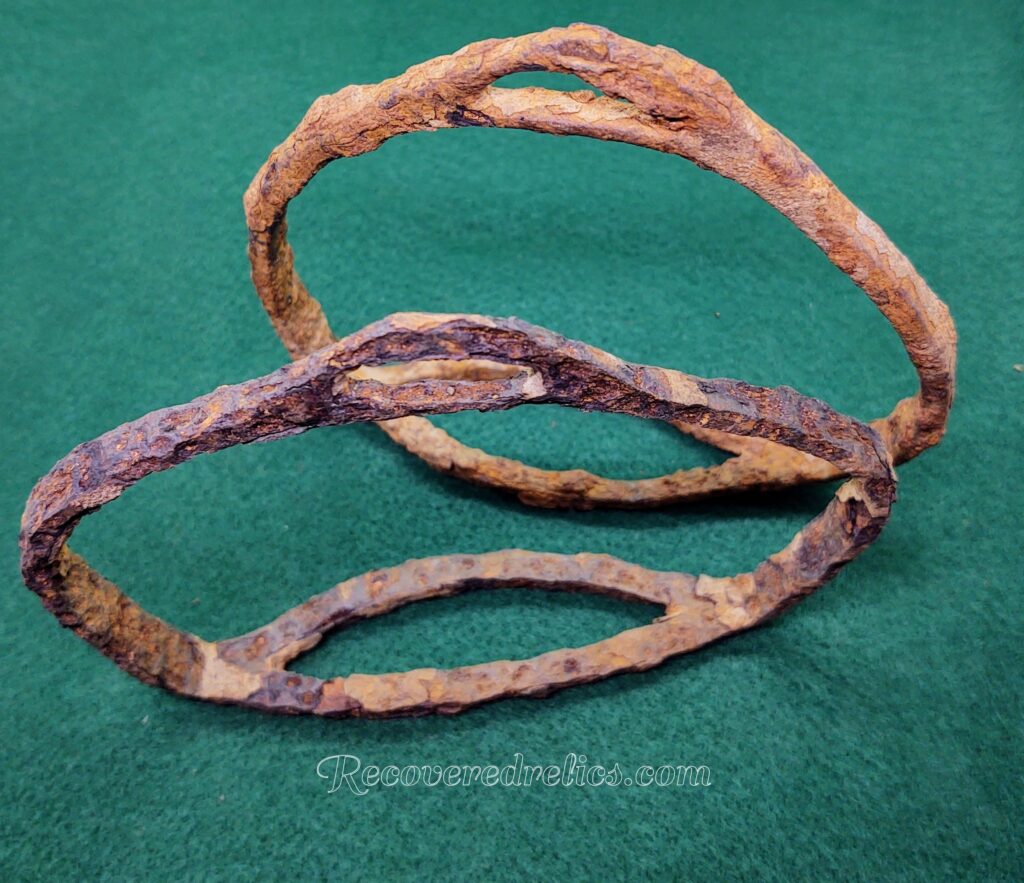

Terret or Rein Ring– A terret or rein ring is a metal loop that is attached onto a horse harness. The reins pass through the terret. The terret helps to prevent the reins from tangling or getting snagged on the harness or shafts.
Miscellaneous Personal Adornment and Personal Items
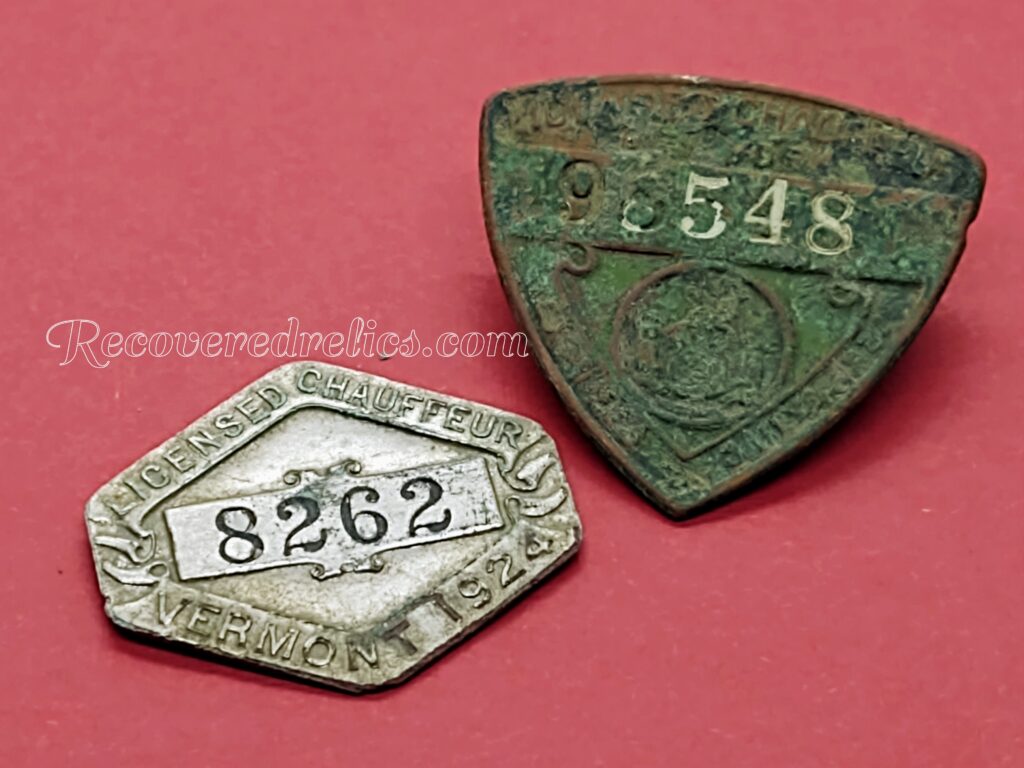
Chauffeur Badges/Licenses– During the early 1900’s states began to require that chauffeurs obtain a valid annual license. States issued metal chauffeur badges to drivers. These badges typically indicate the date of issue, state of registration, and the drivers issued license number.
Condom Tins-Condoms were sold in small metal containers or tins in the early 1900’s . During the 1920s and 1930s, the Merry Widows brand was so popular that the term “Merry Widow” became slang for a condom.


Fobs– An adornment that hangs from a short strap, ribbon, or chain (fob chain). The fob chain attached usually with an adornment of some sort (medallion, ornament etc.) were commonly attached to a pocket watch and were often worn hanging from one’s pocket. The little front pockets sewn in pants just below the waistline are also defined as fobs. An item carried on a key ring or piece of material which fastens a key or a group of keys together is also referred to as a fob.
Letter Opener-a knife for opening envelopes that is not sharp and is often decorative.
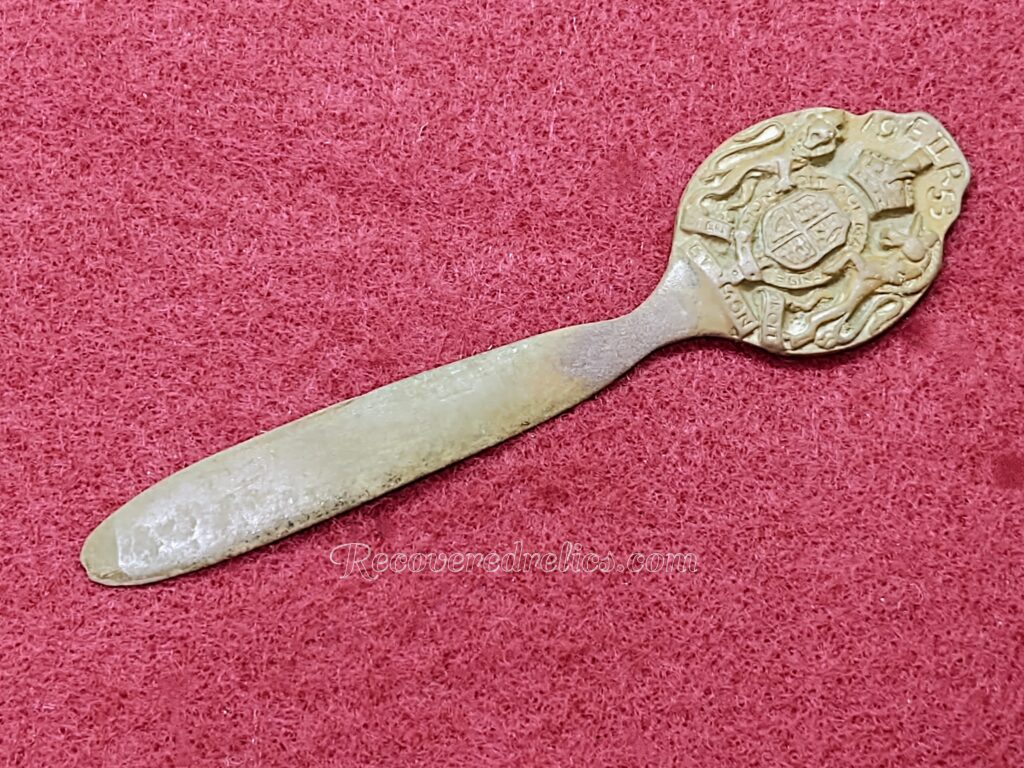
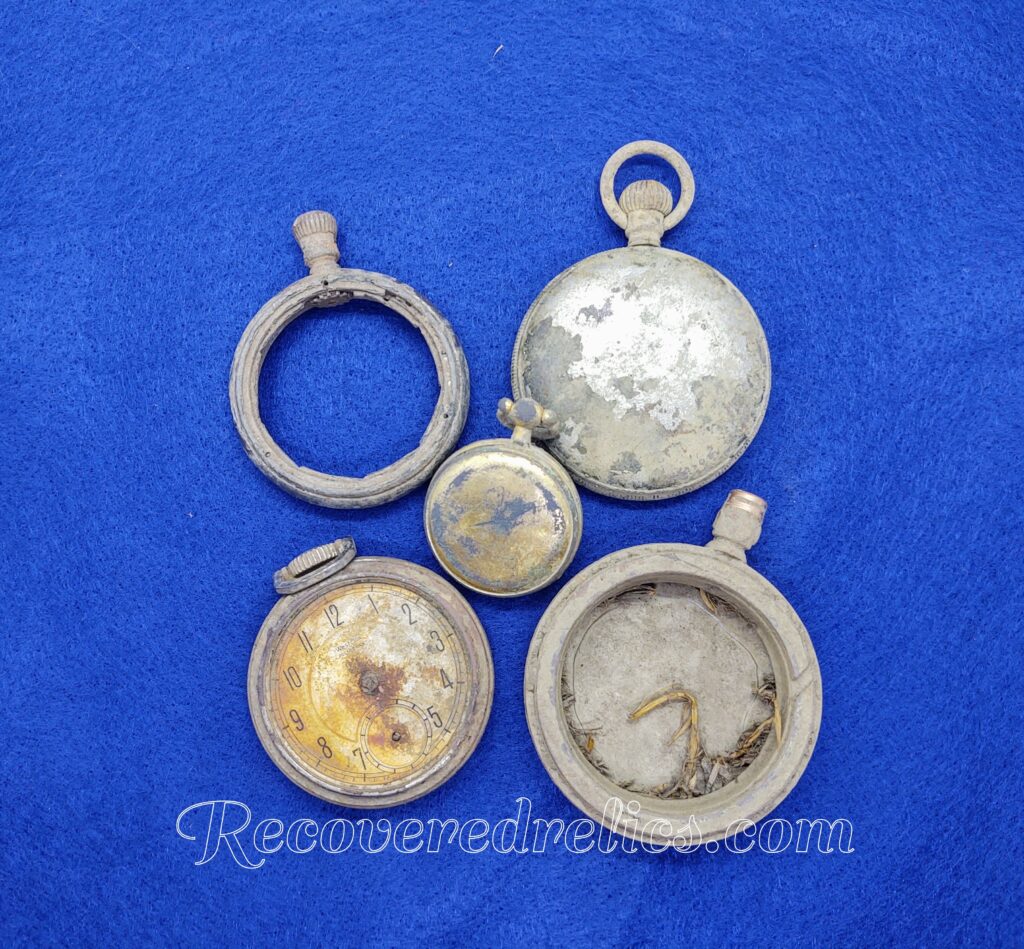
Pocket Watches– A pocket watch is a manual winding timepiece that traditionally was attached to a chain and was intended to be carried in the pocket of a man’s jacket or vest. Pocket watches were the most common type of watch from their development in the early 16th century until wristwatches became popular after World War I. Special pockets were made in jackets and vests in order to accommodate the timepiece.
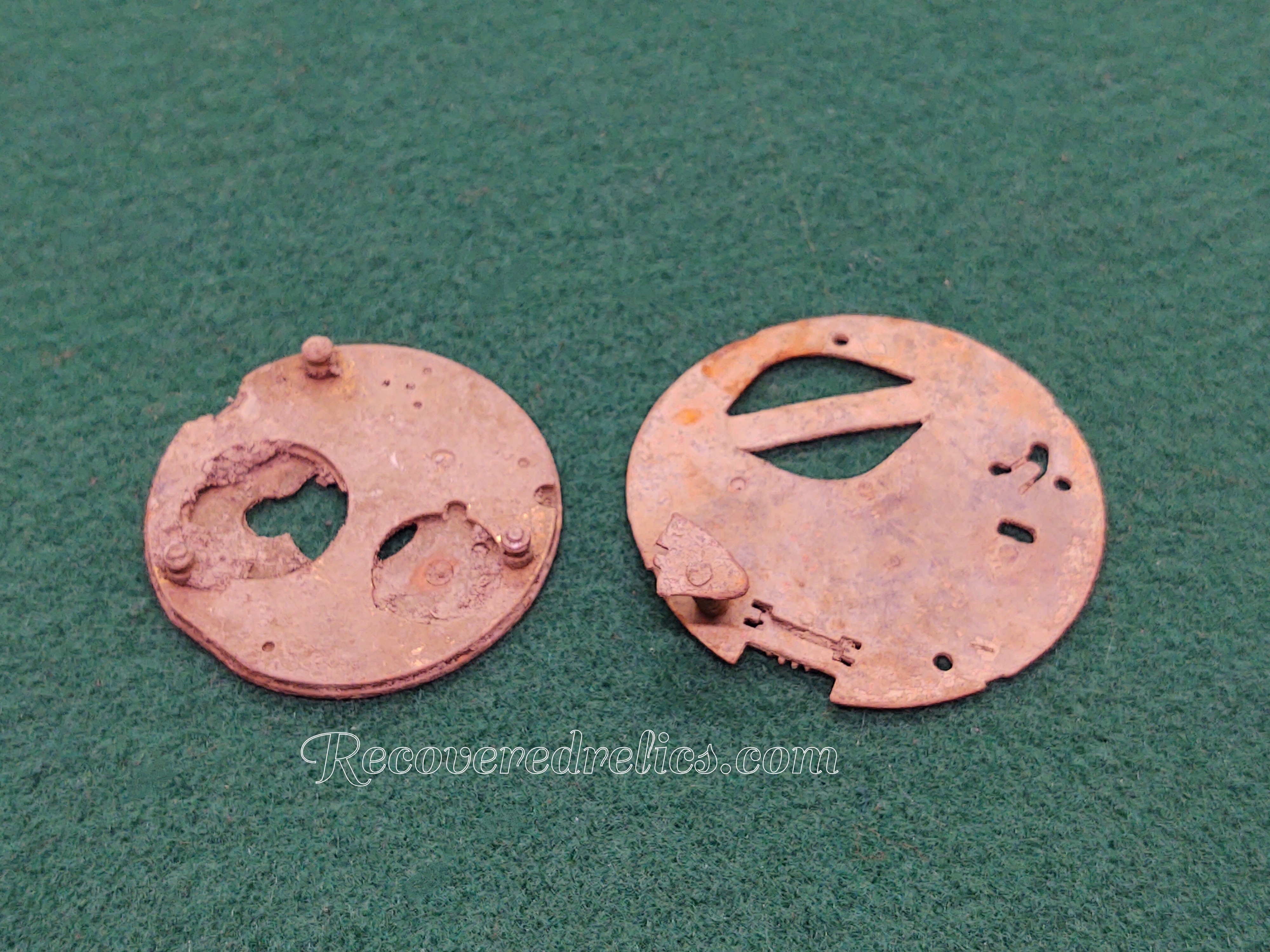
Revolutionary War Era Lead Pencil– There have been a few different types and varieties of Revolutionary War era lead pencils that been discovered and excavated from various sites. The first type is made from scrap lead and the second type is hammered out of musket balls. Type one has 3 different known varieties listed. Variety A has a round cross
section. Most lead pencils of this style seem to have a flat tip at one end and are blunt on the other end. Variety B has a rectangular to square cross section. This style generally has blunt or pointed tips on one end. Variety C has a thin rectangular cross section. The second type, musket ball pencils, generally are hammered to a blunt point on one end and retain the musket ball shape at the other end. Some lead pencils that have been found are twisted, probably for extra strength and some have also been discovered to have drilled holes on one end, like the one pictured, for suspension.
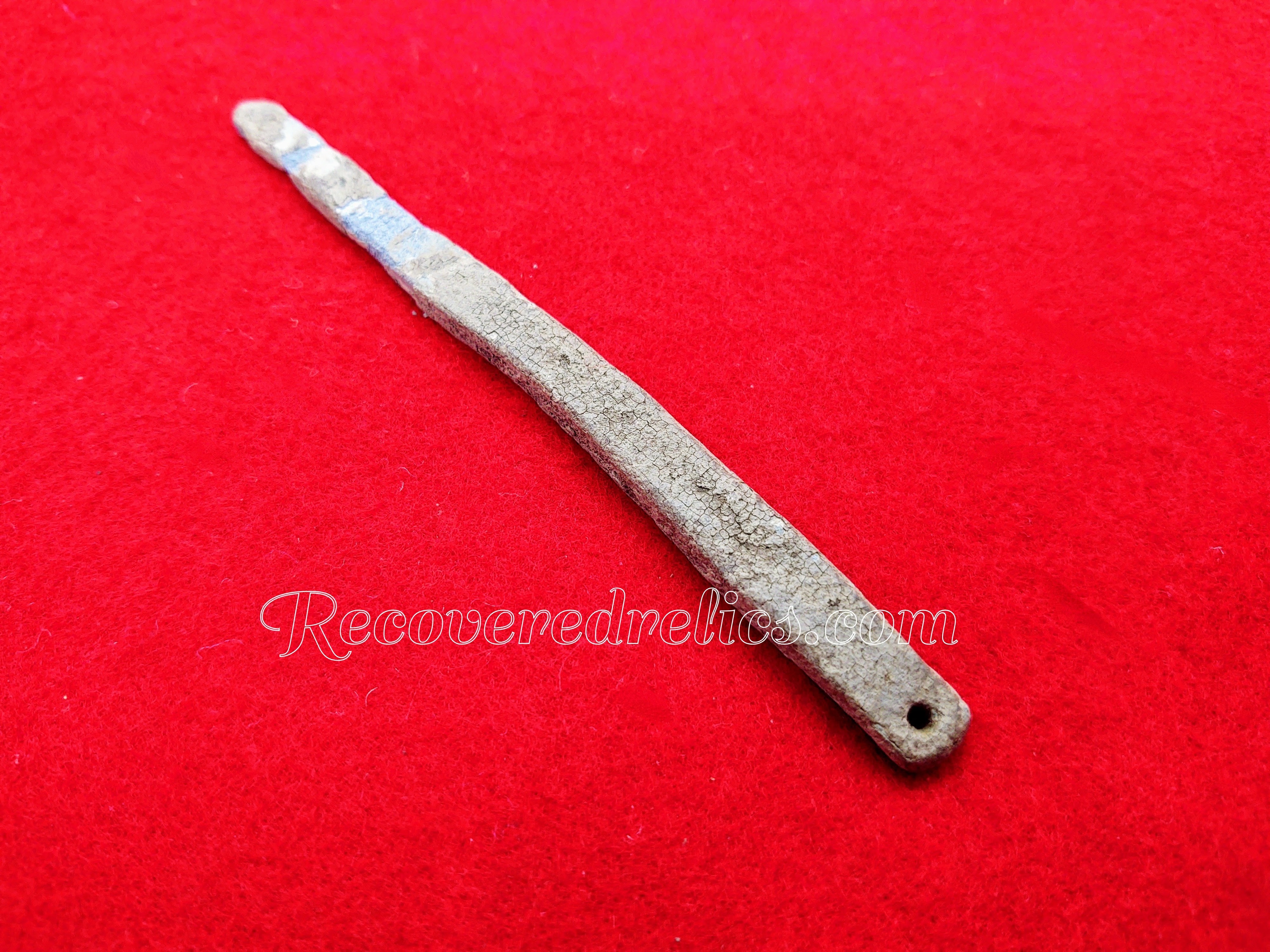
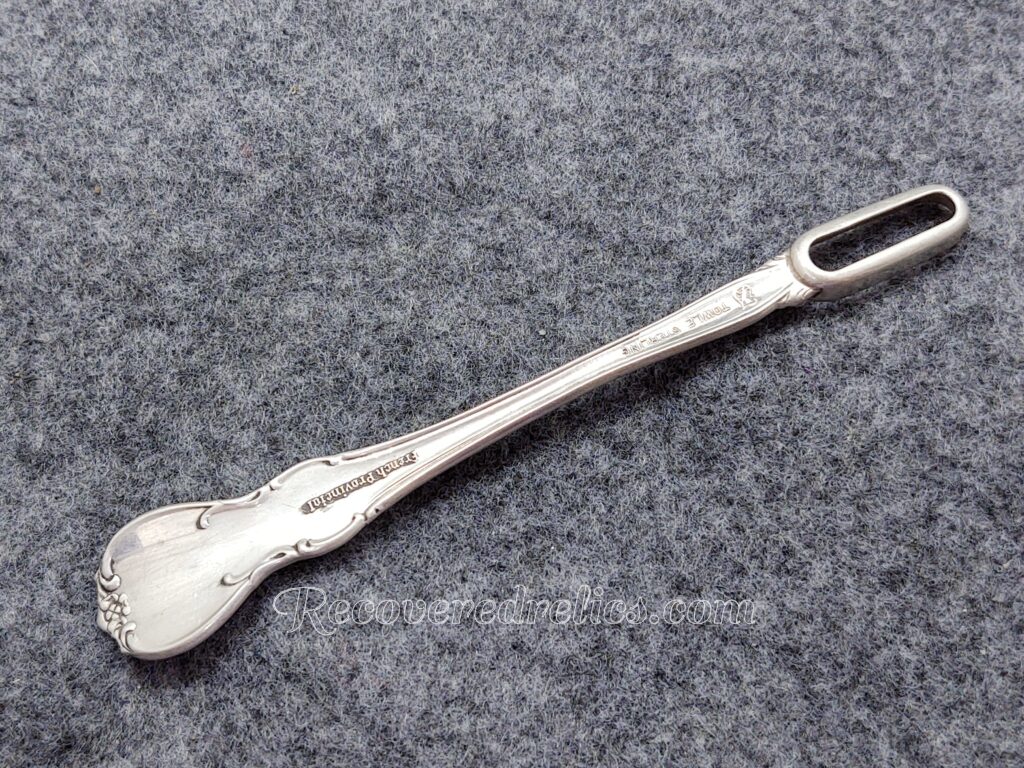
Silver Baby or Child’s Toothbrush-Toothbrushes were widely available for purchase during the 18th, 19th, 20th century. Great care was taken to preserve the teeth of children. Silver was and still is a precious commodity. The toothbrush pictured dates to the 20th century. The French Provincial pattern was first introduced in 1948. It has been a common practice in our culture to give the parents of newborns silver baby items. Historian’s believe that this long standing tradition throughout America dates back to the 18th century. Other popular silver items commonly gifted to the parents of newborns include spoons and rattles. These gifts were considered a symbol of investment in the child’s future.
Thimbles- A thimble is a small pitted cup designed to be worn on ones finger while they are sewing. It is used to protect ones finger from being pricked or poked by a sewing needle. Metal thimbles were made from all types of metals such as silver, gold, brass, copper, and iron. They are a common metal detecting find.
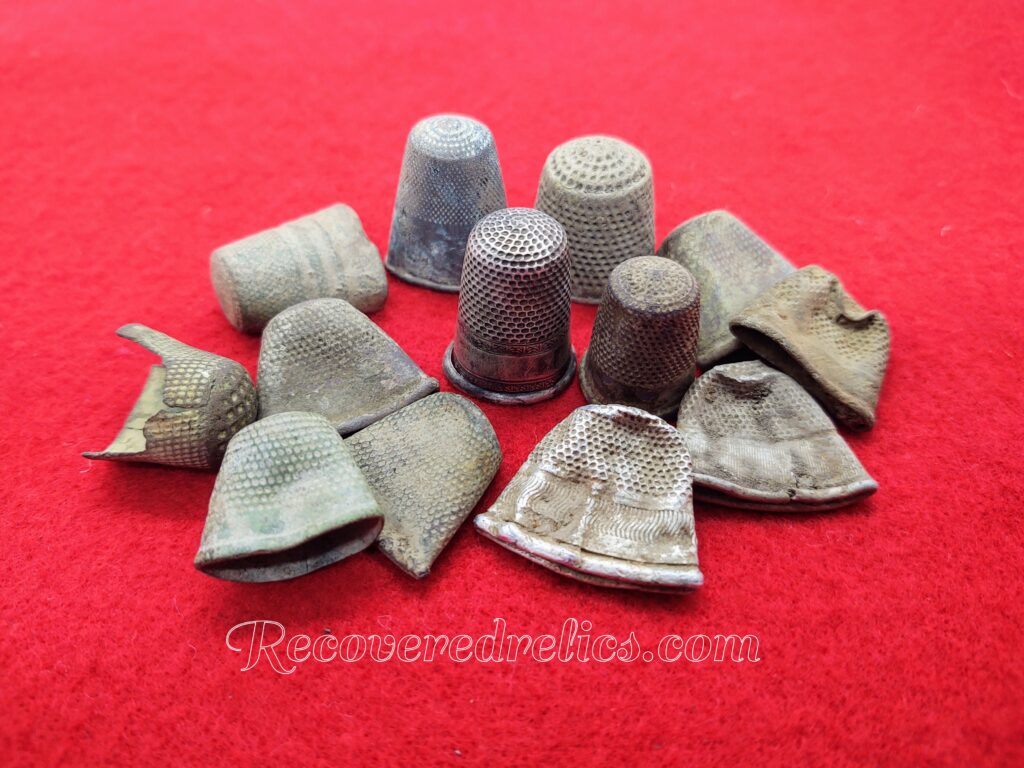
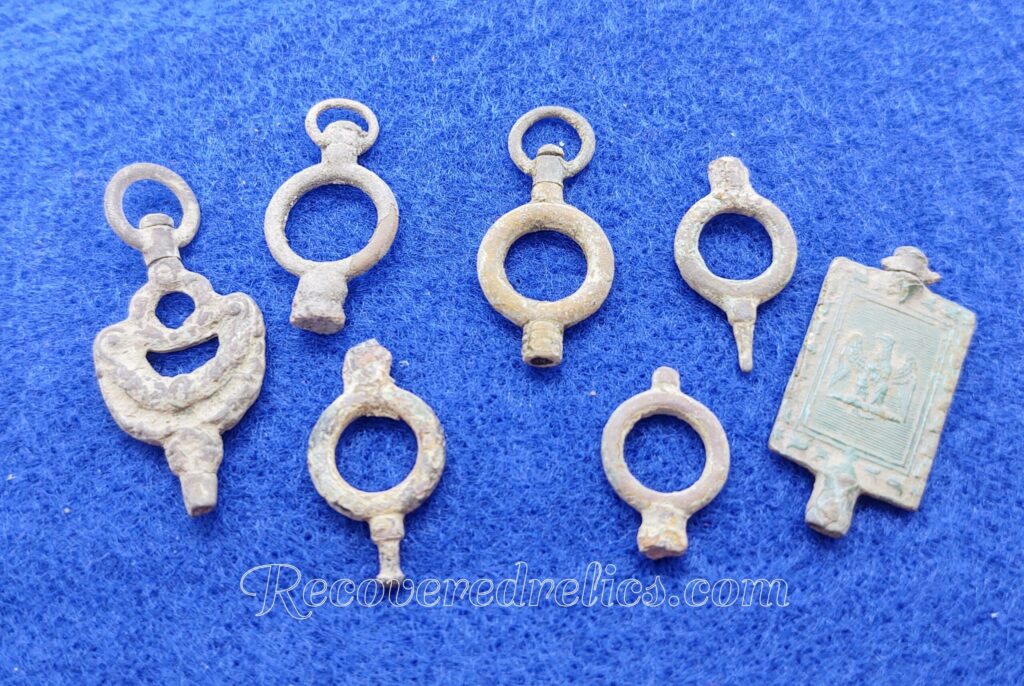
Watch Winders– Watch winders were used to wind pocket watches. Pocket watches first emerged during the 16th century, allowing people to personally keep track of the time. Pocket watches needed to be wound and reset daily. Because of this, watch keys or winders became a necessity. The keys were made from various metals and in an array of different designs. Some were simple, while others featured jewels, engravings, or ornate designs.
Wafer Seal– Wafer seals are a different type of seal for letters and were first introduced around the end of the 18th century. Glue wafers were made from a mixture of wheat, flour, water, egg white, and coloring. The mixture was made into a paste, dried on sheets, and punched out into small flat disks. Wafers were then used like sticky labels. When you wet the bottom of the wafer and placed it between two pieces of paper it sealed them closed. Wafer seals are often misidentified as wax seals or sometimes even as pipe tampers. Wafer seals have a simple cross hatched design on their bases.
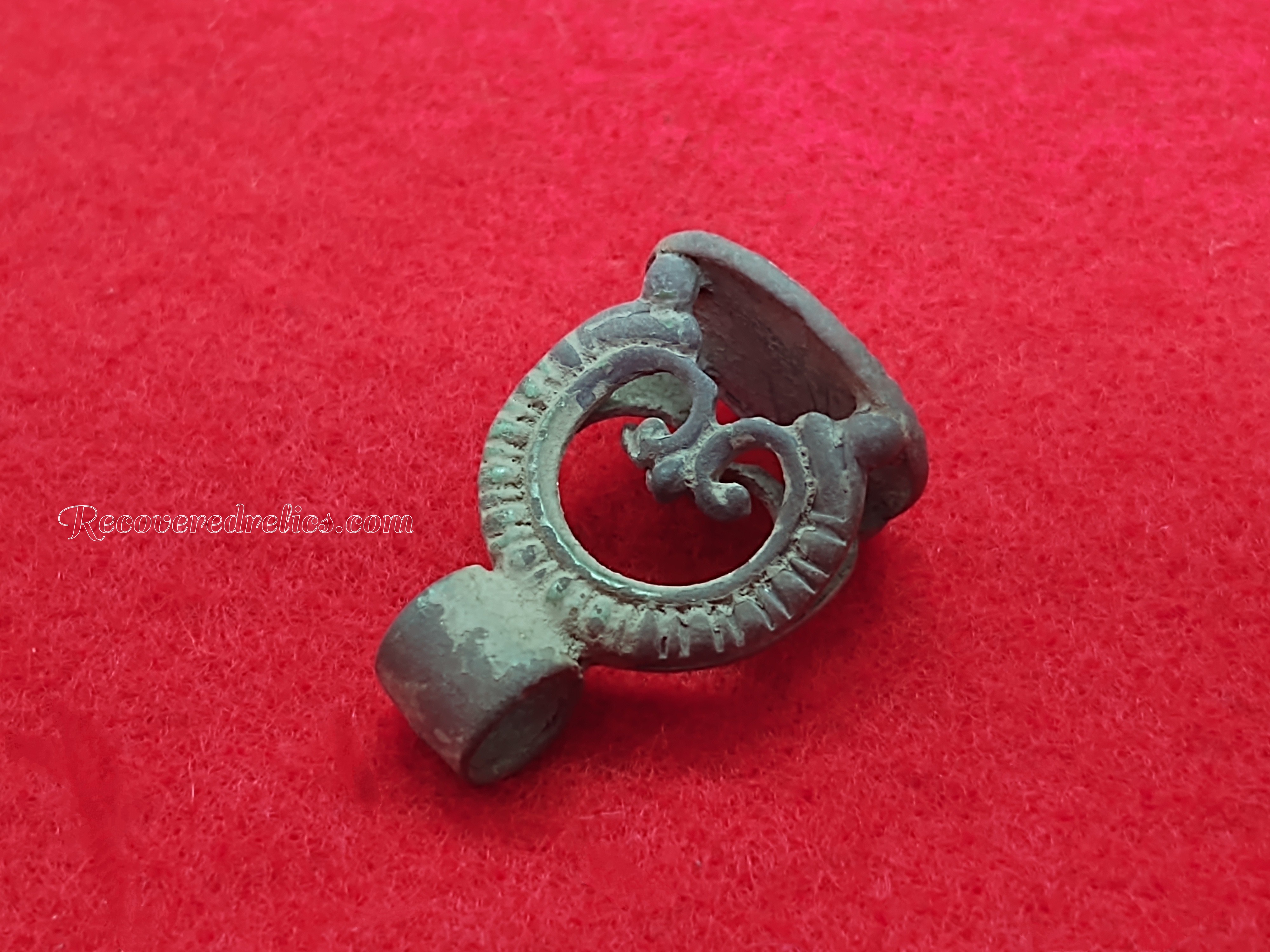
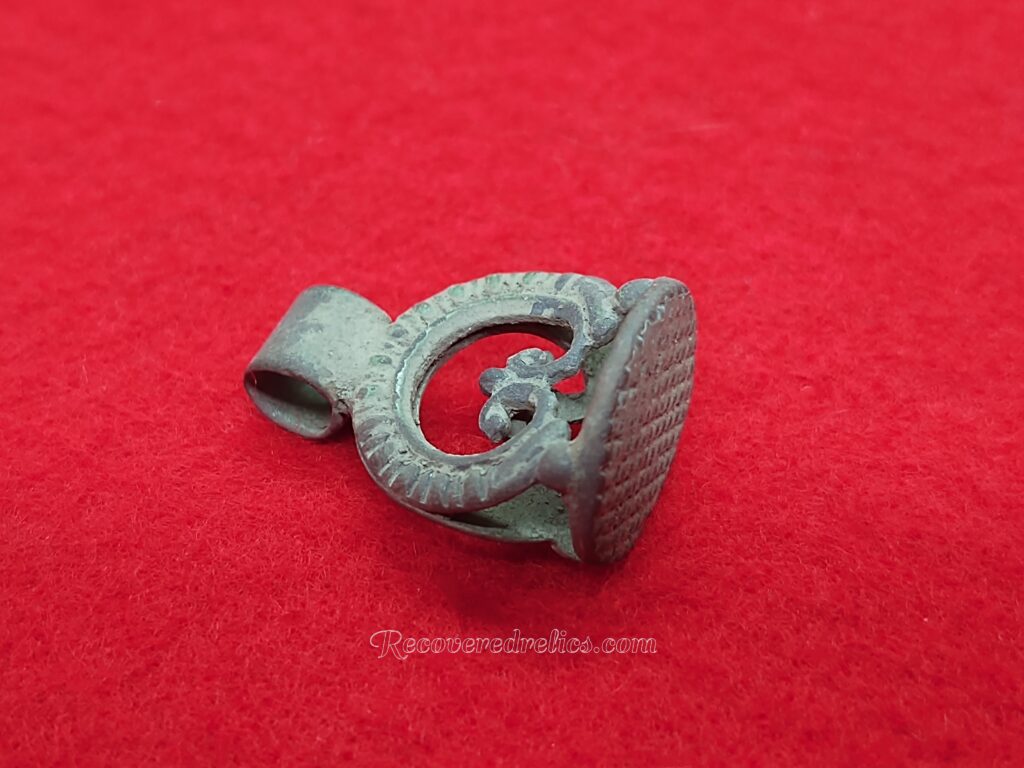

Wax Seal– A seal is a device for making an impression in wax, clay, paper, or some other medium. People began using sealing wax in the Middle Ages. The earliest forms of sealing wax was typically made of beeswax and resin. Sealing wax was used to “seal” the letters or envelopes. Sealing wax was also used for the purpose of stamping or signing legal documents. Wax seals come in many different forms. There are seal rings or signet rings, hand-held desk seals, pendant seals, and seals that attach to a watch fob. All seals are reversed engineered to ensure that their designs come out properly when stamped.
Musical Goods
Harmonica Reed Plates– A harmonic is a musical wind instrument consisting of a small rectangular case that is held in in ones hand and played by the mouth. Sound is produced through metal reeds which vibrate as air is blown or drawn past them. Harmonic reed plates are flat, elongated shaped and typically made from brass. They have little slots milled out of them to house the individual reeds. Each individual reed has its own slot. Reeds are riveted onto the reed plate. The reed plates are then screwed or nailed onto the comb or body of the harmonica.
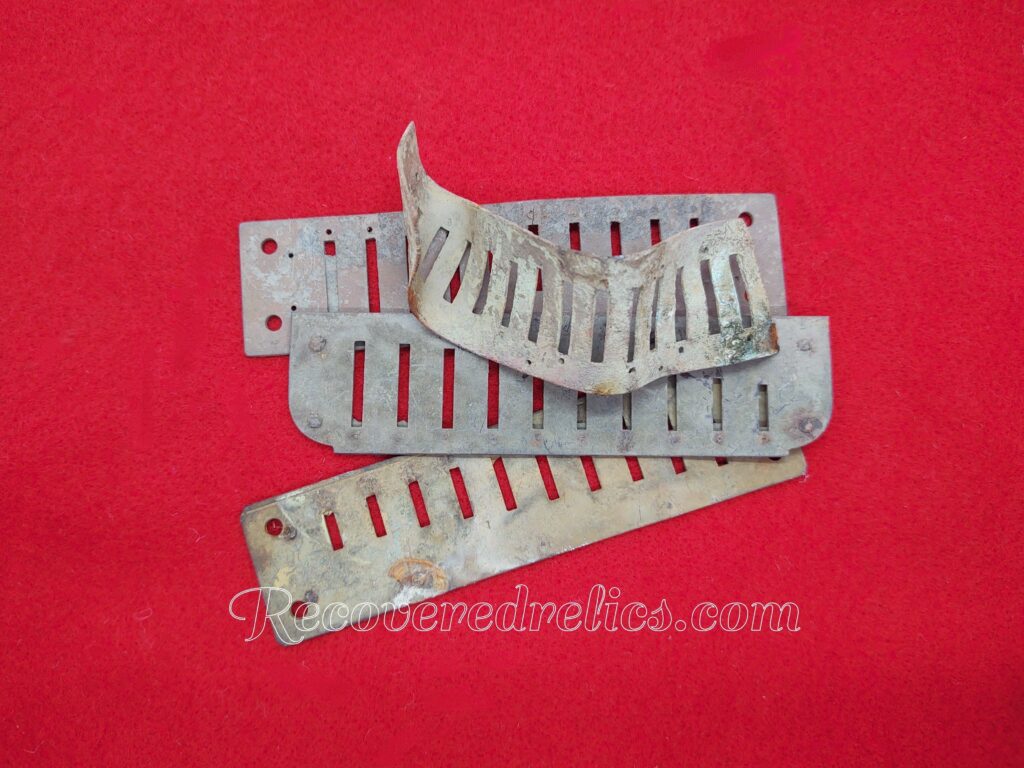
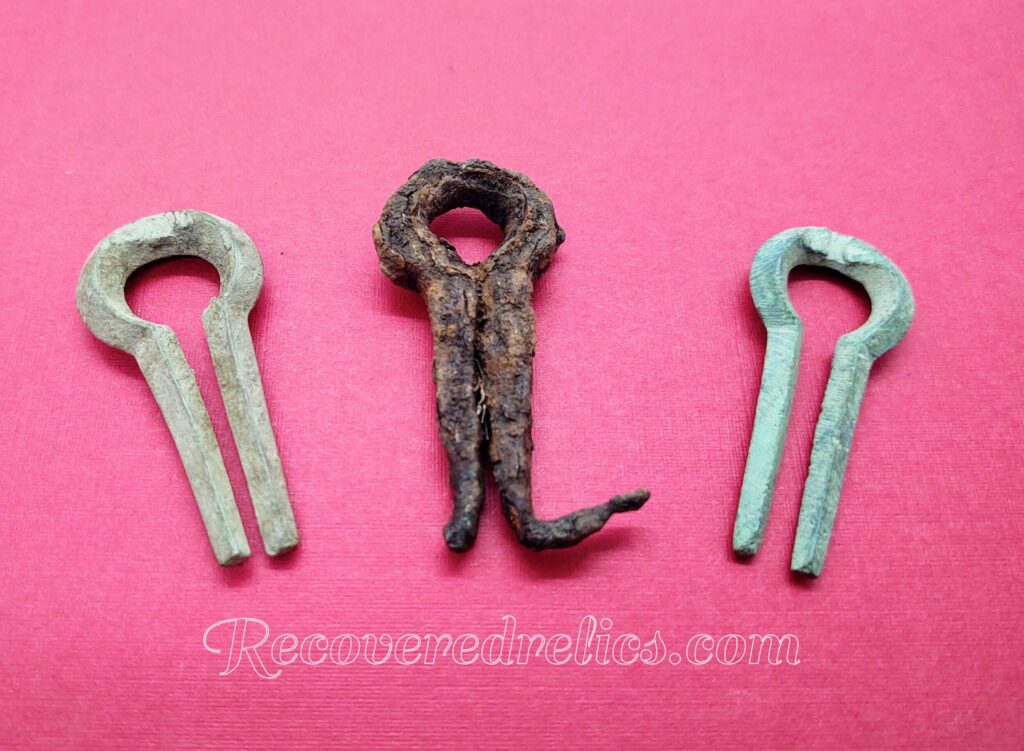
Jews Harp– The jews harp is a small, single reed musical instrument. Also referred to as the jaws harp, mouth harp, juice harp, or trump. We often find the frames of jews harps or fragments of the frames when metal detecting. The reed or tongue piece was thin and fragile and frequently broke off. Also, the reed pieces don’t typically withstand the test of time when in the ground.
Tokens
Civil War Era Tokens– Tokens that were privately minted and distributed in the United States between 1861 and 1864. These tokens were utilized as currency and were widely used in the Northeast and Midwest where at the time there was a scarcity of government issued cents. Civil War era tokens can be divided into three categories: store tokens, patriotic tokens, and sutler tokens. The US congress passed a law on April 22, 1864 prohibiting the issue of any one cent or two cent tokens or devices for use as currency ending the legal use of Civil Ware era tokens.
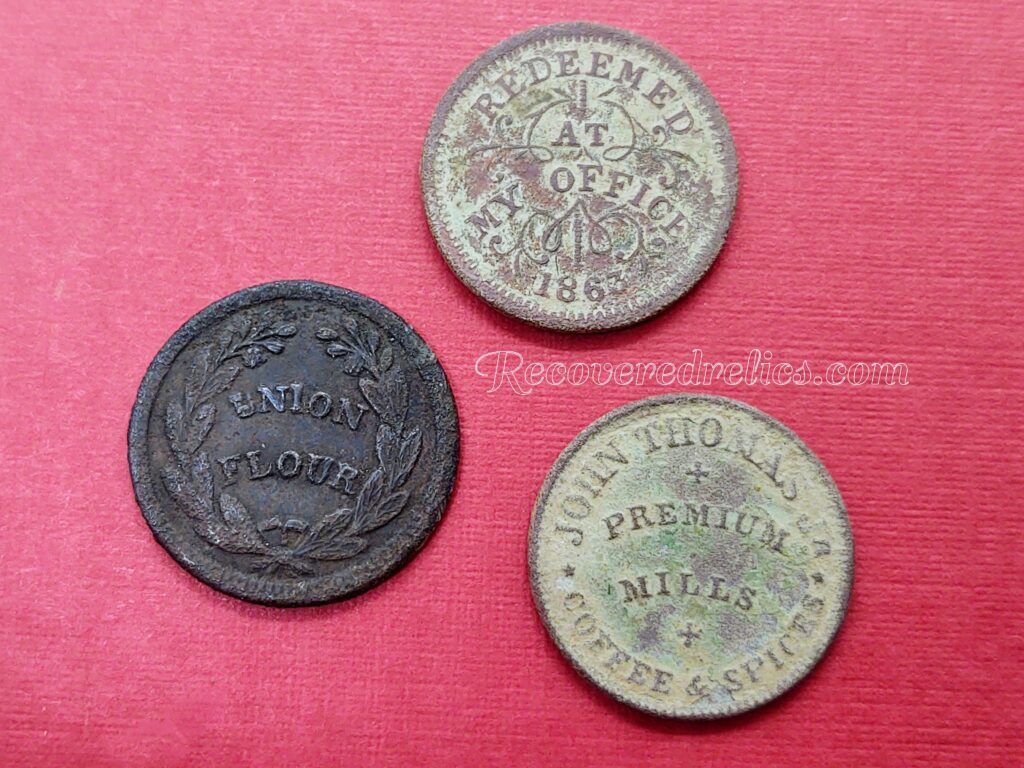
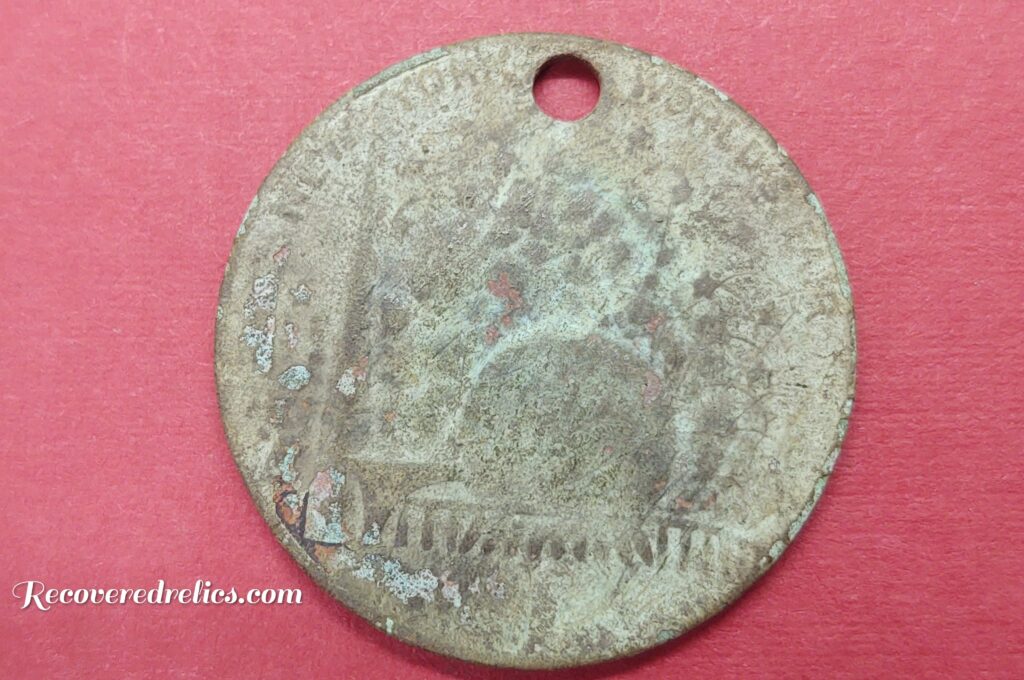
Expositions and Fair Tokens– These tokens were sold or given away as souvenirs at various major expositions and fairs. They were issued at the time of the fair or shortly afterwards.
Gasoline Company Contest Tokens– In the 1960’s and 1970’s gasoline companies such as Shell and Sonoco ran contests where aluminum tokens were given out. Many of these tokens issued were of US presidents, famous people, antique cars, landmarks, and space exploration. All of these tokens are 26mm in size.
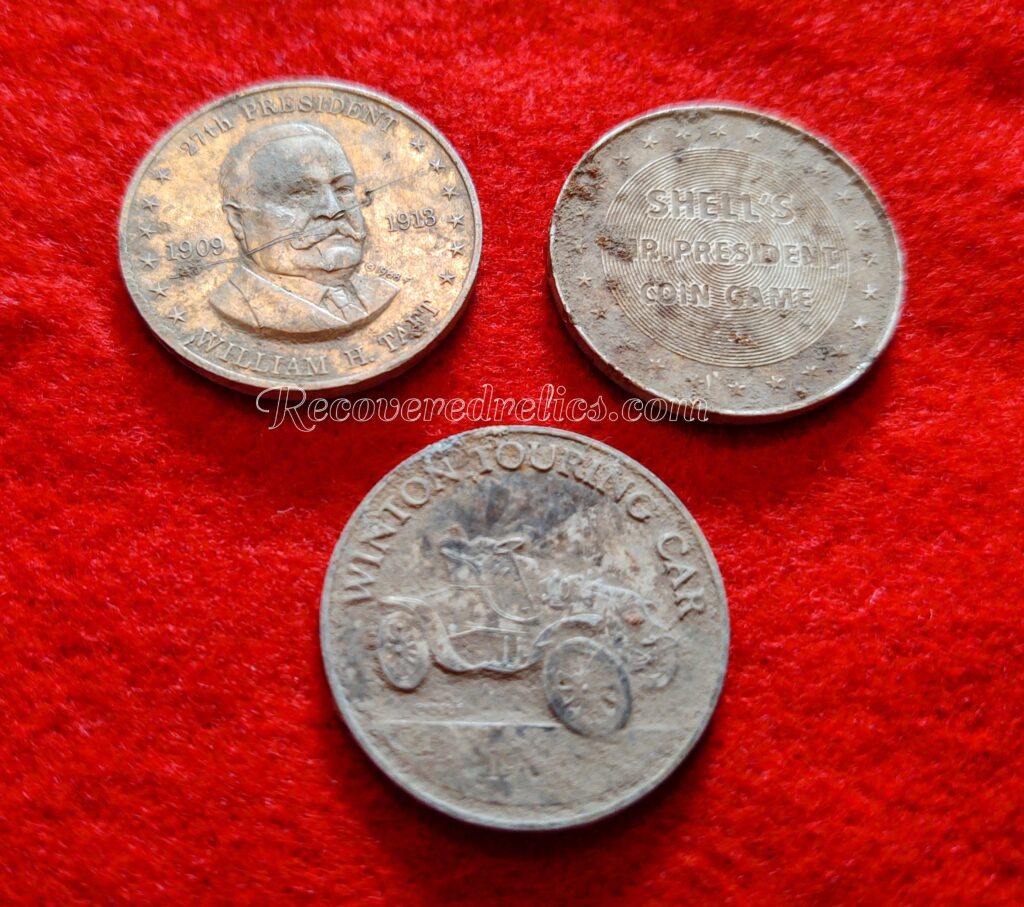
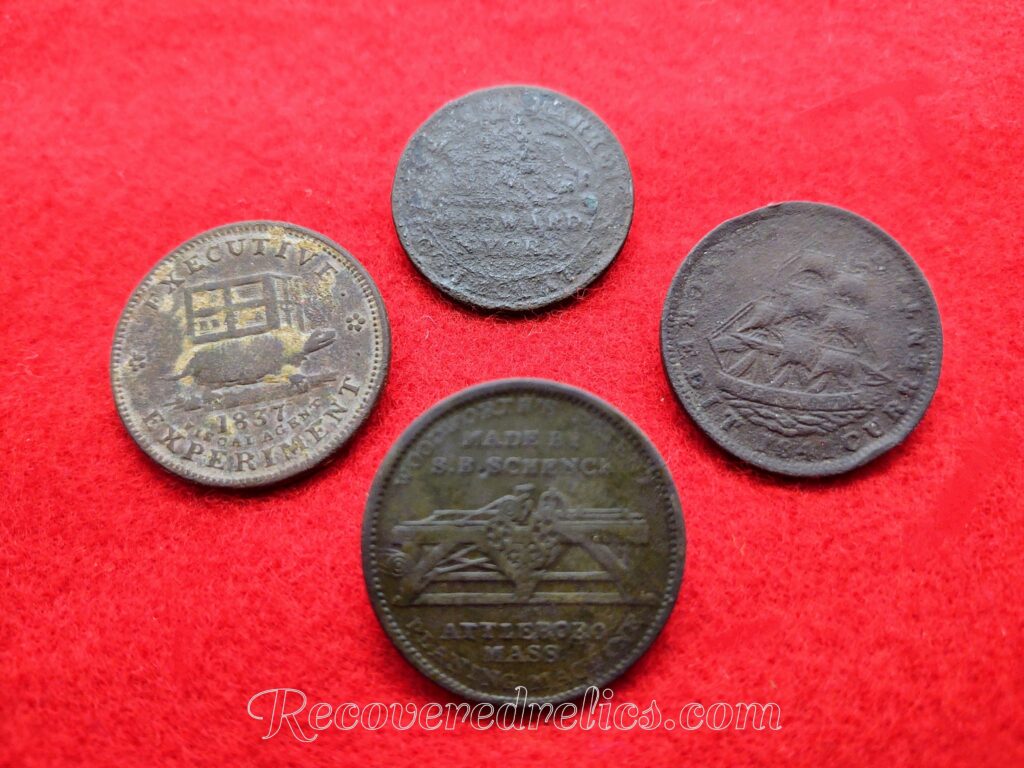
Hard Times Tokens– American large or half cent sized copper or brass tokens struck between 1833 and 1843. These privately made tokens served as unofficial currency. They were used during a time of political and financial crisis. Many of the designs are political and satirical.
Love Tokens– Love tokens are defaced coins. Either one or both sides of the coins were smoothed out and then hand engraved. Engravings with initials are the most common but names, dates, sayings, or pictures were also popular. The practice was popular in the United States during the second half of the 19th century. All types of coins were used to create love tokens. The Seated Liberty dime was the most commonly used coin to make love tokens.
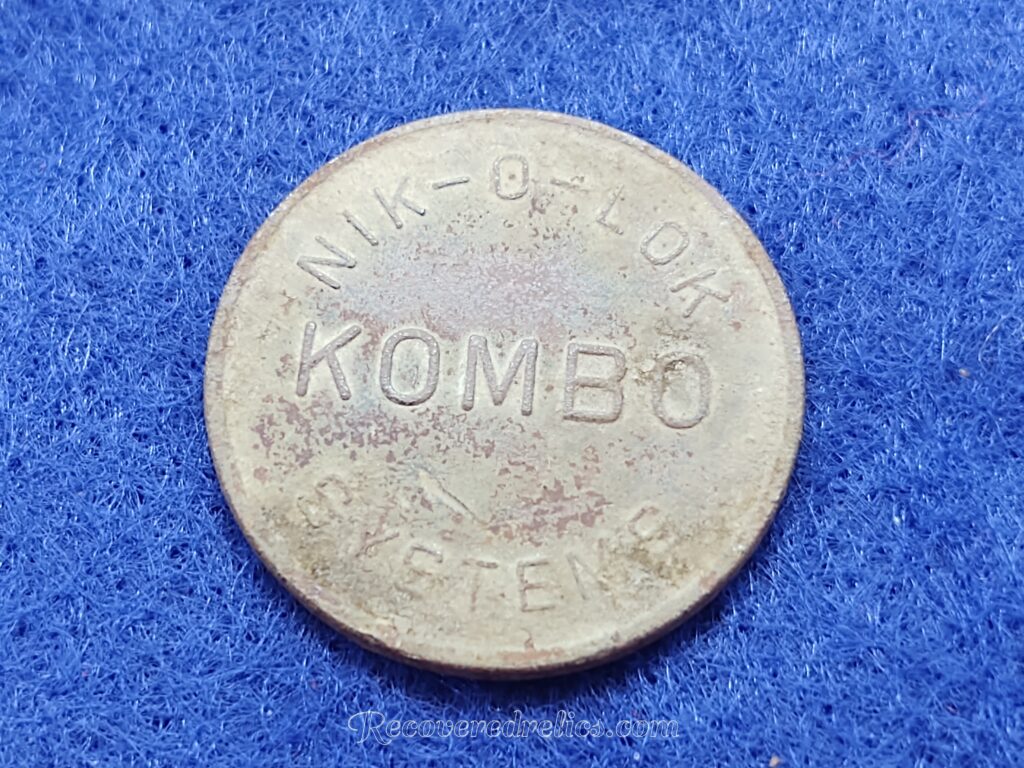
Pay Toilet Tokens– These tokens were used for access to locked toilet stalls in public or commercial places.
Political Tokens– This category of tokens encompasses presidential campaign tokens, non campaign political pieces of presidents, non-presidential political campaign tokens, souvenir tokens of local politicians, political convention tokens, cause tokens such as Anti-Slavery tokens, Temperance tokens, and Prohibition tokens. Political tokens are often satirical.



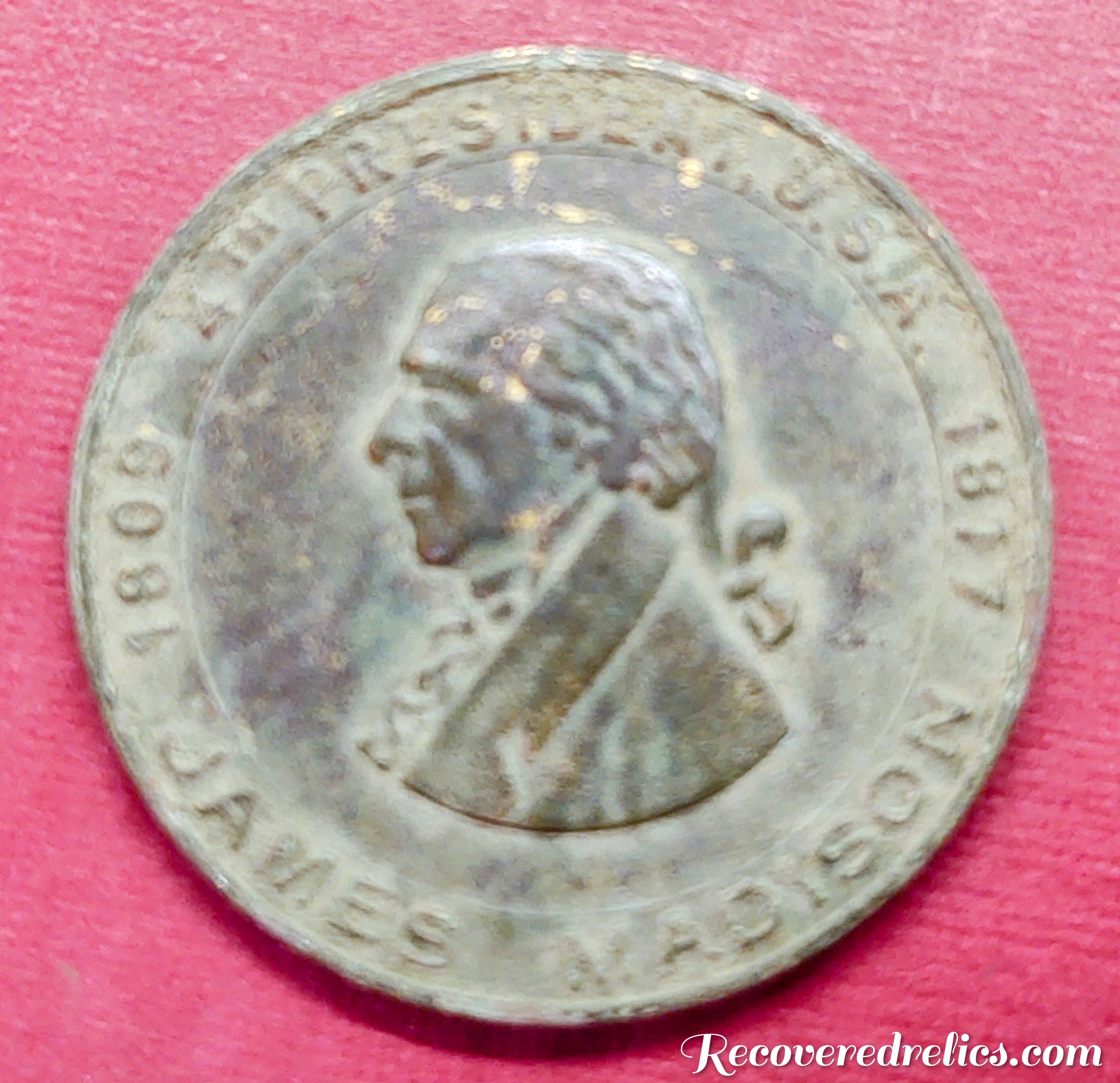
President Data Series Tokens (20th Century)– These tokens were issued from the 1930’s – 1980’s in brass, gilt brass, aluminum, plastic, gilt pewter, and gray metal.
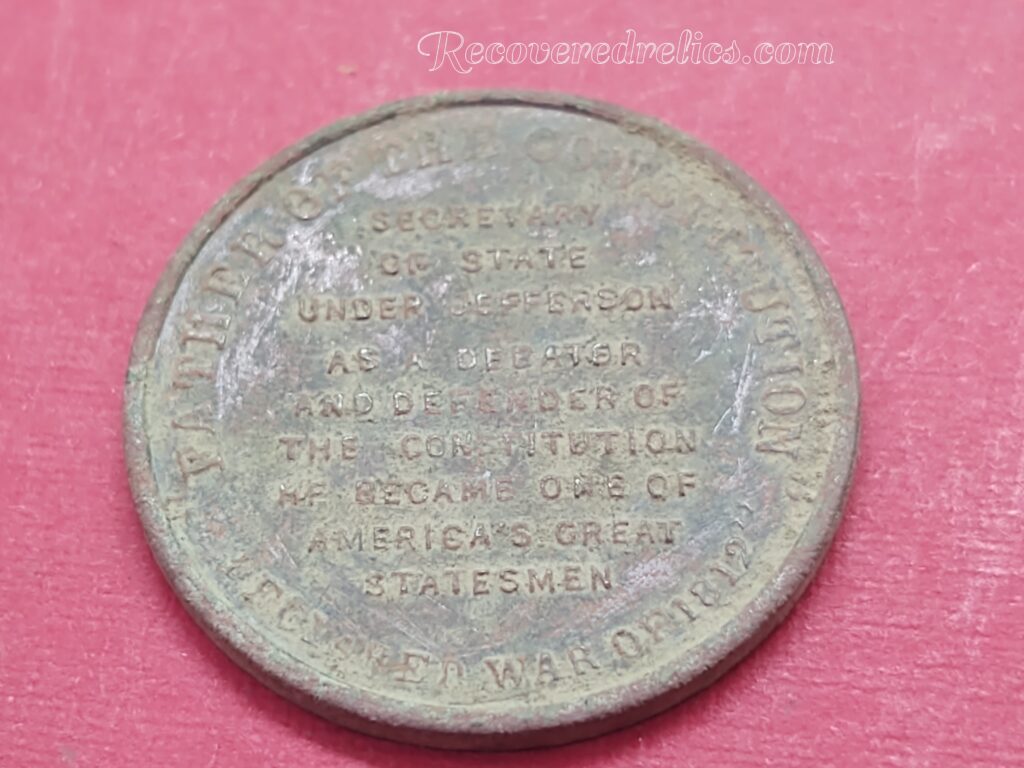
Trade Tokens– Trade tokens are sometimes referred to as merchant tokens or “good fors”. Trade tokens in the United States date back to the late 18th century. They were manufactured by numerous token making companies. Trade tokens were worth something in trade, merchandise, cash, or service. Most businesses benefitted from using the tokens by receiving payment in advance for merchandise or services to be claimed later or they used the tokens as a means of extending credit.
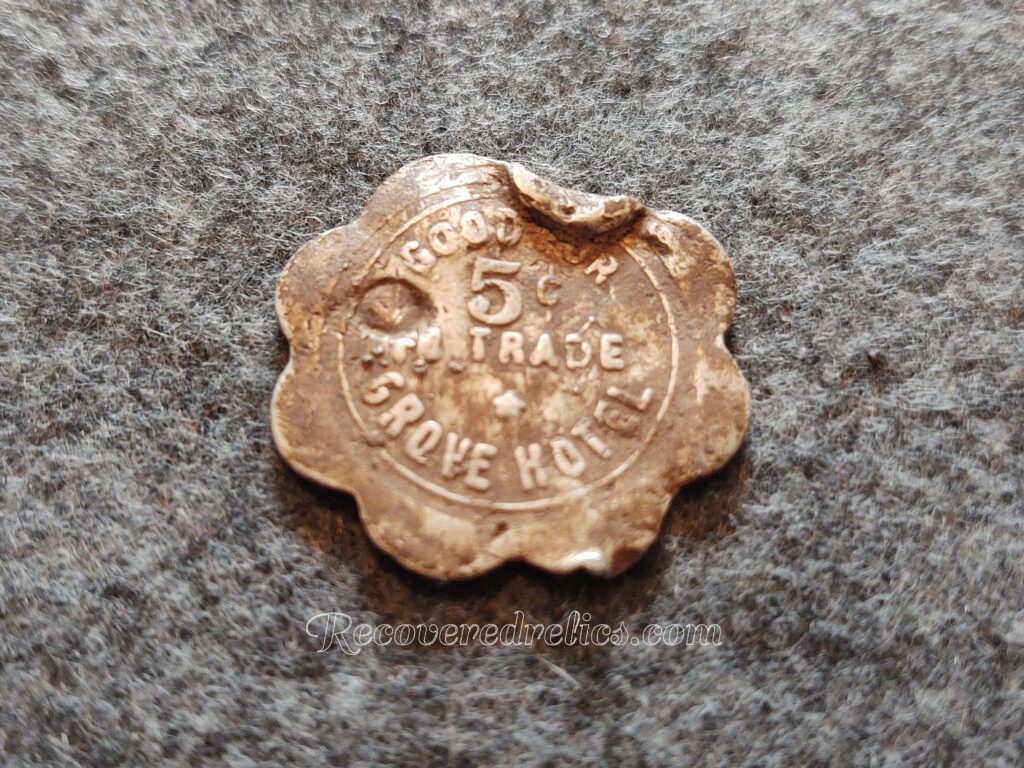
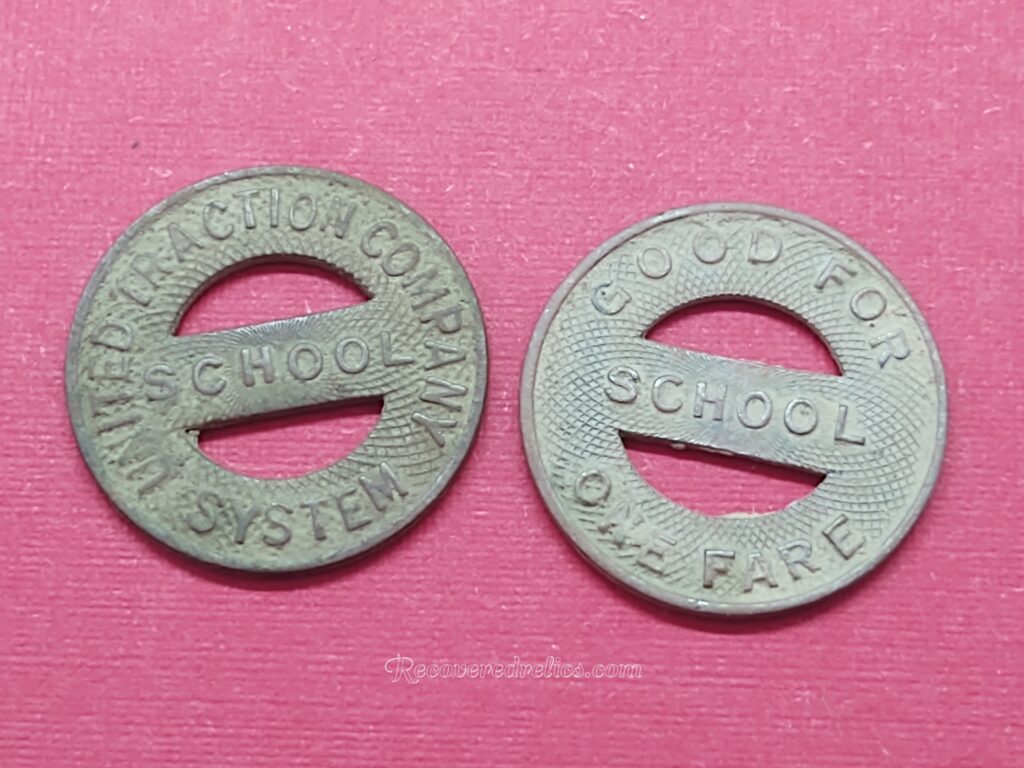
Transportation Tokens– This type of tokens was used for personal transport. These tokens were good for fares, rides, tolls, passage, trips, etc. on horse drawn vehicles, stage coaches, railways, streetcars, busses, ferries, bridges, toll roads, taxis, ect. Transportation tokens were first used in the US in the year 1837 and are still used widely even today.
Weaponry Parts and Tools
Bucky Balls/ Buck and Ball Ammunition– A type of cartridge used in smoothbore muskets during the Civil War and other conflicts. The name Buck and Ball comes from the fact that the cartridge contained a single full sized musket ball along with several smaller buckshot pellets. Detectorists refer to these bullshot sized lead pellets as bucky balls. This type of ammunition was widely used during the Civil War. The buckshot’s accuracy declined at long range but the sheer number of projectiles and the potential to inflict serious wounds made it a valuable tool in combat.


Enfield Bullet .577 Caliber– The .577 caliber Enfield bullet was carried by many Confederate Infantry troops during the Civil War. It was also carried by a large portion of the Federal Infantry. This bullet was originally designed in England and was often used with the British Pattern 1853 Enfield Rifle. The base of the bullets were often stamped with letters or numbers. These markings can help to indicate where the bullet was made and also it’s caliber.
Firearm Parts– Metal detectorists sometimes find parts or pieces of old firearms. Firearms are made up of lots of individual components. Different firearms have varying parts depending on their make, size, and function. Essentially though all firearms have a few basic parts, such as the barrel, the frame, the action, and the stock.
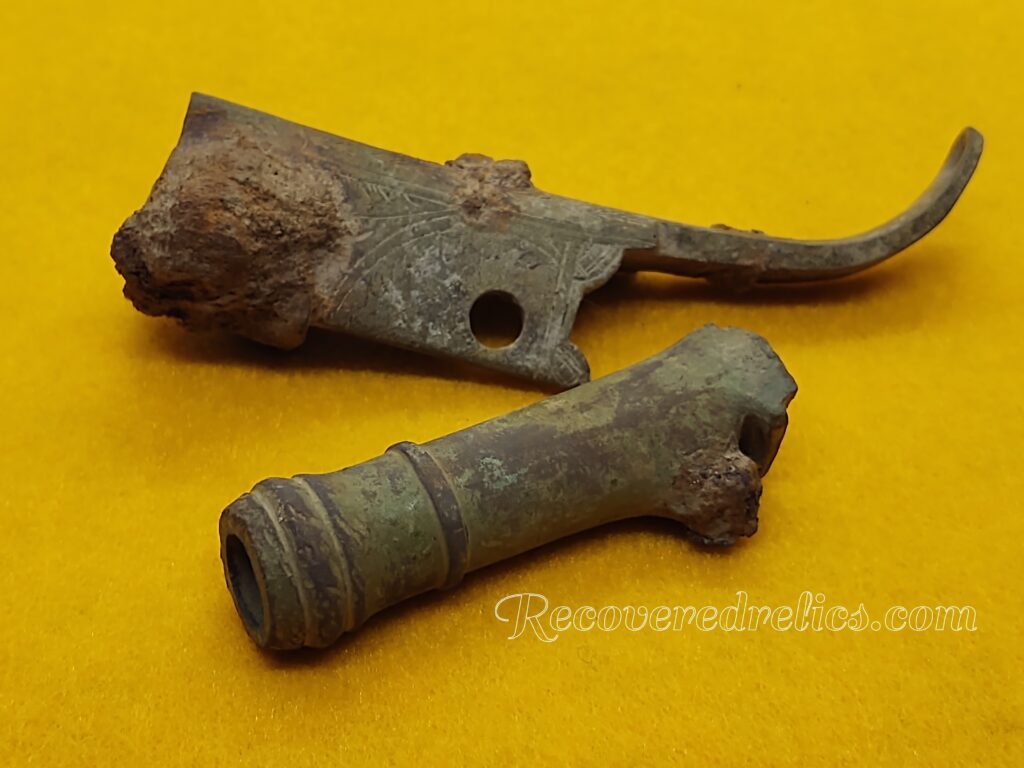
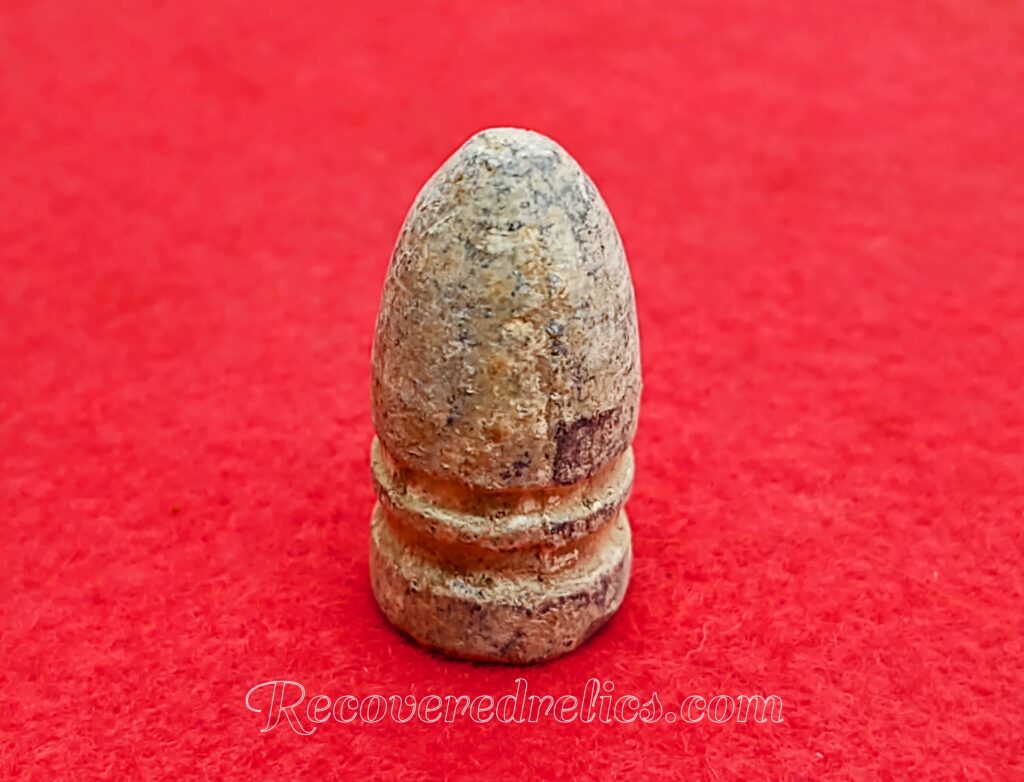
Gardner .58 Caliber Bullet– The .58 caliber Gardner bullet was patented on August 17, 1861 by the Confederate States of America. The Gardner bullet was often used with Model 1863 Springfield Rifled Musket or the British Pattern 1853 Enfield Rifle Musket. This bullet was unique because of how the paper cartridge was attached to the bullet. Typically the paper was either wrapped or tied around the body of a bullet, but in the Gardner the paper was actually inserted into a grove in the bullet’s base. If the South had an official bullet it would have been the Gardner.
Kettle Point– A Kettle Point is a metal (brass or copper) projectile point or arrowhead. They vary slightly in size. The majority seem to be about one inch or so in length. Kettle points also vary somewhat in design. In the beginning of the 17th century there was period of experimentation with shapes. During this time period, Native Americans in the Northeast made stemmed, barbed, pentagonal and triangular metal points. There was little uniformity. By the second quarter of the 17th century, kettle points were made almost exclusively in isosceles triangular form with the exception of rolled conical points. Many of the triangular kettle points were pierced with a central hole so that the point could be easily attached to the shaft of an arrow.
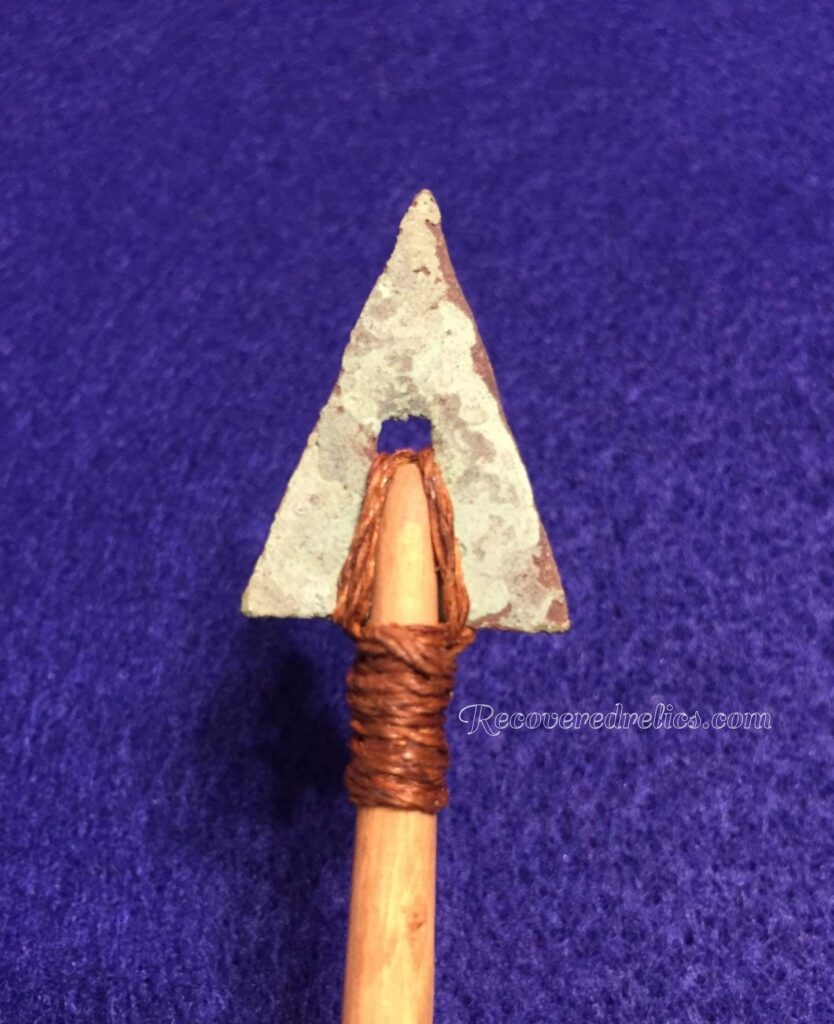
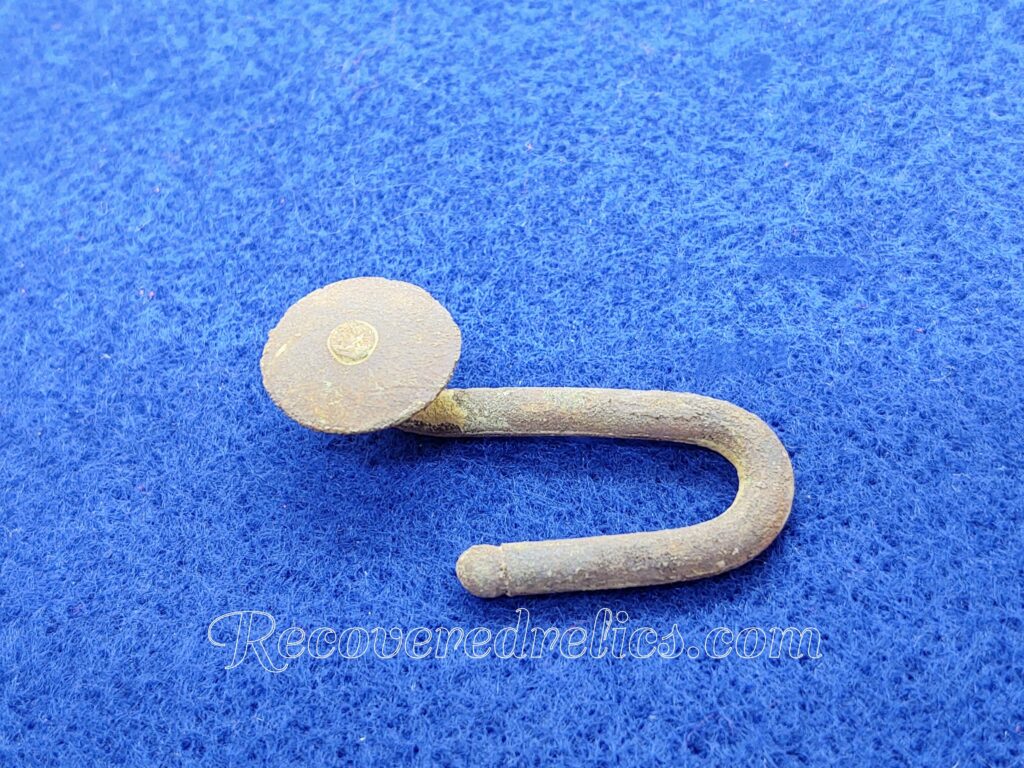
Knapsack J Hook– During the Civil War, J hooks were used to secure a soldier’s knapsack to their belt for extra support. The J-hooks were attached to the leather chest cross straps of a knapsack and were designed to hook into the belt slides of a soldier waist belt. Knapsacks were used by both Union and Confederate soldiers to carry essential items such as food, blankets, clothing, tools, etc.
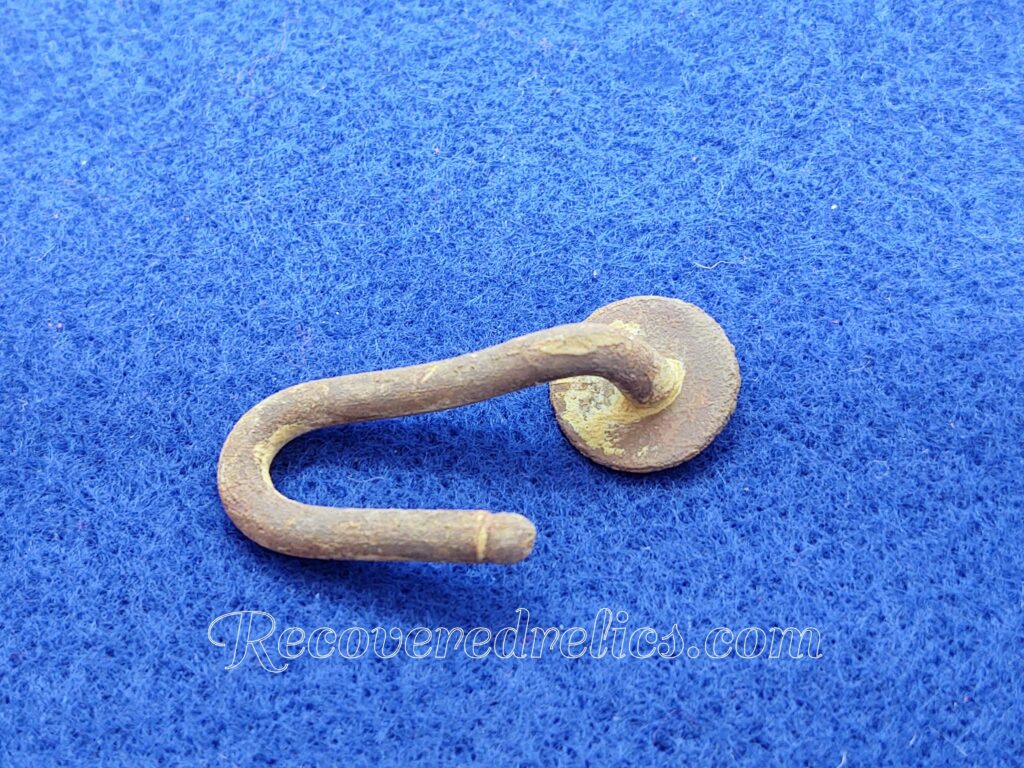
Minié Ball (Union) .58 caliber– The Union Minié Ball was the most widely used bullet in the Civil War. Minié Balls are not round as the name suggests. They are named after their creator Captain Claude Etienne Minié. The bullet was officially adopted by the US Army in 1855. Rings were added to the design by Americans. The rings held grease to help ease the bullet down the barrel and also collected powder residue when fired.
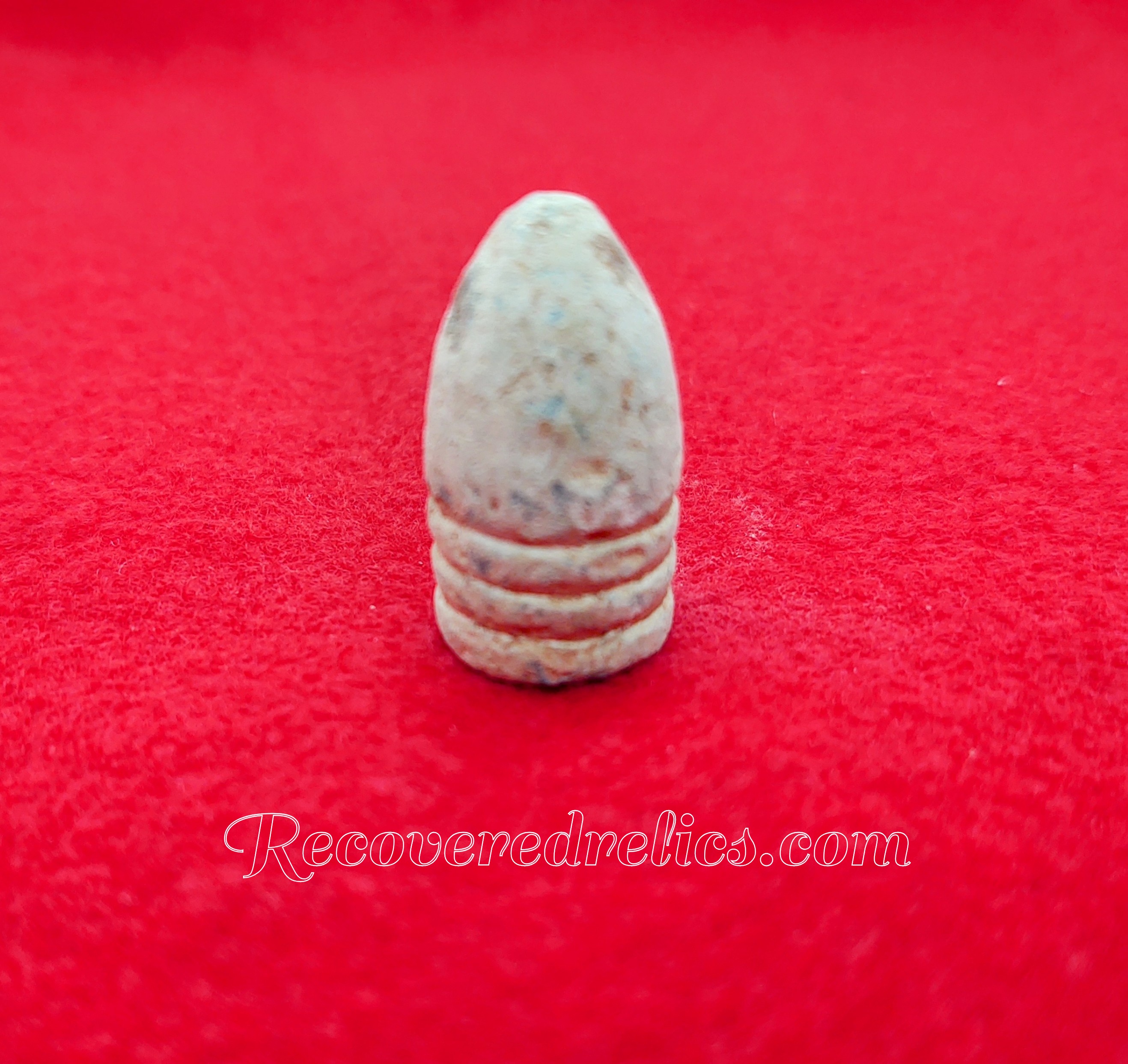
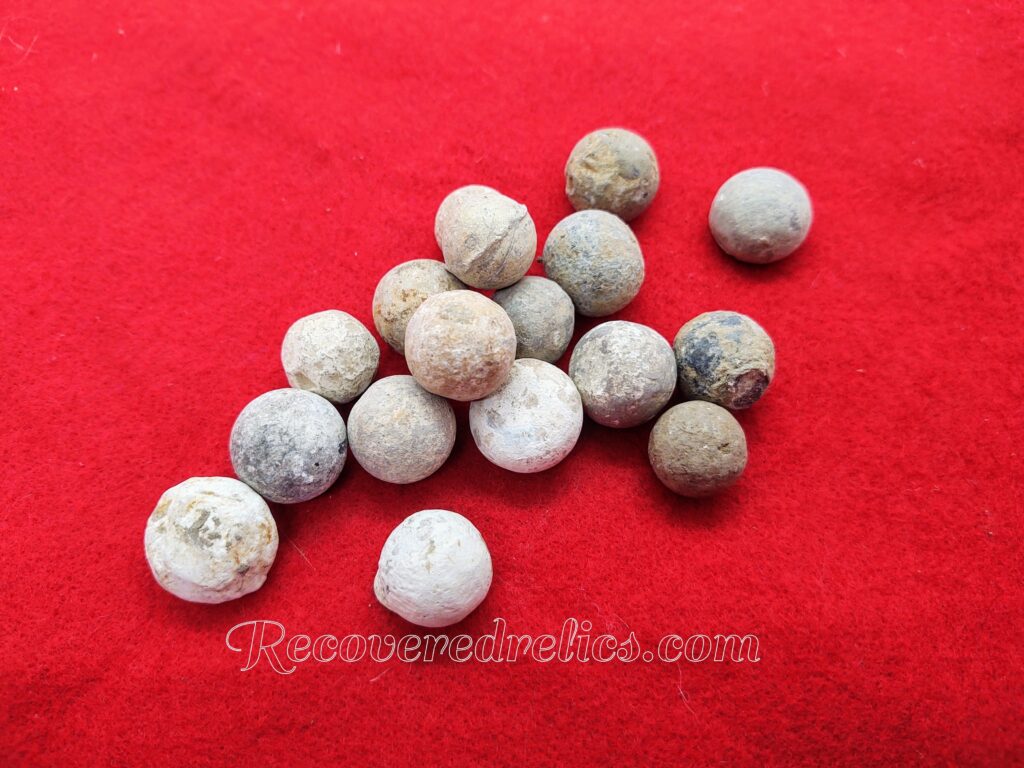
Musket Balls/ Lead Shot– A musket ball is a projectile used in early firearms. Musket balls were one of the first types of ammunition used in firearms, dating back to the 16th century. The spherical shape of a ball was selected because it provided a consistent and stable trajectory through the air which was important for accuracy and range. Musket balls were often made of lead, but not always. Stone musket balls were used in early firearms as well.
Musket Plate– These musket plates are from Brown Bess musket rifles. Brown Bess is a nickname for the British Army’s muzzle loading flintlock Land Patten Musket. The Brown Bess was the standard weapon used by the British infantry between the years 1722 and 1838. The Brown Bess was a large caliber weapon. It had two types: the Short Land Pattern and the Long Land Pattern. These muskets were also used by the Continental Army during the Revolutionary War until around the year 1777. The Long Land Pattern was most commonly used by American fighters.
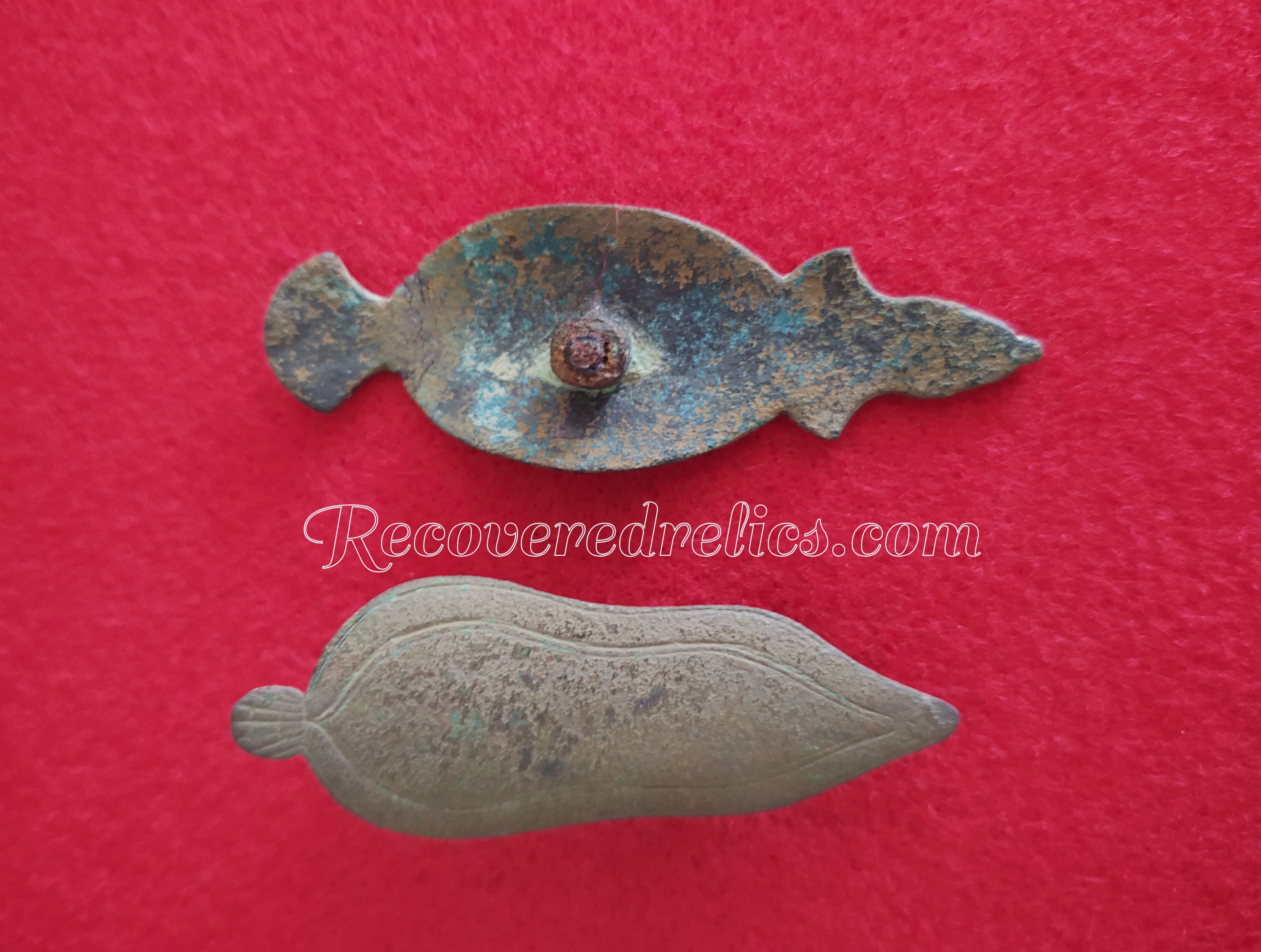
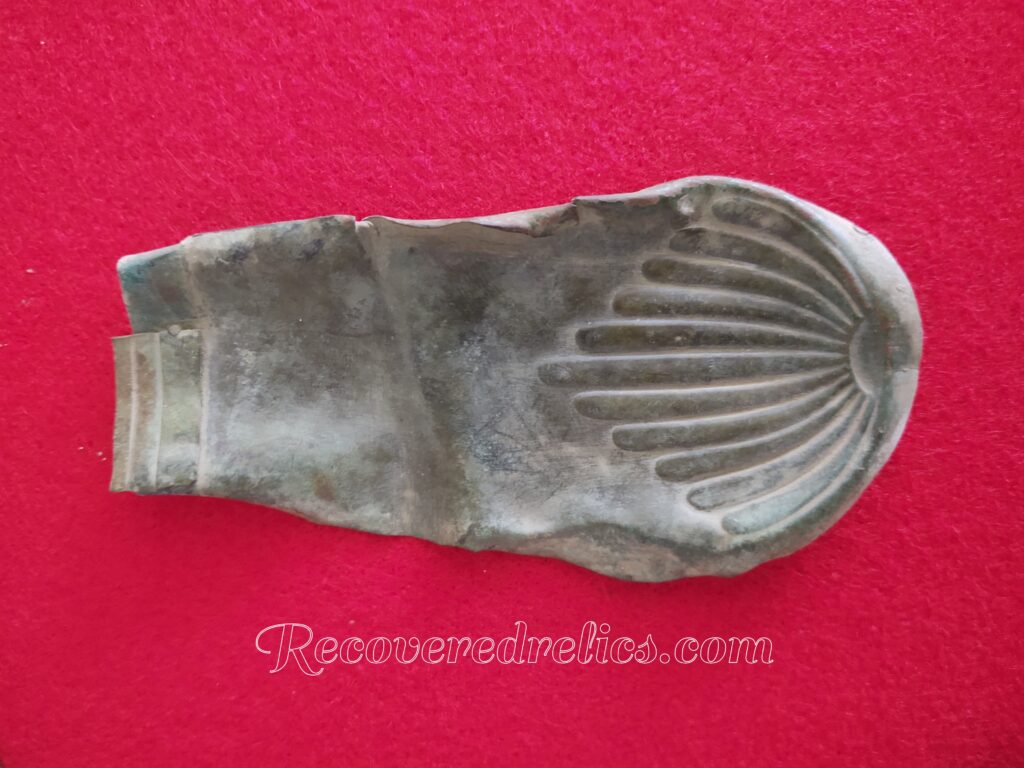
Powder Flask– A powder flask is a container for gunpowder. Gunpowder is an essential part of shooting equipment for muzzle loading guns. Powder flasks vary from very elaborately decorated works of art to more simple early forms of consumer packaging.
Sharps .52 Caliber Bullet– The .52 caliber Sharps bullets were used primarily by the Federal Calvary troops. However both Union and Confederate sharpshooters also favored this bullet due to it’s reliability and fast firing rate. This bullet was often used in Model 1859 Sharps Breechloading Carbine. The Sharps bullet was loaded in the rear of the weapons barrel. Their totally combustible cartridge would burn fast and hot when ignited. This provided the soldiers with more reliable ammunition even in damp conditions.

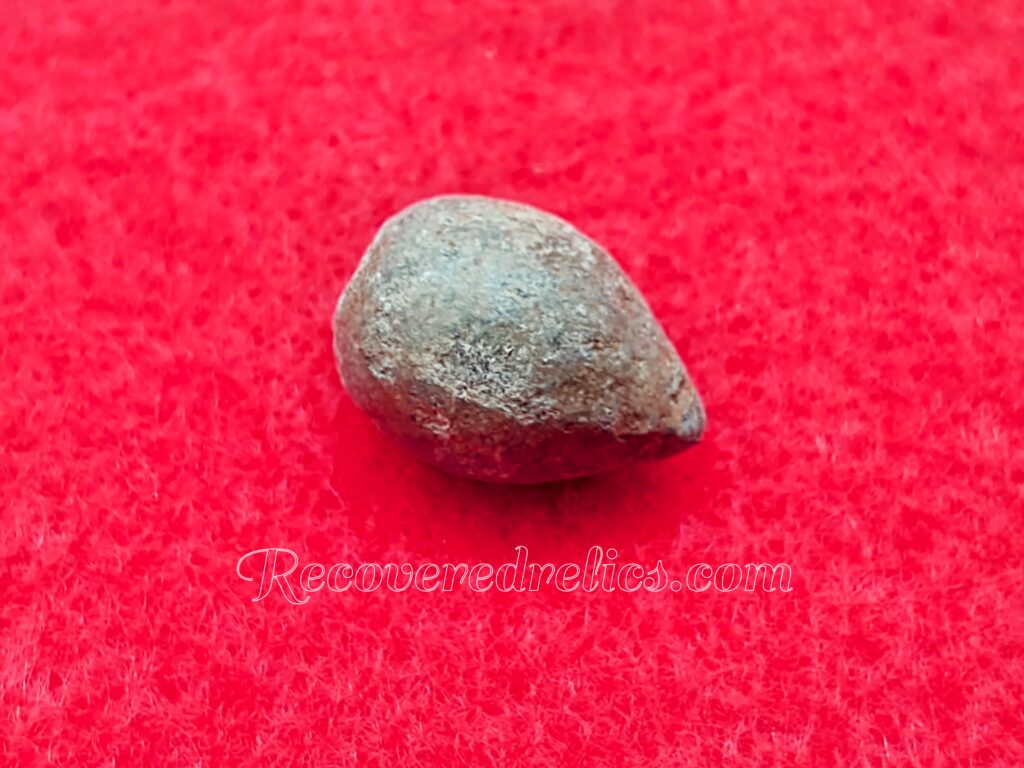
Sugar Loaf Bullet– A teardrop or conical shaped bullet with a rounded base and a point on it’s small end. It is often described as having a sugar loaf appearance. Conical bullets were introduced in the 1830’s and commonly used in rifled muskets. Conical bullets were developed as an improvement over round balls and were favored for their increased accuracy and range.
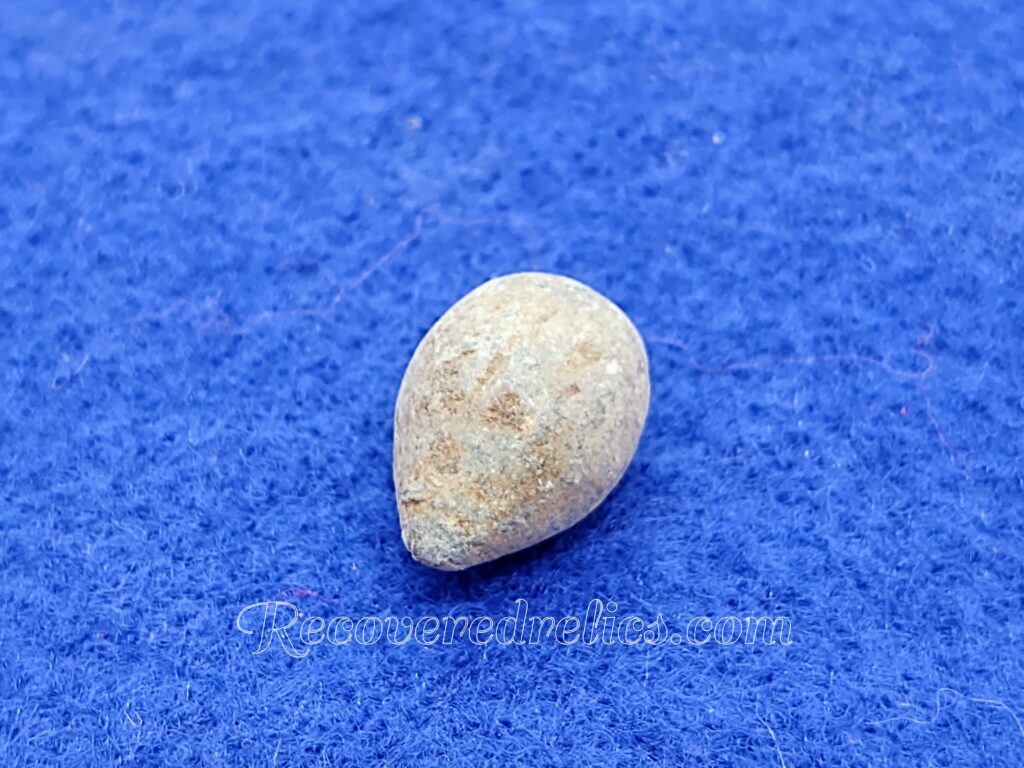
Sword/Dagger Guard– A blanket term for all the parts that protect the hand. The guard is merely whatever is between the handle and the blade. It can be as simple as a flat cross piece or much more complex and ornate.
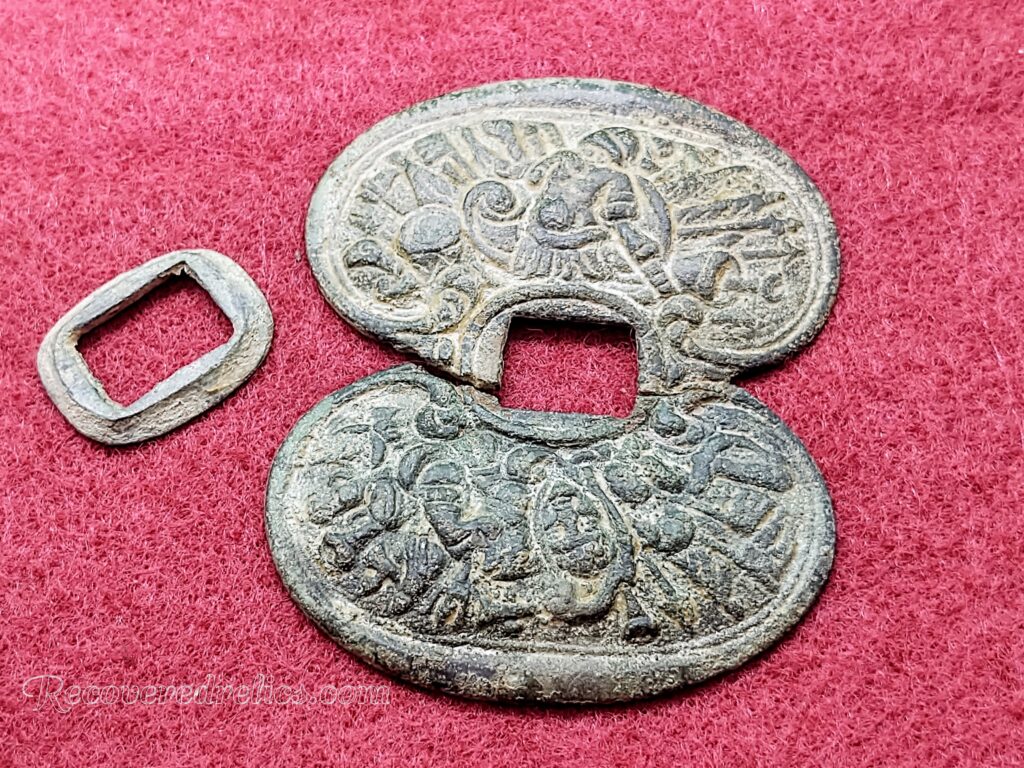
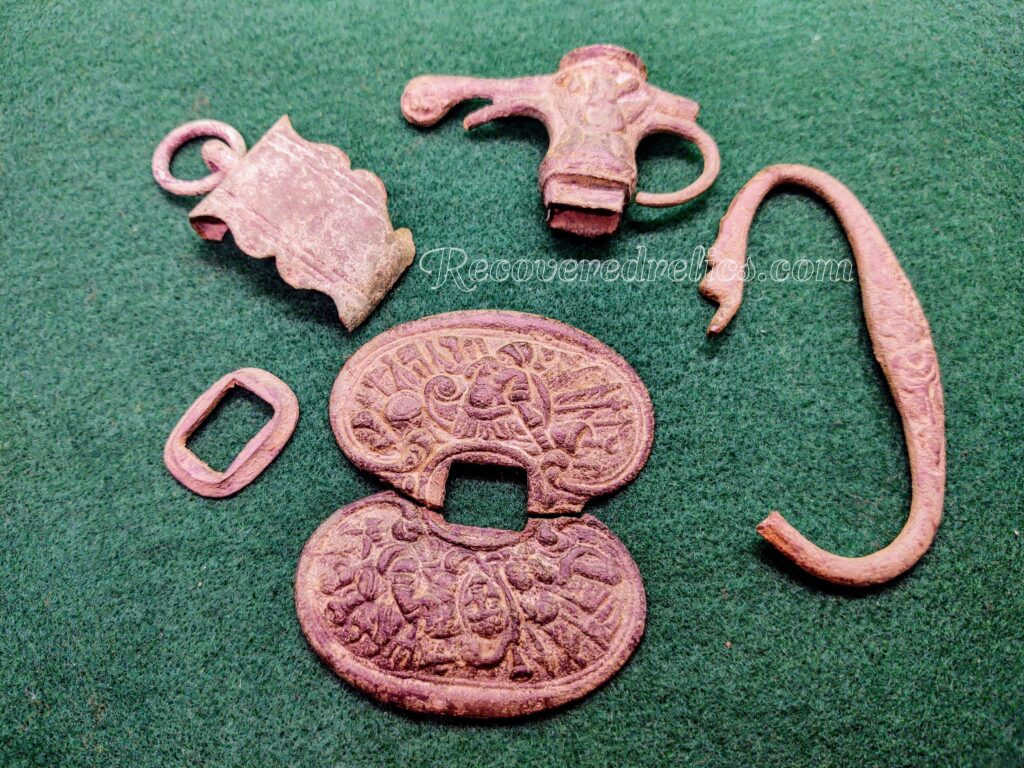
Sword Hilt– The hilt consists of the pommel, grip, and guard. It’s everything that isn’t the blade.
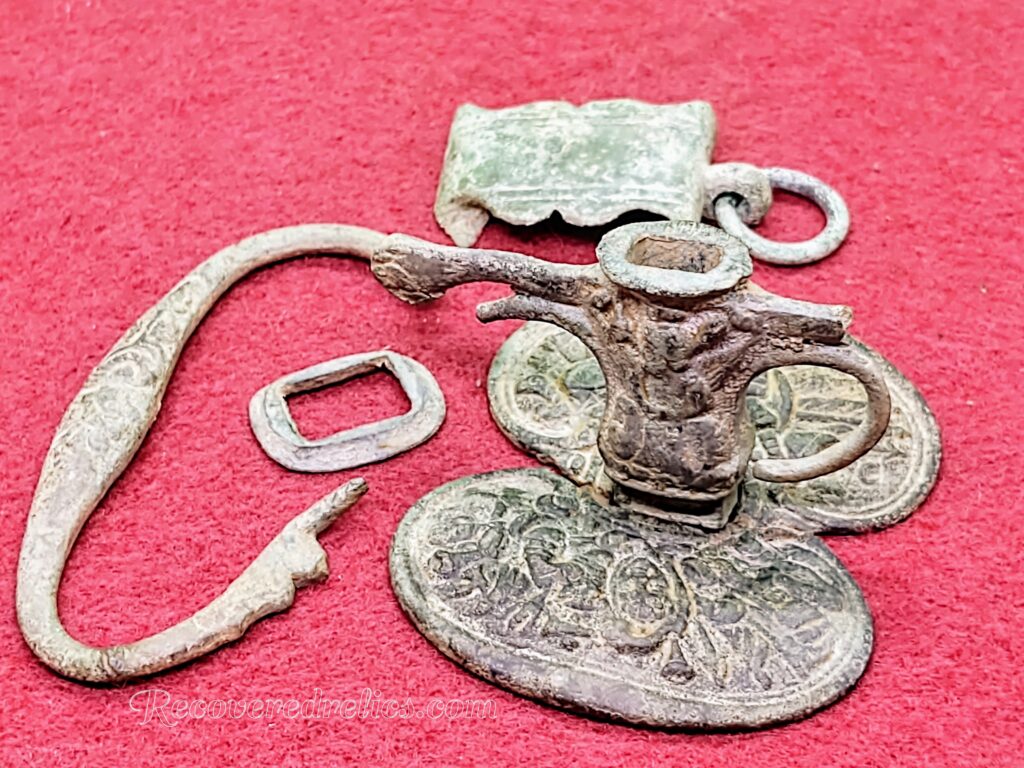
Sword Pommel– The pommel is the top piece of the handle. It’s meant to act as a counterweight to the blade, allowing for the user to have a better hold on the weapon. Pommels are often spherical, but other shapes like triangular, mushroom, and brazil-nut were also common.
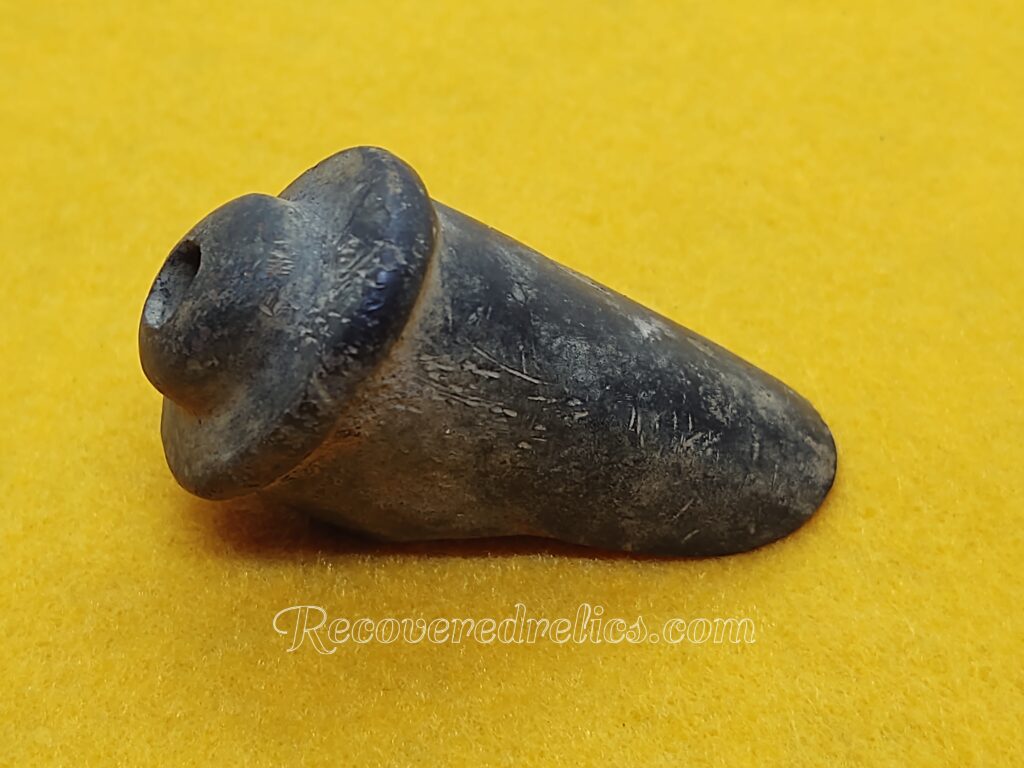

Trigger Guard– A semicircular band of metal or protective loop structure that surrounds and encloses the trigger assembly on a firearm. It serves as a protective barrier around the trigger mechanism and helps to prevent accidental discharge of the firearm.
Williams Patent Type II (.58 Caliber)/Williams Cleaner Bullet– This bullet consists of three individual pieces: a body, a zinc disc, and a pin. When fired the pin pushes into the body of the bullet which flattens the cone shaped zinc disc. Pressure would expand the diameter of the bullets body and wedge it inside the grooves of the rifling which caused the bullet to spin and as it spun through the riffle barrel the Zinc disc would scrape away some of the black powder residue left behind from prior shooting. Williams Cleaner bullets were to be fired about every 10 rounds . During the Civil War the Federal government issued Union soldiers a Williams Patent type I or II bullet with every 10 rounds of ammunition.
